Allison Collection Photos
September, 1943
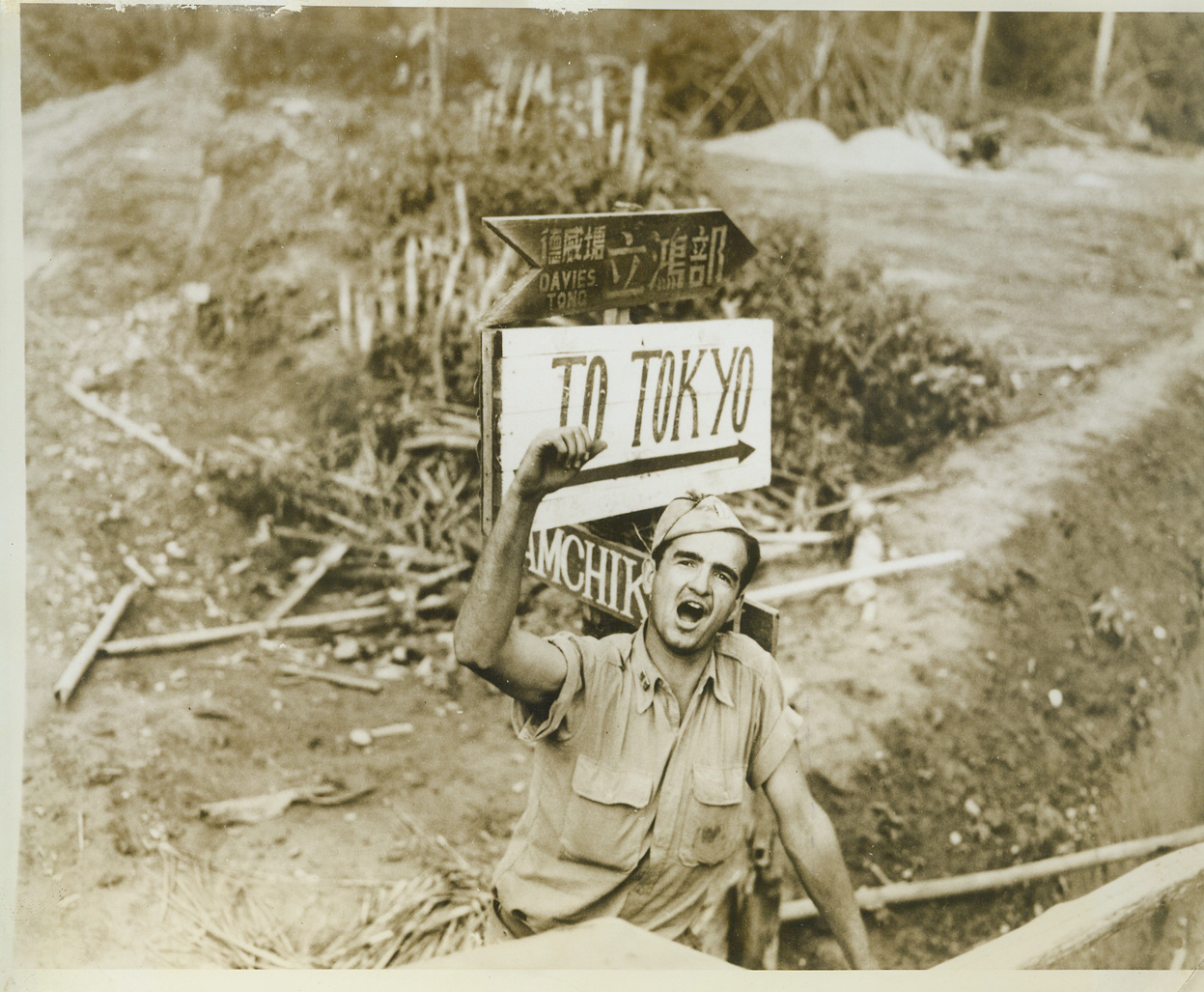
New Burma Road - Shortcut to Tokyo, 9/28/1943. ASSAM, India - Captain John E. Moyer, of Tuskegee, Ala., one of many U.S. Army Engineers working on a new branch of the Burma Road, points out the direction which United Nations moving over the road, will eventually take - to Tokyo. The road starts at Assam, will cross the North Burma border and on into Central Burma, where it will connect with the Old Burma road, now blocked by Jap occupation. The new road was begun last December.;
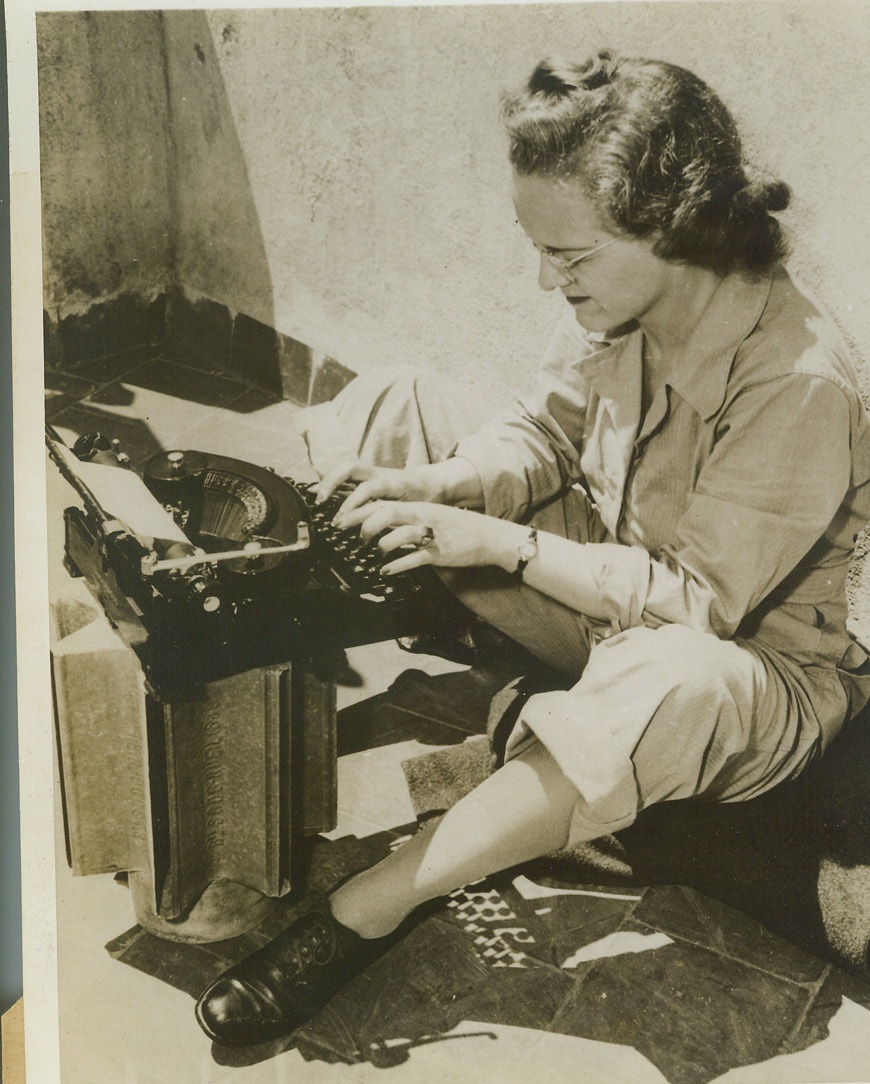
The Female Private Hargrove, 9/4/1943. North Africa – The WAC has its Private Hargrove too – and here she is – Private Pearlie Hargrove who hails from Pillager, Minn. Part of a WAC contingent sent to Allied Force Headquarters in North Africa, she’s a whiz at the typewriter, too. Using a rolled-up blanket for a chair, she bangs out a letter t the folks back home. Credit: (Official WAC Photo from ACME);
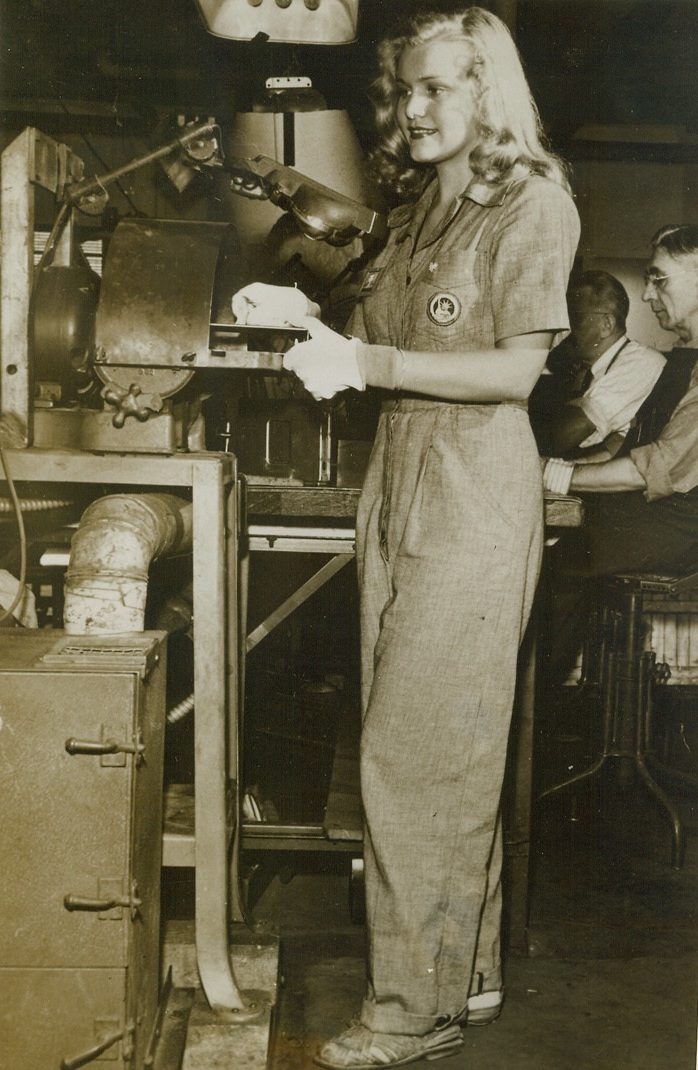
Ingrid in Overalls, 9/23/1943. Minneapolis, Minn. – Here’s the face that decorated countless barracks walls – but pretty Ingrid Vallo has hidden her eye-catching gams in a pair of war worker’s overalls, for the duration. Even the lovely blonde tresses are hidden beneath a safety cap as she works at her drill press in a Minneapolis war plant. See ACME photo #646764 for a glimpse of Ingrid in peacetime as an eye-filling pin-up. Credit: (ACME);
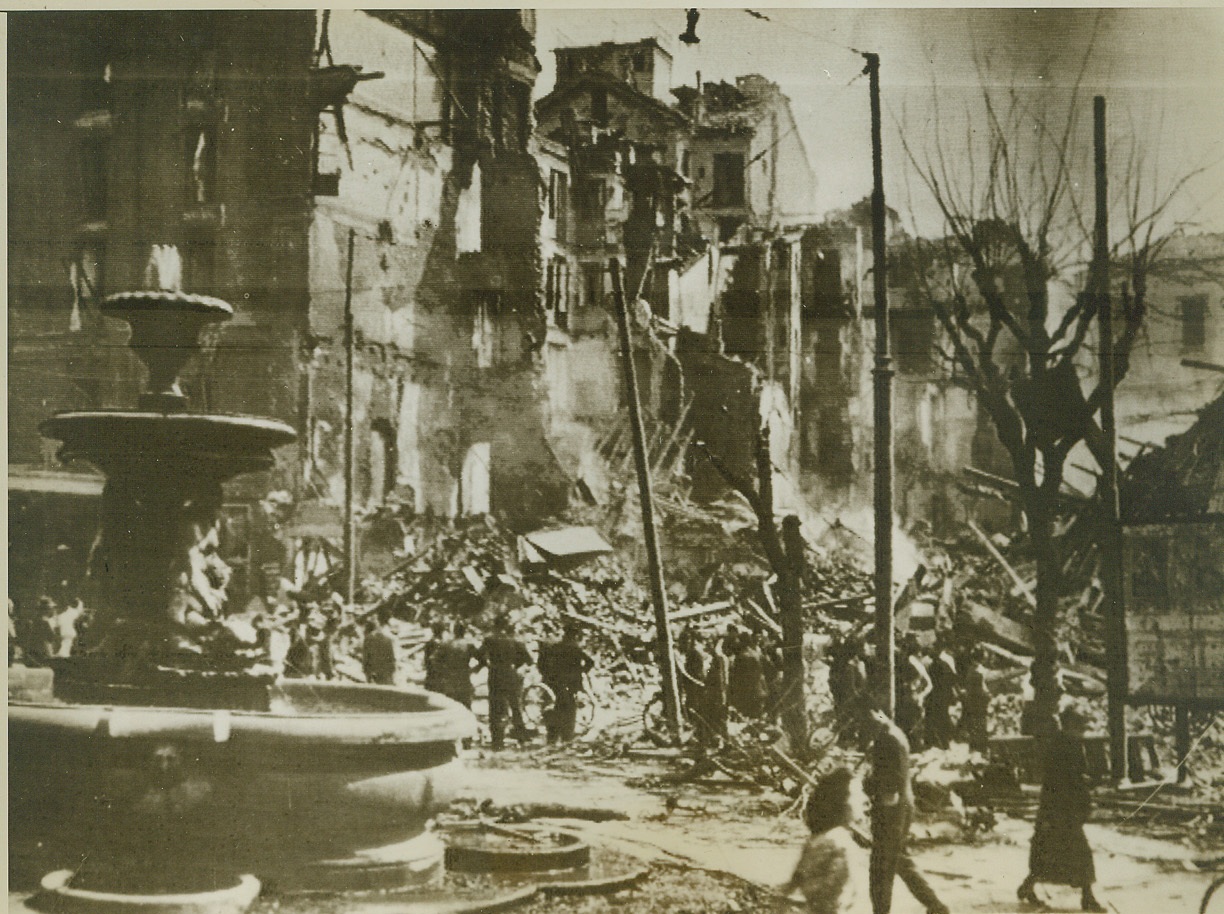
“City of the Dead”, 9/10/1943. Milan – Suffering heavily from bombing attacks by the Allies, Milan was described as “a city of the dead, without gas, water or electricity.” This photo, received through a neutral source, shows wreckage in the Piazza Fontana of the industrial city. Credit: (ACME);
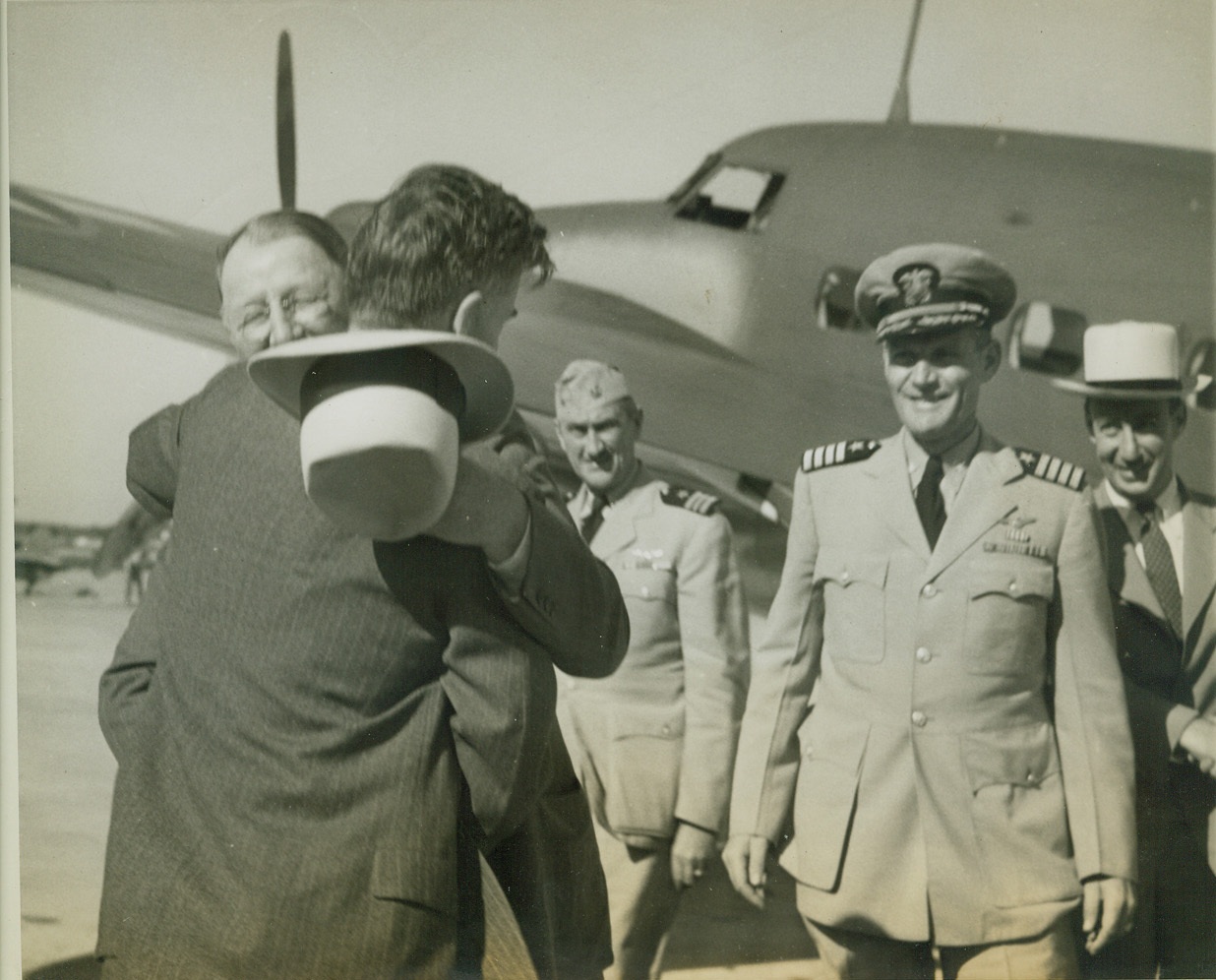
UNSCHEDULED MEETING, 9/10/1943. CHICAGO – Vice-President Henry Wallace and Secretary of the Navy Frank Knox meet unexpectedly at the Glenview Naval Air Station near Chicago when Wallace, in Chicago to make a “major address” before a mass meeting dedicated to winning the peace, was making a tour of the naval base and Knox arrived. Credit: OWI Radiophoto from ACME;
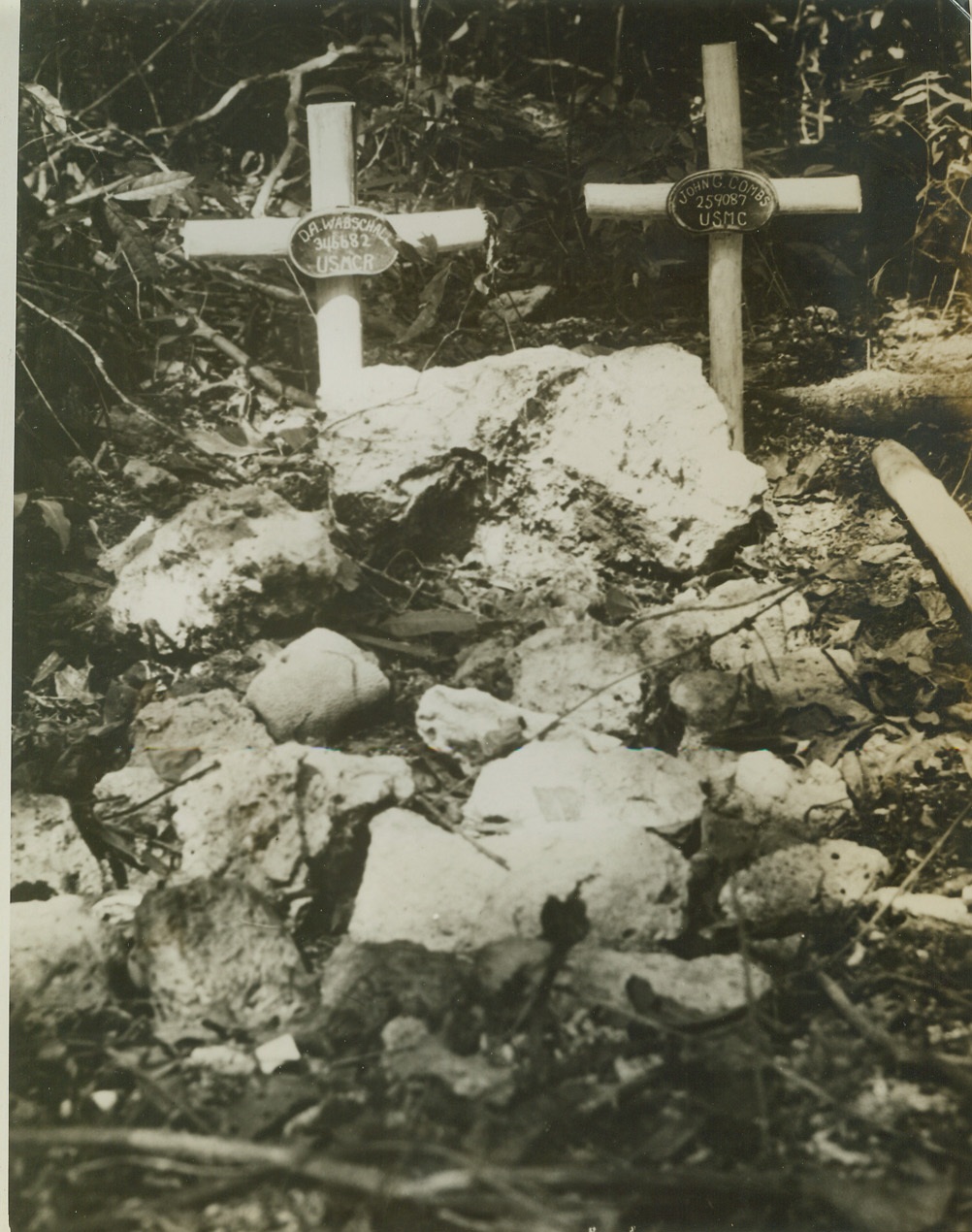
These are the dead, 9/24/1943. ENOGAI, NEW GUINEA - This is the last resting place of marines who gave their lives for their country during fighting in the Enogai jungle. Given a Christian burial by Marine Corps chaplains, the boys lie in neat graves marked with name plates made from captured Jap mess gear.;
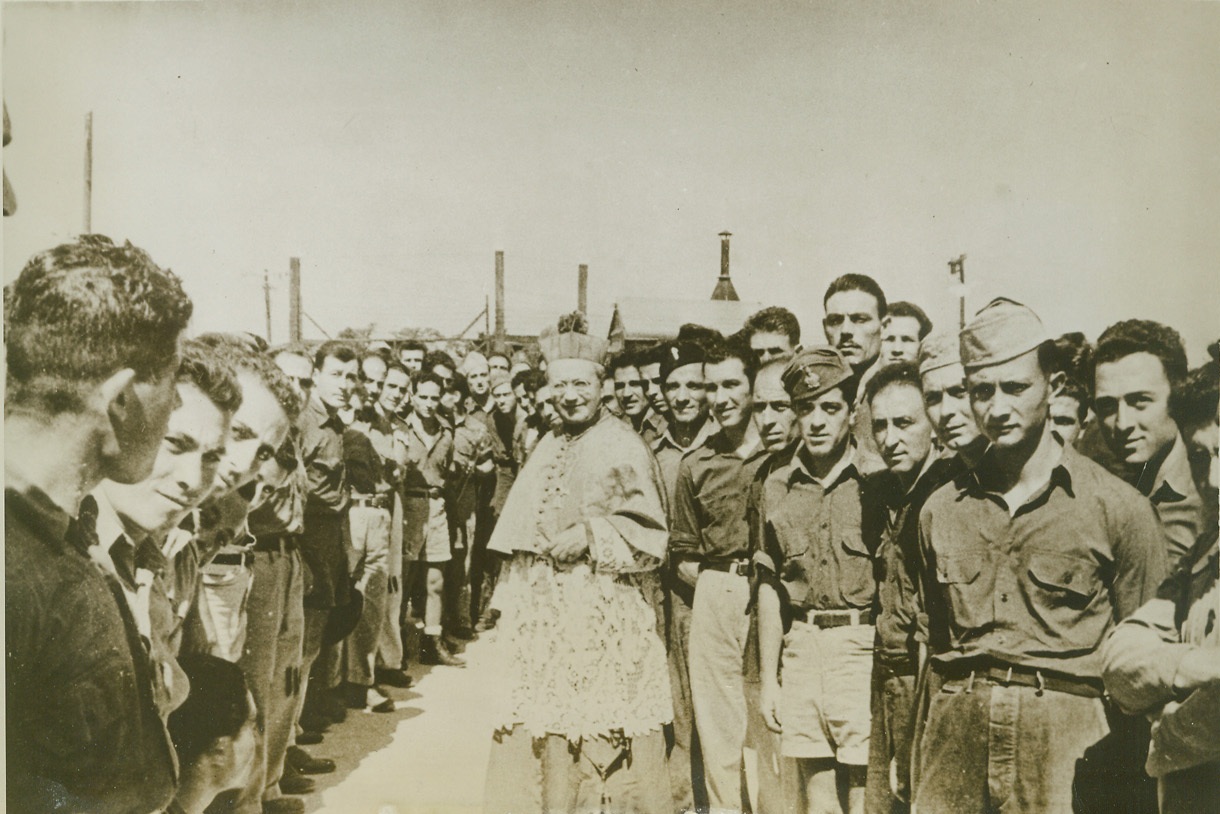
ARCHBISHOP VISITS PRISONERS OF WAR, 9/3/1943. WEINGARTEN, MO – The spiritual needs of prisoners of war interned in camps in America are not overlooked. Archbishop Amleto Giovanni Cicognani, Papal Representative to the U. S., is shown with a group of Italian prisoners during his recent visit to the PW camp at Weingarten. His Excellency celebrated mass and distributed gifts of prayer books, rosaries and similar articles. Credit: Official U. S. Army photo from ACME;
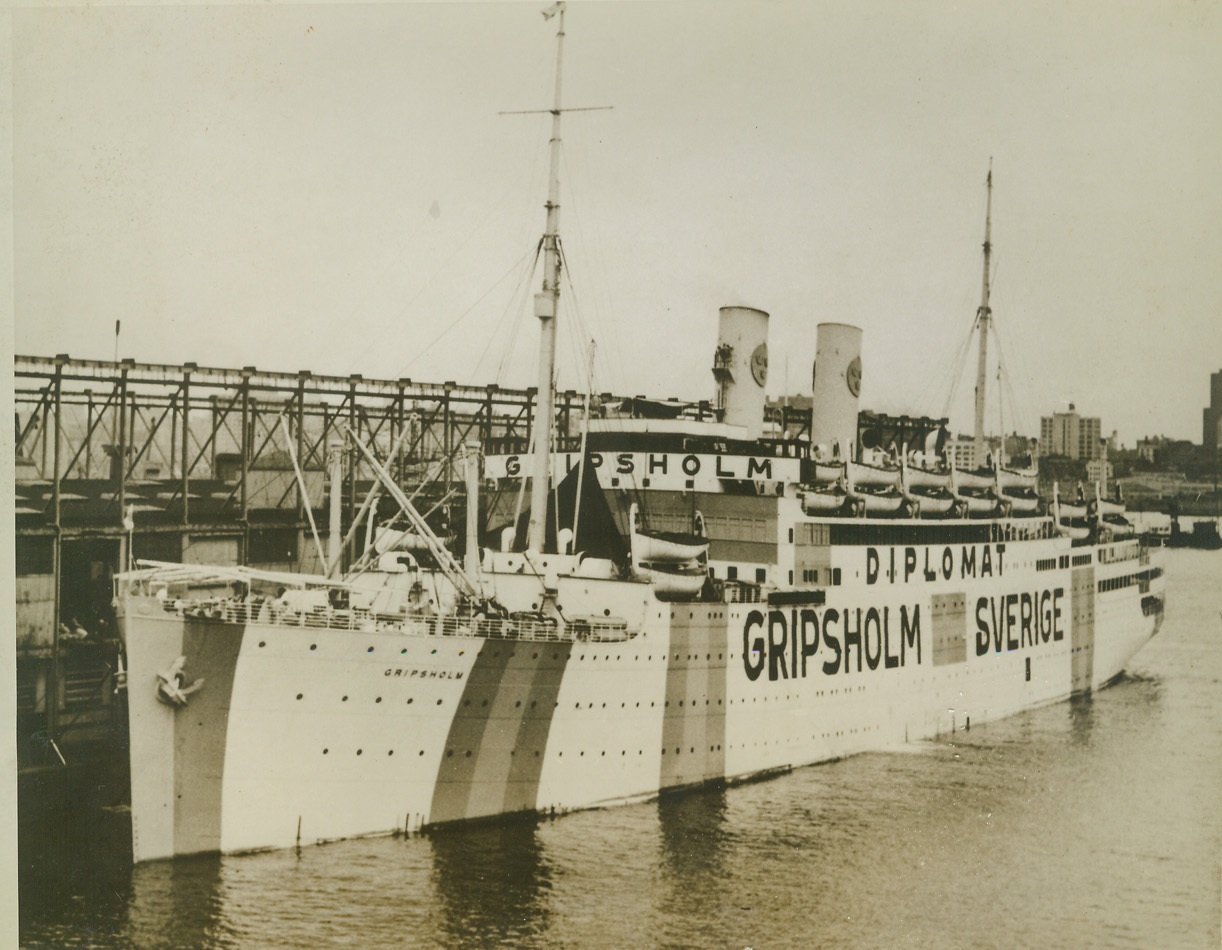
SAFE ON THE HIGH SEAS, 9/3/1943. NEW YORK CITY – In contrast to the drab vessels of war, the Swedish exchange liner “Gripsholm” sports the brilliant blue and gold colors of her country on her side, with her name and the word “Diplomat” prominently lettered between the colors. At night, while on the high seas, she will be gaily lighted to reveal her identity. Guaranteed safe conduct by all belligerent governments, the liner will voyage to the Far East, bringing relief packages from the U. S. to American prisoners of war. She will return with non-military internees. The Gripsholm is shown in New York harbor. Credit: Official U. S. Navy photo from ACME;
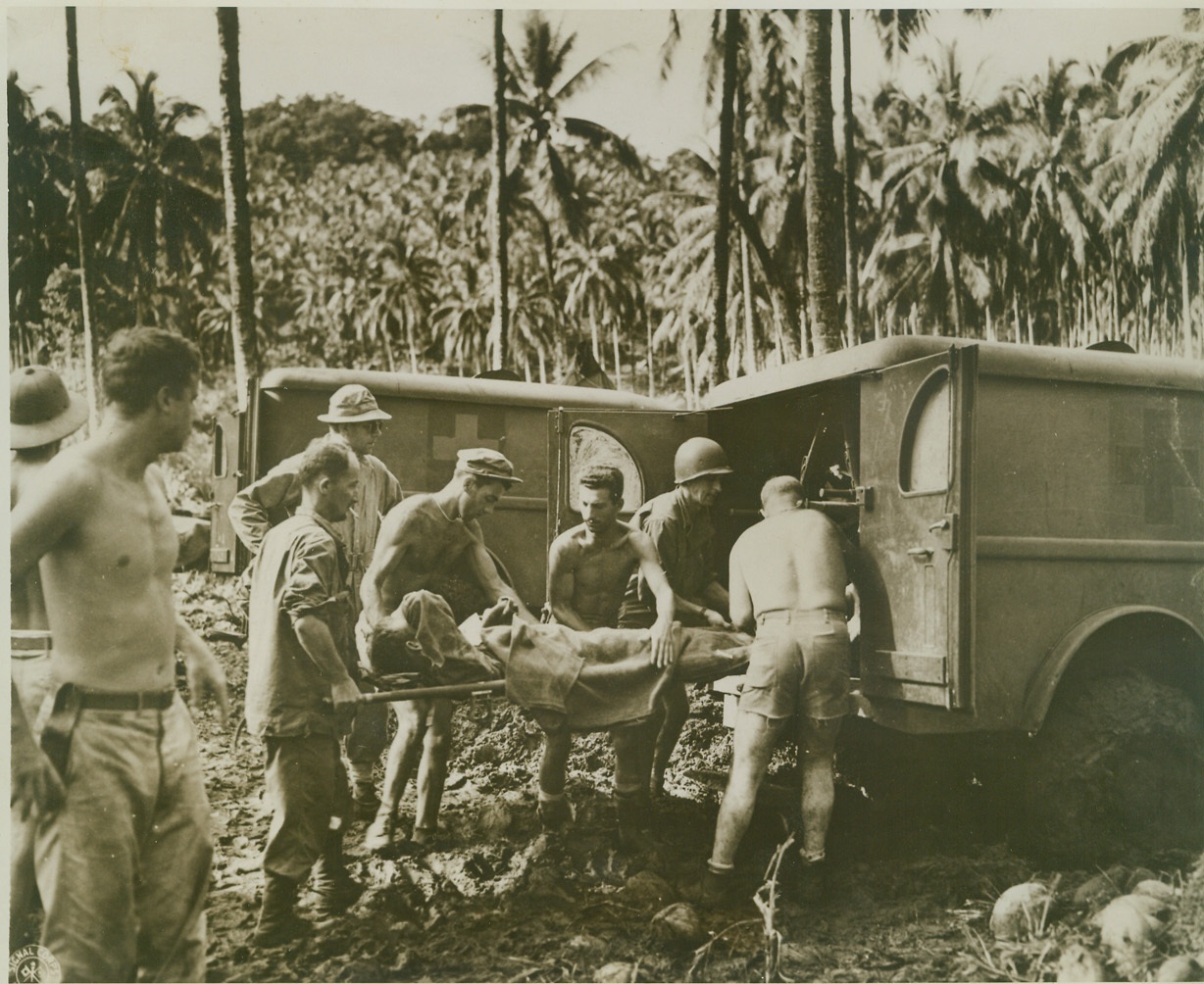
Removing New Georgia Wounded, 9/21/1943. NEW GEORGIA ISLAND – Allied wounded are placed in ambulances for removal from the fighting zone on New Georgia Island. Note mud-caked wheel of ambulance in foreground. The Japs have been driven from Munda Point on New Georgia after bloody fighting and only isolated pockets of resistance remain. Credit: U.S. Signal Corps photo from ACME;
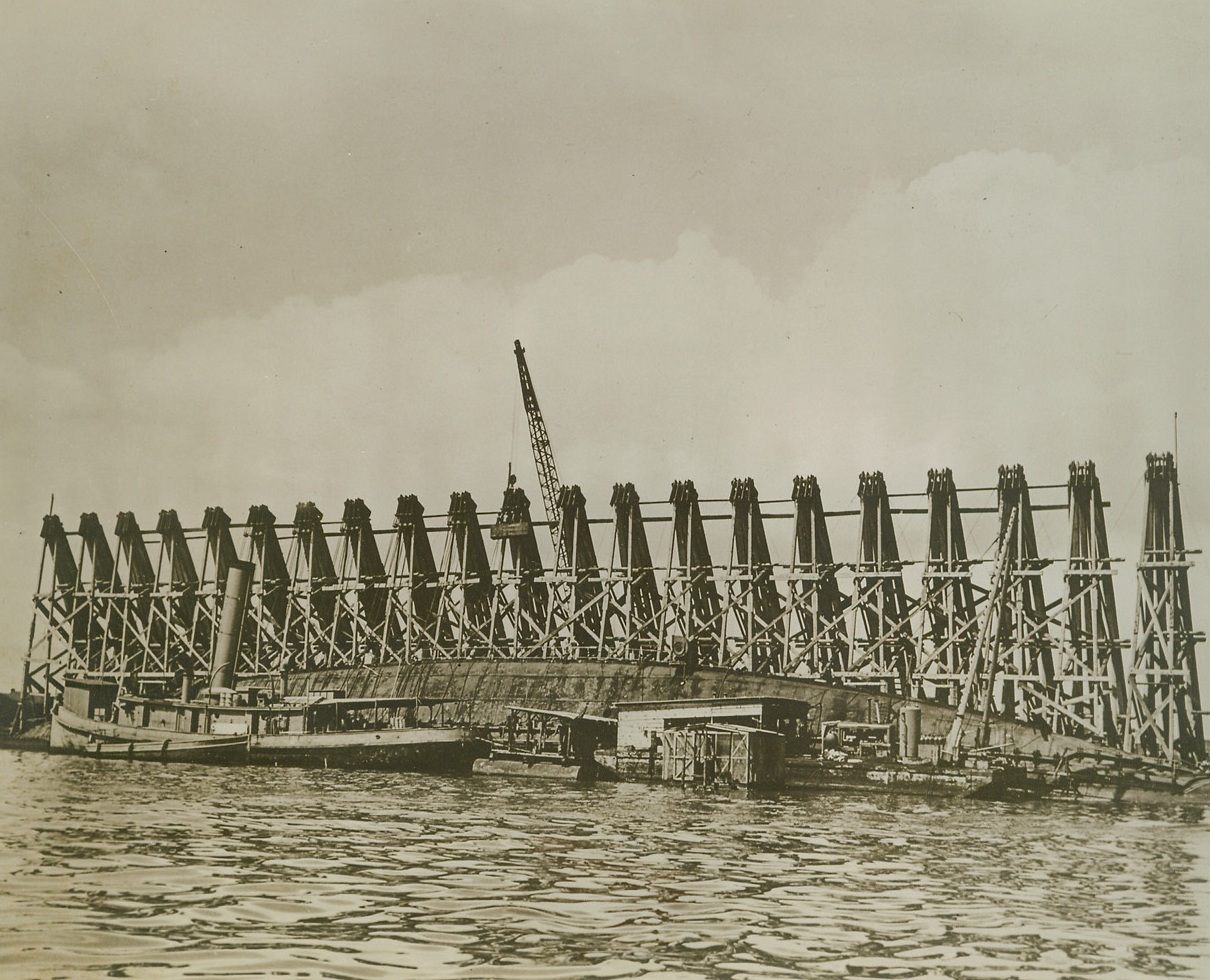
Raising the Battleship Oklahoma, 9/21/1943. This photo, just released by the U.S. Navy, shows the battleship U.S.S. Oklahoma being raised from the bottom of Pearl Harbor, where the warship was sunk during the Jap attack. Giant timber frames erected along the hull have cables running over them and to winches ashore, which slowly draw the vessel upright. Credit: (U.S. Navy Photo from ACME);
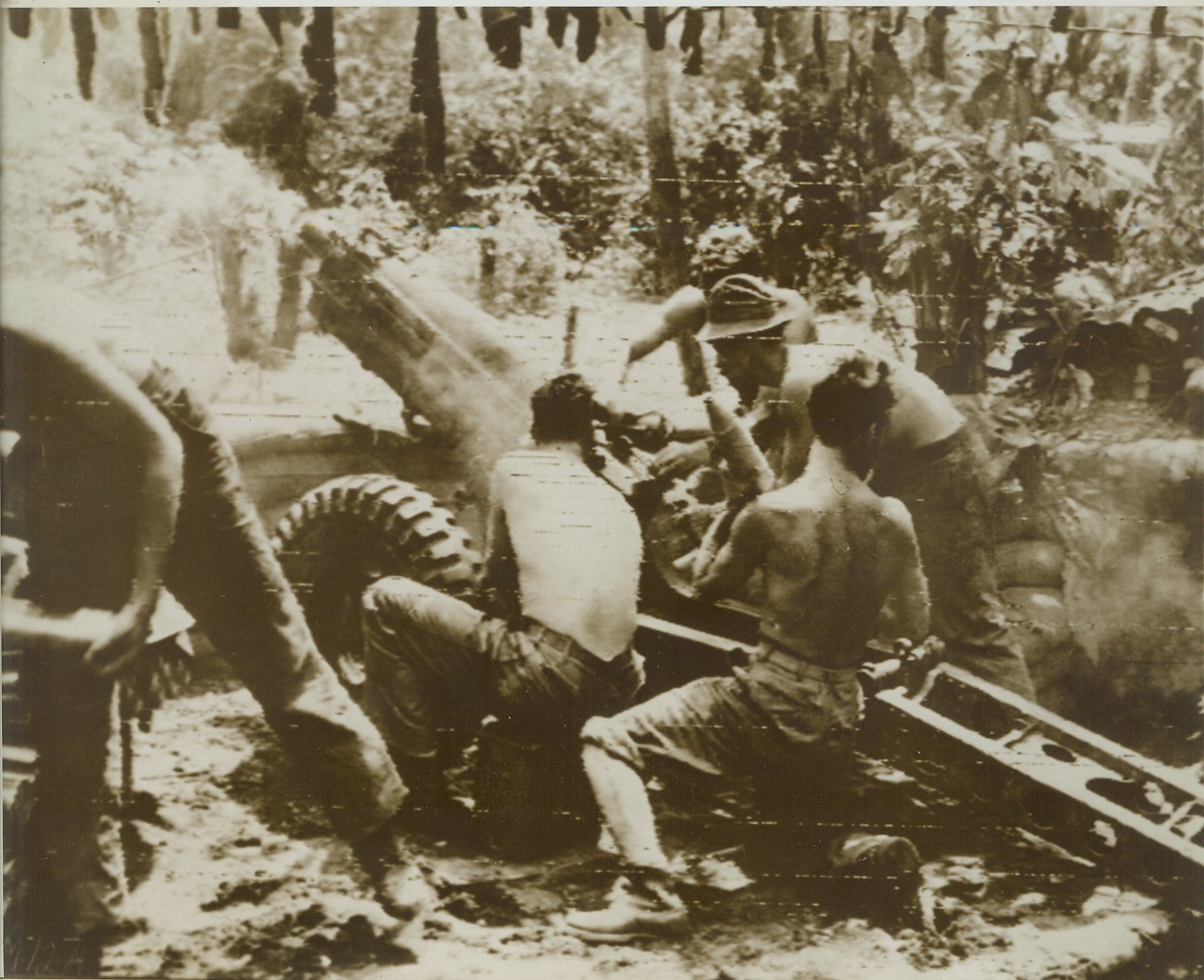
Closing in on Salamaua, 9/2/1943. New Guinea – Only a few hundred yards from the strong Jap base of Salamaua, New Guinea, a battery of the 41st Division rocks the enemy with their 75 mm. gun. The announcement of the fall of the air base, on of the last enemy strong points on the island, is expected hourly. Credit (Signal Corps Radiotelephoto from ACME);
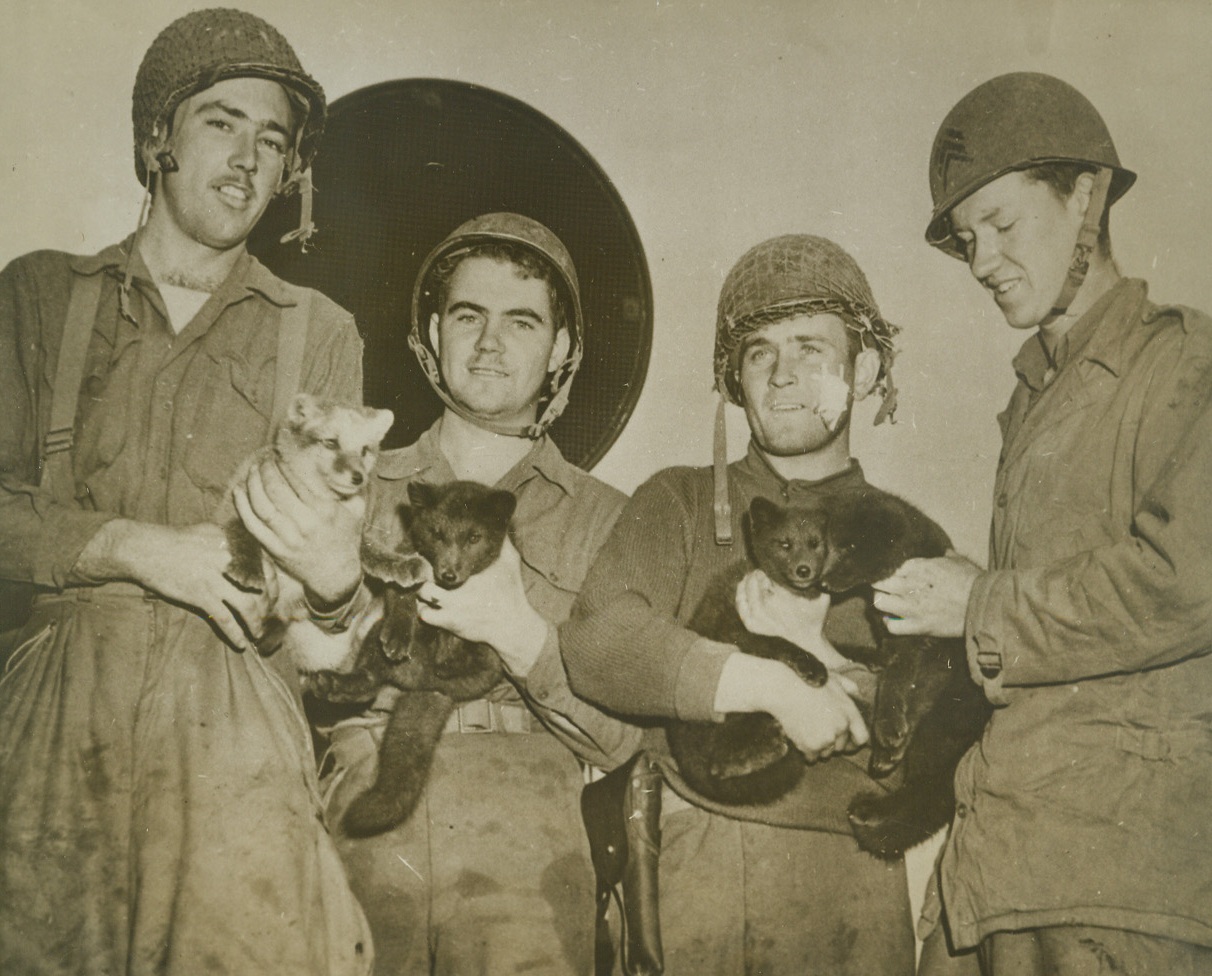
NOT FOXY ENOUGH, 9/13/1943. Four soldiers who participated in the Allied invasion of Jap-deserted Kiska Island hold four baby blue foxes they found in a hole in rocks on Segula, a small island a short distance from Kiska. The foxes weren’t foxy enough to avoid capture. The men are (L-R) Sgt. Marshall B. Brooks, of Shreveport, La.; Ray Burton, a Canadian soldier from Richmond Hill, Ontario, Canada; Sgt. Robert G. Johnson, of Bloominton, Ind.; and Sgt. Herman W. Grae, of San Antonio, Tex. The foxes were named Winken, Blinken, Stinken, and Nod.Credit: Acme;
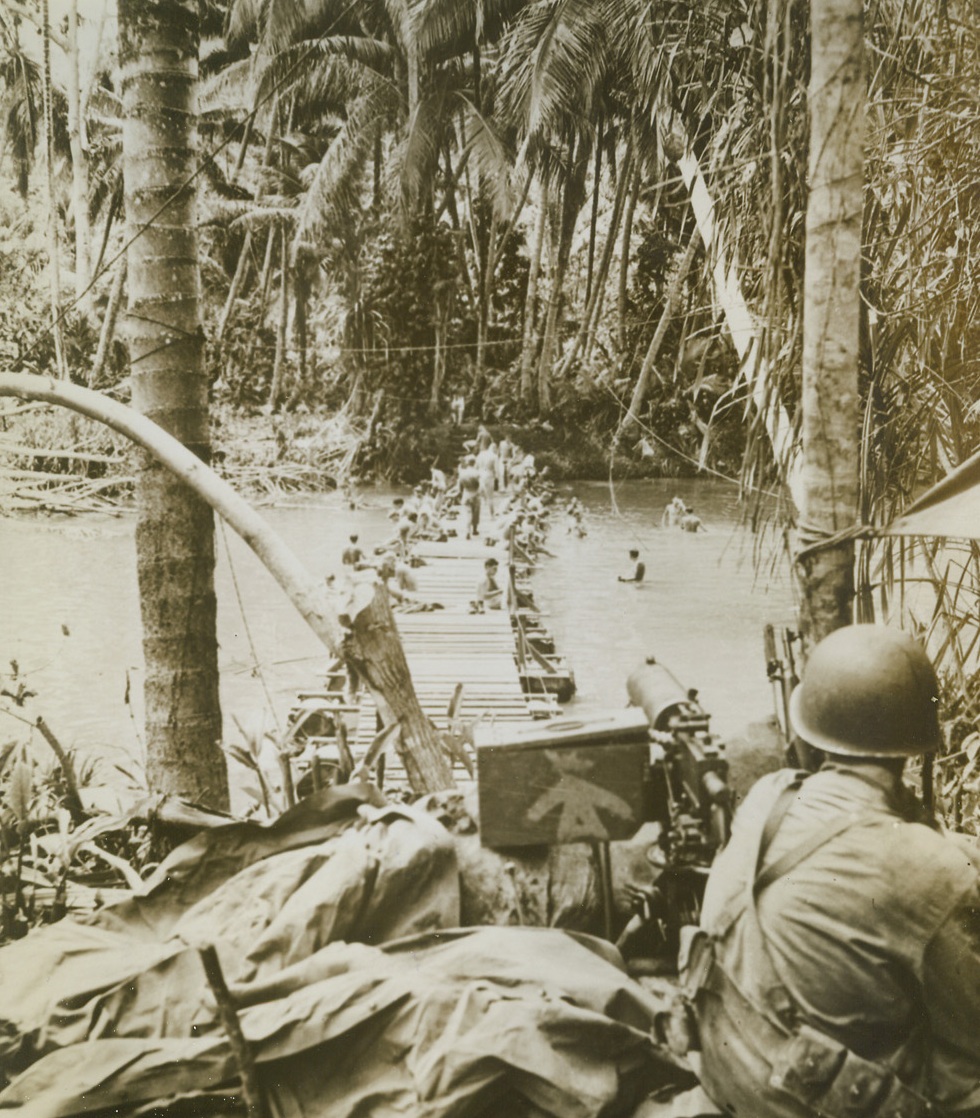
GUARD OF THE BATH, 9/24/1943. IN THE SOUTH PACIFIC—While Marines of an engineering battalion take much-needed baths in this jungle stream on a South Pacific Island, a machine gunner stands guard over his bathing buddies. Should a Jap patrol or a sniper appear on the opposite bank, his trusty gun wil go into action immediately.Credit: U.S. Marine Corps photo from Acme;
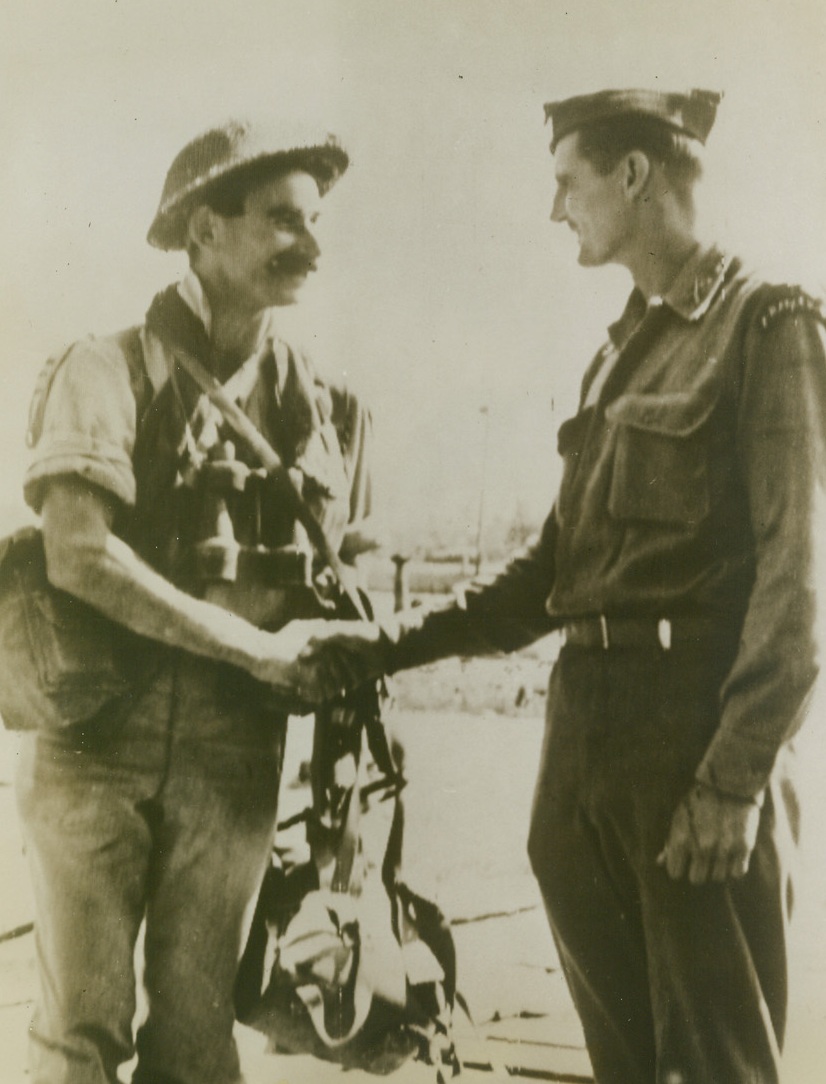
GOOD LUCK, PAL, 9/10/1943. SICILY—An American Ranger shakes hands with a British Commando, just before the two specialist fighters leave a Sicilian port and set out for Italy. Each of these Allied soldiers knows what the other is up against, for both do the same sort of rough-and-tumble fighting.Credit: Acme photo via U.S. Army Signal Corps radiotelephoto;
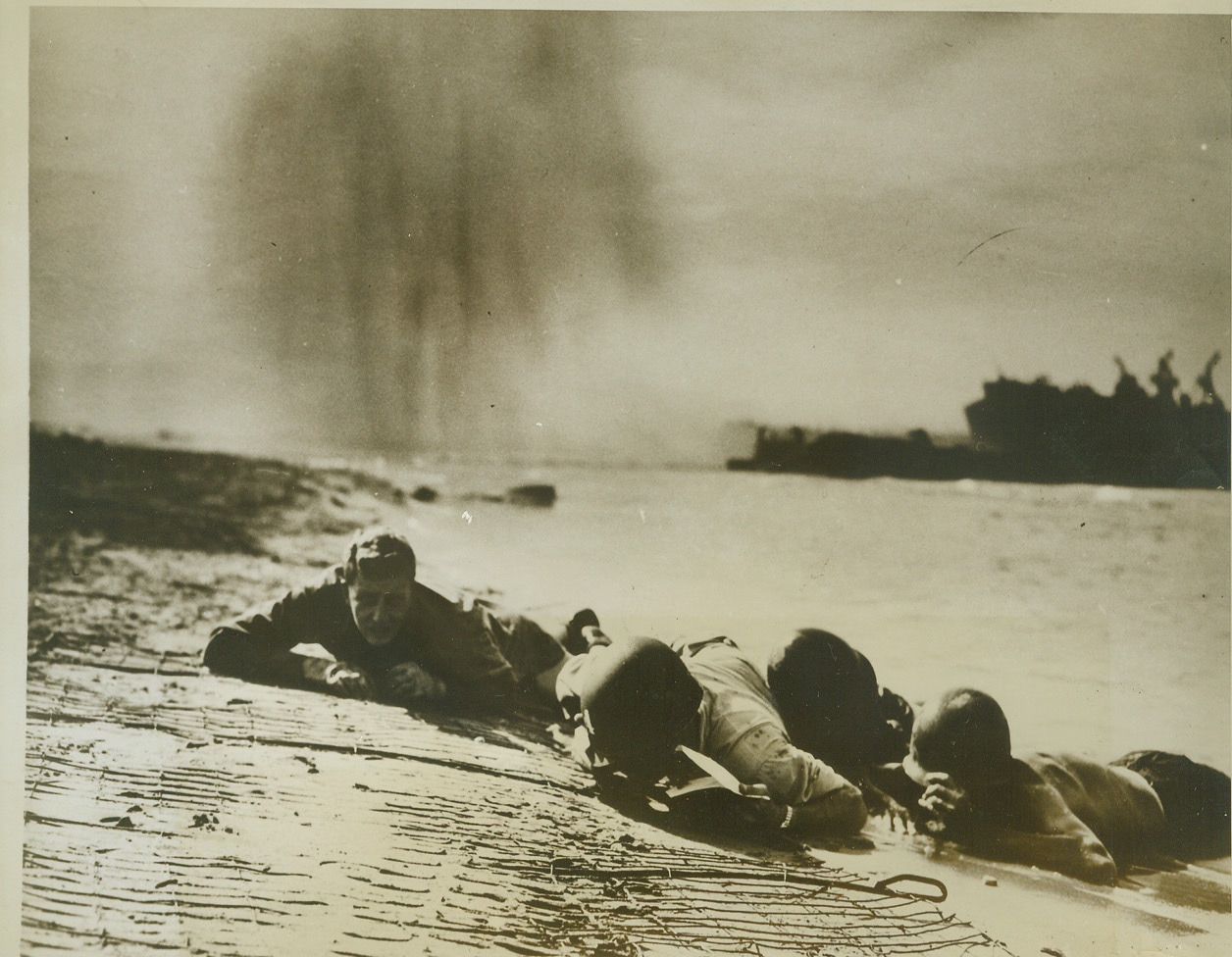
Hit the Dirt, Sailor!, 9/23/1943. Paesternum, Italy – U.S. Coast Guardsmen and Navy beach battalion men hug the beach as a Nazi bomber dumps its load near them at Paesternum, south of Salerno, during the bloody fighting in that area. In the background, (top center in photo), a cloud of black smoke from a bomb explosion hangs in the air. Hey, Sailor, keep that head down! Credit: (U.S. Coast Guard Photo from ACME);
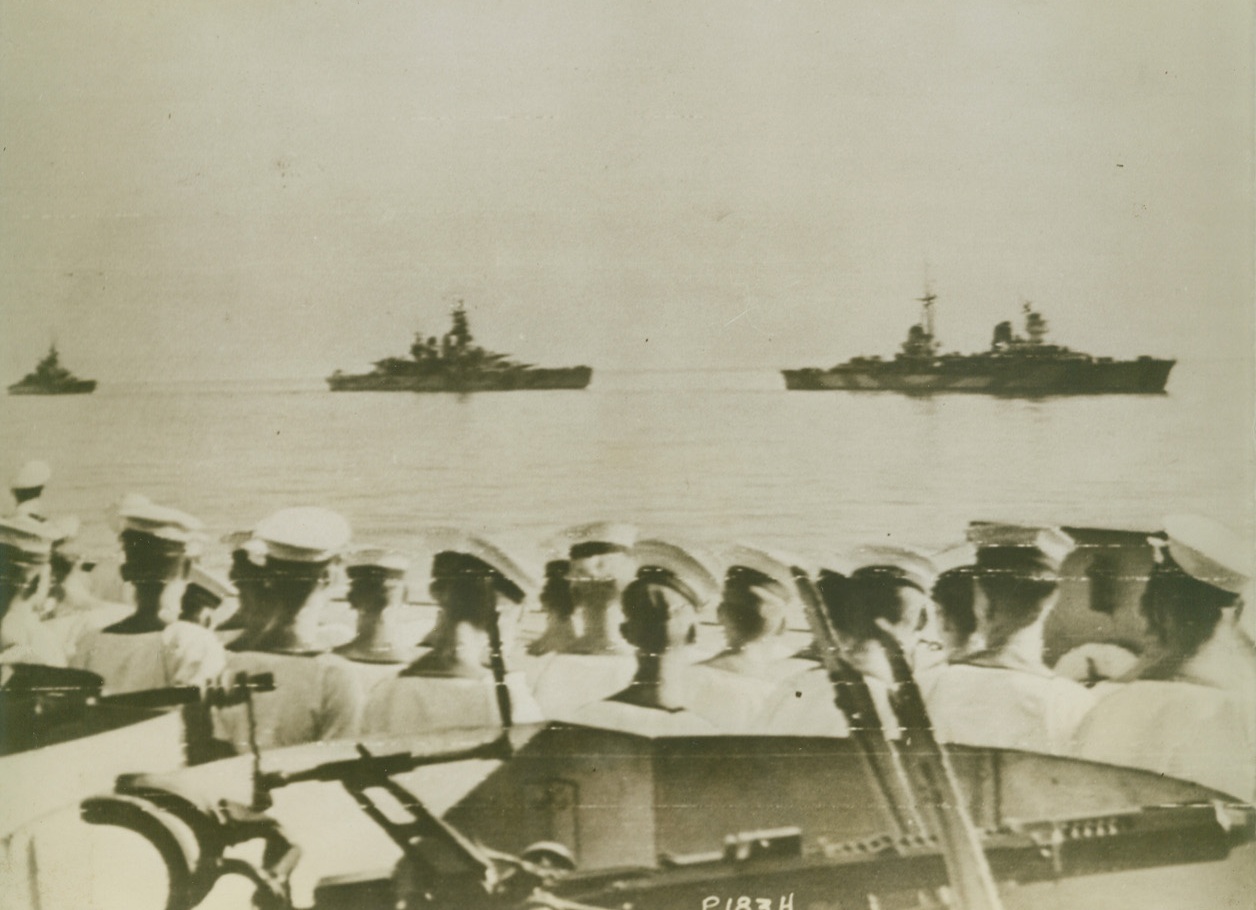
ITALIAN FLEET ON WAY TO SURRENDER, 9/13/1943. This photo, flashed to the U.S. today by radiotelephoto, shows three ships of the Italian Navy as they passed the British battleship H.M.S. Warspite, (in foreground), on their way with other units of the fleet to Valetta, Malta, to surrender to the Allies after having escaped from Italy. Left to right, the vessels are: the battleships Italia and Vittorio Veneto, and the cruiser Savoia (flagship).Credit: U.S. Signal Corps radiotelephoto from Acme;

TIGER TANKS IN BRENNER PASS, 9/13/1943. German Tiger Tanks were rushed to positions in the Brenner Pass after the Nazis had wrested control from the Italians, according to the German sources. Photo was telephotoed from Berlin to Stockholm and radioed to New York today. Credit (ACME Radiophoto);
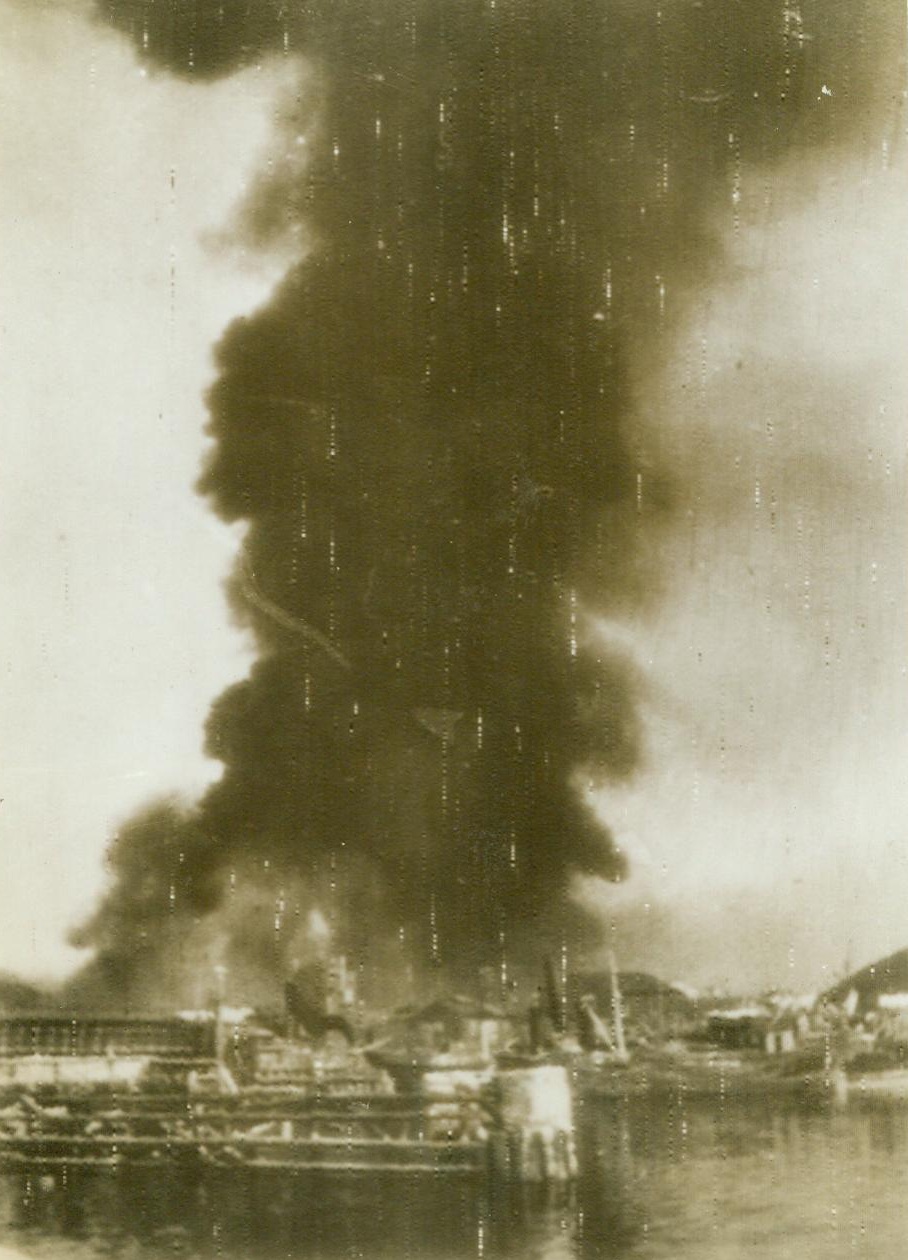
ALLIES SMACK TRONDHEIM, 9/14/1943. New York: -- Black smoke billows skyward from a blazing German oiltank three minutes after the first bomb dropped on Trondheim’s “new harbor” during a big Allied day raid on the Norwegian port on July 24. Photo was radioed from Stockholm to New York Today (Sept. 14). Credit (ACME Radiophoto);
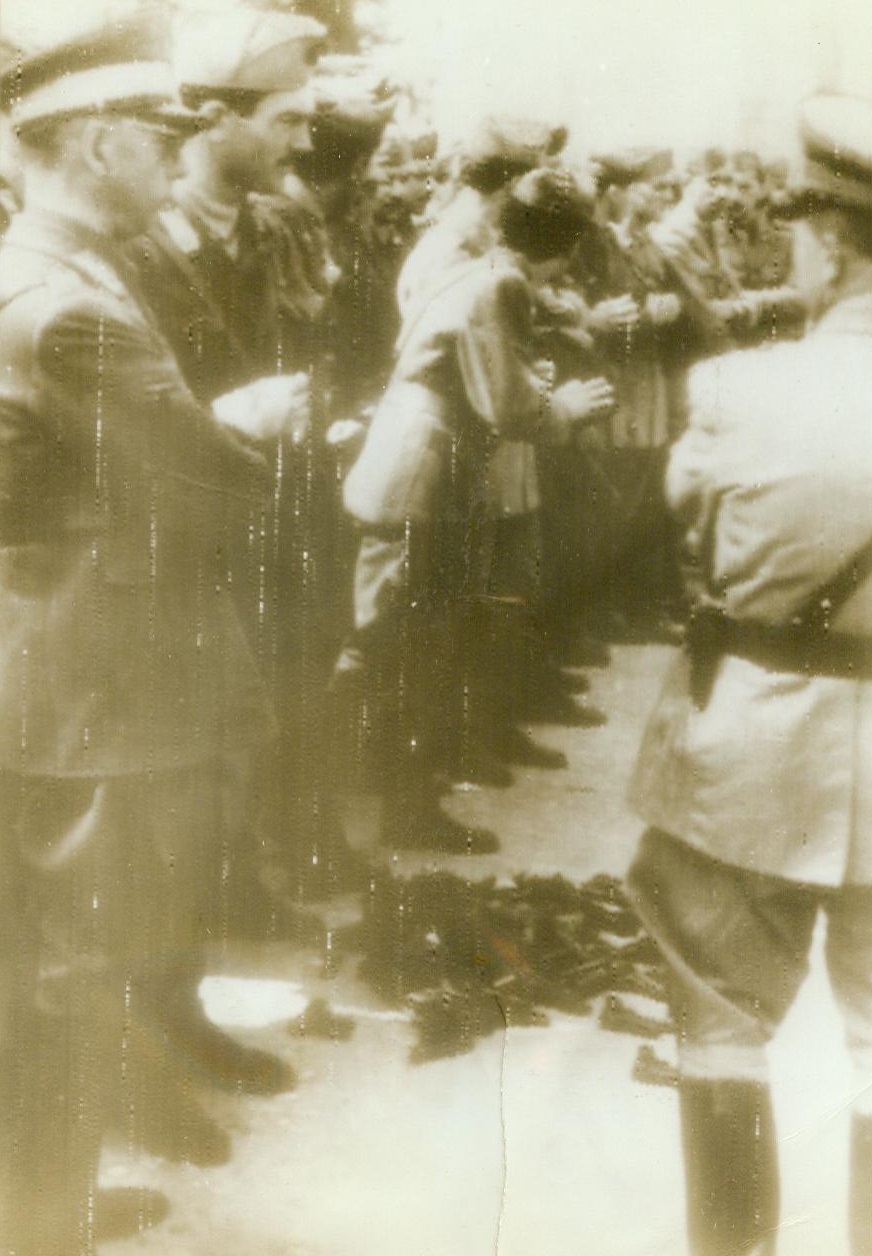
AXIS PARTNERSHIP DISOLVED, 9/14/1943. New York: -- According to the German caption accompanying this picture, which was telephotoed to Stockholm and radioed to New York today (Sept. 14), Italian officers a lined up in Parma, in northern Italy, being disarmed by their one-time Nazi allies. On the ground is a stack of revolvers surrendered by the Italians. Credit (ACME Radiophoto);
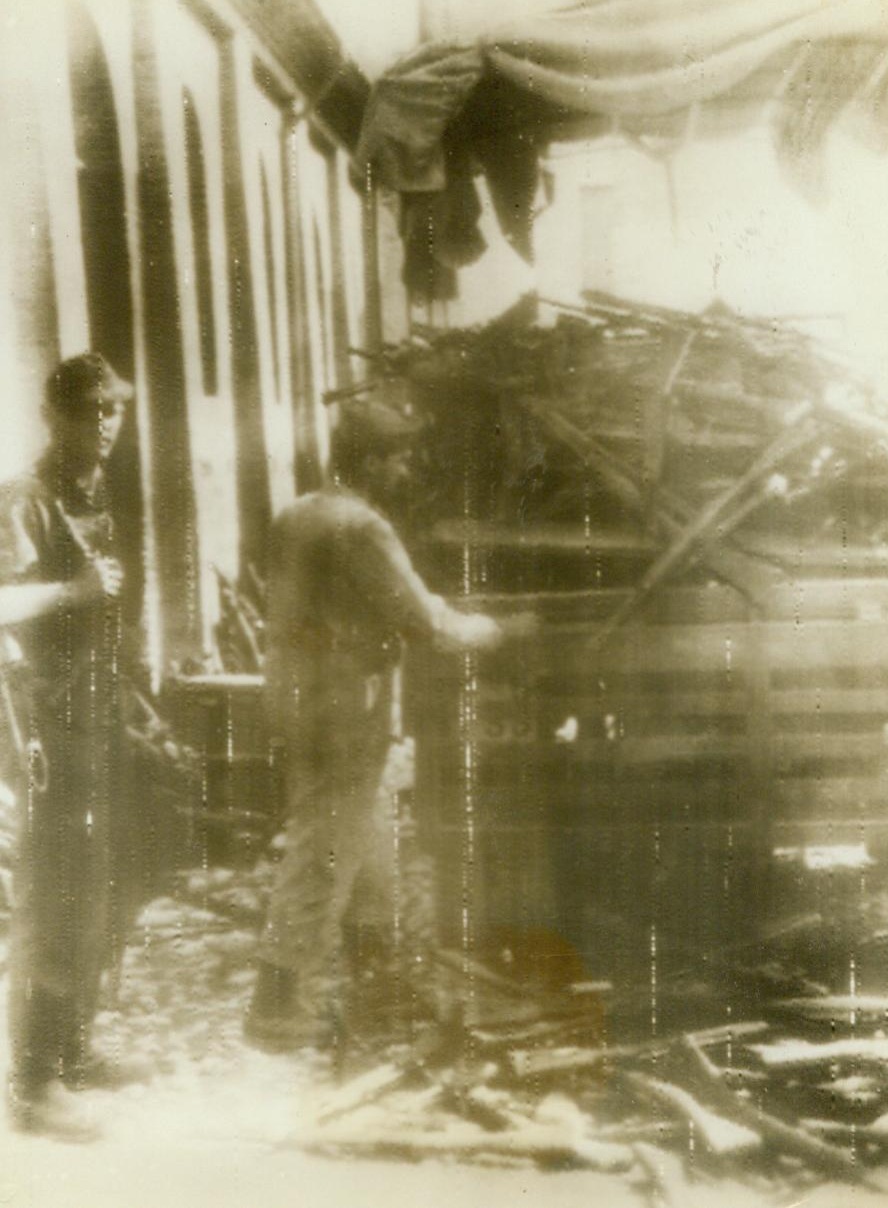
No title, 9/14/1943. New York: -- According to the German caption accompanying this picture, which was telephotoed to Stockholm and radioed to New York today (Sept. 14), Italian officers a lined up in Parma, in northern Italy, being disarmed by their one-time Nazi allies. On the ground is a stack of revolvers surrendered by the Italians. Credit (ACME Radiophoto);
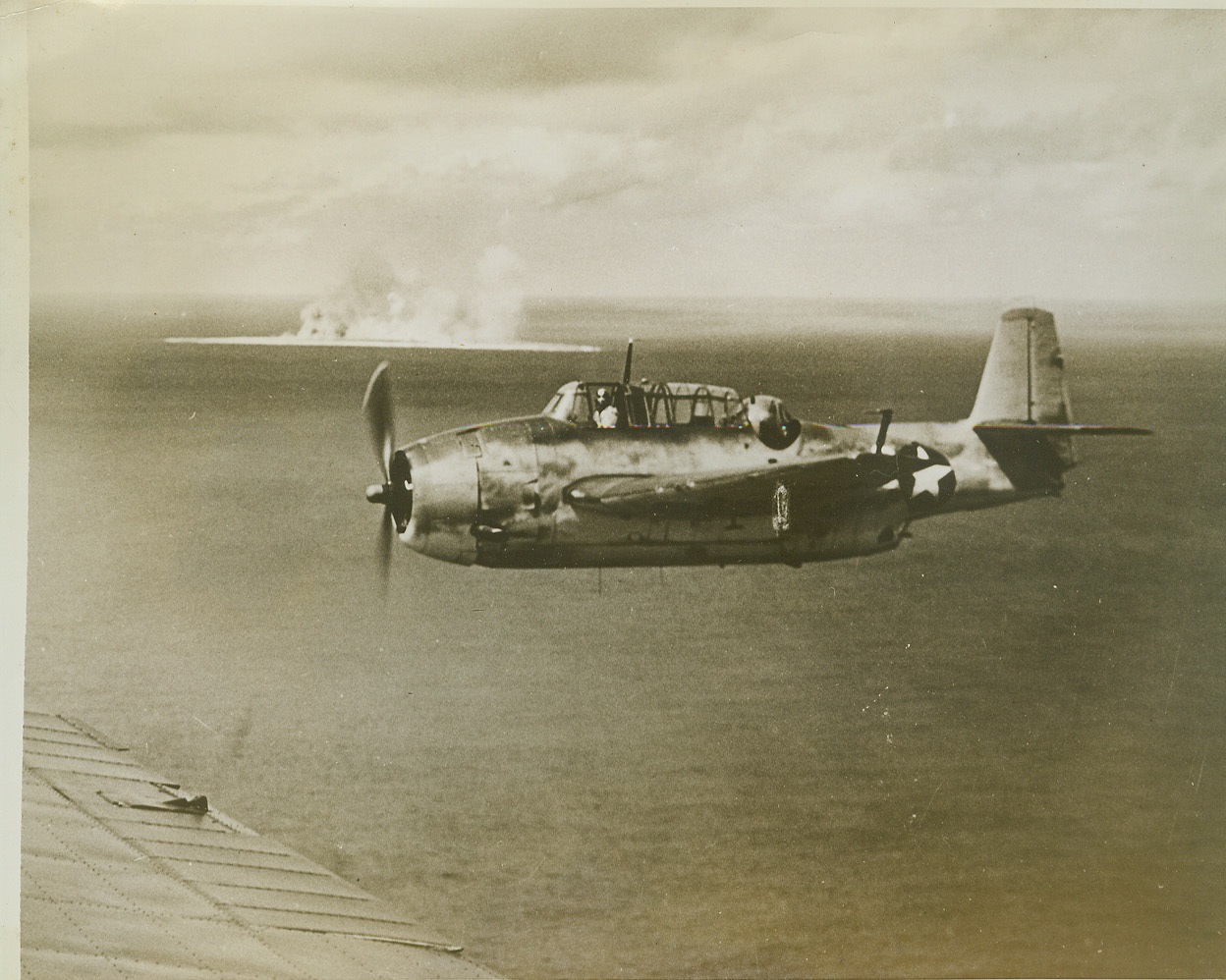
Navy Blasts Marcus Island, 9/28/1943. Smoke from burning Japanese installations covers tiny Marcus Island as a Grumman Avenger torpedo bomber, which has just dropped its load on the enemy base, returns to its carrier. The Japanese island base, 990 miles southeast of Tokyo, was attacked by a U.S. Navy task force on September 1, 1943, and 80% of the enemy installations were reported destroyed. Credit: (U.S. Navy Official Photo from ACME);

Geysers in Hansa Bay, 9/20/1943. Hansa Bay, New Guinea – Bomb-geysers erupt in Hansa Bay as bombers of the U.S.A.A.F. attach Jap cargo vessels attempting to land supplies for their troops on the North coast of New Guinea. Receiving its fifth hit, the vessel in the foreground is heeling over. Yesterday (September 19th) Mitchell bombers battered the dock area, power station and Jap headquarters at Monywa, on the Chidwin River, in Burma. Credit (U.S. Army Air Forces Photo from ACME);

Welcome to Our Coop, 9/22/1943. Italy—As a fresh batch of Italian prisoners is brought into a temporary prisoner of war camp, their compatriots, taken in previous battles on the Italian mainland, reach across the barbed wire that forms the enclosure to welcome them. These Axis fighters were taken before their country surrendered to the Allies. Credit: ACME.;
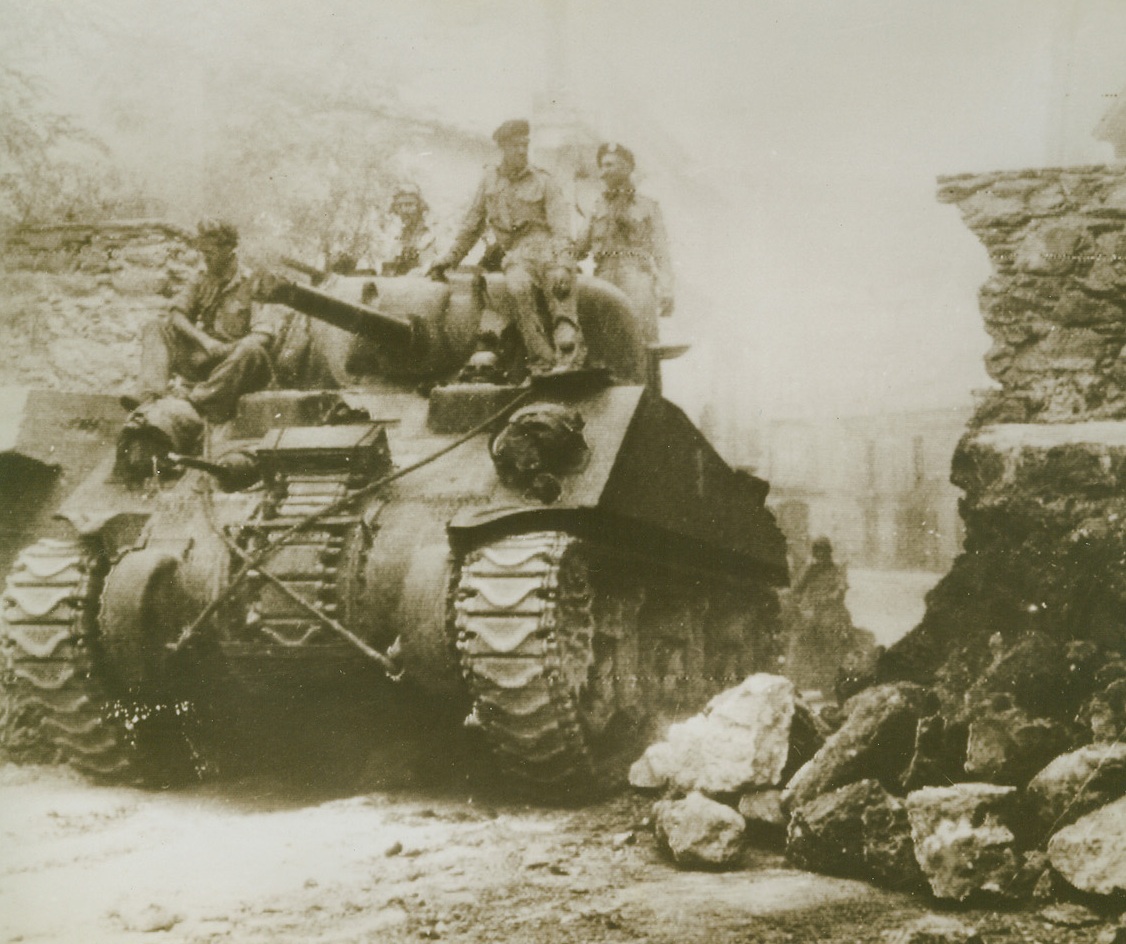
The 8th Army Forges Ahead, 9/22/1943. An American-built Gen. Sherman tank manned by a crew of the British 8th Army passes through a road block at Nicastro, Italy, as British forces pushed their way to the north to join the U.S. 5th Army. Today, the Allies are closing in on Naples having driven into the last mountain barrier before the blazing city. Credit: OWI radiophoto from ACME.;
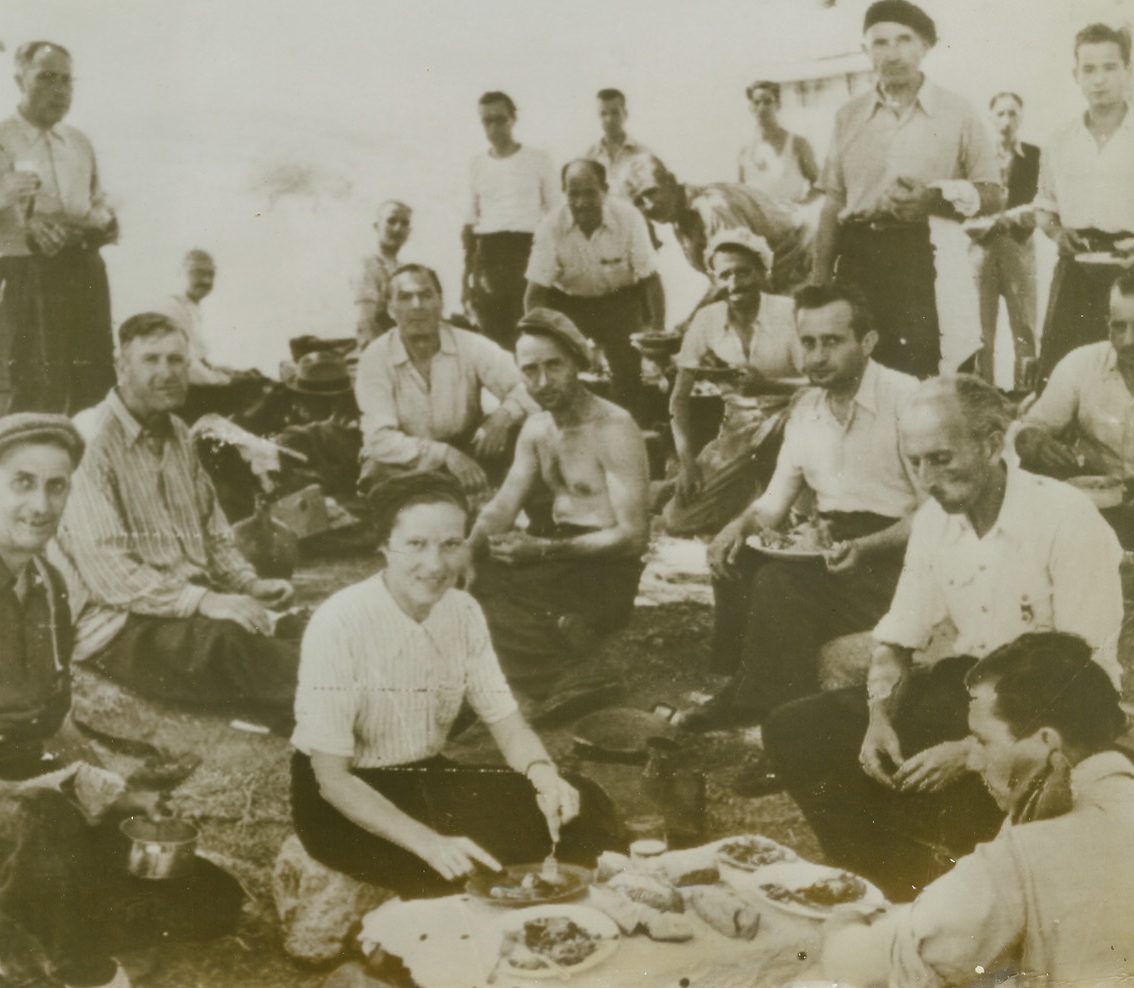
Freedom Picnic for Corsicans, 9/22/1943. This photo, flashed to New York by radio today, shows a group of French Corsicans as they enjoyed their first meal in Italy after their liberation from Axis captors by the Allied invasion. Today it was announced that U.S. Rangers had joined French commando troops in mopping up the remaining German forces in Corsica. (A British Army film unit photo). Credit: OWI radiophoto from ACME.;
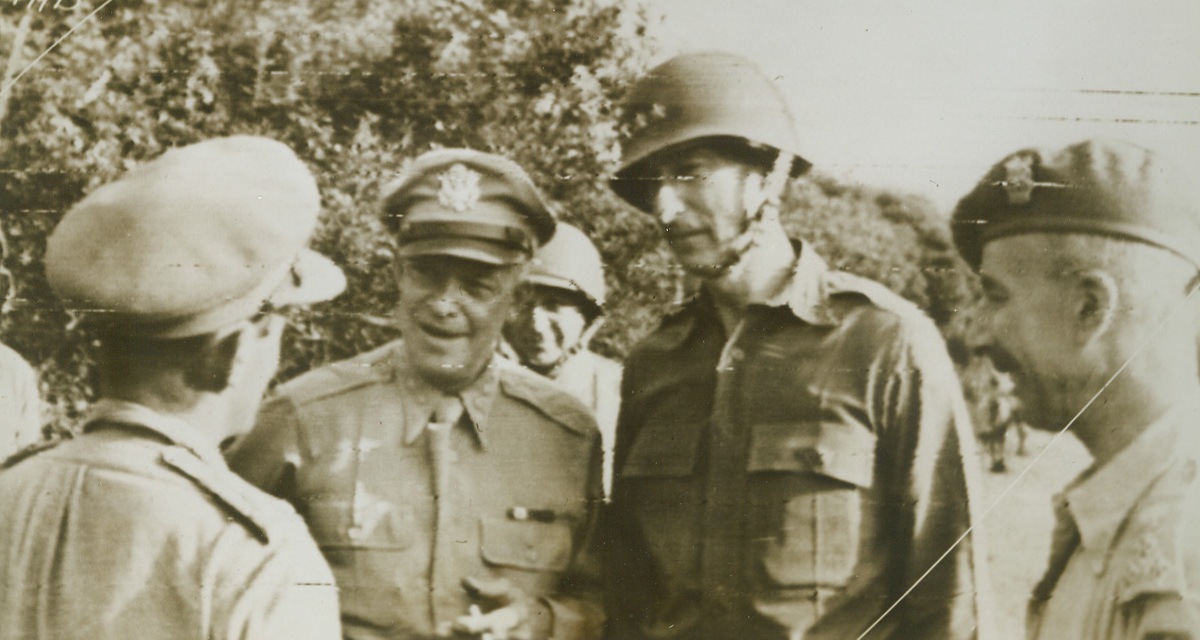
“Pep Talk” on the Italian Front, 9/22/1943. Gen. Dwight D. Eisenhower, (second from left), commander-in-chief of Allied forces in the North American Theatre; and Lt. Gen. Mark W. Clark, (second from right), commanding general of the U.S. 5th Army, confer with two British generals “somewhere on the Italian front,” in this photo, flashed to the U.S. by radiotelephoto today, as it was announced the Allies had almost reached Naples. Credit: U.S. Signal Corps radiotelephoto from ACME.;
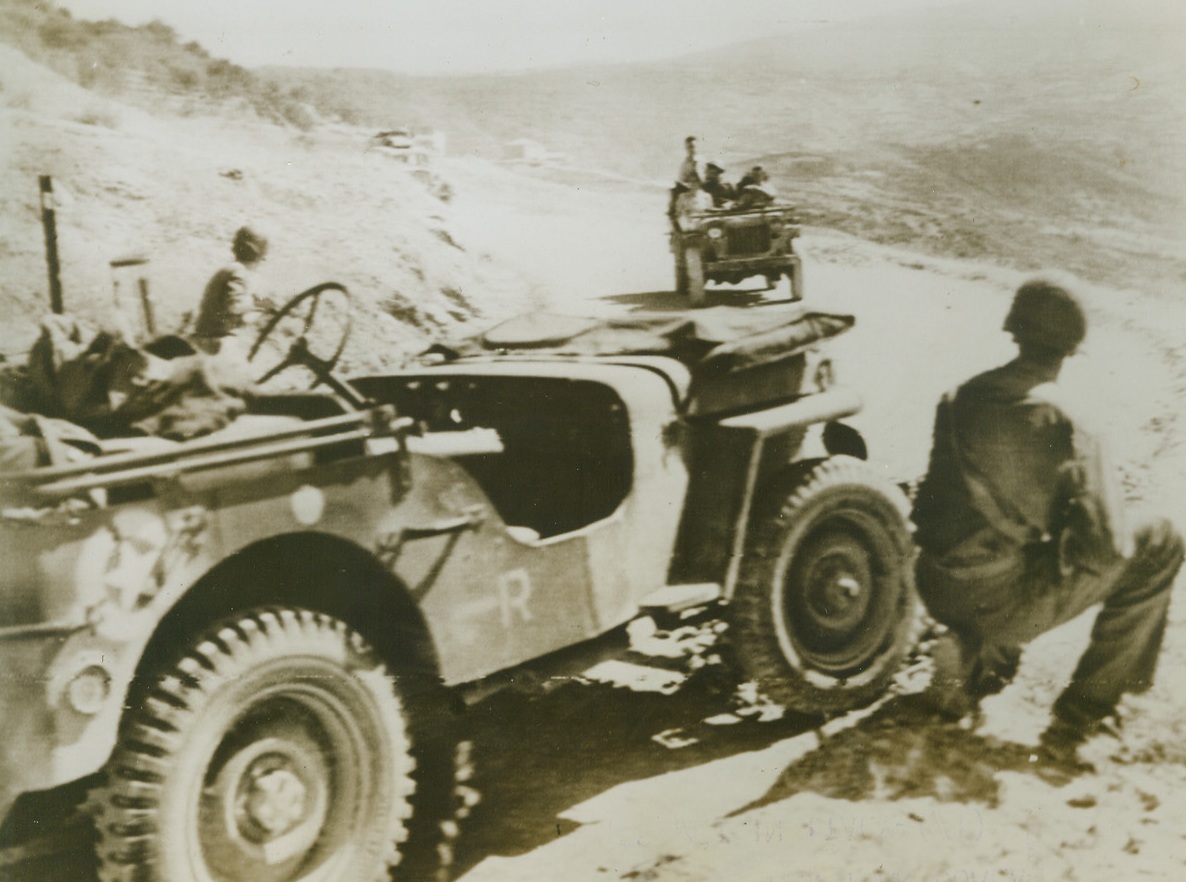
As 5th and 8th Armies met in Italy (#1), 9/22/1943. Italy—This alert U.S. 5th Army Platoon, (in foreground), took no chances when they sighted cars filled with what appeared to be British soldiers driving toward them along this road in Italy. They blocked the road, their guns ready, and stopped the strangers only to find they were an advanced patrol of the British 8th Army which had driven from the south of Italy to meet the American forces in the Salerno area. Thus, the forces of Gen. Clark and Gen. Montgomery met. (Also see ACME photo #RW698607). Credit: U.S. Signal Corps radiotelephoto from ACME.;
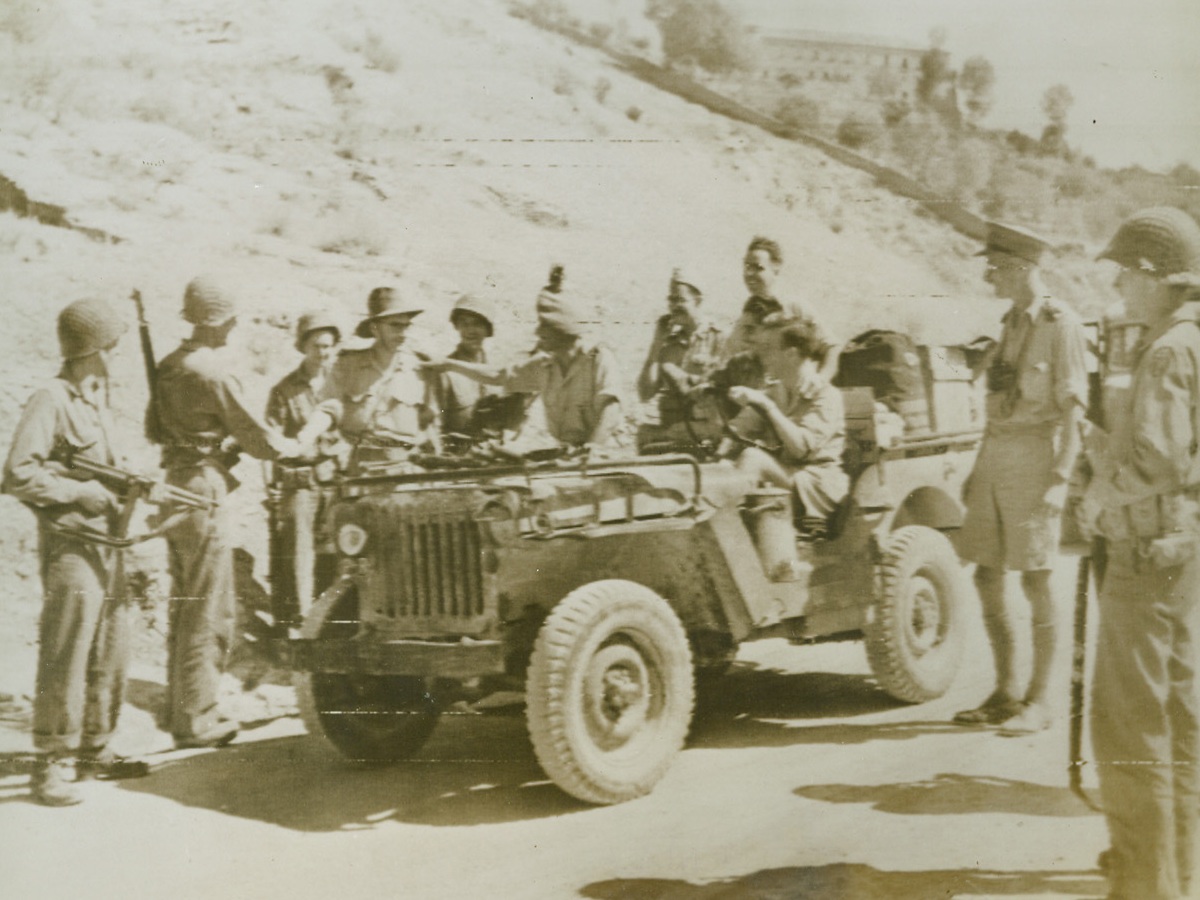
As 5th and 8th Armies Met in Italy (#2), 9/22/1943. Italy—This alert U.S. 5th Army Platoon, (in foreground), took no chances when they sighted cars filled with what appeared to be British soldiers driving toward them along this road in Italy. They blocked the road, their guns ready, and stopped the strangers only to find they were an advanced patrol of the British 8th Army which had driven from the south of Italy to meet the American forces in the Salerno area, the two groups exchange greetings. (Also see ACME photo #RW698606). Credit: U.S. Signal Corps radiotelephoto from ACME.;
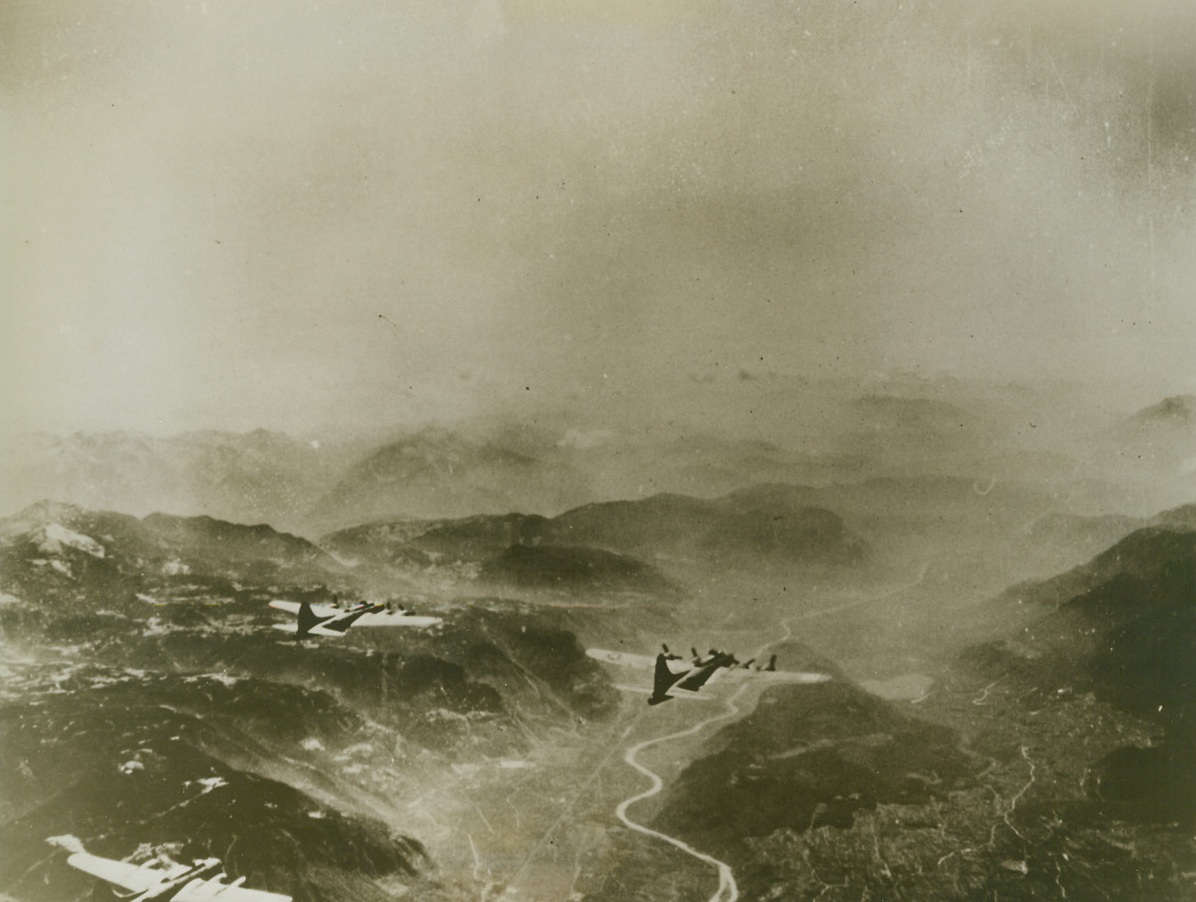
U.S. Bombers Over Brenner Pass, 9/22/1943. Three flying fortresses of the U.S. 8th Air Force based in England, pass over the Brenner Pass during the first shuttle bombing trip ever made by the U.S.A.A.F. from England to North Africa and return. In the photo, (Lower center), the white ribbon of the Sill River can be seen. On this trip, the American planes blasted the Messerschmitt Plane Factory at Regensburg, Germany. Since this trip, the Allies have bombed Brenner Pass, famous gateway between Germany and Italy where Hitler and Mussolini have held many meetings. Credit: U.S. Army Air Forces photo from ACME.;
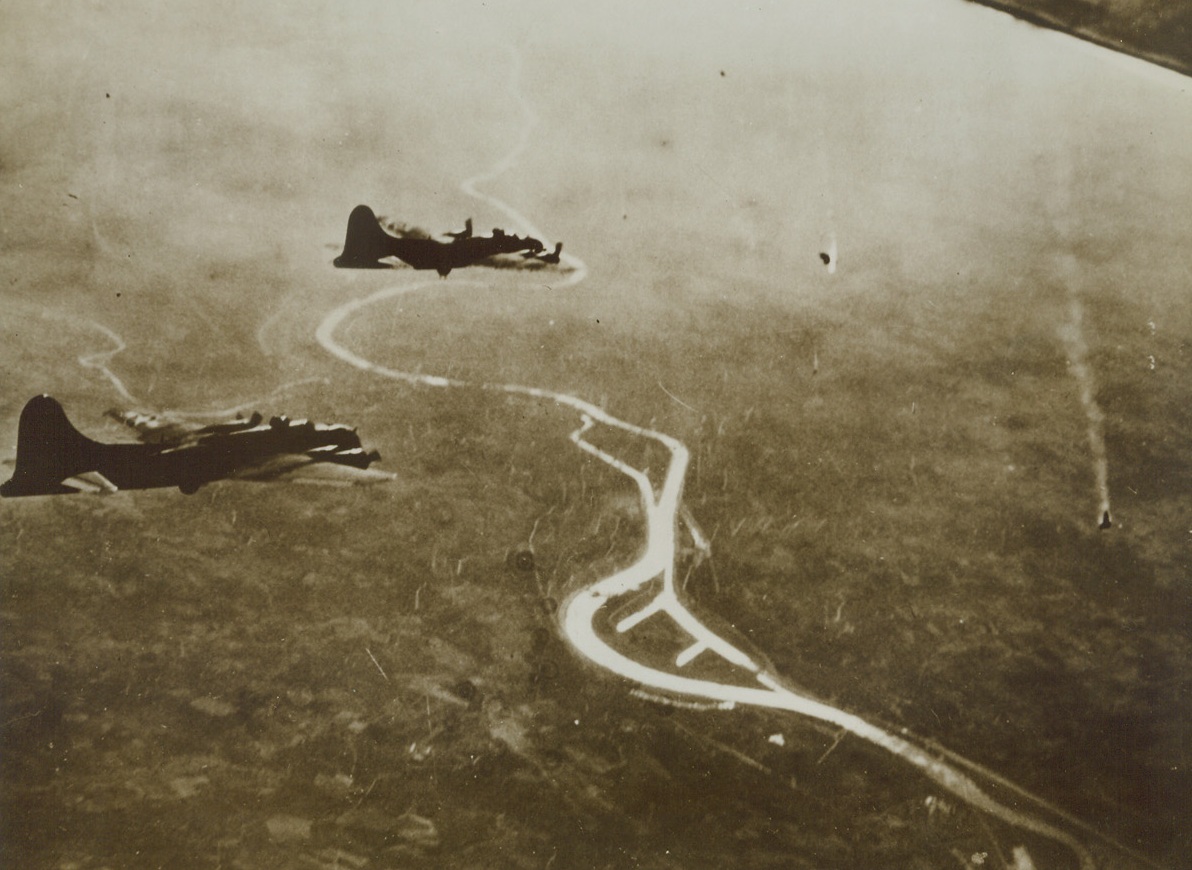
Nazi Planes Scatter – in Pieces, 9/2/1943. GERMANY—Flaming pieces (right) mark the end of a German Messerschmitt 110 during a Flying Fortresses attack on the ball-bearing factory at Schweinfurt. August 17, when the 147 Nazi Fighter planes. The fierce daylight battle raged for hours amid scenes like this one where the massed fire power of the famous bombers is too powerful for the enemy flying resistance. Credit: ACME.;
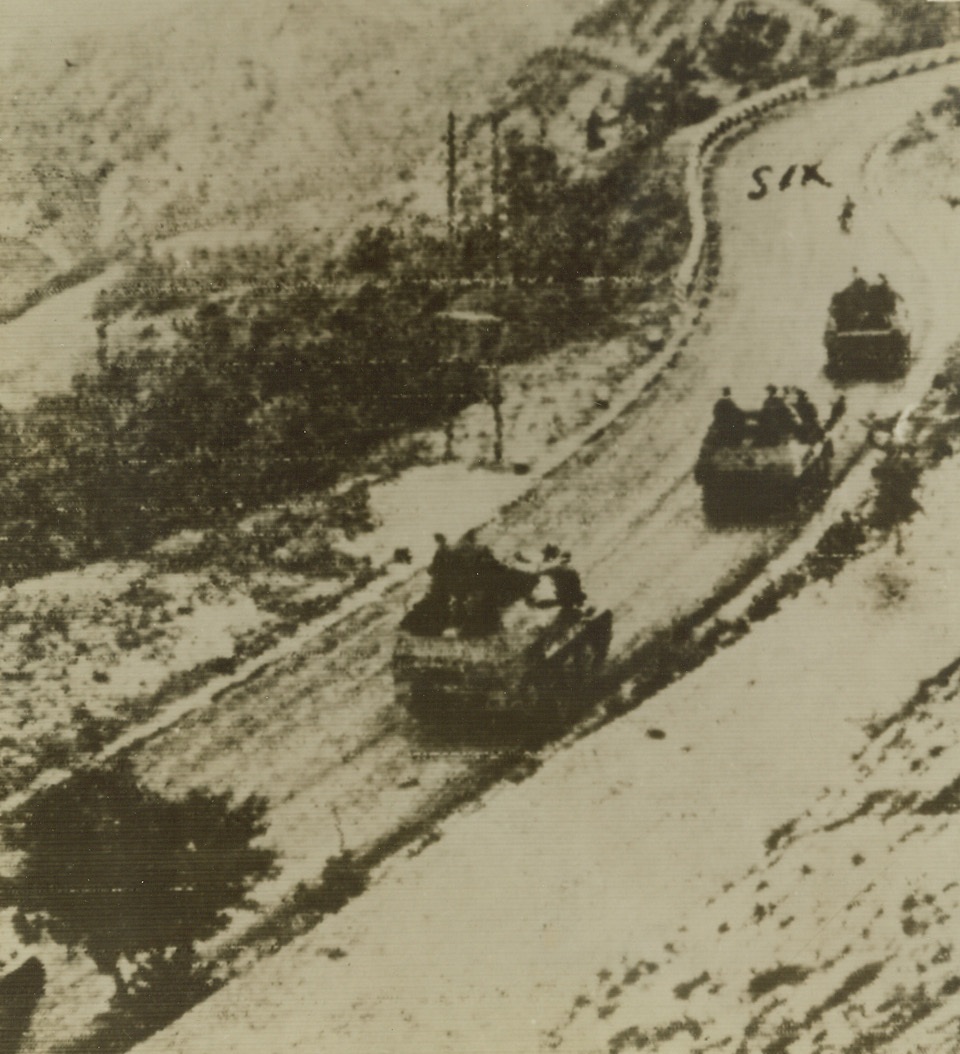
Nazi Reinforcements in Italy, 9/19/1943. ITALY—Led by a motorcycle, German motorized units roll southward over a curving north Italian mountain road, according to the German caption of this photo appearing in a Berlin newspaper. These four tanks may be on their way to reinforce northern garrisons taxed with quelling Italian resistance. Credit: ACME RADIOPHOTO.;
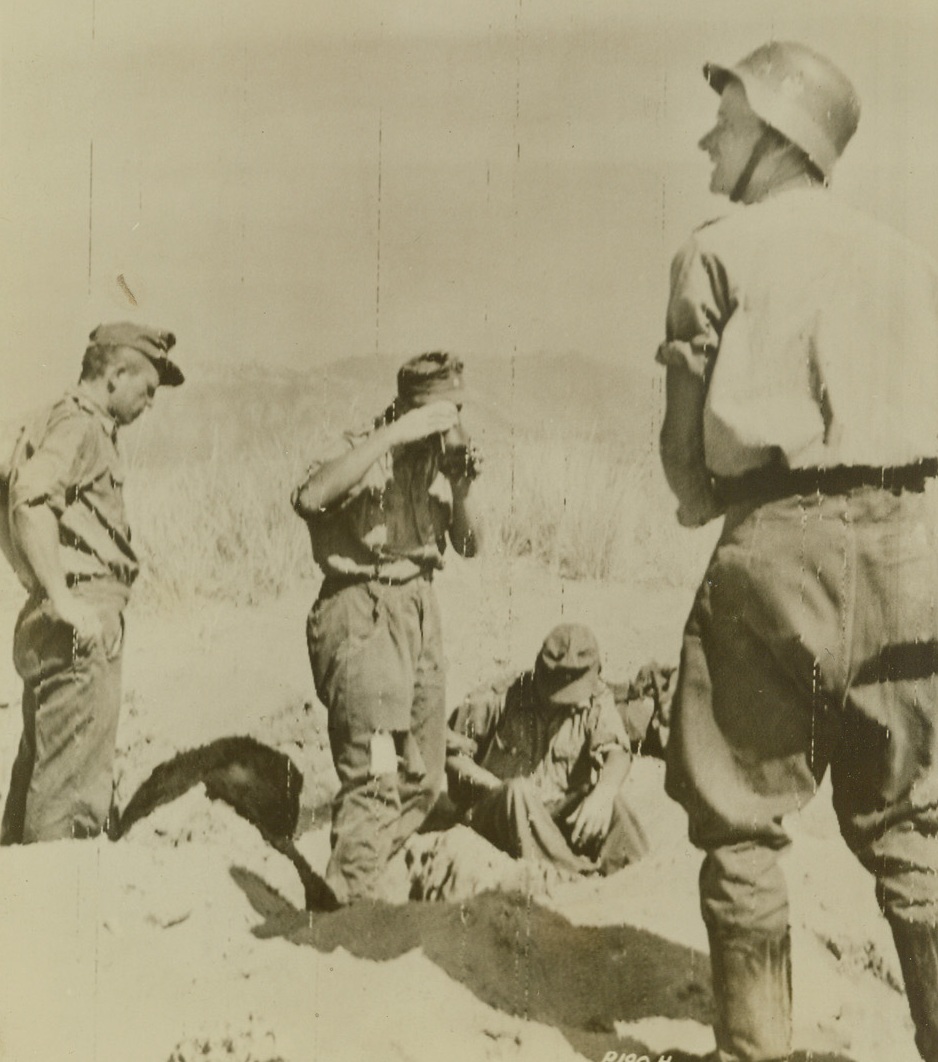
Defense Against their Own Planes, 9/17/1943. ITALY—After losing their first encounter with American troops on Allied soil and being taken prisoner; these crestfallen Nazi soldiers dig foxholes to protect themselves from bombing and strafing by their own planes. One Nazi takes a drink from his canteen before digging in. Credit: SIGNAL CORPS RADIOTELEPHOTO FROM ACME.;
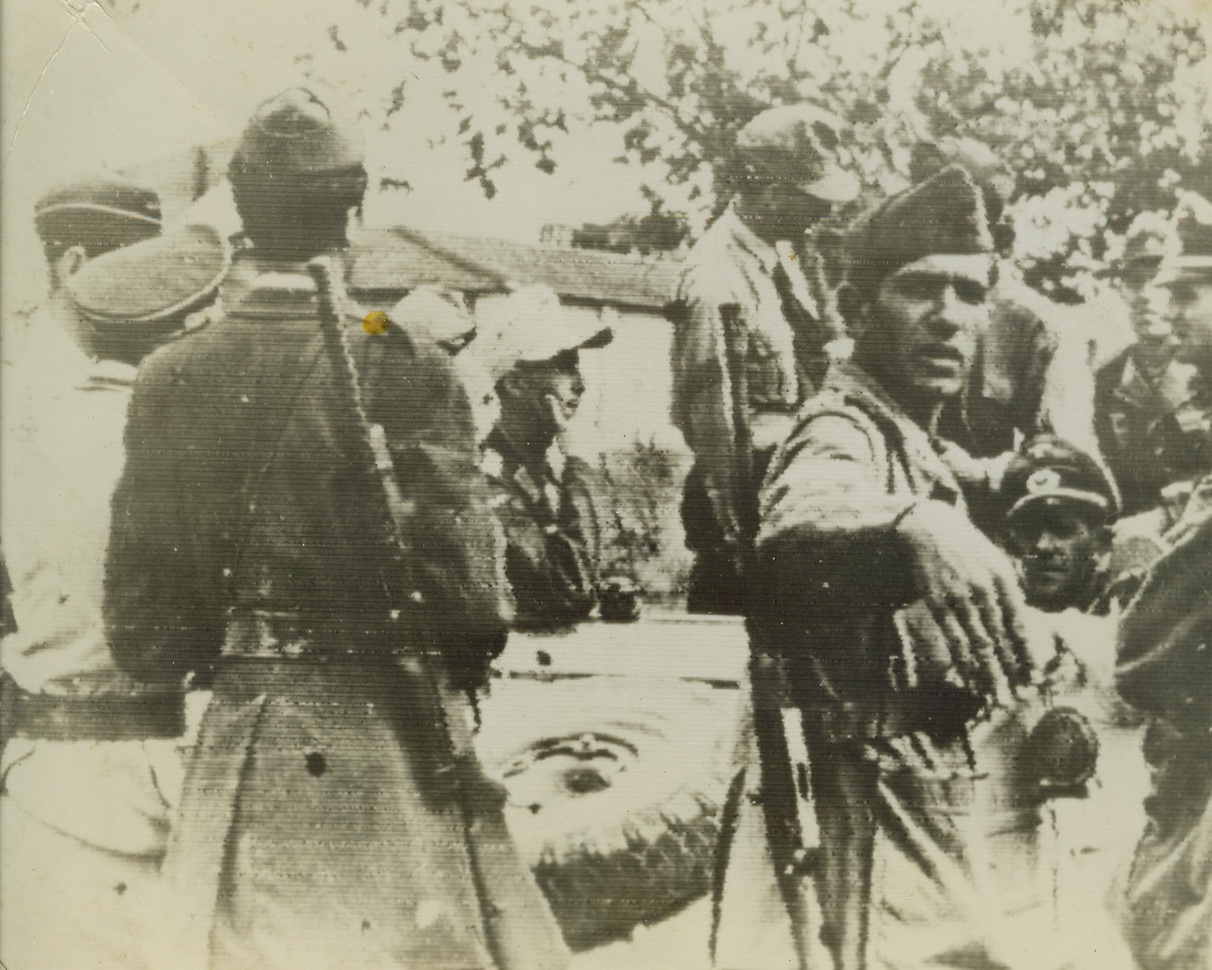
Nazis Seize Rome, 9/19/1943. The German caption, accompanying this photo in a Berlin newspaper, say that the Nazi officer (right, between soldiers), who is seated in a small armored care, is “discussing” the capitulation of Rome with Italian soldiers. Listening to the one-sided “discussion” is another German officer, behind the car, and a Nazi soldier who wears a white cap and thinks things over, chin in hand. Credit: ACME RADIOPHOTO.;
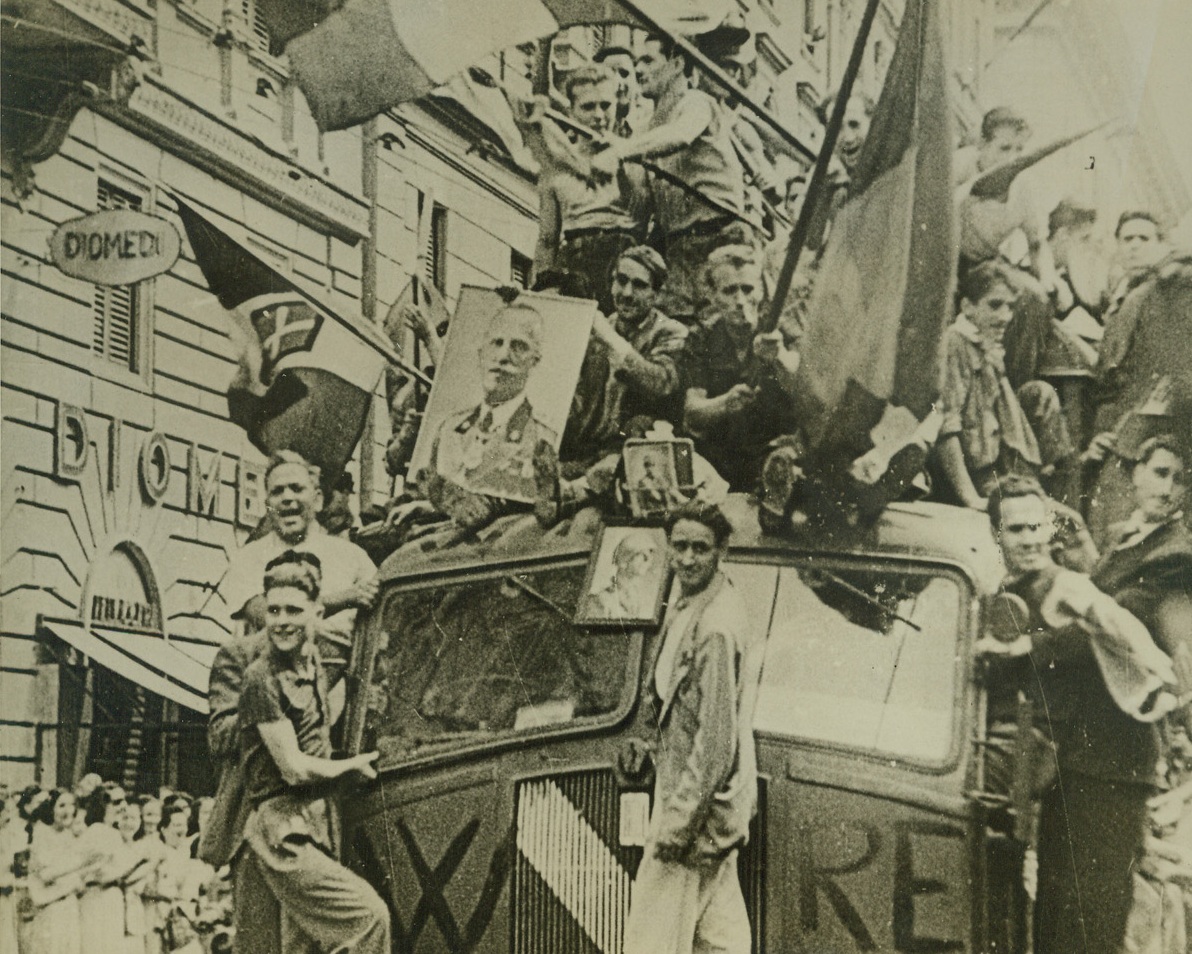
Demonstrators on a Bus, 9/17/1943. ROME—Italians, celebrating the downfall of Mussolini on July 25th, clamber atop the roof and the front of a bus in the streets of Rome to wave Italian flags, pictures of King Victor Emmanuel, and shout their approval of the capitulation of Le Duce. This photo is from an Italian newsreel obtained through a neutral source. Credit: ACME.;
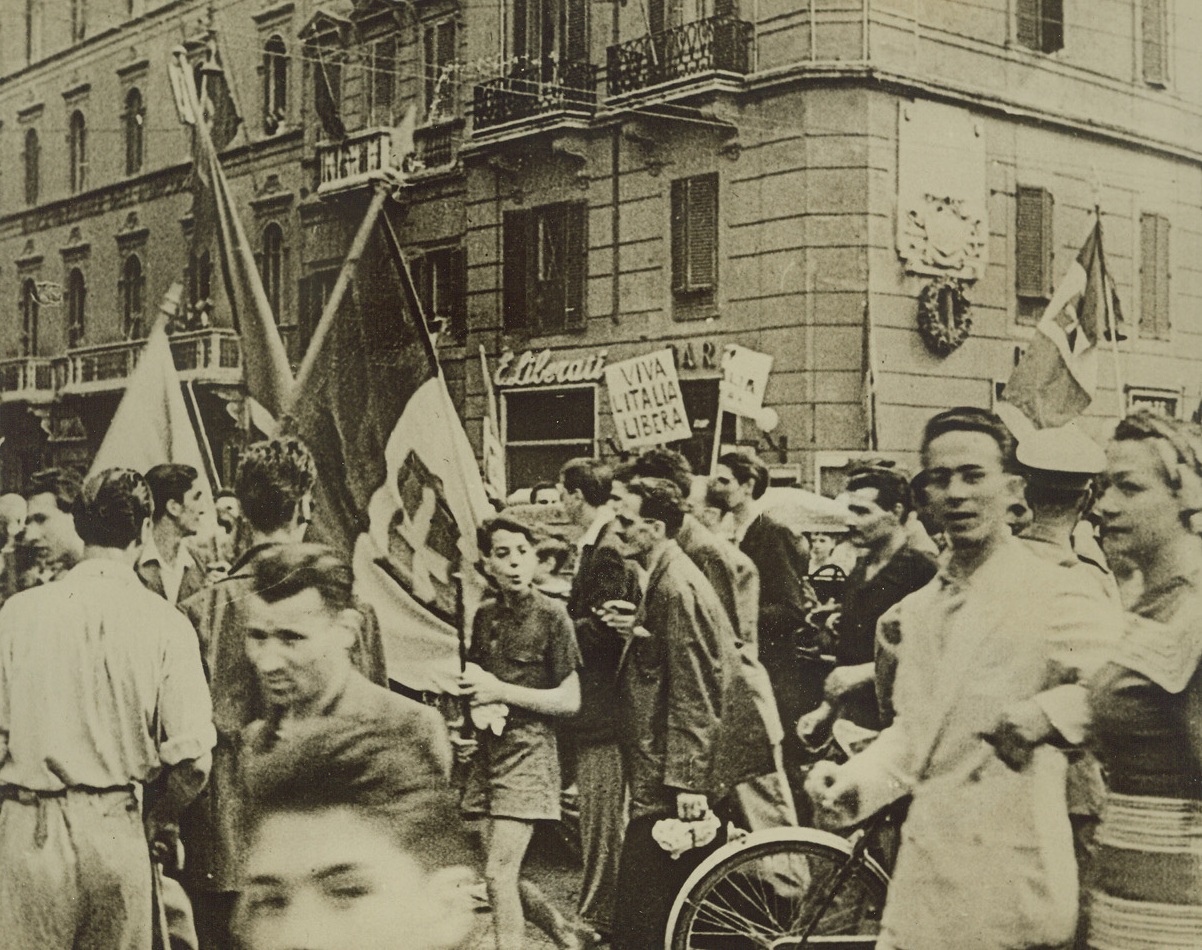
The People Rejoice, 9/17/1943. ROME—Milling through the streets of Rome, carrying banners and placards, the Italian people celebrate the downfall of Benito Mussolini, soon after his “resignation” was announced, on July 25th. This photo is from an Italian newsreel, obtained through a neutral source. Credit: ACME.;
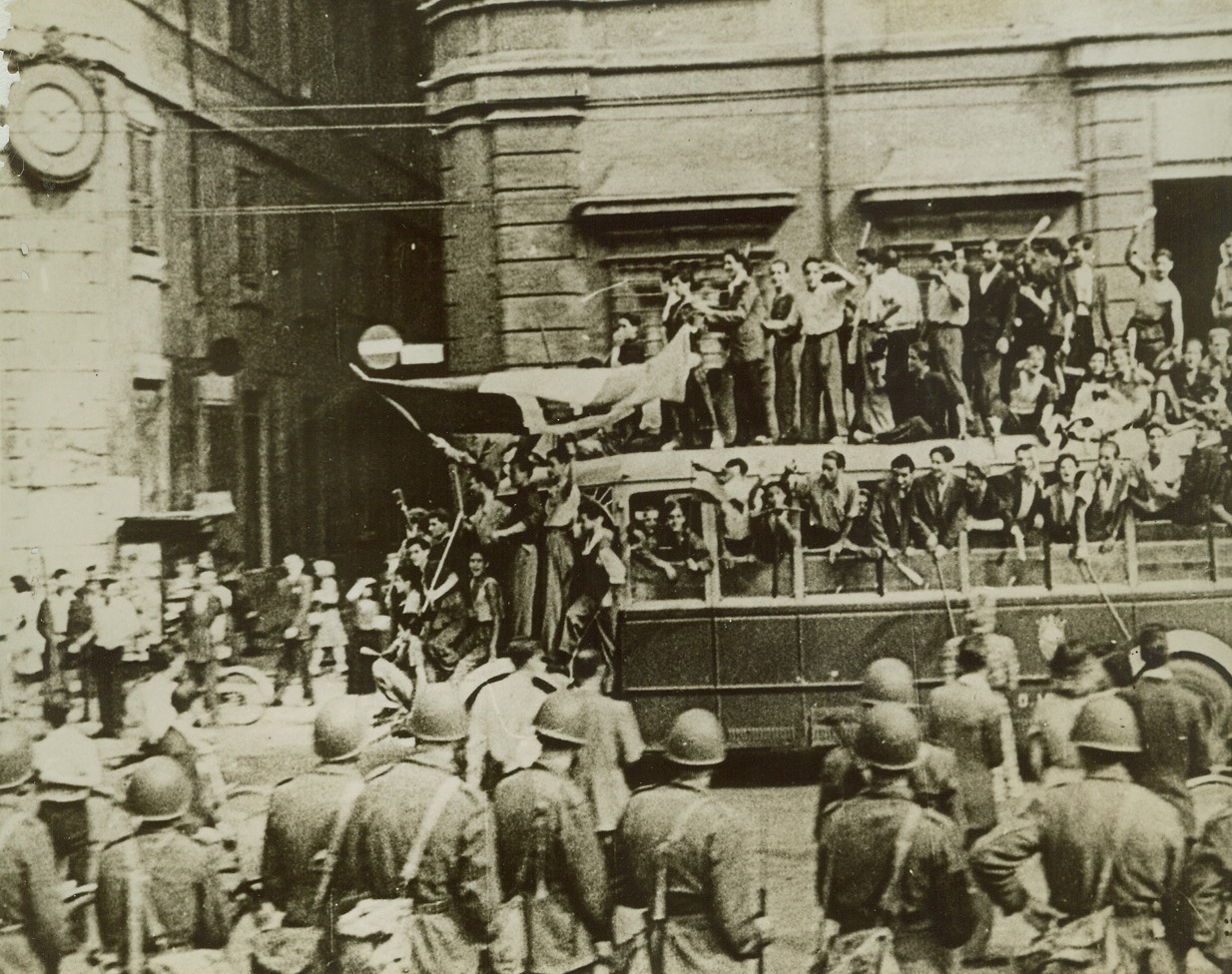
Glad to Be Rid of Benito, 9/17/1943. ROME—Turning out into the streets of Rome to shout their approval of the ousting of Benito Mussolini, these happy Italians jam a bus and climb to the roof of the vehicle to celebrate. Italian soldiers look on as the liberated Italians demonstrate. This photo if from an Italian newsreel, obtained through a neutral source. Credit: ACME.;

Clipped Fortress, 9/17/1943. Its bomb load delivered to Naples, this B-17 Flying Fortress has just been hit by flak. Concussion from the flak has turned the ship over, and a portion of its wing is gone—but in spite of the serious damage, the ship managed to level and five parachutes opened as members of its crew dropped to safety.Credit: U.S. ARMY AIR FORCES photo from ACME.;
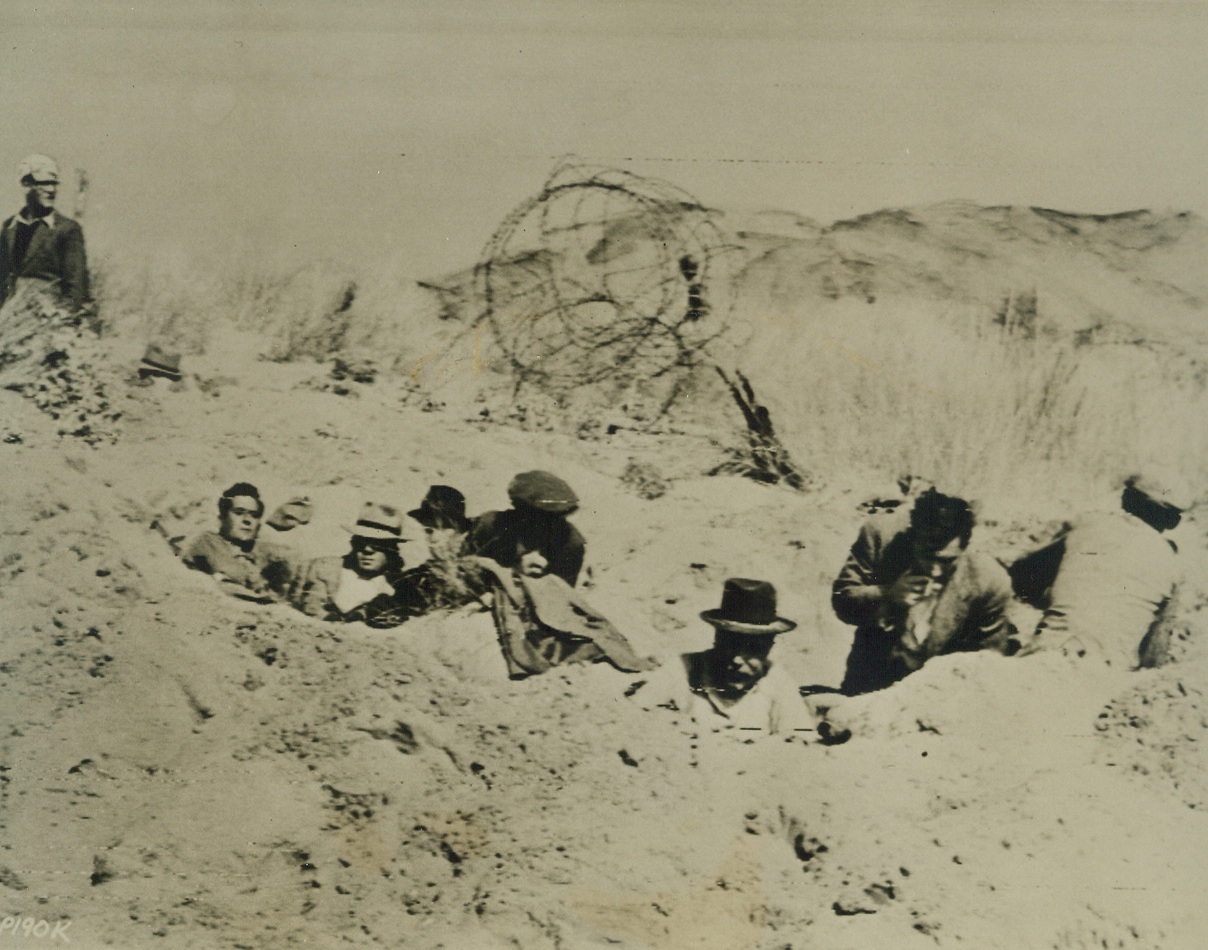
Italians Dig In, 9/17/1943. ITALY—American troops, invading the Italian mainland, came upon this group of Civilians on one of the beaches. Crouching in hastily-dug foxholes, the men sought safety from bombing and strafing attacks by their own planes. Credit: SIGNAL CORPSS RADIOTELEPHOTO from ACME.;
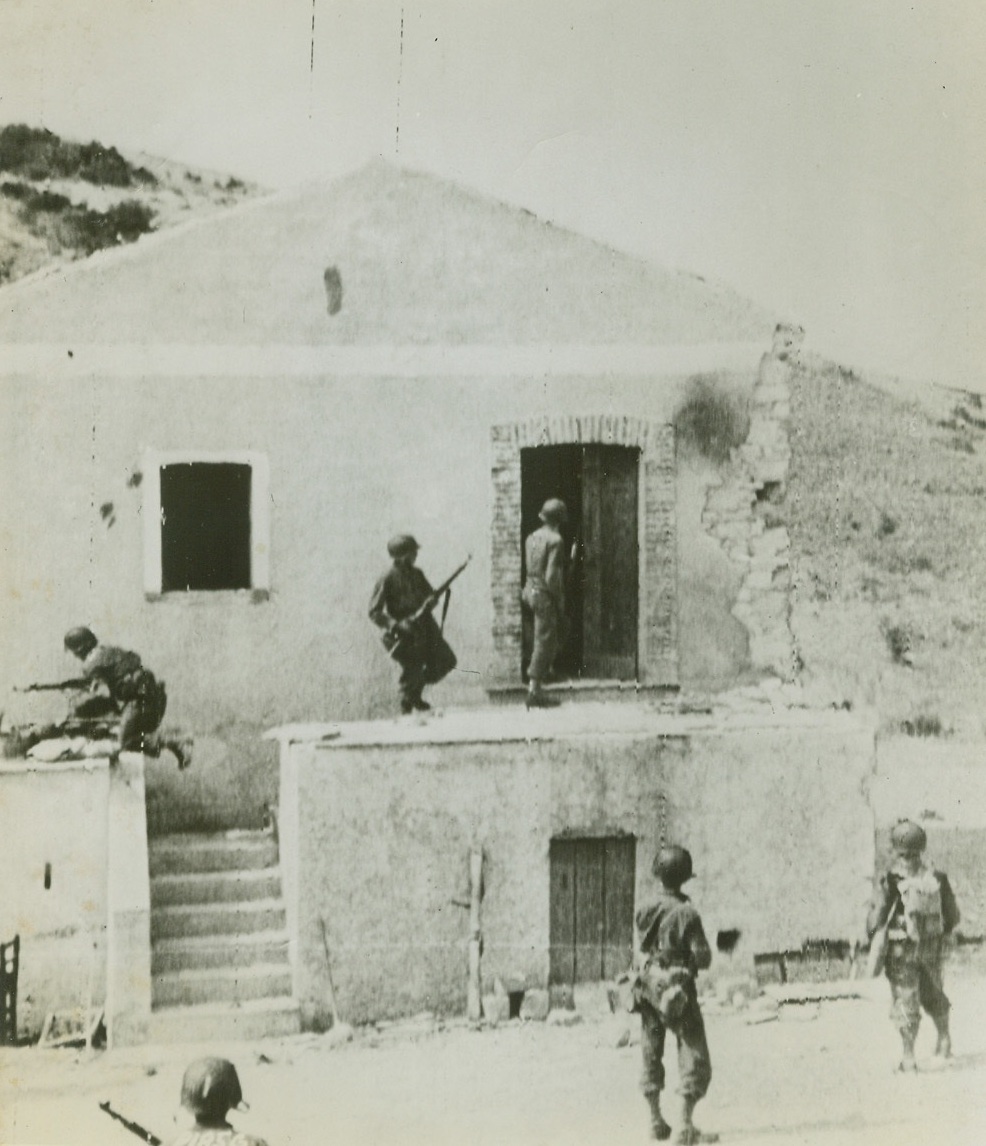
United States Troops Advance in Italy, 9/14/1943. The above photo flashed to the U S by radiotelephoto shows United States infantrymen ferreting out a German sniper who was hidden in this house during their advance through the outskirts of an Italian town. Credit: (U S Army Signal Corps Radiotelephoto from ACME);
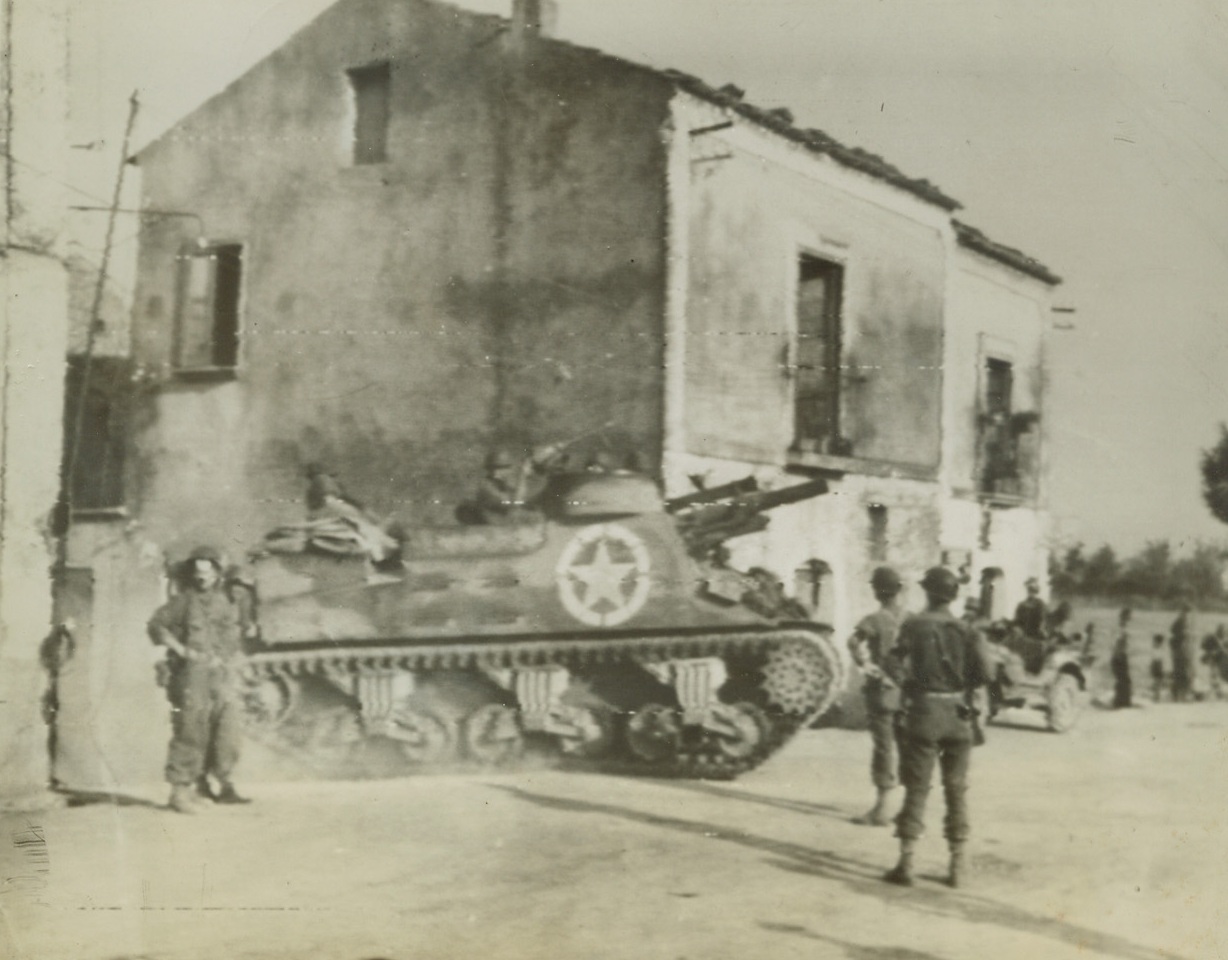
UNITED STATES TROOPS ADVANCE IN ITALY, 9/14/1943. The above photo flashed to the U S by Radiotelephoto shows an American tank destroyer entering a town in Italy on the morning of Sept. 10th after our troops had effected a landing near the town. Credit: U S Army Signal Corps Radiotelephoto from Acme;
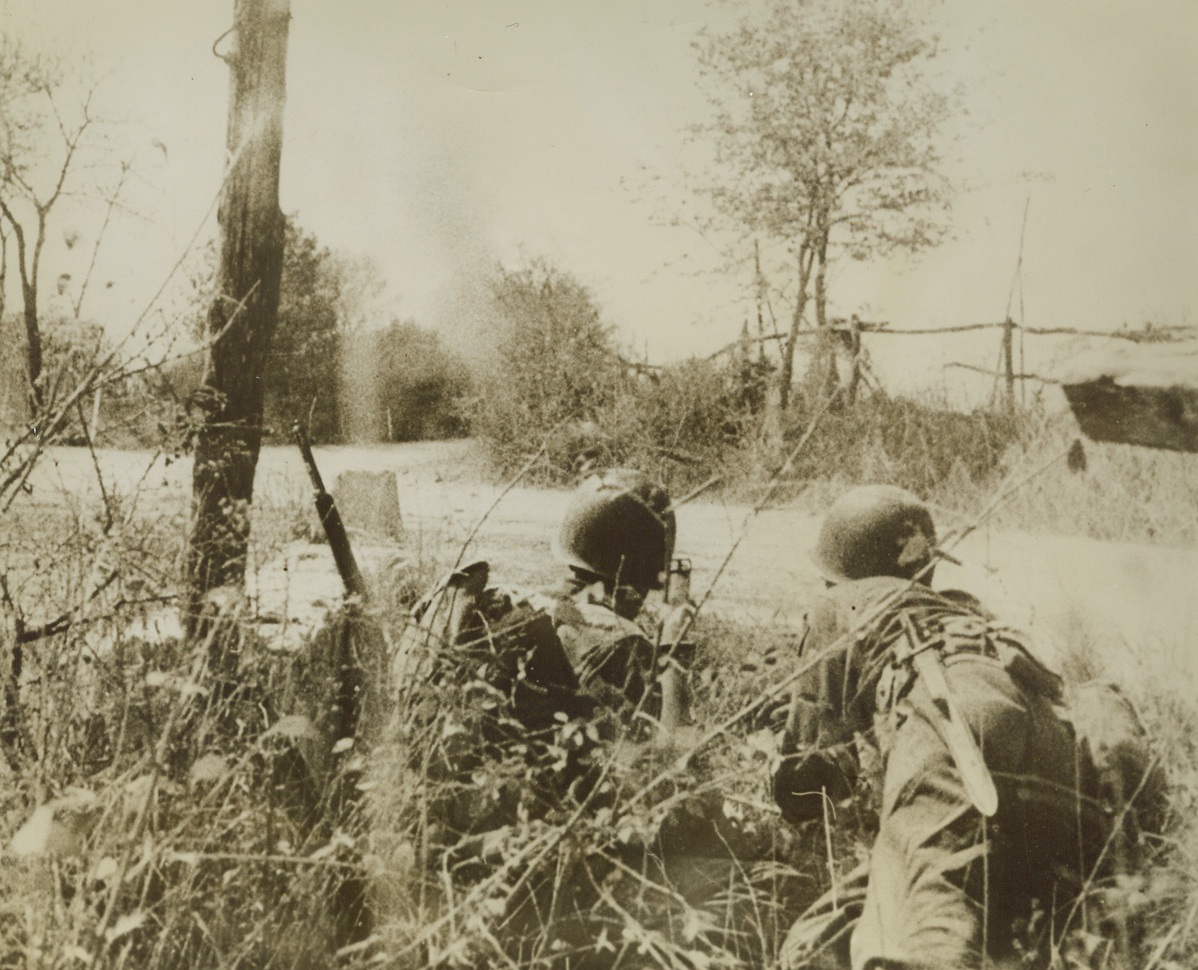
WAITING TO ADVANCE, 9/30/1943. SALERNO, ITALY—Tow Americans of the U.S. 5th Army, hug the ground waiting for the word to advance, in the bloody Battle of Salerno. Man on the left seems to be holding a “bazooka” ready for any Nazi tank that appears. Today, 5th Army forces are closing in on Naples and the fall of that city is expected momentarily. Credit: Newsreel pool photo from Acme;
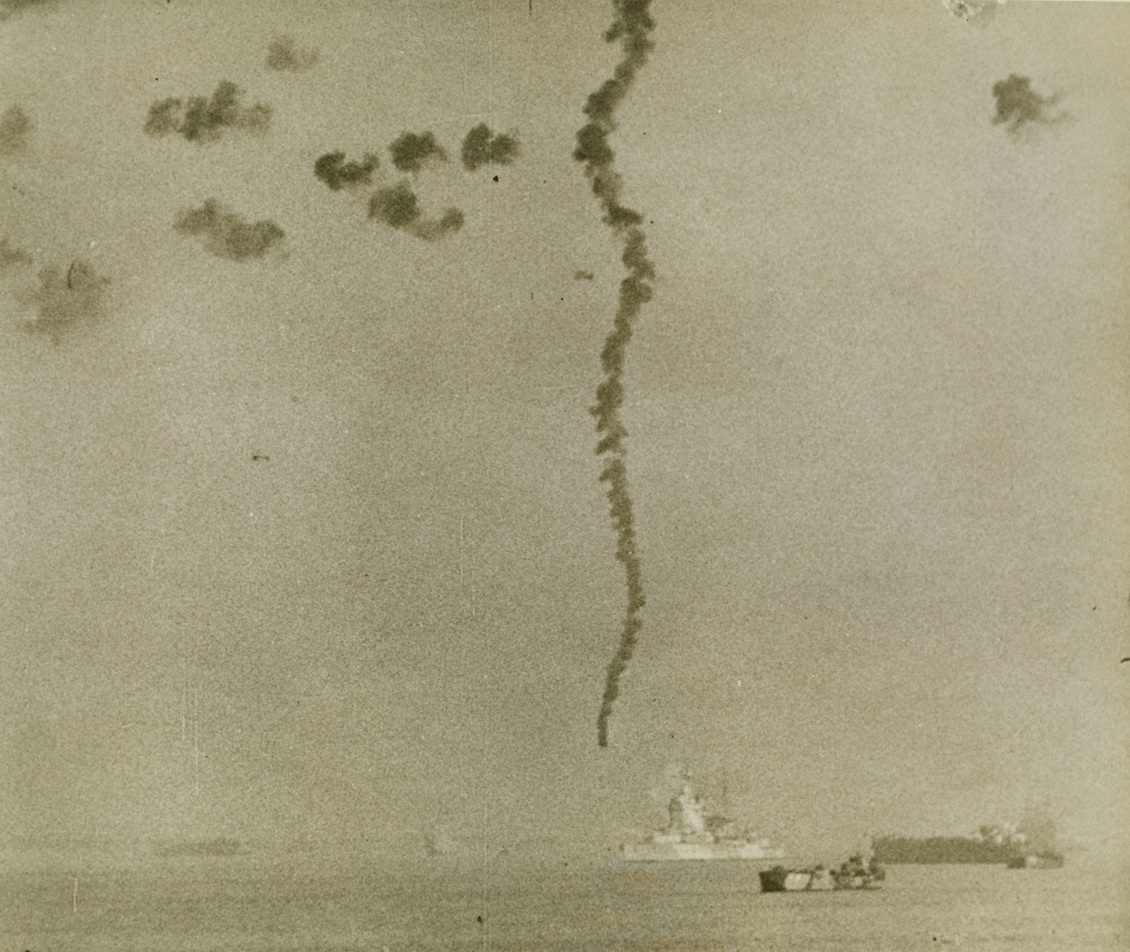
NAZI SKY-WRITING, 9/30/1943. SALERNO, ITALY—Our anti-aircraft is on the job as American landing forces approach Salerno, Italy, and an enemy plane trails a dark plume of smoke as it hits the water. On land, Nazi shore batteries keep up a constant barrage against the U.S. troops storming ashore. Credit: Newsreel pool photo from Acme;
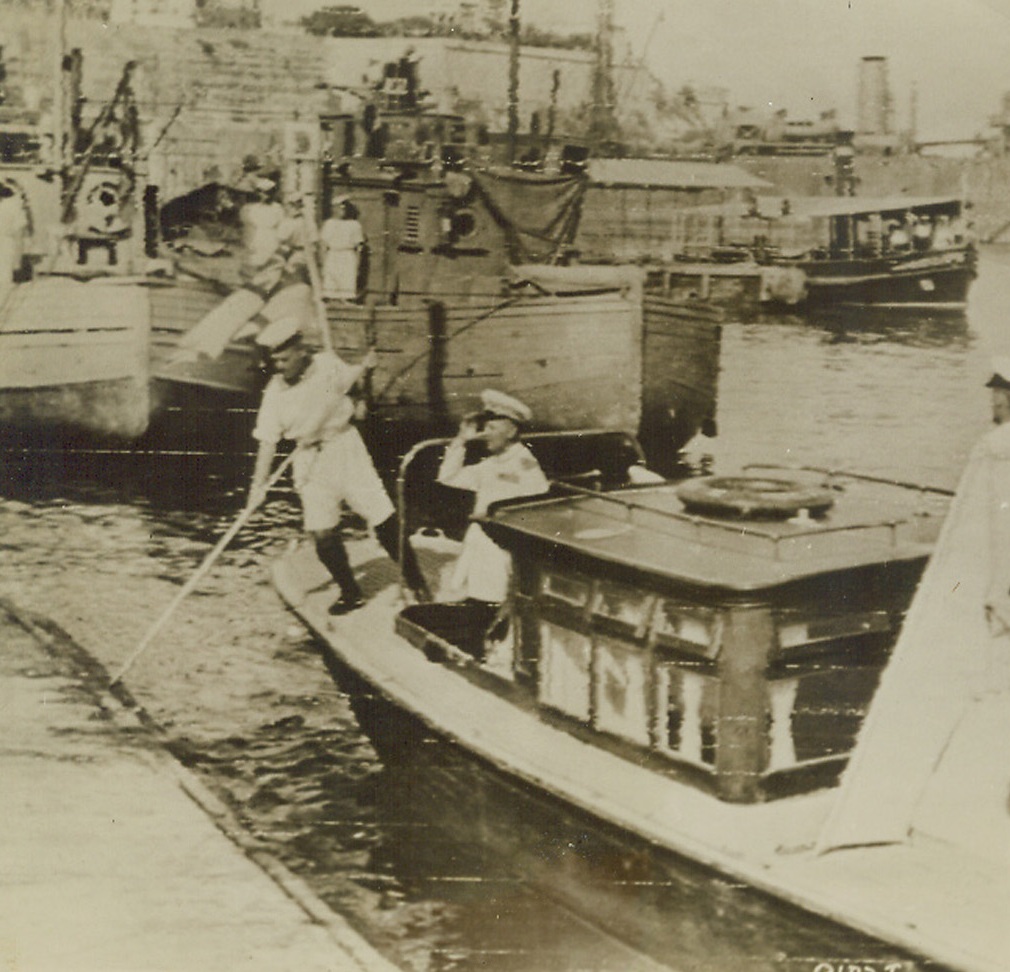
ITALIAN FLEET ARRIVES AT MALTA, 9/13/1943. This photo, flashed to the U.S. today by radiotelephoto, shows Admiral D’Zara of the Italian Fleet, landing from his barge at Valetta, Malta, after his arrival with the bulk of the Italian Fleet for formal surrender to the Allies. Just after this photo was taken, Admiral D’Zara conferred with Admiral Sir Andrew Browne Cunningham, Allied Commander-in-Chief, Mediterranean Naval Forces. Credit: U.S. Signal Corps radiotelephoto from Acme;
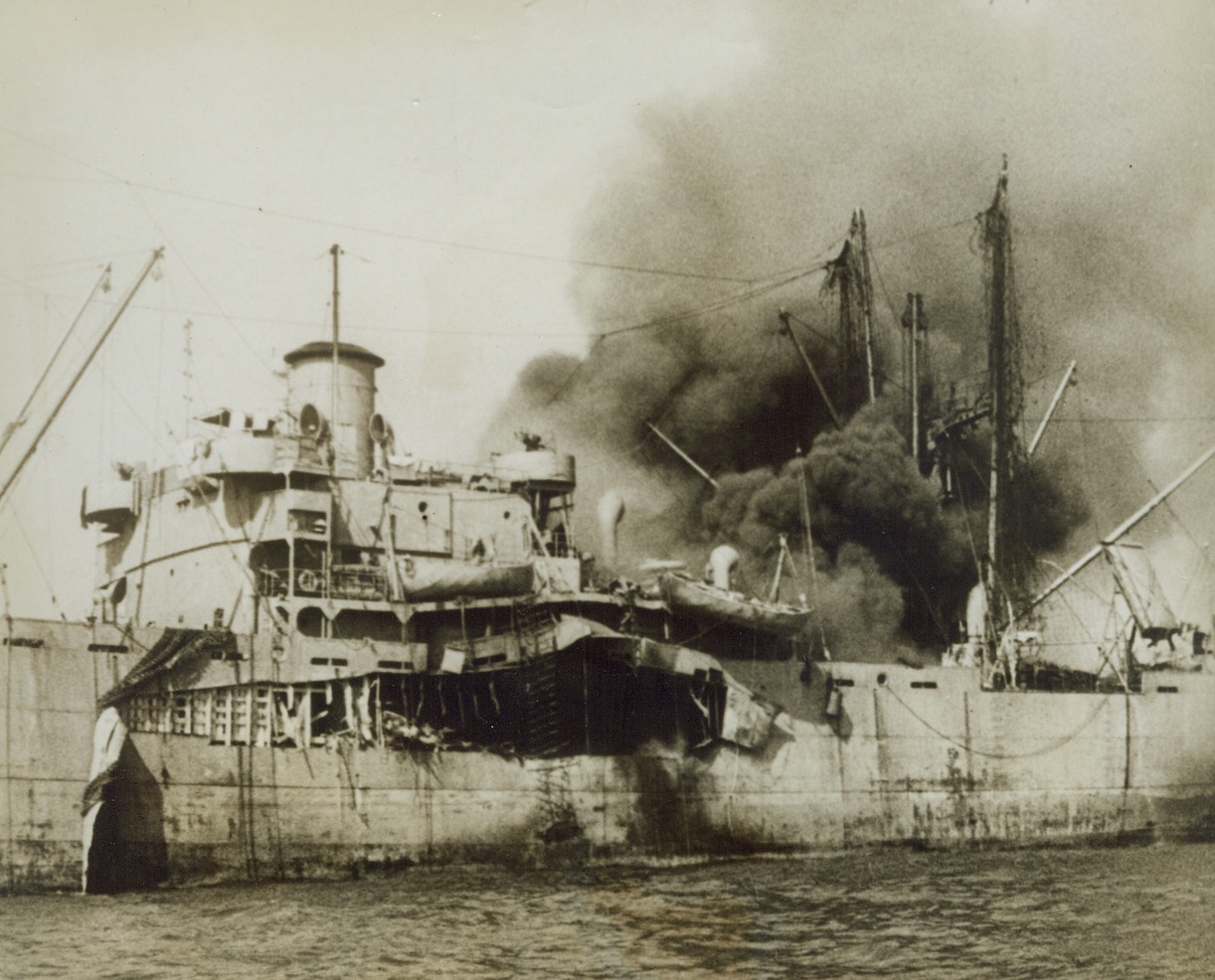
VICTIM OF A NAZI BOMB, 9/30/1943. SALERNO, ITALY—An Allied merchantman is blown wide open by a Nazi bomb as our forces effected their landings at Salerno under a barrage from enemy shore batteries and bombers. Credit: Newsreel pool photo from Acme;
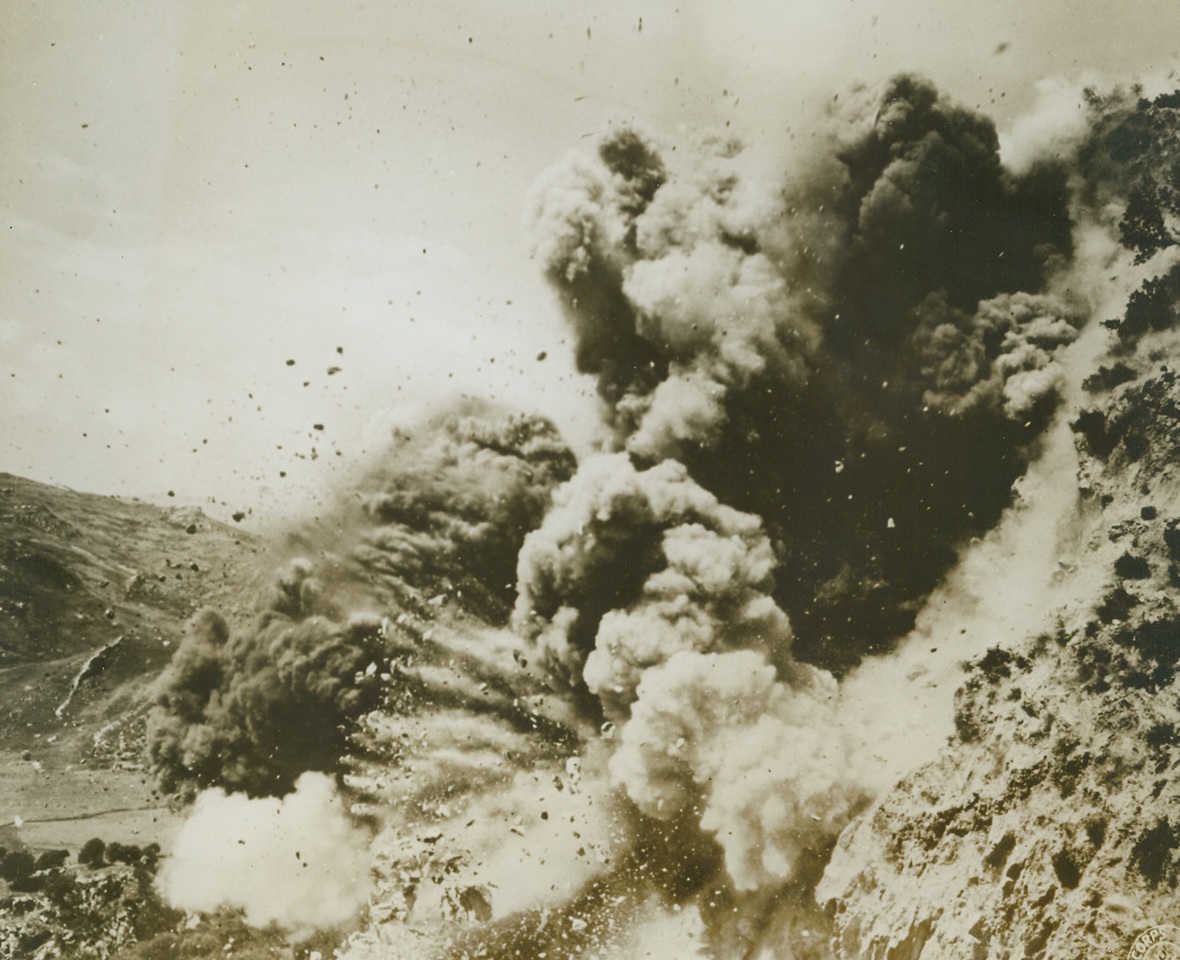
THE BIG BANG, 9/24/1943. SICILY—Clumps of sod mix with clouds of smoke and dust as demolition charges of American combat engineers do their stuff in Sicily. The charges were used to clear a series of road blocks built by retreating Axis fighters. Credit: Signal Corps photo released through Treasury War Bond Drive—from Acme;
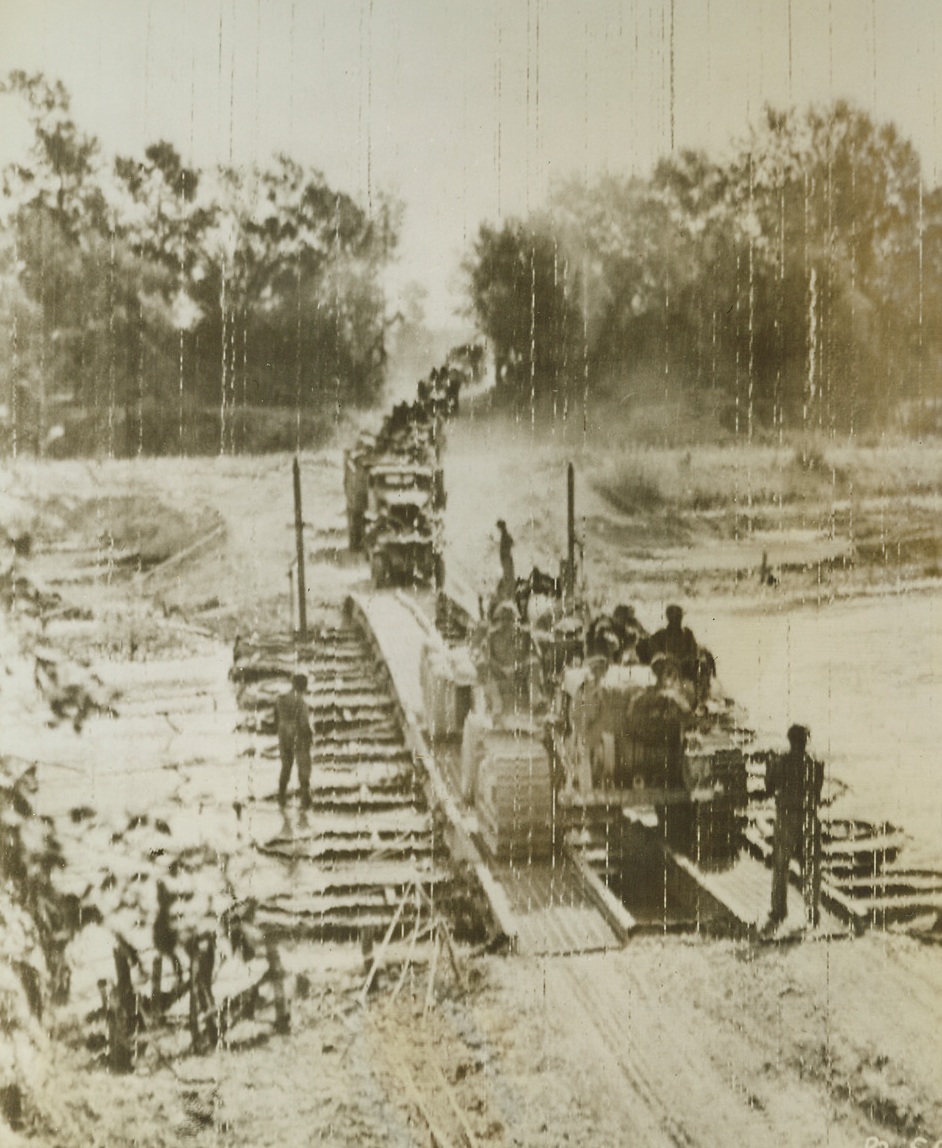
GUNS TRAVEL TO THE FRONT, 9/26/1943. ITALY—Drawn by tractors, these big guns cross a bridge, built by American Army engineers, as they head for the Italian fighting front. Credit: Signal Corps Radiotelephoto from Acme;

THEY GAVE THEIR LIVES, 9/30/1943. Coast Guardsmen silently transfer the shrouded bodies of two American soldiers from an invasion barge to a waiting Coast Guard transport. A short time before, these heroic Yanks were part of the first wave of fighters to pour into Italy and the Battle of Salerno. Casualties among our men, from July 10th to Sept. 15th, mounted to approximately 12,000, Secretary of War Stimson announced in his press conference today (Sept. 30th). Credit: U.S. Coast Guard photo from Acme;
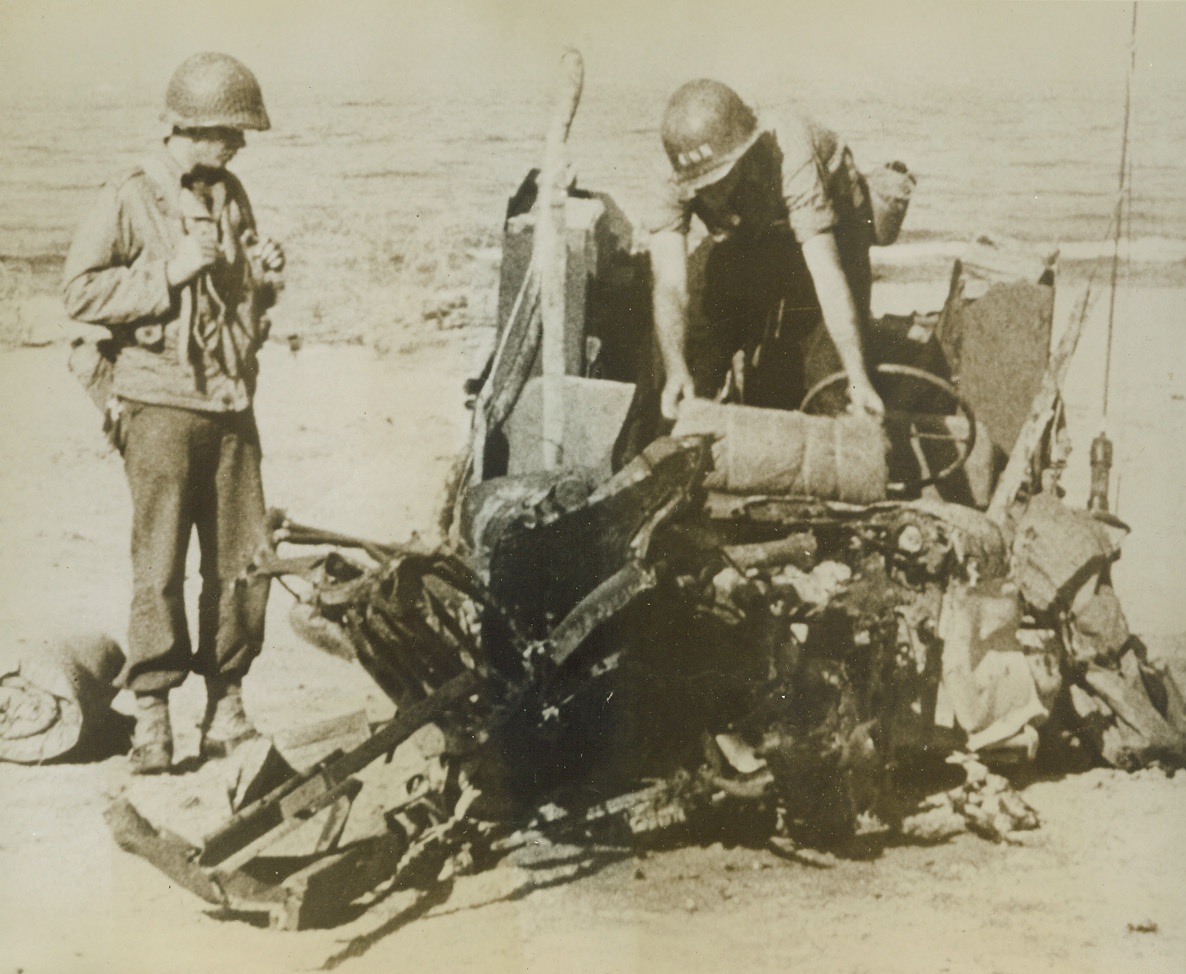
When Jeep Meets Mine, 9/30/1943. SALERNO – This is what happened when an American Jeep met a land mine, buried in the beach, during the invasion of Salerno. A soldier and a member of a Navy beach party examine the wreckage. Credit Line (U.S. Coast Guard Photo from ACME);
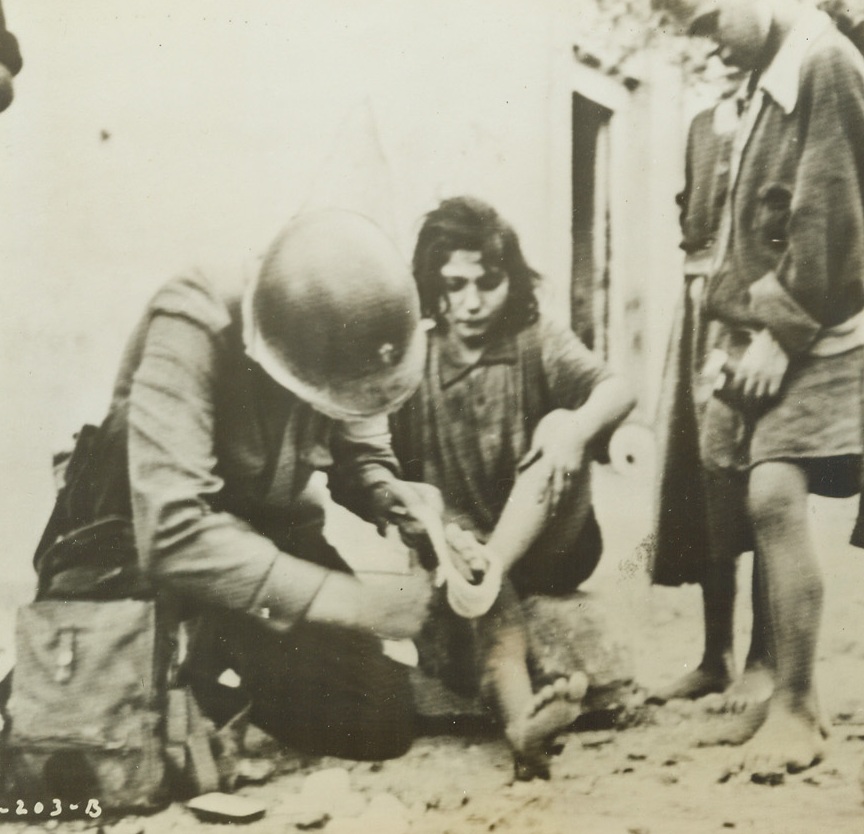
First Aid, 9/27/1943. ITALY – Lt. William E. King, chaplain, of Kansas City, Mo., administers first aid to a little Italian girl whose foot was cut by shrapnel. Photo by Acme photographer Charles Corte for War Picture Pool and flashed to U.S. by Signal Corps Radiotelephoto. Credit Line (ACME);

Shelling Our Boys on the Beach, 9/24/1943. IN THE NAPLES AREA – An enemy shell sends a geyser of water shooting up in the background as Allied soldiers land in the Naples area. As the shells fly thick and fast, the boys scamper up the beaches, from landing craft. Credit Line (Photo by Charles Corte, ACME Photographer for War Pool);
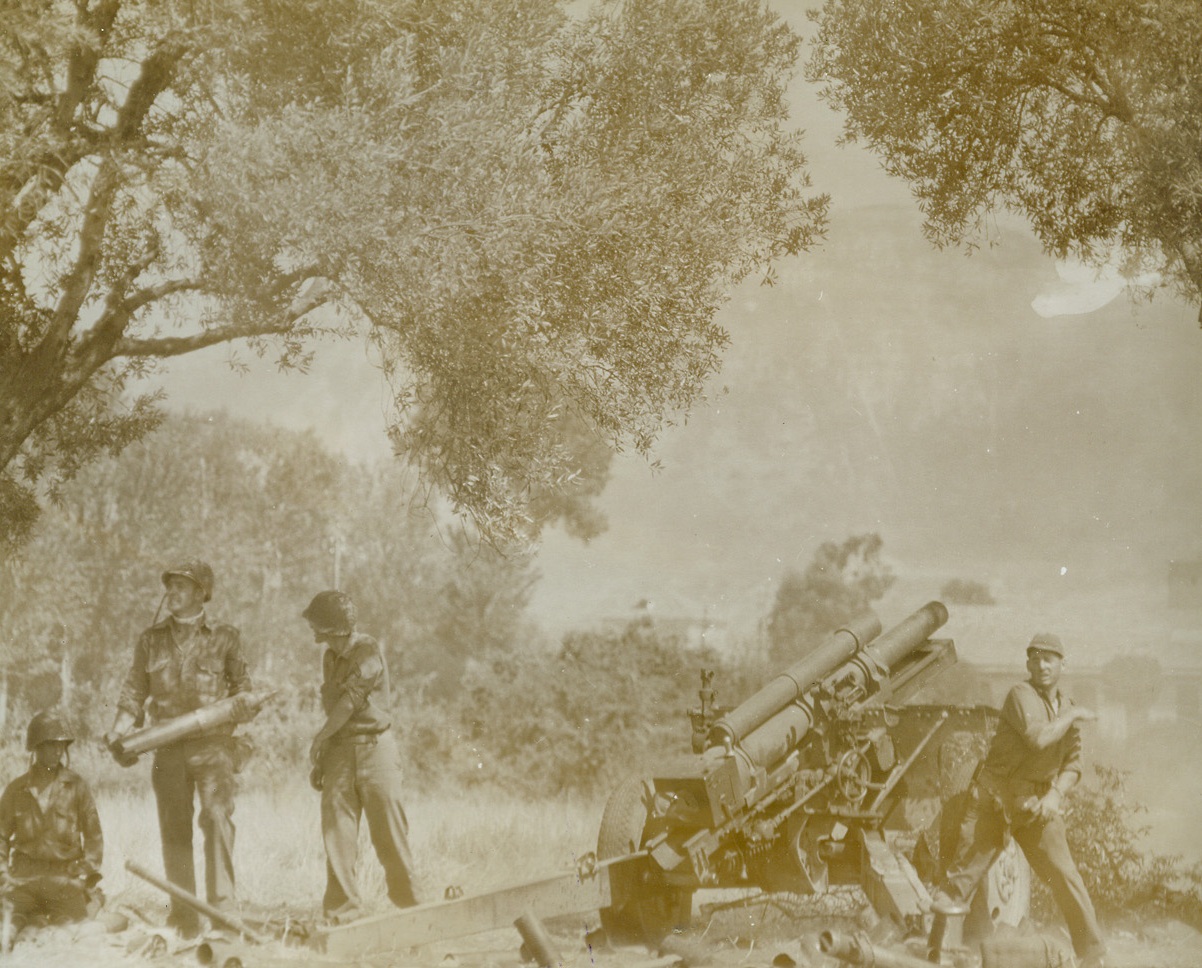
“And One for Sister Annie”, 9/24/1943. IN THE NAPLES AREA – “And one for sister Annie, “ yells Sgt. John C. Brunnett, of St. Paul, Minn., as he yanks the cord of a 105mm howitzer blasting enemy lines in the Naples area. Sgt. Brunnett labels each of the missiles he sends away – wreaking the vengeance of his entire family on the Axis gangsters. Credit Line – WP – (Photo by Charles Corte, Acme Photographer for War Pool);
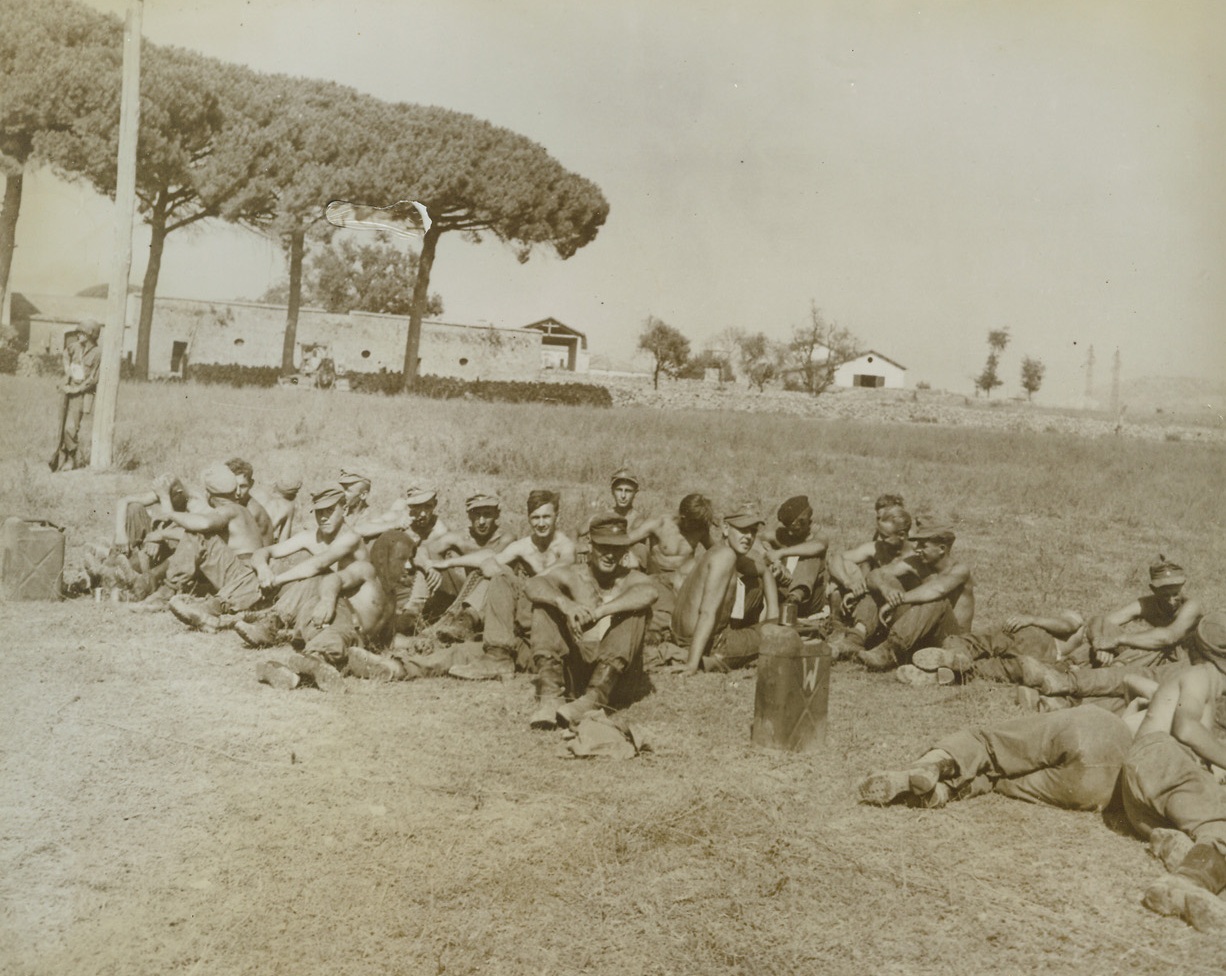
Snared Supermen, 9/25/1943. ITALY – Taken in the Salerno area, these Nazis were among the first prisoners captured by the Allies in the invasion of the Italian mainland. Squatting dejectedly, they are being guarded by the doughboy who leans against a pole in the left background. About 2000 Nazis have been taken by the Fifth Army. Credit Line – WP – (ACME);
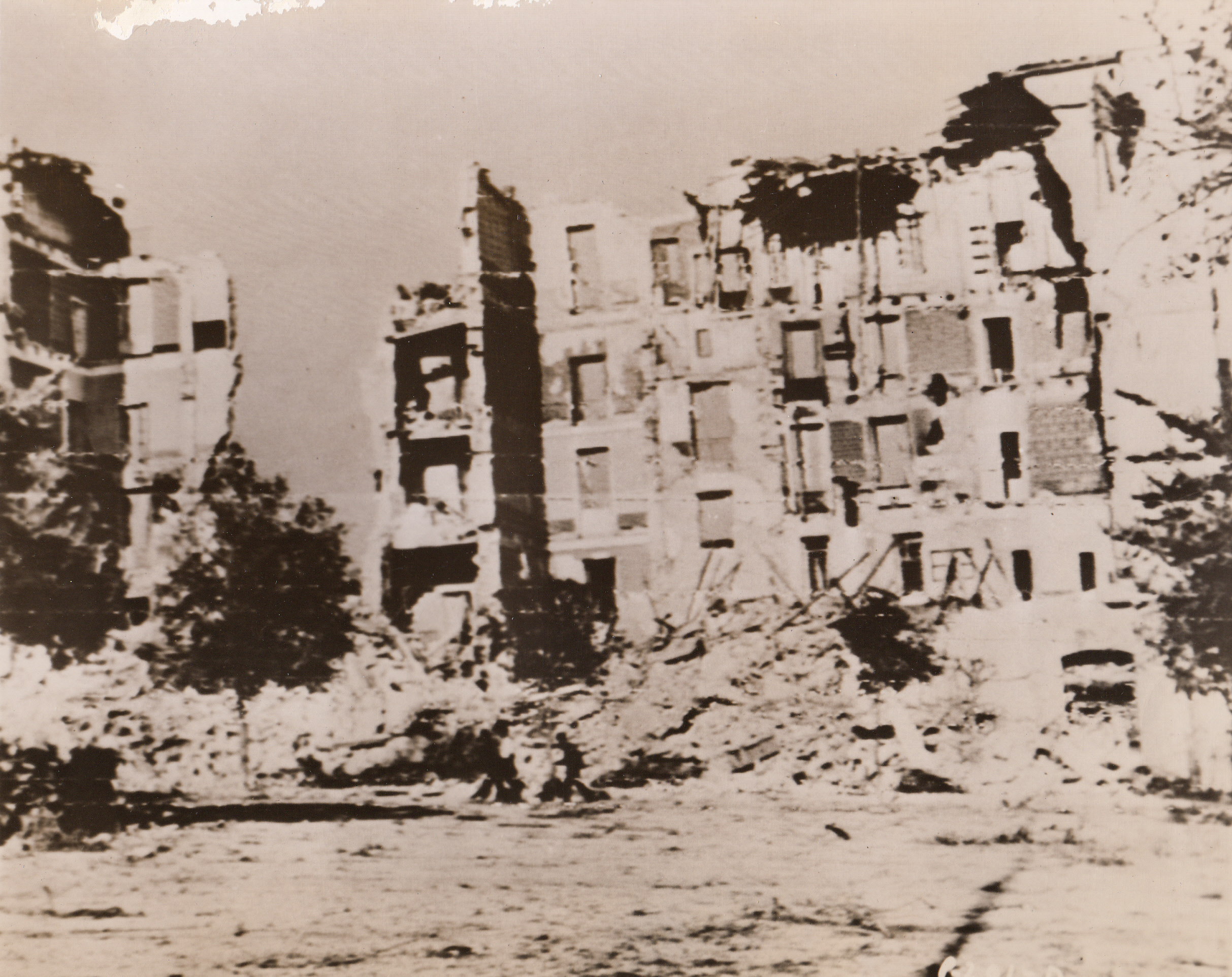
Grim Evidence, 9/25/1943. EBOLI, ITALY – Here is grim evidence of the accuracy of American bombardiers. This wrecked building in Eboli was one of many destroyed when our airmen raided the important mountain town.;

Artillerymen’s Work, 9/25/1943. ITALY – A thick curtain of smoke shoots up from an Italian tobacco factory building as Allied artillery shells find their mark. The building was being used by Germans as an artillery observation post. Our shells first battered the walls and roof in, and later they ignited what was probably an ammunition dump, causing an explosion. Credit Line – WP – (ACME);

He Didn’t Make It, 9/25/1943. AGROPOLI, ITALY – This Nazi soldier was cut down by American gunners as he was about to vault over this protective wall on the road to Agropoli. The German was laying mines along the road when he was killed. He fell with such force that his helmet landed several feet away. Credit Line (Official Navy Photo from ACME);
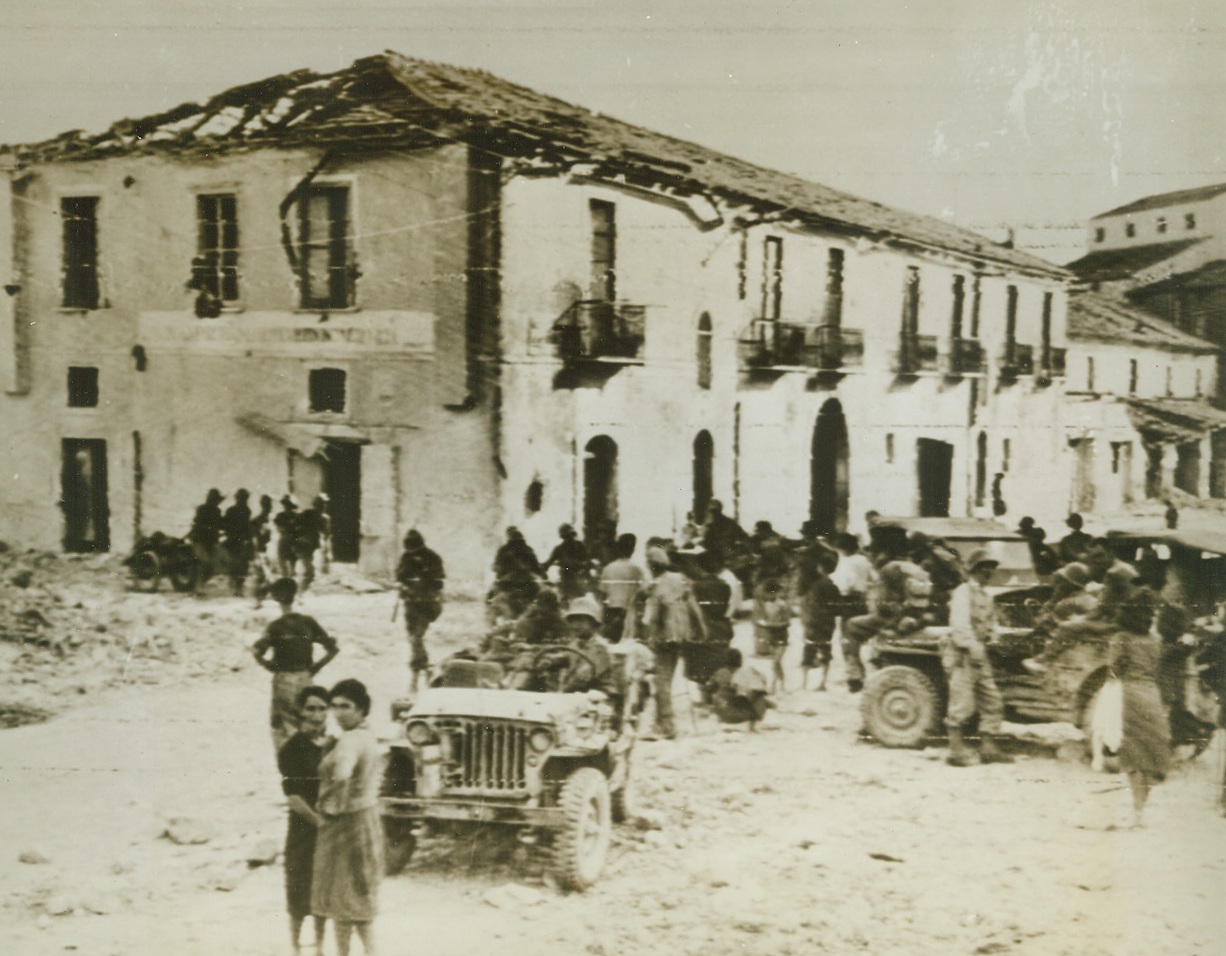
Americans Enter Eboli, 9/25/1943. EBOLI, ITALY – Curious Italian peasants come down to the streets to watch American troops roll through Eboli after occupying that strategic mountain city. Photo, by Acme photographer Charles Corte, was flashed to the U.S. via Radiotelephoto. Credit Line (Signal Corps Radiotelephoto – ACME);
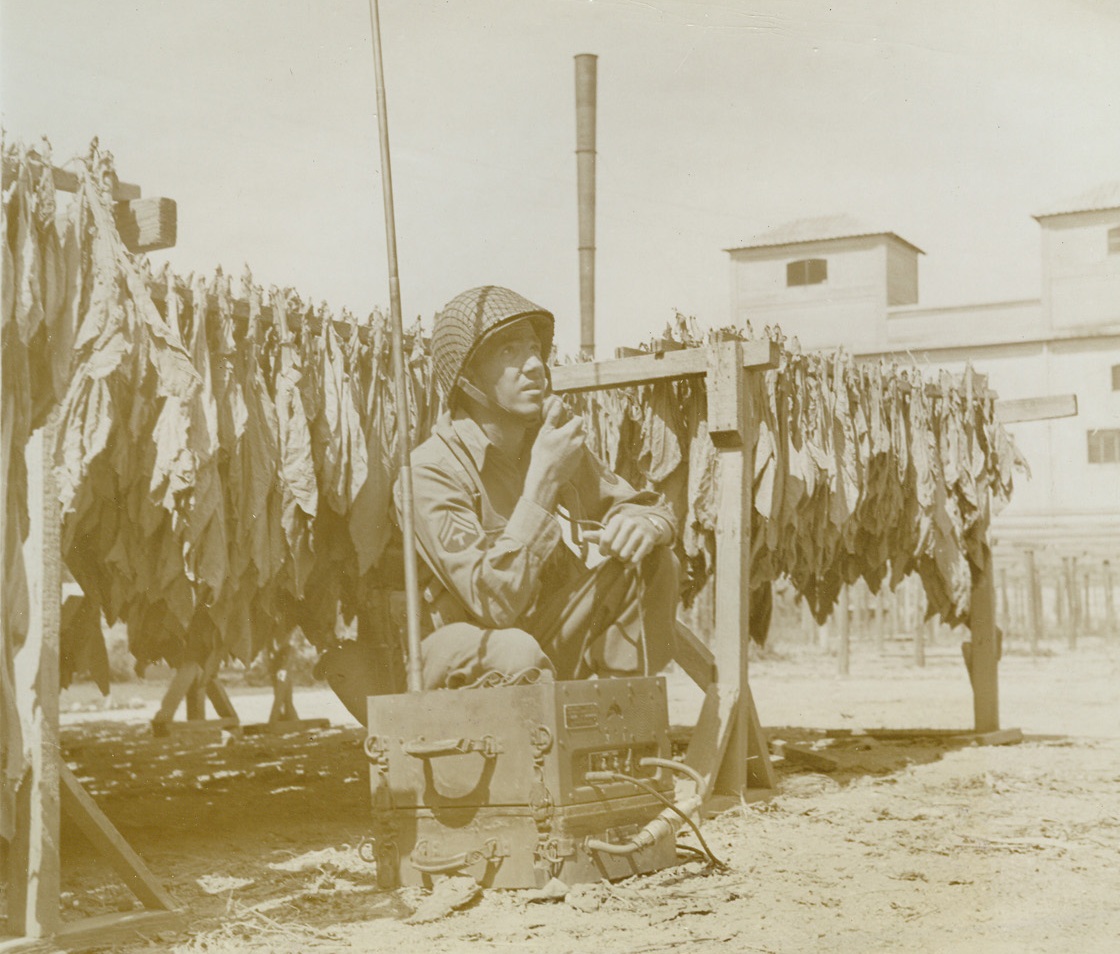
No Smoking, 9/28/1943. ITALY – Crouched beneath his excellent camouflage screen of real tobacco, Cpl. C.L. Ball, of Dallas, Texas, spots enemy aircraft. He is a radio transmitter and receiver on the Italian front. Credit Line (ACME); v
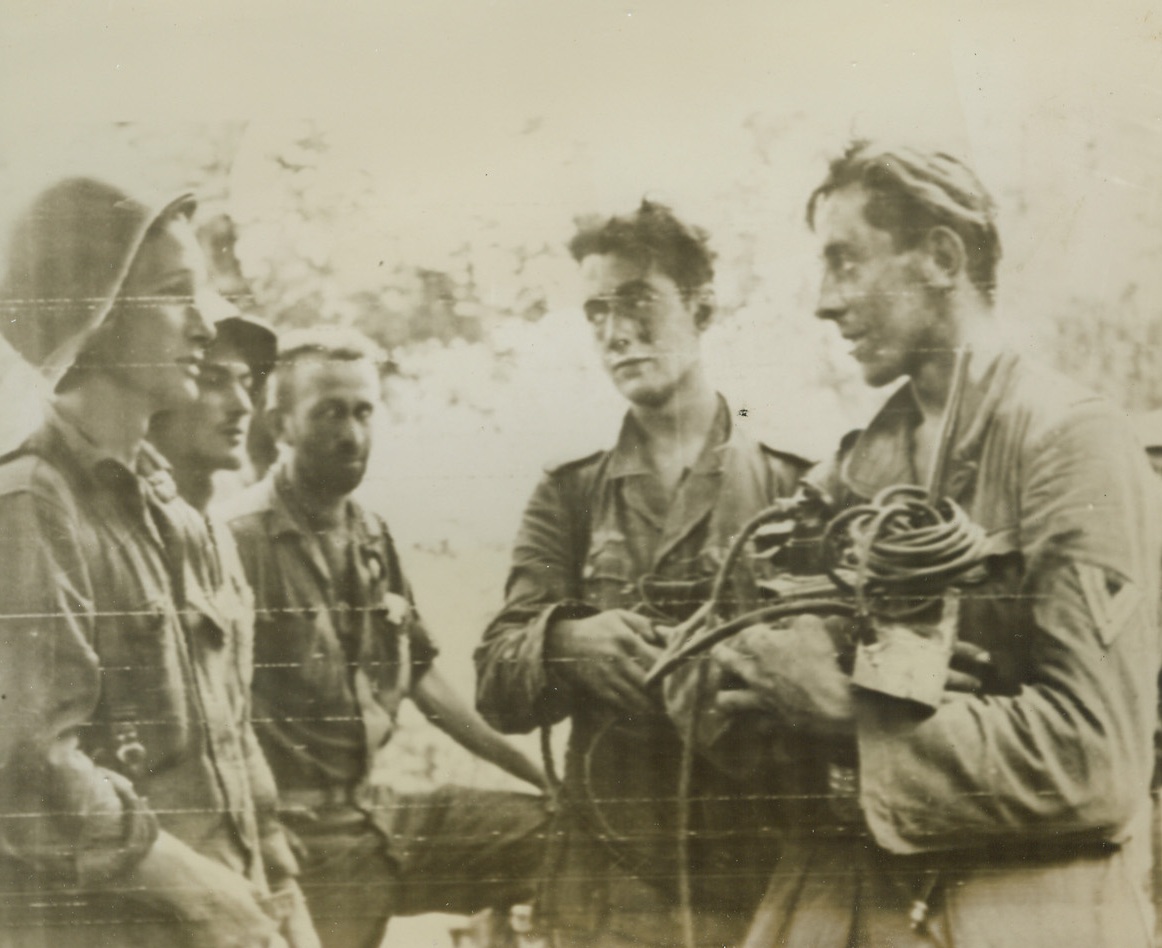
Captured Germans and Their Radio Equipment, 9/29/1943. The above photo, flashed to the United States by Radiotelephoto, shows Pfc. Ruby Asman, of Los Angeles, Calif., (extreme left) talking with two German prisoners who are holding radio equipment taken from the armored vehicle in which they were captured during the Italian campaign. Credit Line (Official US Army Signal Corps Radiotelephoto from Acme);
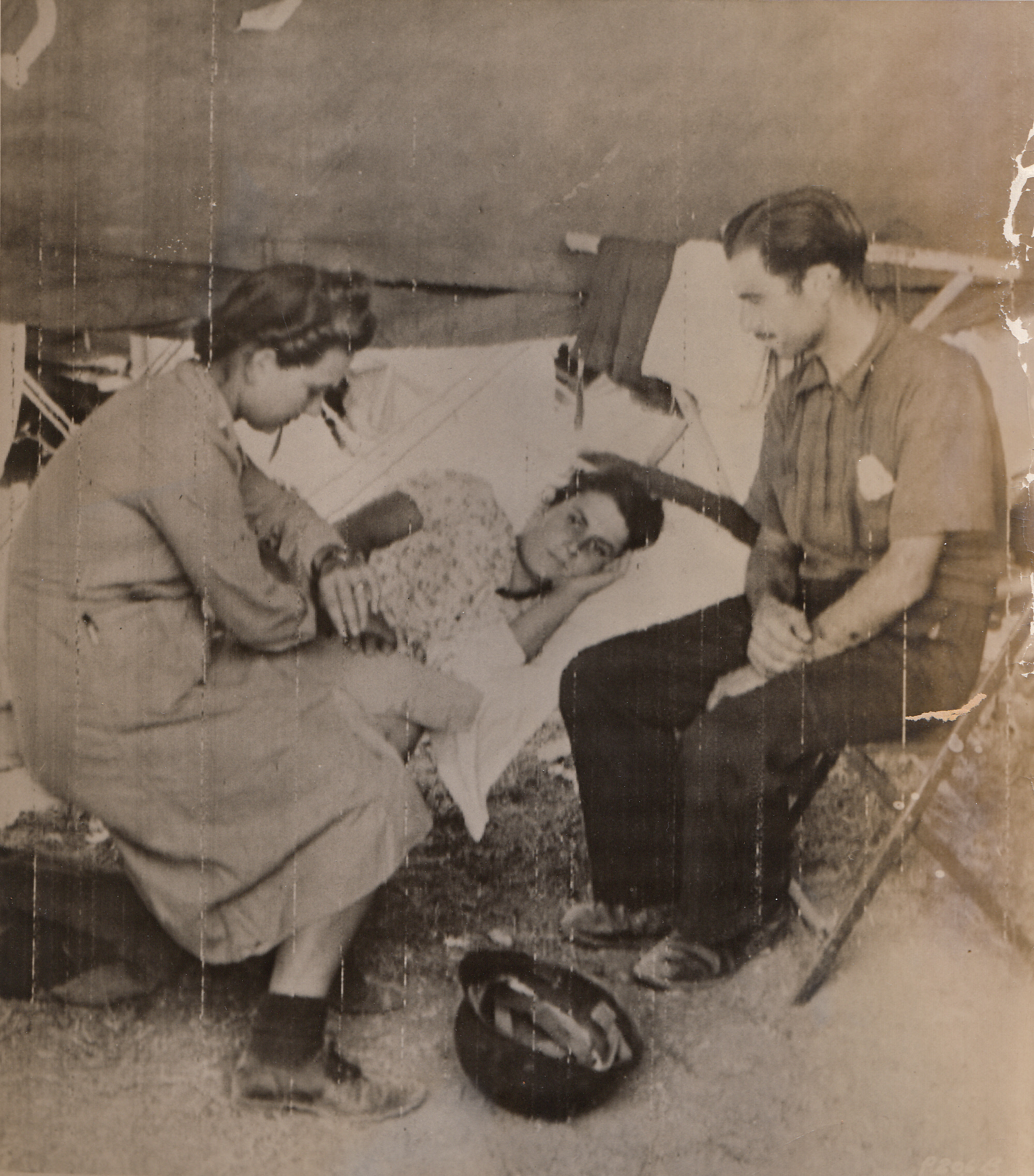
U.S. Army Nurse Treats Italian Civilians, 9/29/1943. This photo, flashed to the United States by Radiotelephoto and made during the Italian campaign, shows how U.S. medical corps units in Italy are treating injured civilians as well as soldiers. An Italian woman, hit by shrapnel from a German bomb burst, receives treatment from Lt. Ruth Lee, at a U.S. Field Hospital. Her anxious husband watches as her pulse is taken.;
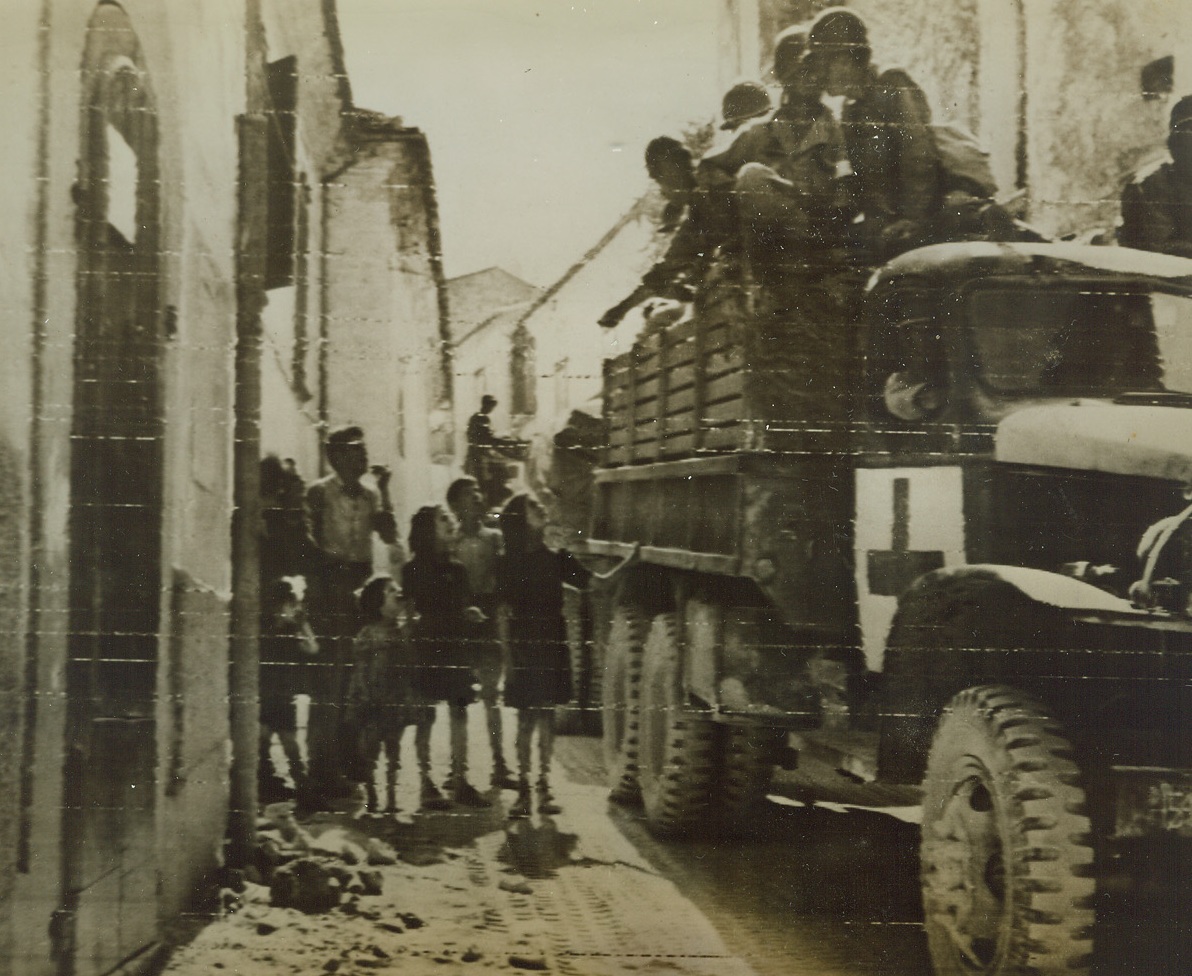
Italian Children Seek Candy, 9/29/1943. The above photo, flashed to the United States by Radiotelephoto, shows Italian children asking for candy from the soldiers aboard slow moving trucks of a medical unit passing through an Italian town. Credit Line (Off. U.S. Army Signal Corps Radiotelephoto from ACME);
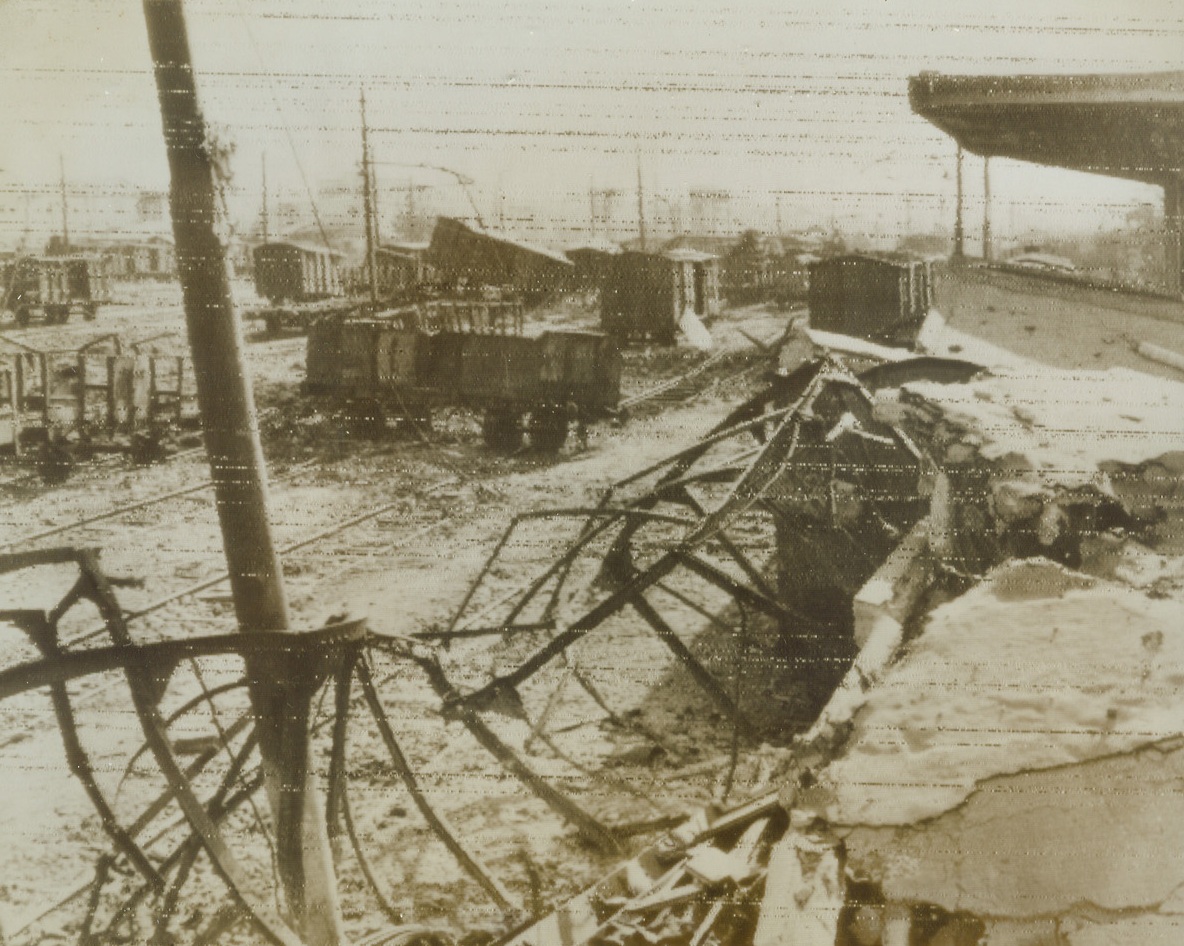
Ruined Railway Station, 9/26/1943. BATTIPAGLIA, ITALY – Target of both Allied bombers and German demolition squads, the railway station at Battipaglia lies in ruins. Battered, twisted steel forms the wreckage shown in this photo, radioed to New York from Algiers today (Sept. 20th) Credit (British Army Photo via OWI Radiophoto from Acme);
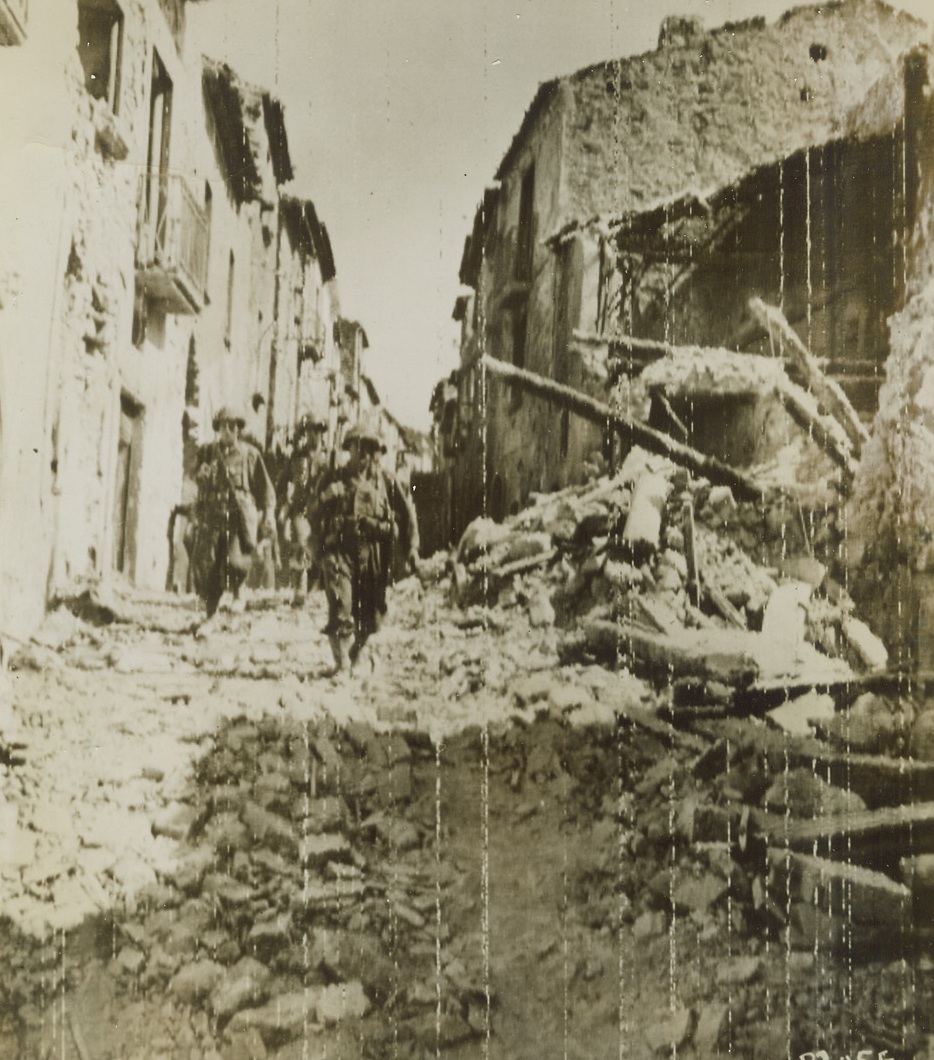
Yanks Take Altavilla, 9/26/1943. ALTAVILLA, ITALY – Members of an engineer combat team patrol the streets of Altavilla soon after the Italian town was captured by American troops. Credit (Signal Corps Radiotelephoto from Acme);

Death in a Foxhole, 9/26/1943. ALTAVILLA, ITALY – Sprawled in a dusty foxhole, these Nazis were killed as they tried to hold off advancing American troops at Altavilla. Credit (Signal Corps Radiotelephoto from Acme);
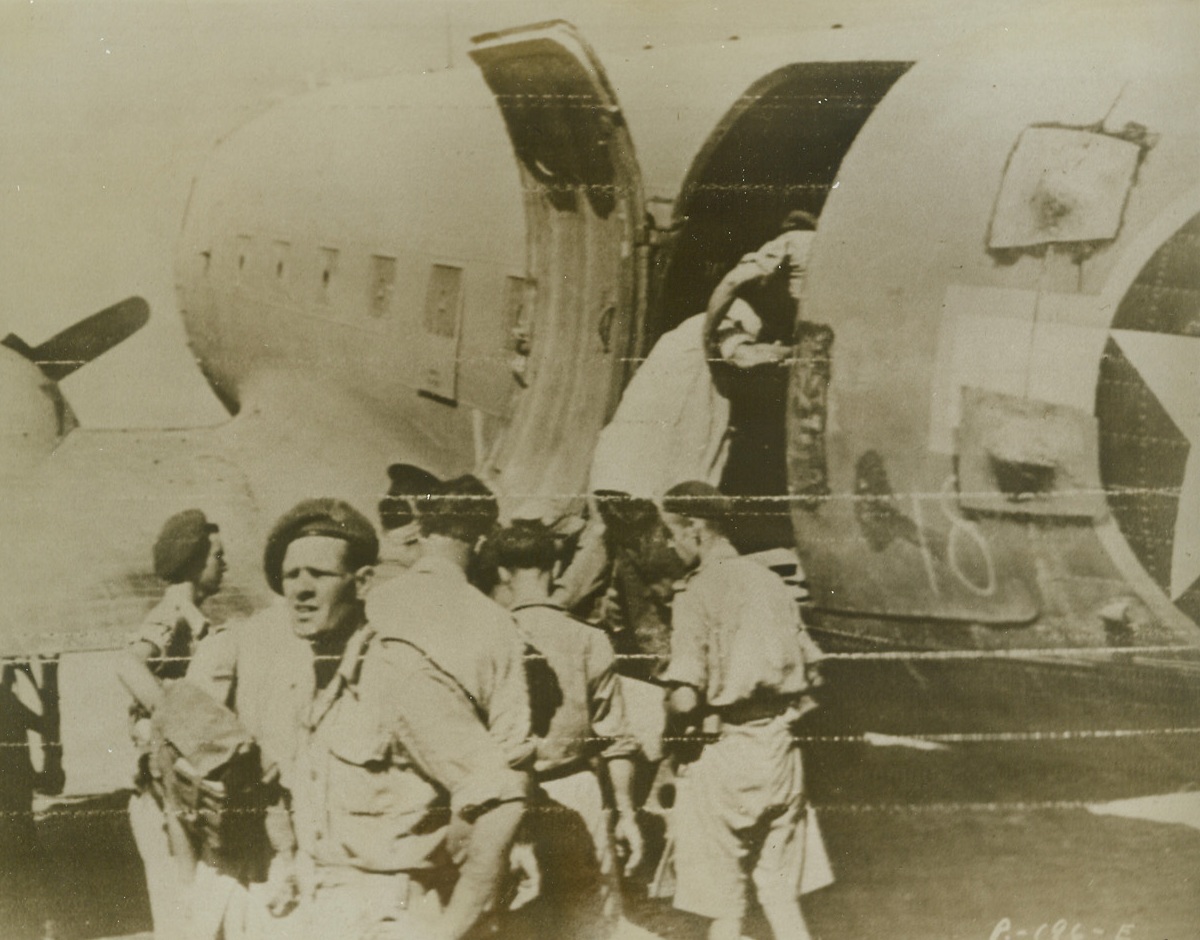
Evacuating Wounded, 9/20/1943. ITALY – Wounded in fighting on the Italian mainland, American soldiers are evacuated by N.A.A.F. planes. The planes maintain a shuttle service, bringing supplies and troops to the front and carrying the wounded back on return trips. Credit (Signal Corps Radiotelephoto from Acme);
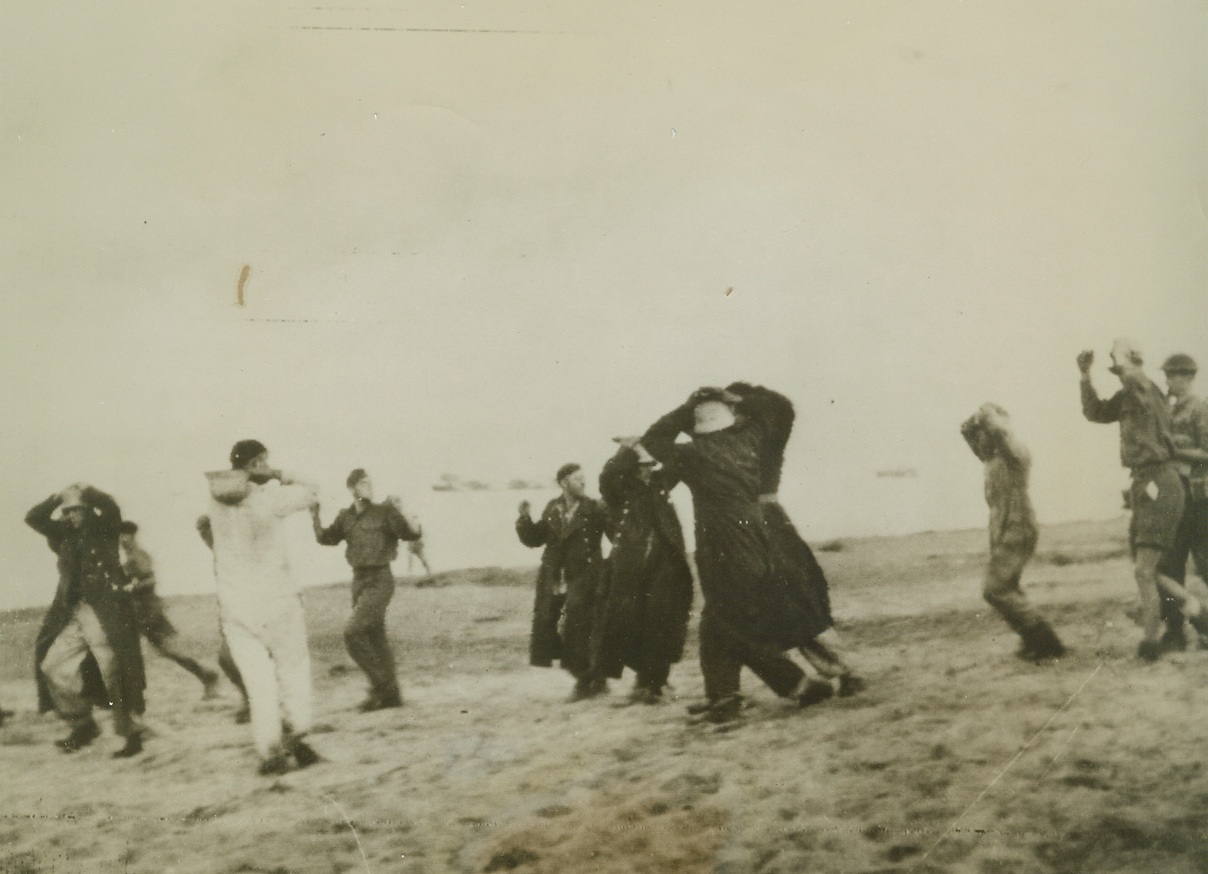
First Captives at Salerno, 9/14/1943. ITALY – These disorganized Nazi prisoners of war, the first batch to be rounded up on the beach after the Allied landing in Salerno, bear little resemblance to “super-men.” Their Axis comrades, however, are putting up stiff resistance to our onslaught, fighting desperately in the most bitter action of the invasion campaign. Credit Line (British Army Photo from ACME Transmitted from OWI);
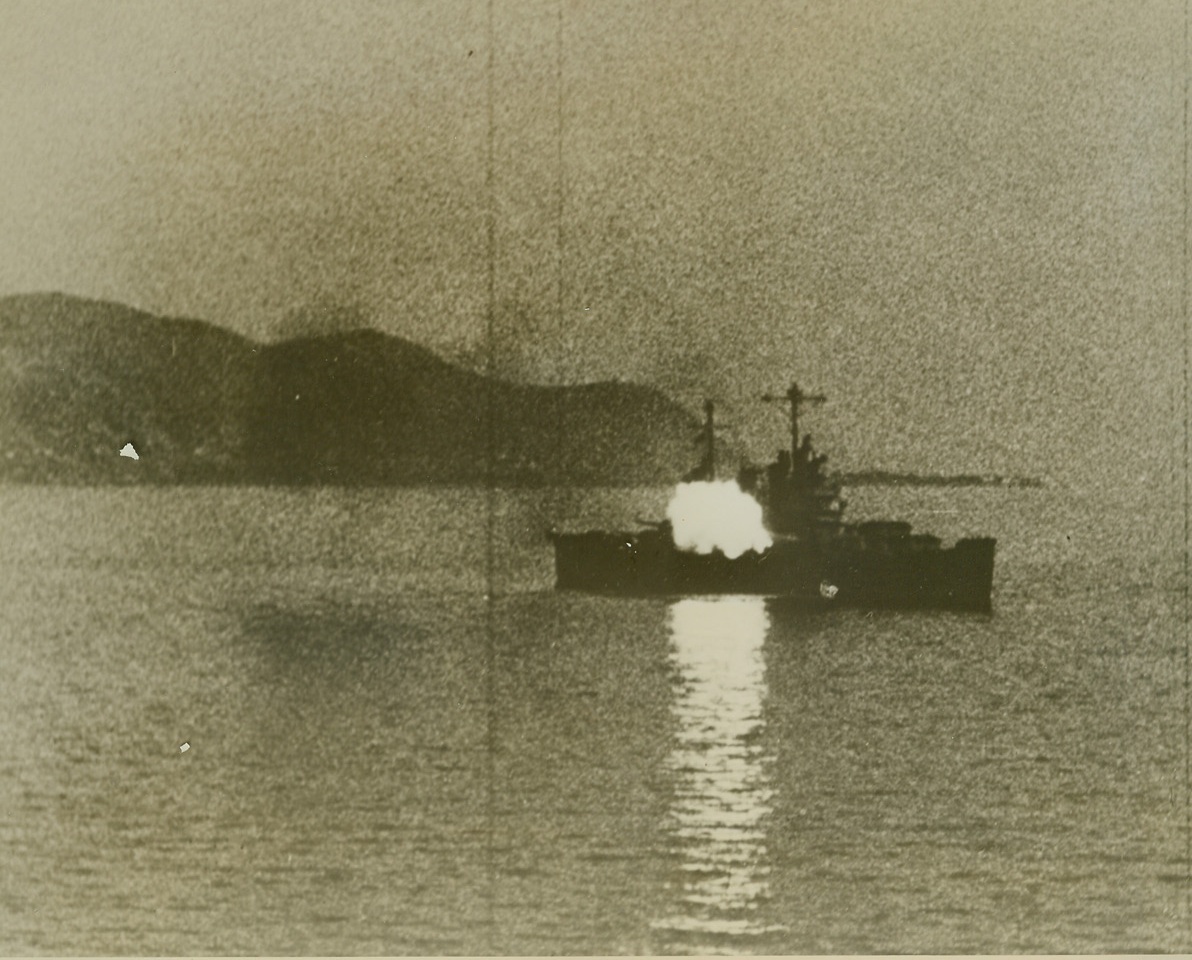
Blast Before Dawn, 9/30/1943. A United States Coast Guard combat photographer caught this photo of an American warship blasting away at Germans defending Salerno’s shores in the early morning hours of the invasion of the Italian mainland.Credit Line (U.S. Coast Guard Photo from ACME);
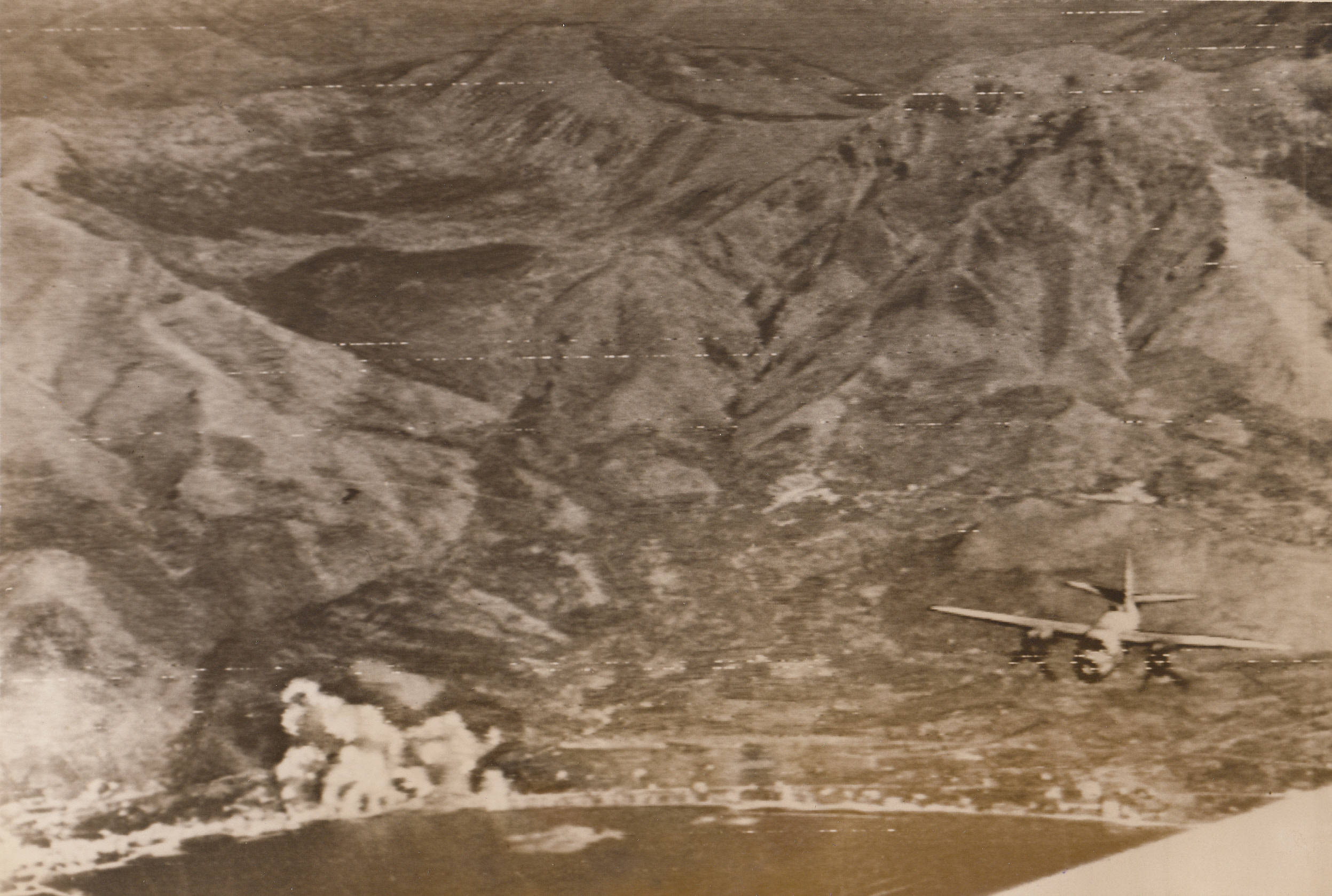
Yanks Bomb Rome-Naples Highway, 9/23/1943. In this photo, flashed to the U.S. by Radiotelephoto today, a Martin B-26 Marauder, (lower, left), of the U.S. Army Air Forces, can be seen swinging away from its bomb run, while its bombs burst on the target, (lower, left in photo), a vital junction of the Rome-Naples Highway. It is precision bombing such as this that is helping the Allies to close in on Naples. Today, British and American troops are within sight and sound of that city, which the Germans are preparing to abandon.;
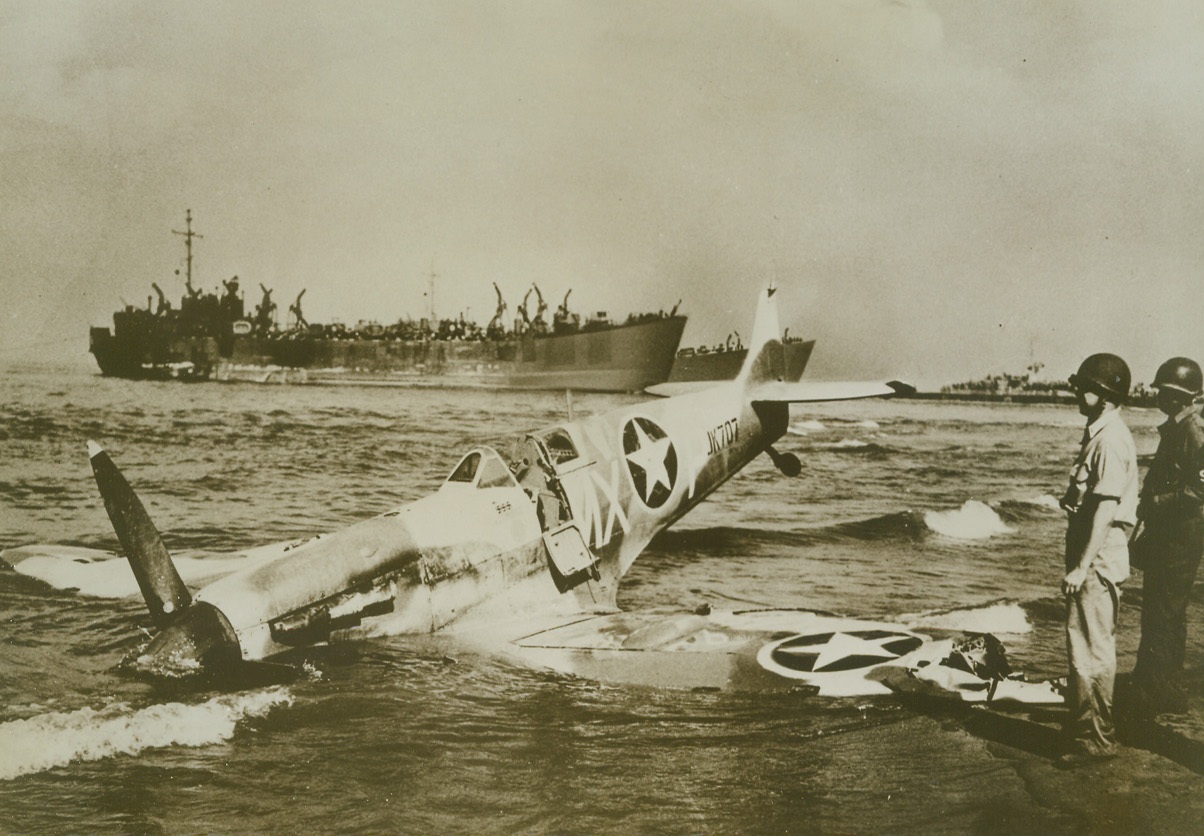
Forced Landing, 9/23/1943. PAESTUM, ITALY – This Spitfire fighter, bearing the insignia of the U.S. Army Air Forces, was forced into a crash landing in the surf at Paestum during bitter fighting in that area. Note three Swastikas painted on side of cockpit (just under windshield). At the right, a U.S. Army Lieutenant and a U.S. sailor of the shore Patrol, examine the ship. In background, can be seen landing craft and transports manned by U.S. Coast Guardsmen. Credit Line (U.S. Coast Guard Photo from Acme);

Hey, Hitler! A Jewish Sailor Guards Nazis!, 9/23/1943. OFF SALERNO – Bernard Leshner, (left), gunners’ mate third class of Philadelphia, Pa., stands guard over two slightly wounded Nazi prisoners aboard a U.S. transport manned by Coast Guardsmen, off the beach at Salerno, Italy. The two smiling Nazis were members of the 16th Panzer Division and were captured by the Allies in the hot fighting at Salerno. Credit Line (U.S. Coast Guard Photo from Acme);
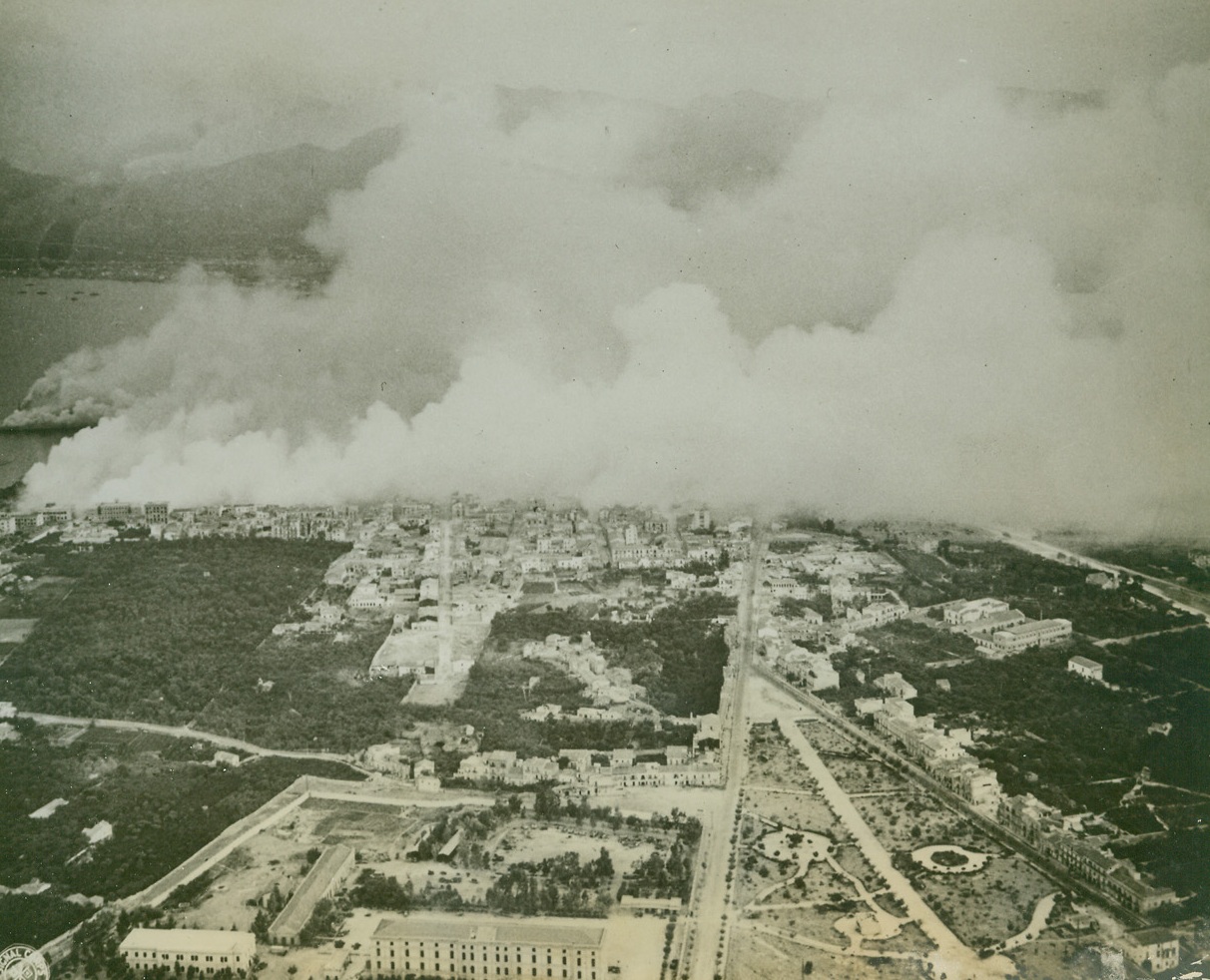
Protective Smokescreen Over Palermo (#1), 9/27/1943. PALERMO, SICILY – During a recent demonstration, the Chemical Warfare Branch of the U.S. Army Service Forces covered Palermo with a protective smokescreen. Here, clouds of smoke start streaming over the city from many points. Credit Line (U.S. Signal Corps Photo from Acme);

Watching for Allies’ Next Invasion?, 9/30/1943. This photo from a neutral source, shows a German soldier, (lower, center), with a pair of field glasses looking out to sea from an observation post on the Nazi-occupied island of Crete. With the location of huge Allied forces in the Mediterranean still un-announced, the Nazis in sections not yet invaded in this area, are suffering a severe case of “invasion jitters.” The Germans call observation posts such as this one, (photo above), “Tobrukstands” – probably named for the city in North Africa where Rommel’s Afrika Korps “should have stood”.Credit Line (Acme);

Take-off for Italy, 9/5/1943. SICILY – A Sicilian port is a solid mass of landing boats as the Allies stream on board ready to shove off for Italy. Men, tanks, jeeps and guns were amassed, ready to engulf the Southern tip of Italy under a protective aerial umbrella.Credit (Acme Radiophoto);
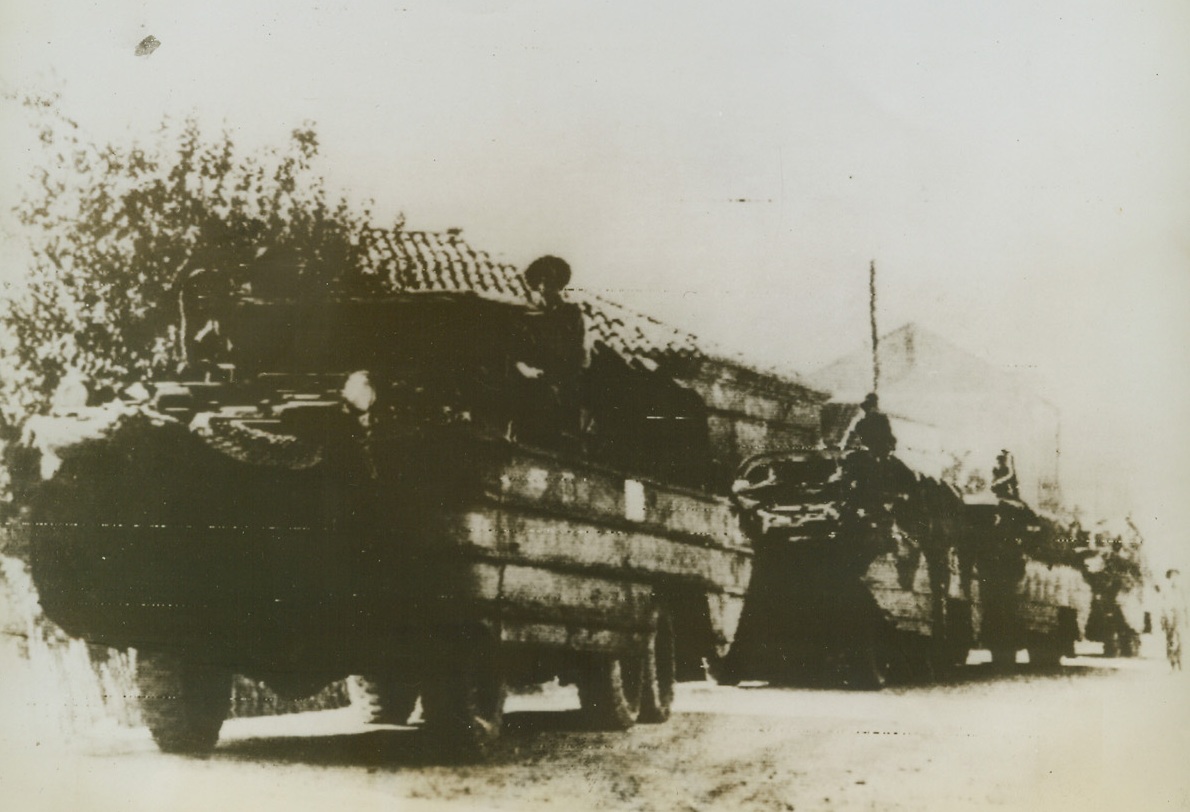
As British Invaded Italy, 9/5/1943. REGGIO CALABRIA, ITALY – A few hours after their almost unopposed landings on the Italian coast, British troops drive their amphibious ducks through this city. Having firmly established a bridgehead, the British and Canadians were fanning out rapidly from the captured cities crushing weak opposition and threatening a quick capture of the entire tip of the Italian toe. This photo was sent by radio from Algiers to London and thence via radio to New York.Credit Line (Acme);

Factory on Danube Hit, 9/7/1943. GERMANY – Tucked away in a bend of the Danube near the Austrian border at Regensburg, the Germans had built a mammoth aircraft factory which produced their latest type fighter, the ME. 109G. On August 17th, large formation of Flying Forts of 8th Air Force attacked the plant and severely damaged it. Photo was made from bombers during height of attack. Germans lost 140 fighters while Americans lost 23 Forts.Credit Line (ACME);

No Hard Feelings, 9/7/1943. ITALY – No official interpreter is needed for Italian soldiers and sailors to tell Royal Air Force airmen that they are glad to be captured, near Reggio Calabria, because it means they are out of the war. Taken by a British RAF photographer, this photo is a first shot of action to follow the invasion.Credit (OWI Radiophoto from Acme);

First Aid for American Wounded as we Invade Italy, 9/13/1943. The above picture flashed to the United States by Radiotelephoto shows a wounded American soldier injured during U.S. landing operations on Italian soil is carried to an advance first aid station. Credit Line (Acme photo by Charles Corte for the Picture Pool via U.S. Army Signal Corps Radiotelephoto);
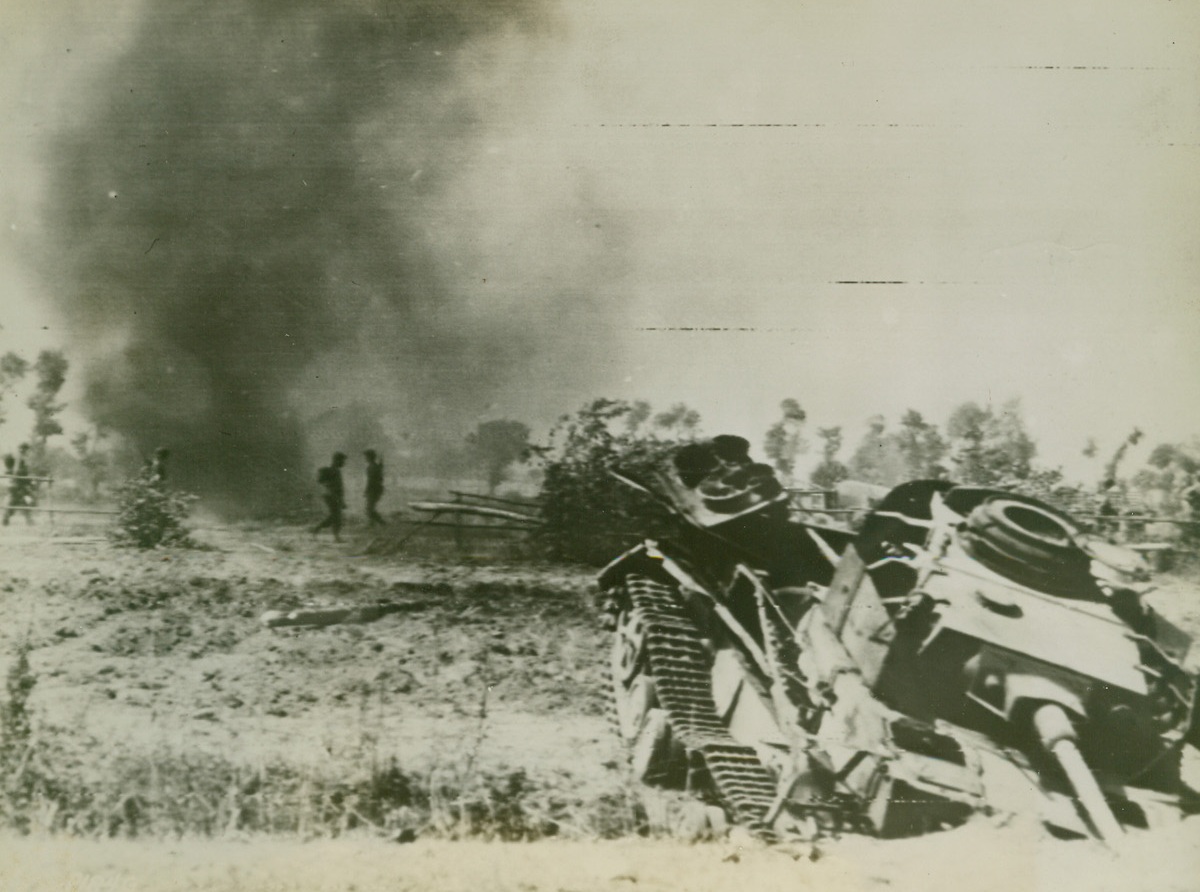
As We Invaded Italy – First Photo, 9/13/1943. The above picture flashed to the United States by Radiotelephoto shows a tank wrecked during the landing operations on Italian soil. Infantrymen (in background) are advancing through still burning fields. Credit Line (Acme Photo by Charles Corte for the Picture Pool via U.S. Army Signal Corps Radiotelephoto);

Leapfrog, 9/12/1943. SAN GIOVANNI, ITALY – The train jumped the tracks then the tracks jumped the train in a wartime game of leapfrog when Allied bombers scored a direct hit on the railway running through San Giovanni. Photo radioed to New York today (September 12th).Credit (British Army – OWI Radiophoto from Acme);
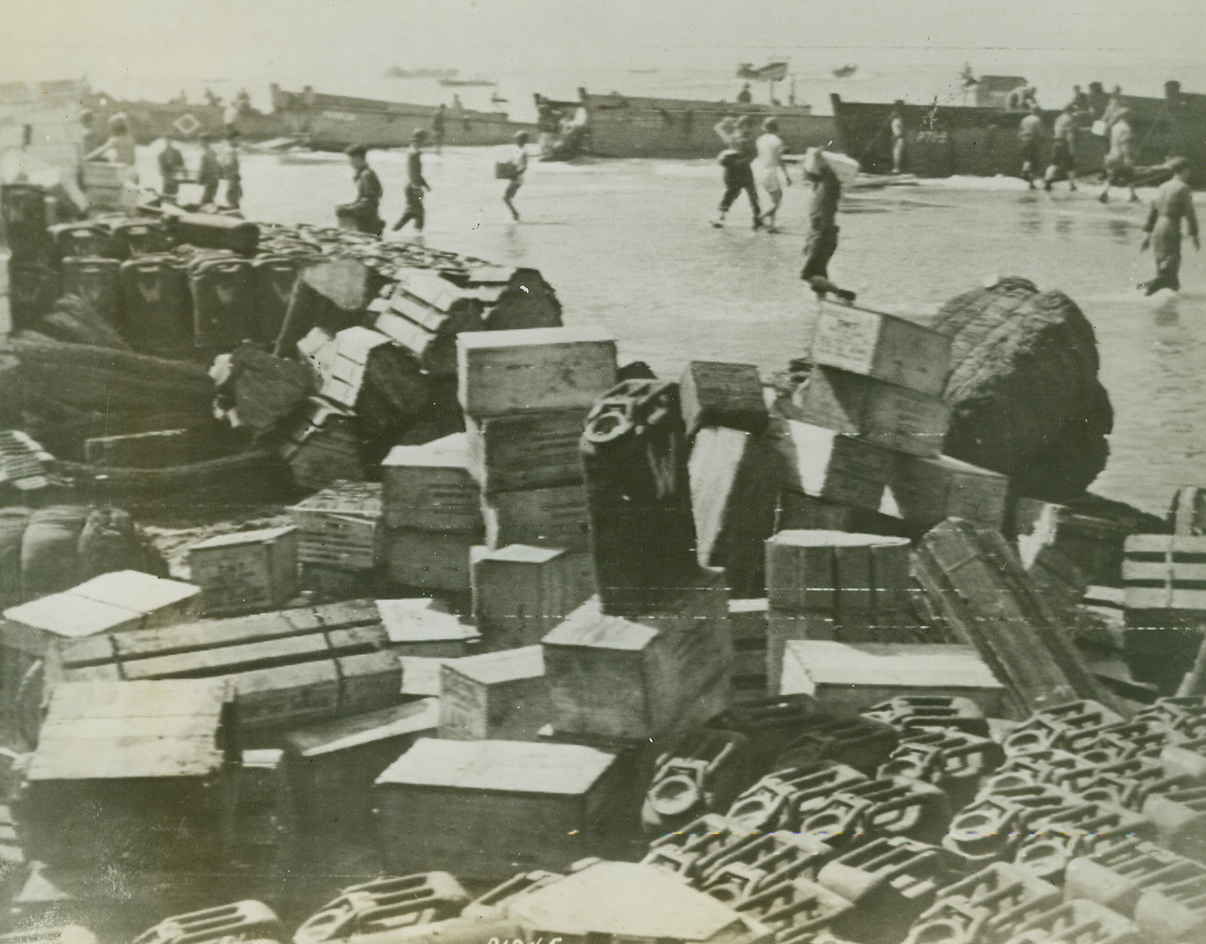
Landing Supplies on Italy’s Shore, 9/13/1943. The above photo flashed to the United States by Radiotelephoto shows – the quick unloading of supplies to keep pace with the fast moving United States troops as they invaded Italy. Under constant strafing and bombing by German planes this important job was extremely hazardous. Credit Line (Acme Photo via US Army Signal Corps Radiotelephoto);
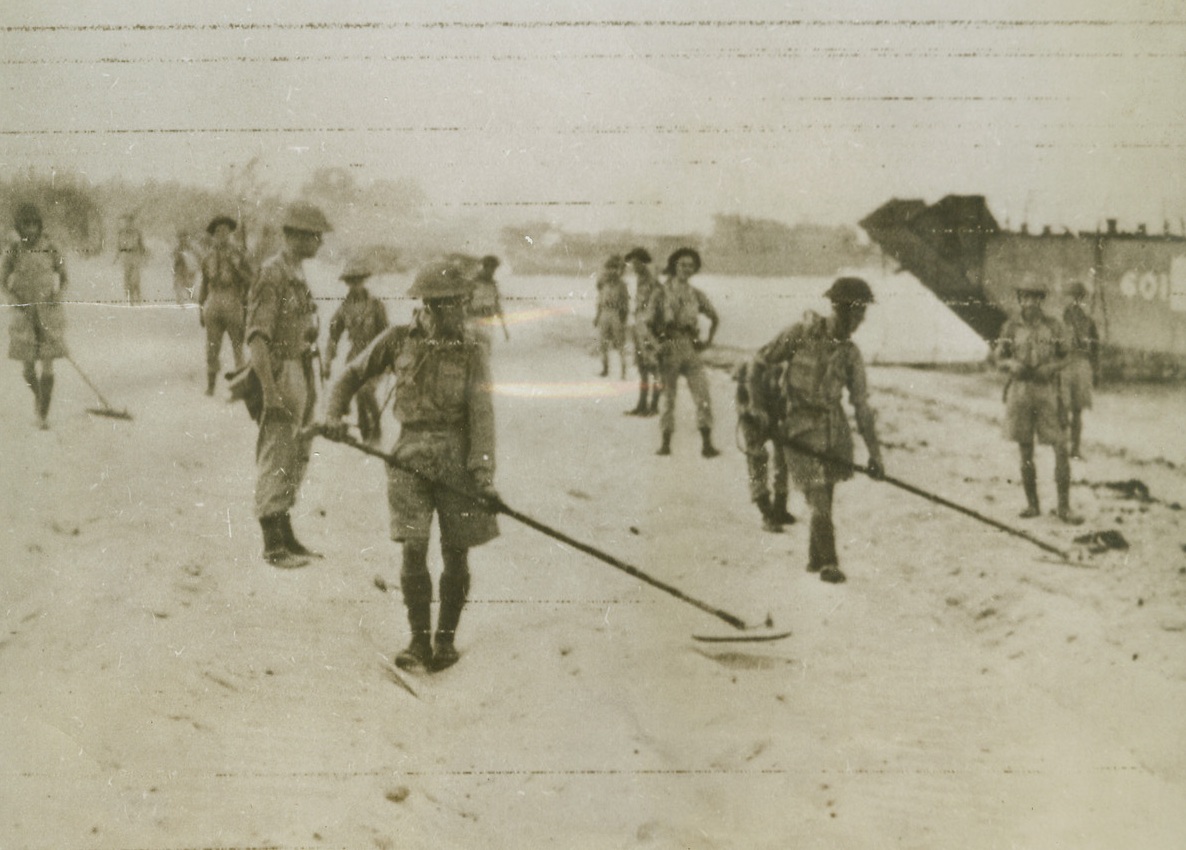
A Bunch of Smart Sappers, 9/7/1943. ITALY – Shortly after landing, British sappers go to work at the ticklish job of clearing the beaches north of Reggio Calabria of mines sowed by the Axis. “Actual” enemy resistance was slight, but mines, demolition of bridges and roadways, and the rough terrain has slowed the steady Allied advance in Italy. This is a first photo of “action” on the continent of Europe.Credit Line (OWI Radiophoto from Acme);
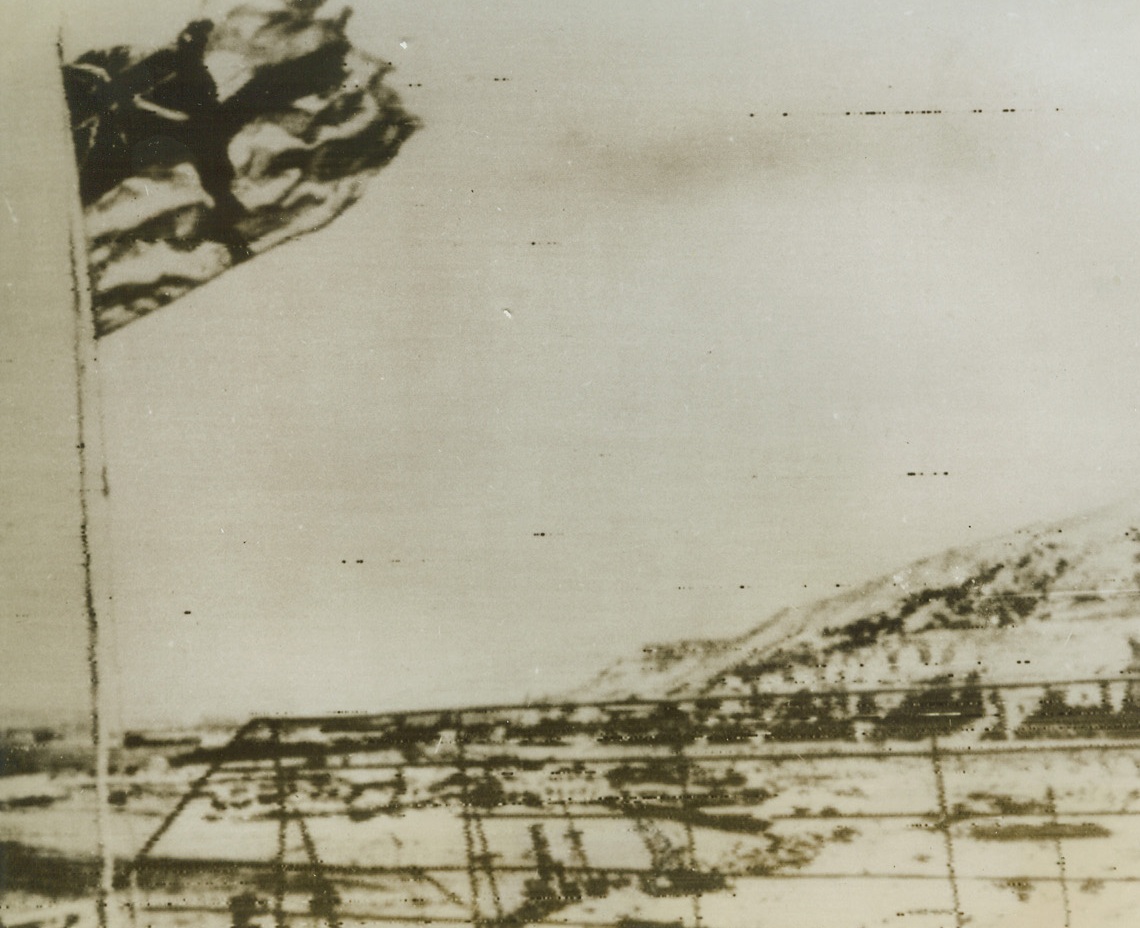
White Ensign Over Italy, 9/6/1943. REGGIO HARBOR, ITALY – The first Allied flag to fly over the Italian mainland, Britain’s white ensign flutters above Reggio harbor. Latest reports indicate that Allied commando raids behind the German lines have resulted in the fall of Melito and Bagnara.Credit Line (Acme Radiophoto);

Food Disappears in Wake of Trouble, 9/6/1943. OLDENSE, DENMARK – Nazi-hatred fired Danes into action two weeks ago, and explosions, fires, and violence were the result. A German officer was stamped to death by Danish boots in Oldense, for example, and in the wake of the uprising came great shortages of food. Here residents of Oldense queue up at a dairy shop as Danish policemen supervise after martial law had been declared.Credit Line (Acme Radiophoto);
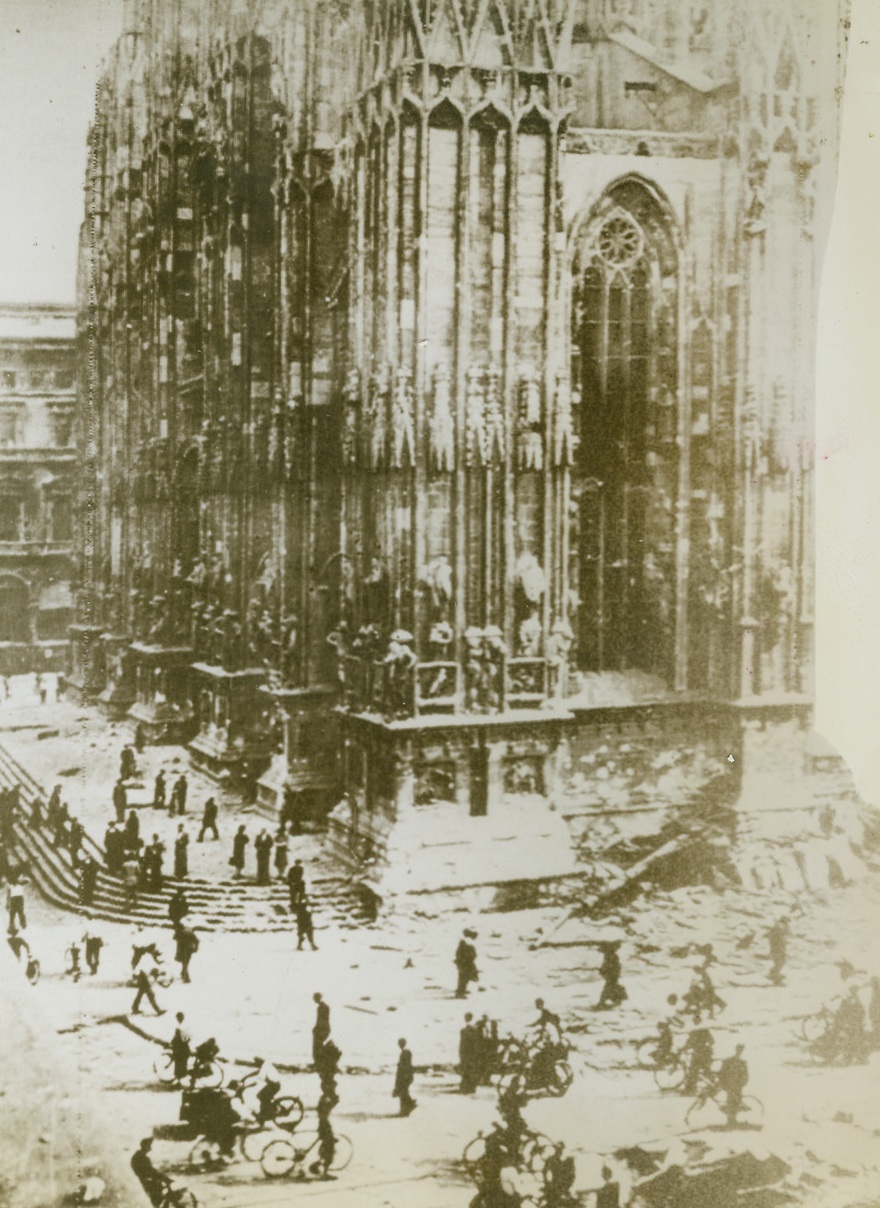
Milan Cathedral Still Stands, 9/10/1943. MILAN – The famous Milan Cathedral, although close to the oft-bombed railroad marshalling yards, suffered only slight damage to one of its steeples and sides as a result of powerful allied air raids before Italy capitulated.Credit Line (Acme) WP;
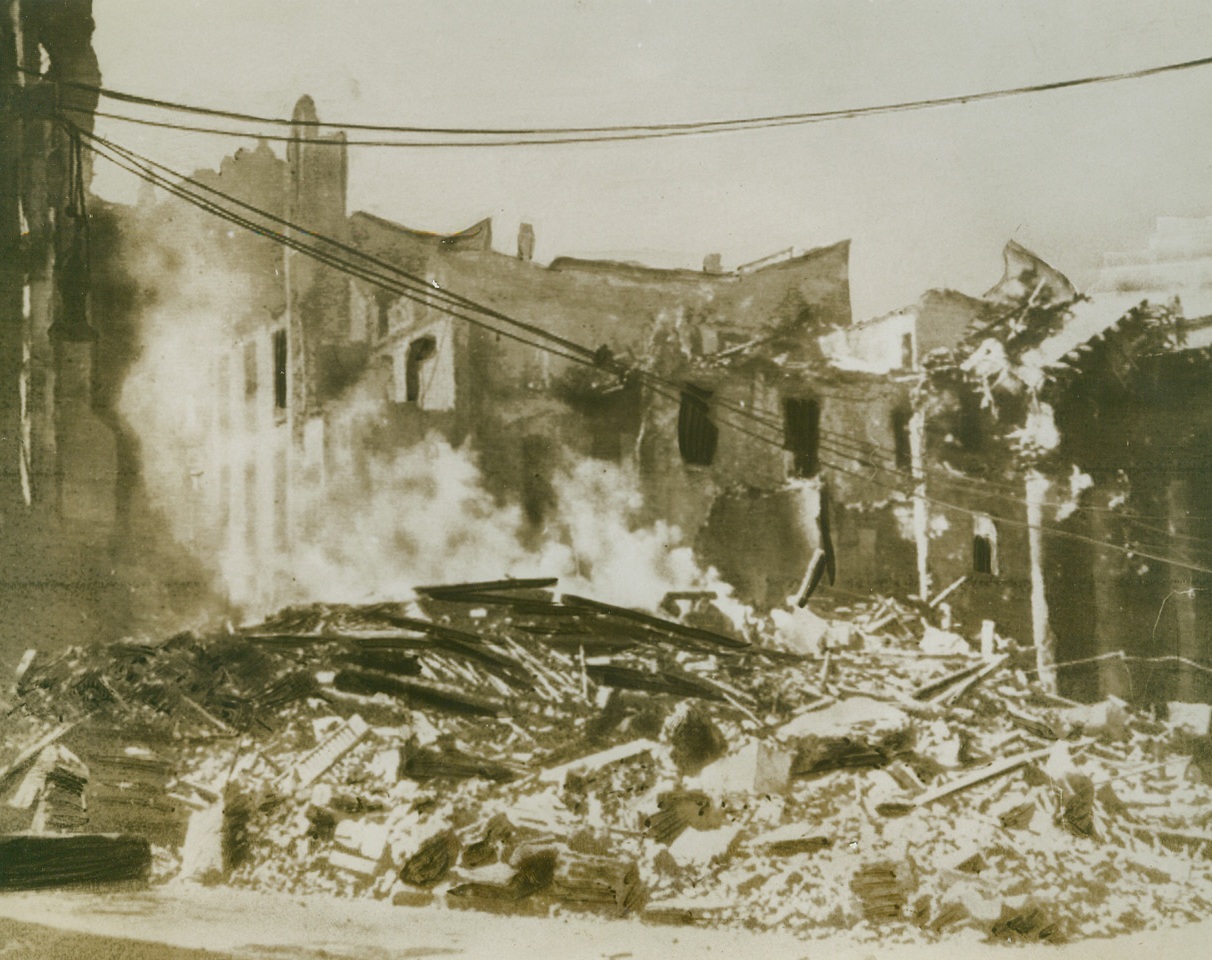
Still the Best Method of Persuasion, 9/10/1943. MILAN – Words of reason, entreaty or threat had no effect on our fascist enemies until we started to back them up with destructive force. Typical of that force is the bombing of Milan, chief railroad center of northern Italy. Here is the Piazza San Carlo in Milan as it appeared after one of the raids.Credit Line (Acme) WP;
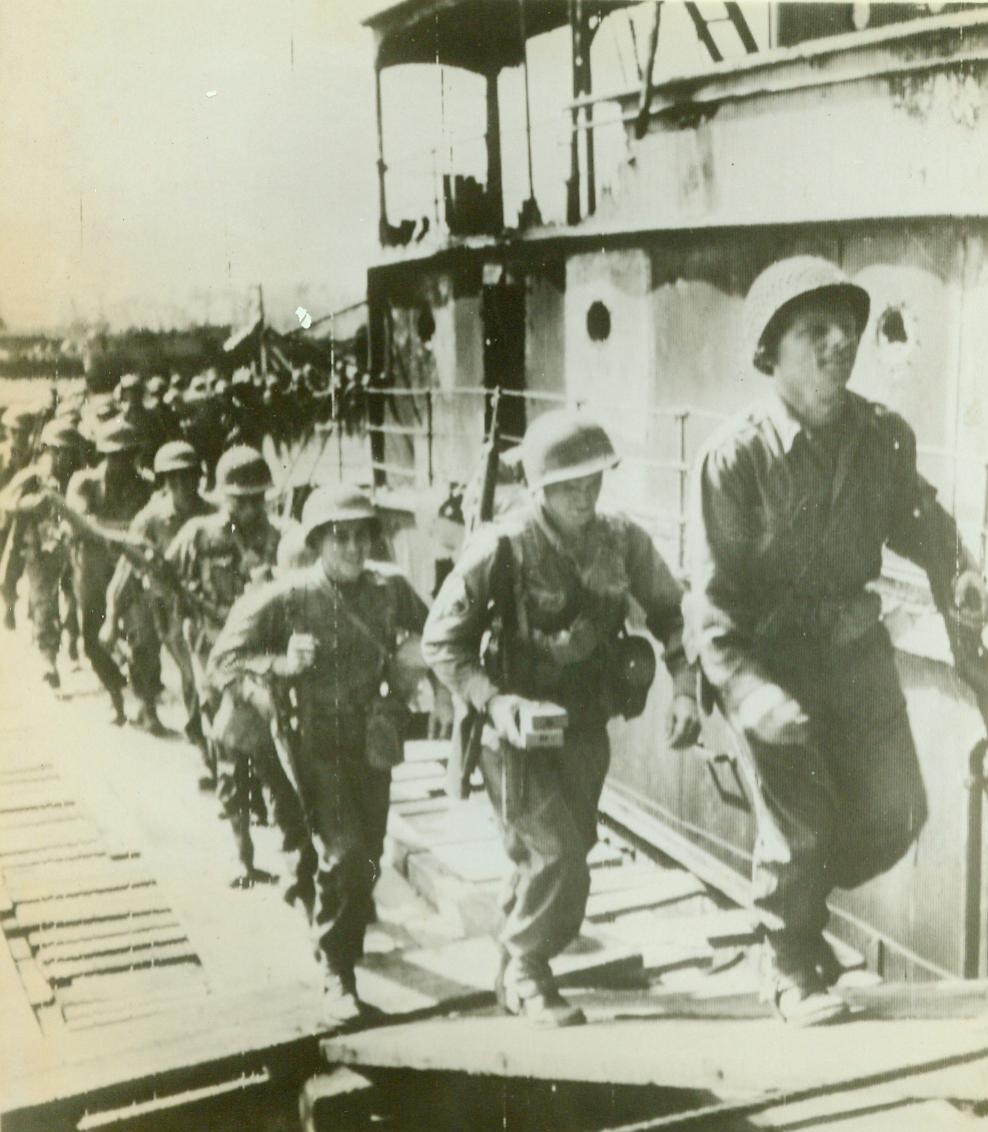
Rangers Embark For Italy Invasion, 9/10/1943. The above photo flashed to the United States by Radiophoto shows United States Rangers as they embarked at a Sicilian Port bound for their operations against the Italian Mainland CREDIT LINE (ACME Photo Via U.S. Army Signal Corps Radiotelephoto) 9/10/43;
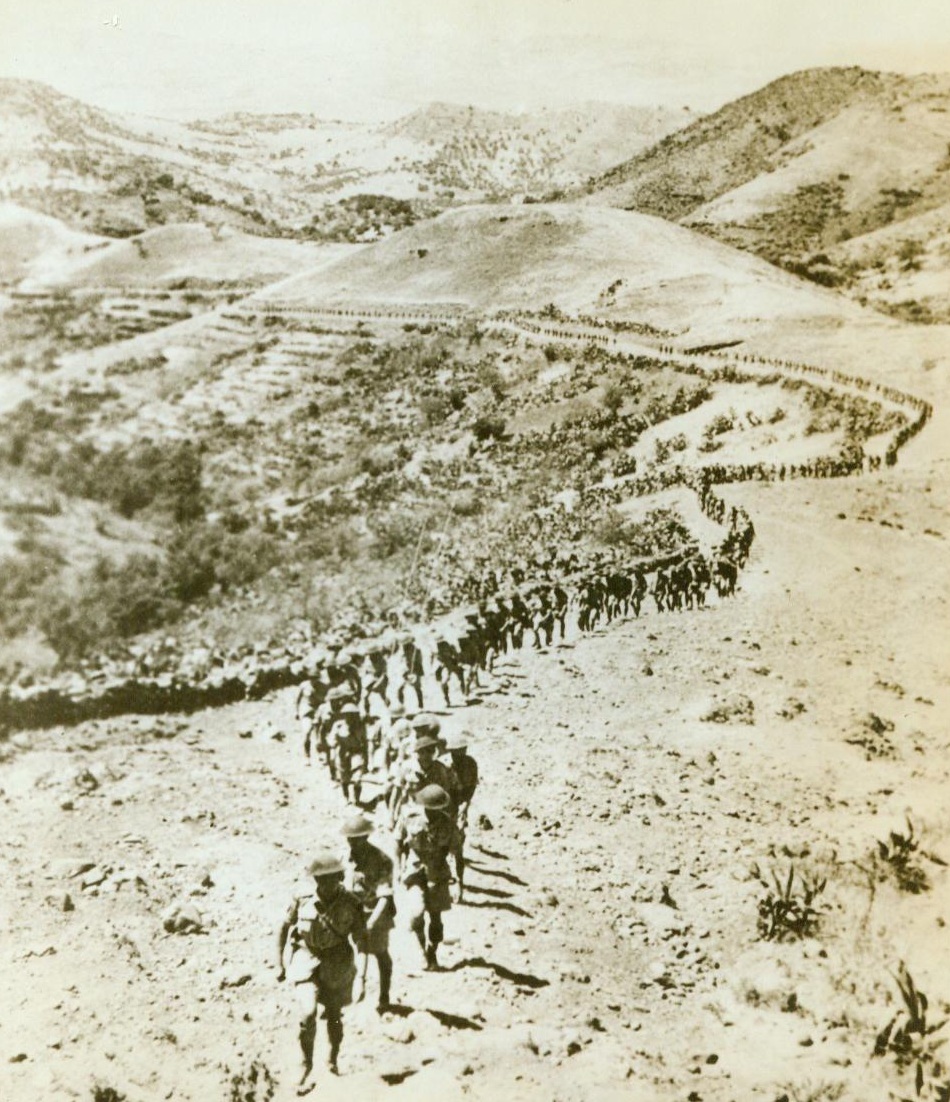
Highlanders Trek, 9/10/1943. SICILY – Tramping single file over the rocky slopes of Sicily, Vancouver’s Seaforth Highlanders follow their commander to an assembly point on the conquered island. With others who fought in the Sicilian Campaign, they were addressed by General Sir Bernard L. Montgomery, commander of the British Eighth Army. CREDIT LINE (ACME) 9/10/43;
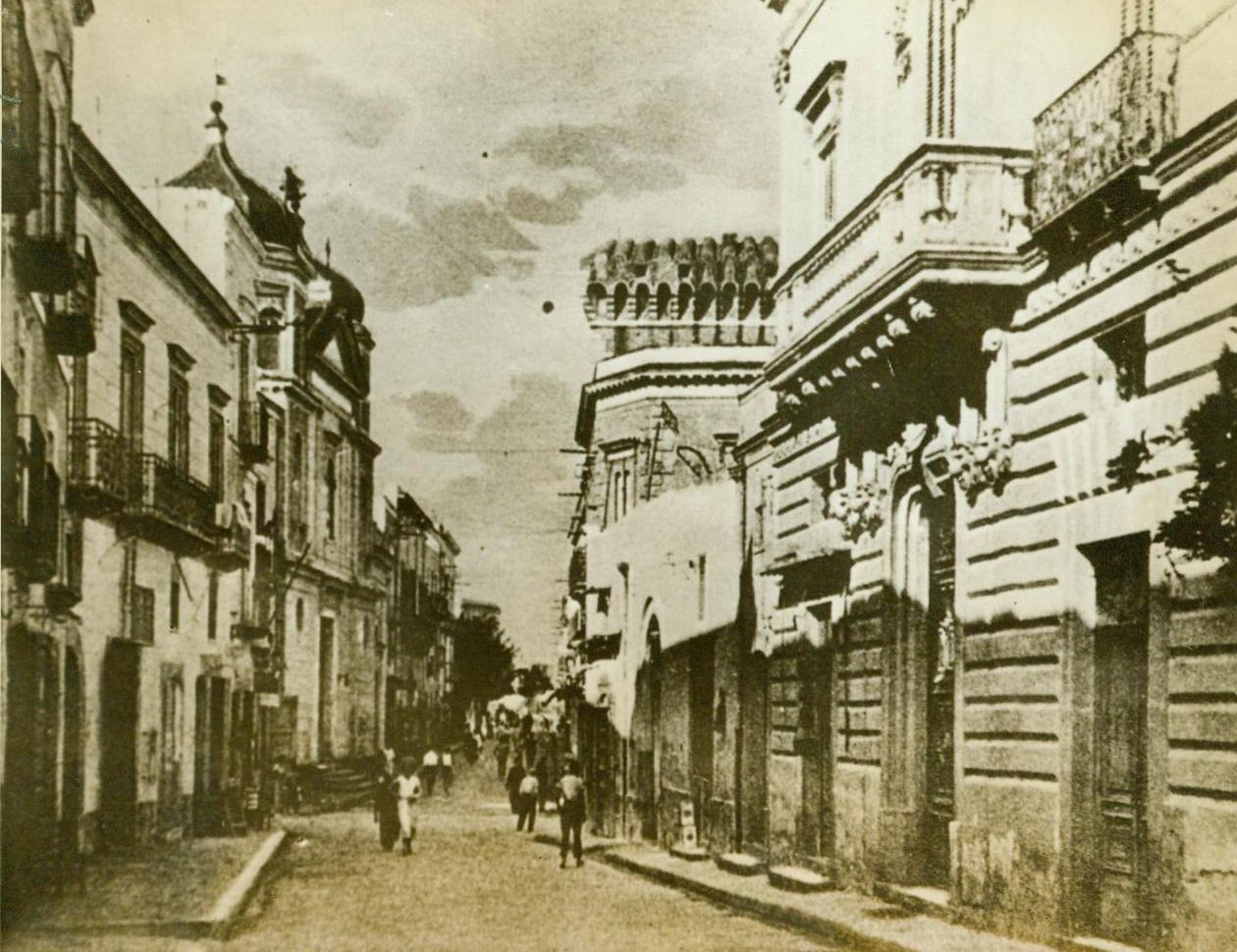
Scene On Captured Island, 9/18/1943. Pedestrians stroll through the central plaza of the city of Forio on the Italian island of Ischia, which fell to Allied Naval Forces on September 16th. One of two captured islands flanking Naples, Ischia’s fall brought the Allies virtually within sight of the great seaport. Ischia is only 7 miles from the Italian mainland. The other island, Procida, is 2 miles from the north peninsula skirting the bay of Naples. Credit Line (ACME). 9/18/43;
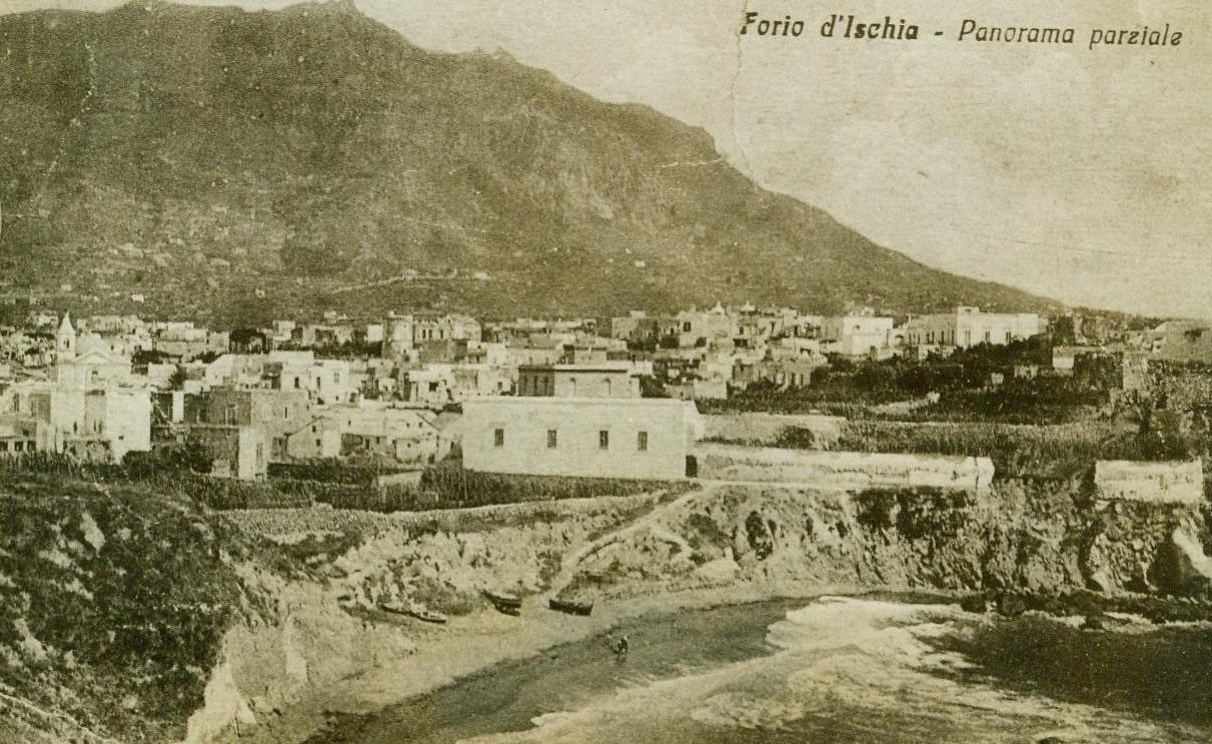
Ischia Falls To Allies, 9/18/1943. Here is a general view of a section of Ischia Island, sixteen miles southwest of Naples, which has fallen to Allied Naval Forces. The island capitulated on Thursday (Sept. 16th), one day after a neighboring Italian Island, Procida, was captured, thus bringing the Allies within sight of Naples. Ischia has an area of about 20 miles and is only 7 miles from the nearest mainland coast. Credit Line (ACME). 9/16/43;
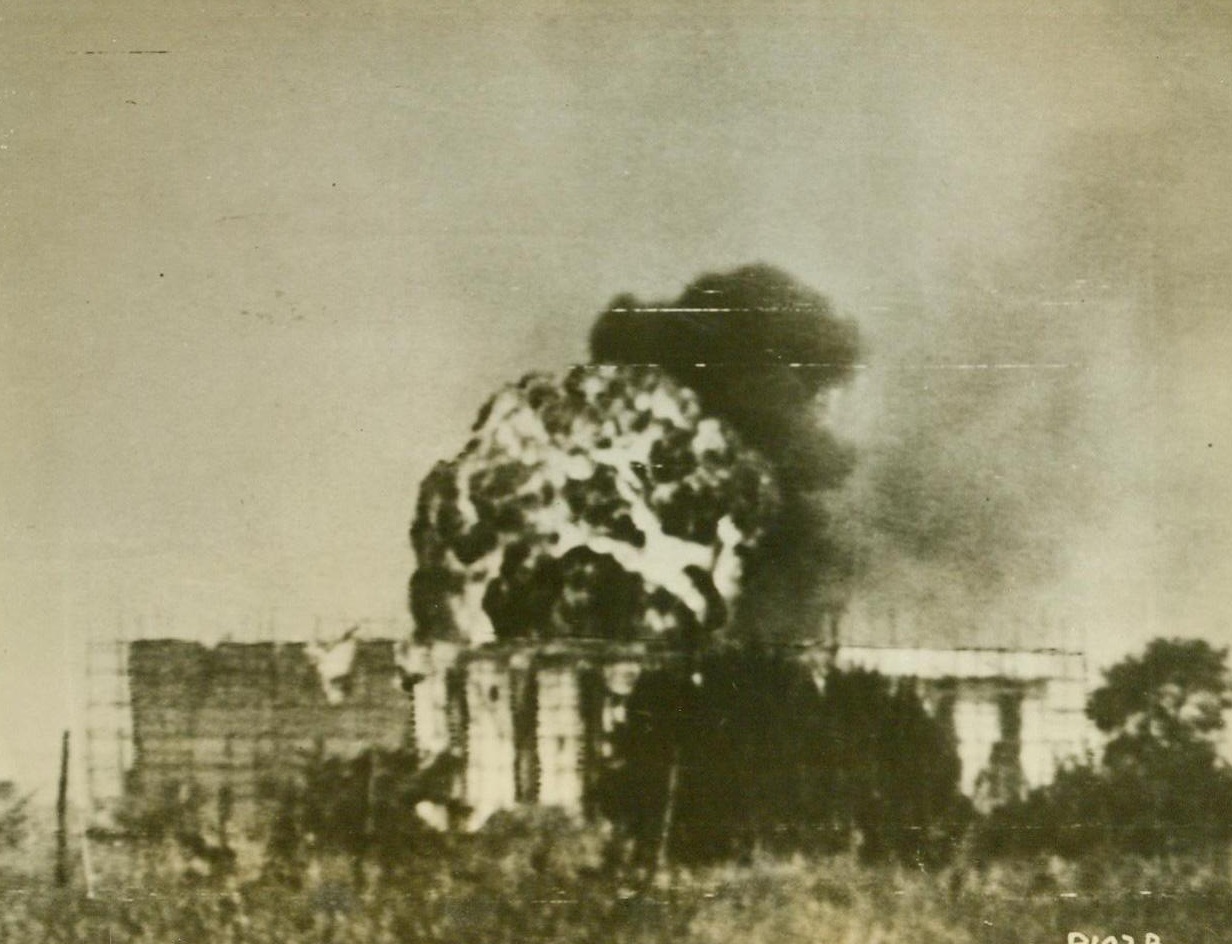
Direct Hit – 2, 9/18/1943. Italy – An Italian tobacco factory, used by Nazi infantry as an artillery observation post, goes up in flame as proof of the accuracy of our artillerymen. See ACME photo #W698187, which shows the crew of the American Howitzer mounted on a half-track immediately after firing the shell that was responsible for this direct hit. 9/18/43 Credit (Signal Corps Radiotelephoto From ACME);
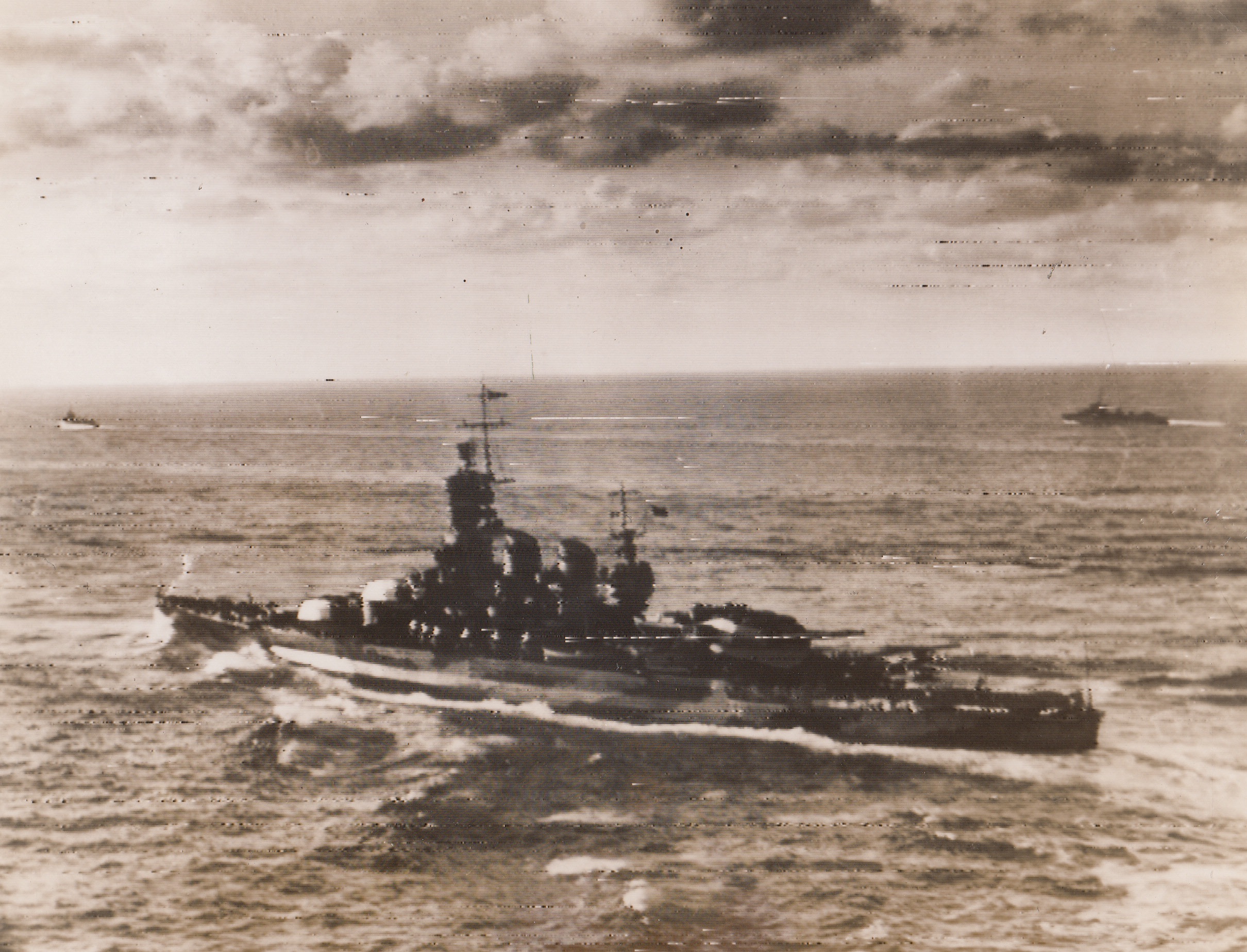
Italian R Craft Reach Allied Port, 9/18/1943. An Italian battleship (foreground) of the Littoria class, and two destroyers of Italy’s Navy, reach an Allied port in the Eastern Mediterranean, escorted by units of the Royal navy. An effective RAF umbrella protected the sea lanes from the air. 9/18/43 Credit (ACME RadioPhoto);
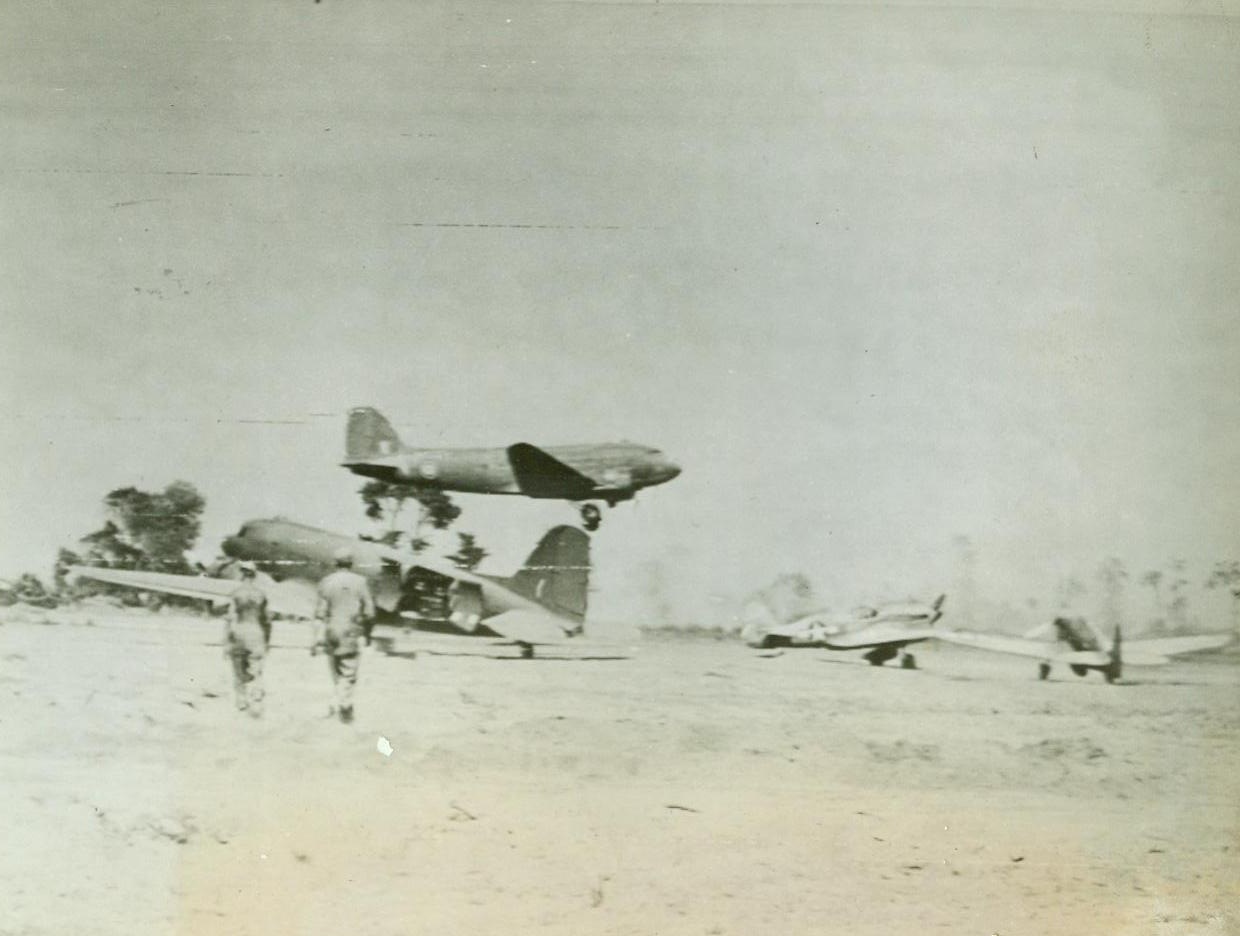
Advancing In Italy – Air Transport At Work, 9/19/1943. The above photo flashed to the U.S. by Radiotelephoto shows an Allied transport taking off from a rough, improvised landing field in Italy after discharging its cargo of men and materiel. Fighting planes may be seen scattered over the field. 9/19/43 Credit Line (U S Army Signal Corps Radiotelephoto From ACME);
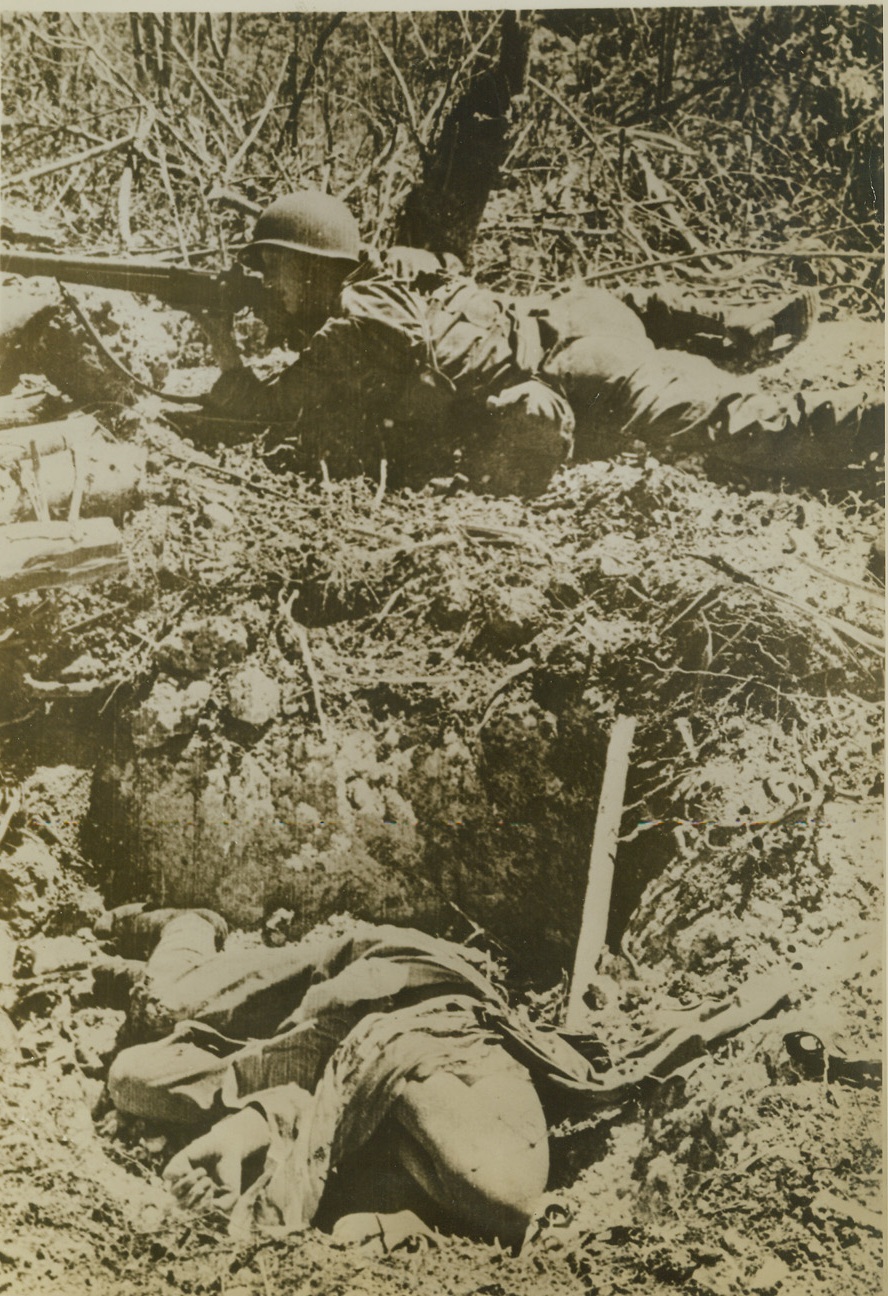
Allies Advance Near Salerno, 9/21/1943. A jeep, (right) loaded with American troops passes a burning Italian vehicle, as the Allies swept through another town in the Salerno area. Today, as Allied forces closed in near Naples, Germans are reported to be looting and killing in that city after setting much of it afire preparatory to abandoning Naples. Credit Line (U.S. Signal Corps Newsreel from Acme);
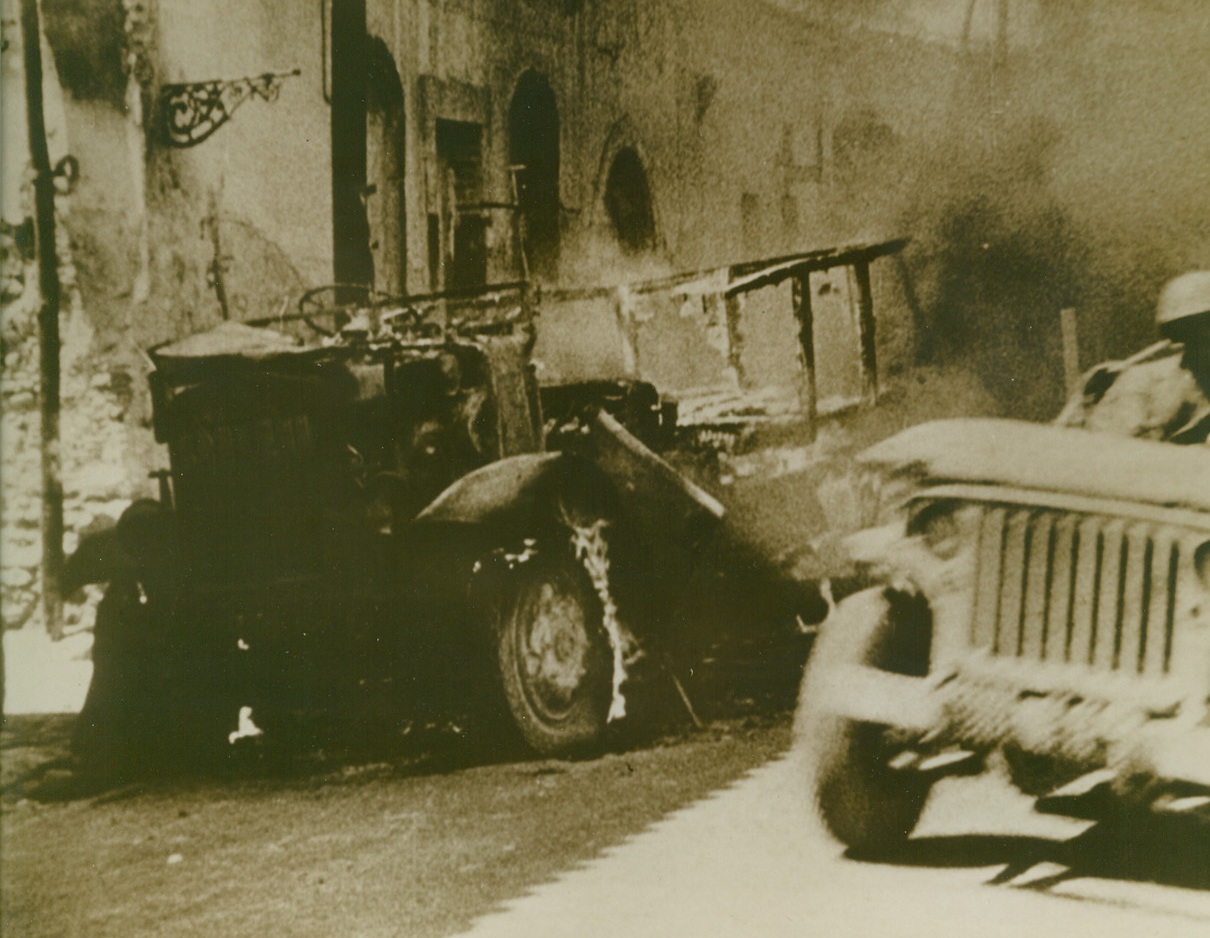
Allies Advance Near Salerno, 9/21/1943. A jeep, (right) loaded with American troops passes a burning Italian vehicle, as the Allies swept through another town in the Salerno area. Today, as Allied forces closed in near Naples, Germans are reported to be looting and killing in that city after setting much of it afire preparatory to abandoning Naples. Credit Line (U.S. Signal Corps Newsreel from Acme);
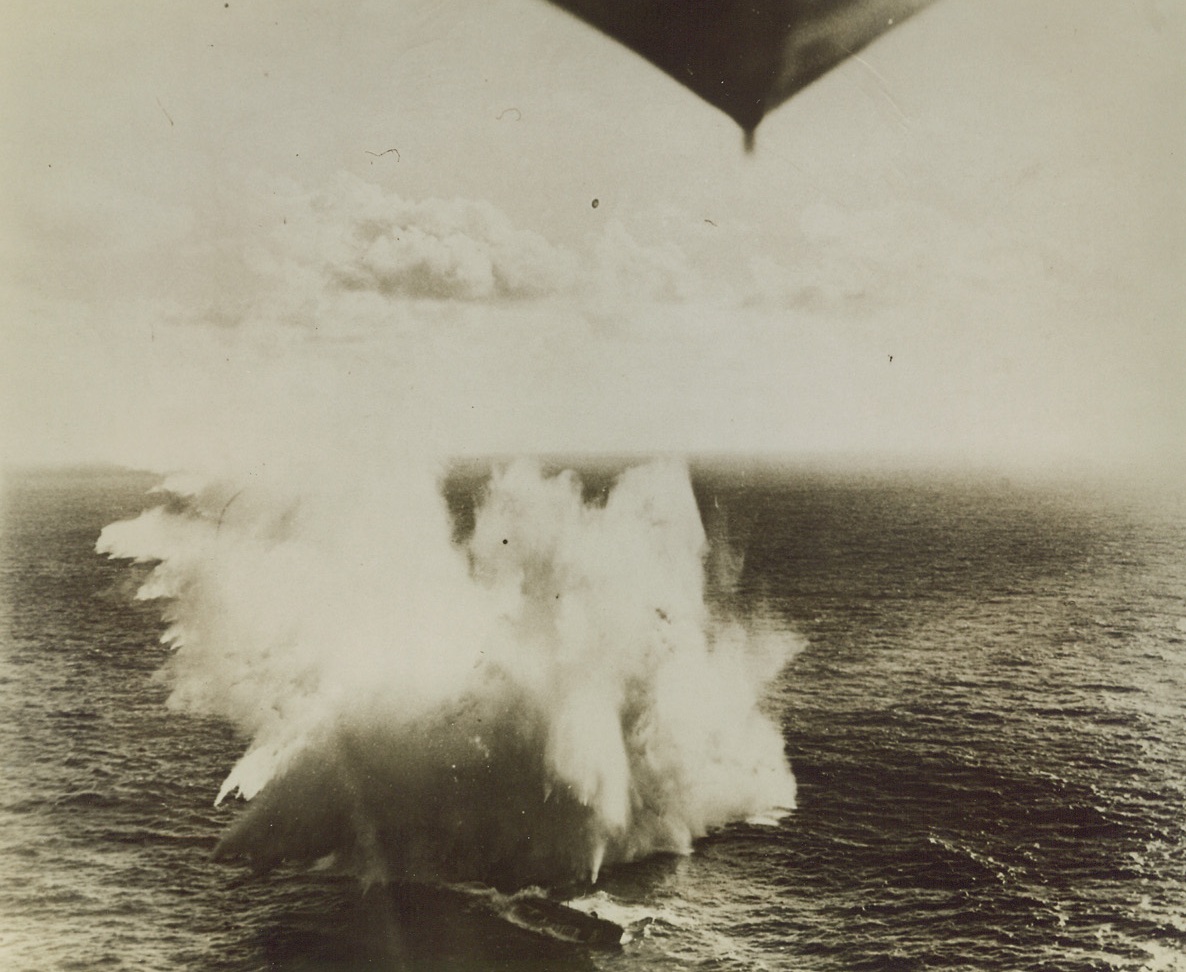
Blasting Nazi U-Boat, 9/21/1943. This photo, released by the U.S. Navy Department today, shows exploding depth bombs from a U.S. Navy Martin Mariner (PBM) patrol bomber straddling a German submarine “somewhere in the South Atlantic.” The disabled U-boat was finished off later by U.S. destroyers. Prow and conning tower of the sub can be seen just below the center of smoke column. Part of the plane from which the photo was taken can be seen in the picture, (top, center). the attack took place in 1943. Credit Line (U.S. Navy Photo from Acme);
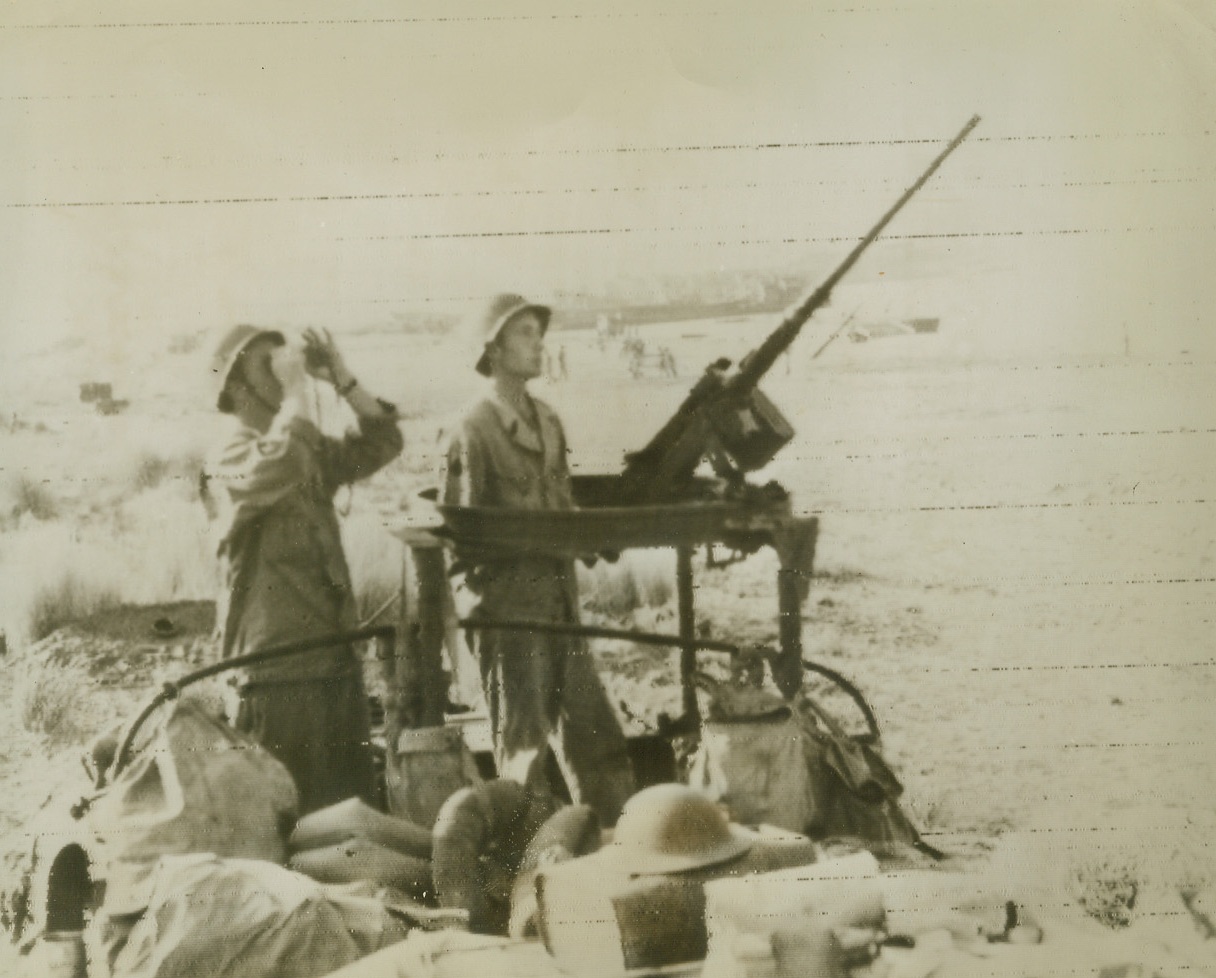
WATCH ON A “DUCK”, 9/15/1943. SALERNO, ITALY—Scanning the skies for enemy planes, these Yanks stand watch with a heavy anti-aircraft machine gun mounted atop an amphibious, 2-1/2-ton “duck” on a beach in the Salerno area. Photo radioed to New York from Algiers today (Sept. 15th). Credit: Official OWI radiophoto from Acme;

NAZIS GRAB ITALIAN TANK, 9/16/1943. NORTHERN ITALY—German soldiers take over an Italian tank in northern Italy, where the “supermen” are battling their former allies. Nazis are using much “commandeered” equipment in the fight for Salerno, where Americans and British are clinging tenaciously to their beachhead, in spite of savage German assaults. Photo radioed from Stockholm to New York today (Sept. 16th). Credit: Acme radiophoto;

BATTLE SMOKE CLOUDS ROME, 9/16/1943. ROME—After swooping down to the suburbs of Rome, following Italy’s capitulation to the Allies, Nazi parachute troops disarm an Italian tank crew in the street, according to the German caption that accompanied this radiophoto. Smoke and flame rise over the Italian city from fires set by the Nazis. Photo was sent from Berlin to Stockholm and radioed to New York today (Sept. 16th). Credit: Acme radiophoto;

NAZI PARATROOPS LAND IN ROME, 9/16/1943. ROME—Landing in the suburbs of Rome with motorcycles, German parachute troops capture an Italian armored car, according to the German caption that accompanied this radiophoto. Radioed from Berlin to Stockhold, photo was radioed to New York today (September 16th). Credit: Acme radiophoto;

CAPTURED CARS WAVE WHITE FLAGS, 9/18/1943. ITALY—American soldiers, driving captured German armored cars back from the front, wave white flags to avoid being shot by Yank gunners. The cars were taken during early engagements with the Nazis on the Italian mainland. Credit: Acme;
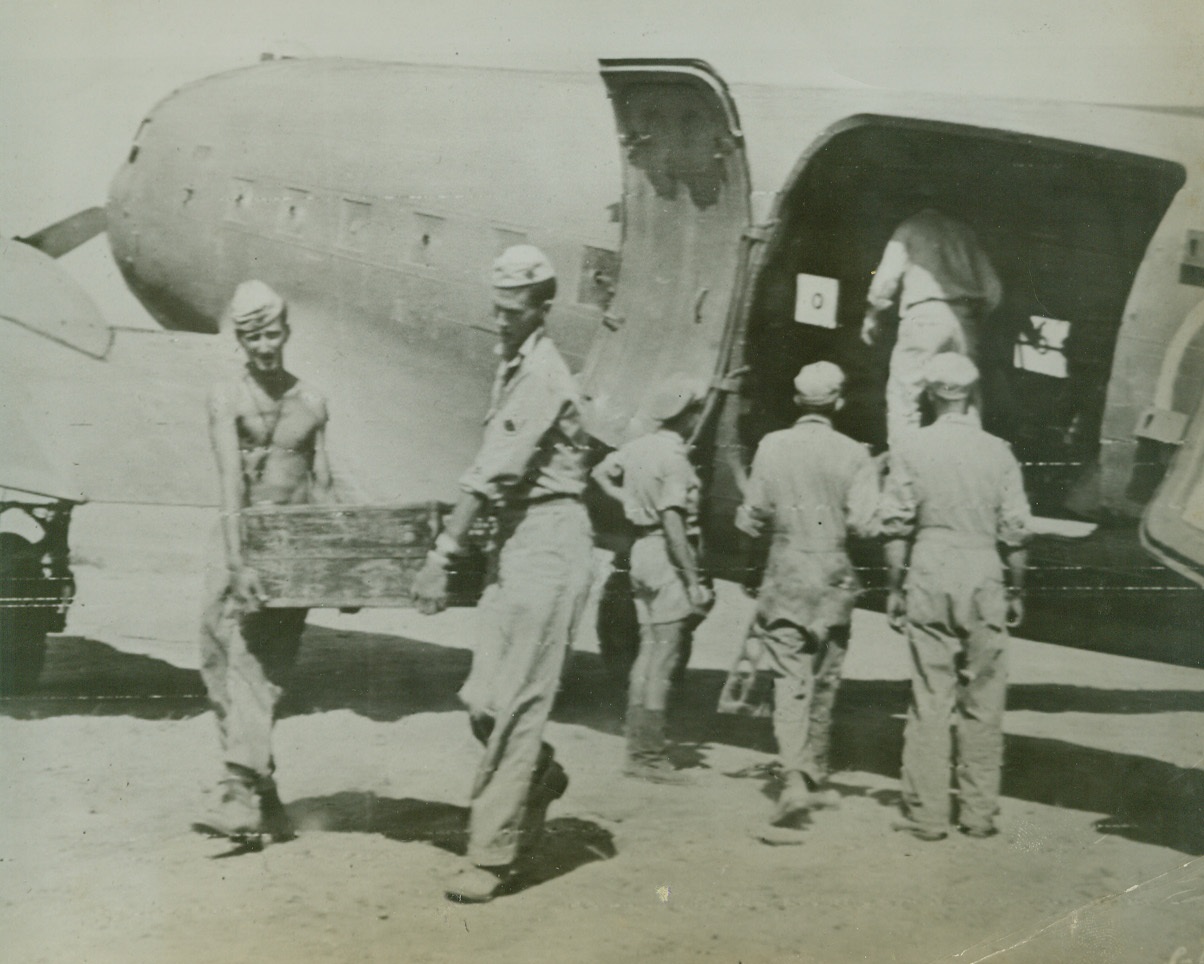
MATERIEL TO FURTHER ITALY’S INVASION, 9/19/1943. The above photo flashed to the U.S. by radiotelephoto shows enlisted men of a fighter group of American soldiers unloading an Allied transport plane that landed on a narrow strip of beach on Italian soil as we battle our way inland. Credit: U S Army Signal Corps radiotelephoto from Acme;
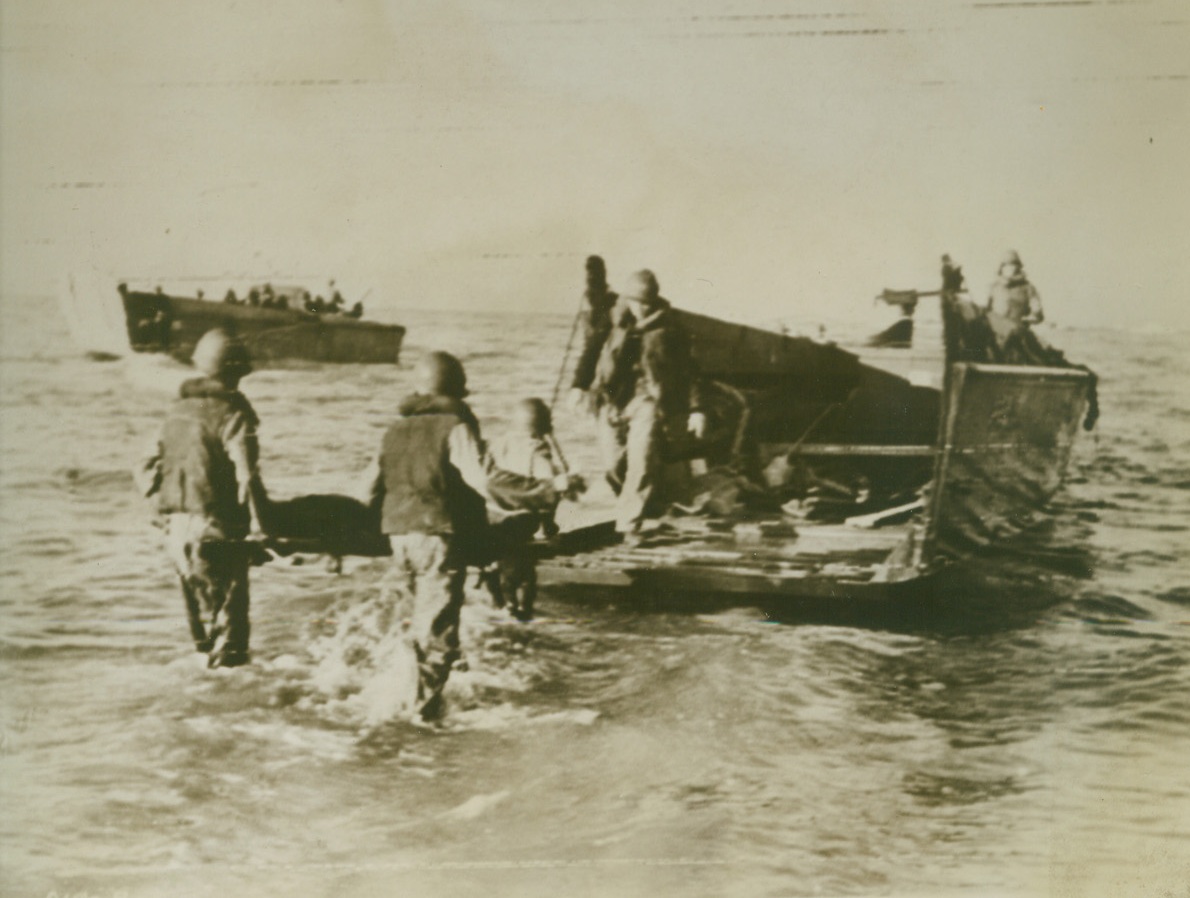
REMOVING U.S. CASUALTIES FROM SALERNO, 9/16/1943. American soldiers wounded in the bloody fighting in the Salerno area, are removed by litter to landing barges for transportation to base hospitals far from the scene of battle, in this photo flashed to the United States by radiotelephoto today, as it was announced that forces under Lt. Gen. Mark W. Clark are driving the Germans back in the Salerno area. Credit: U.S. Signal Corps radiotelephoto from Acme;
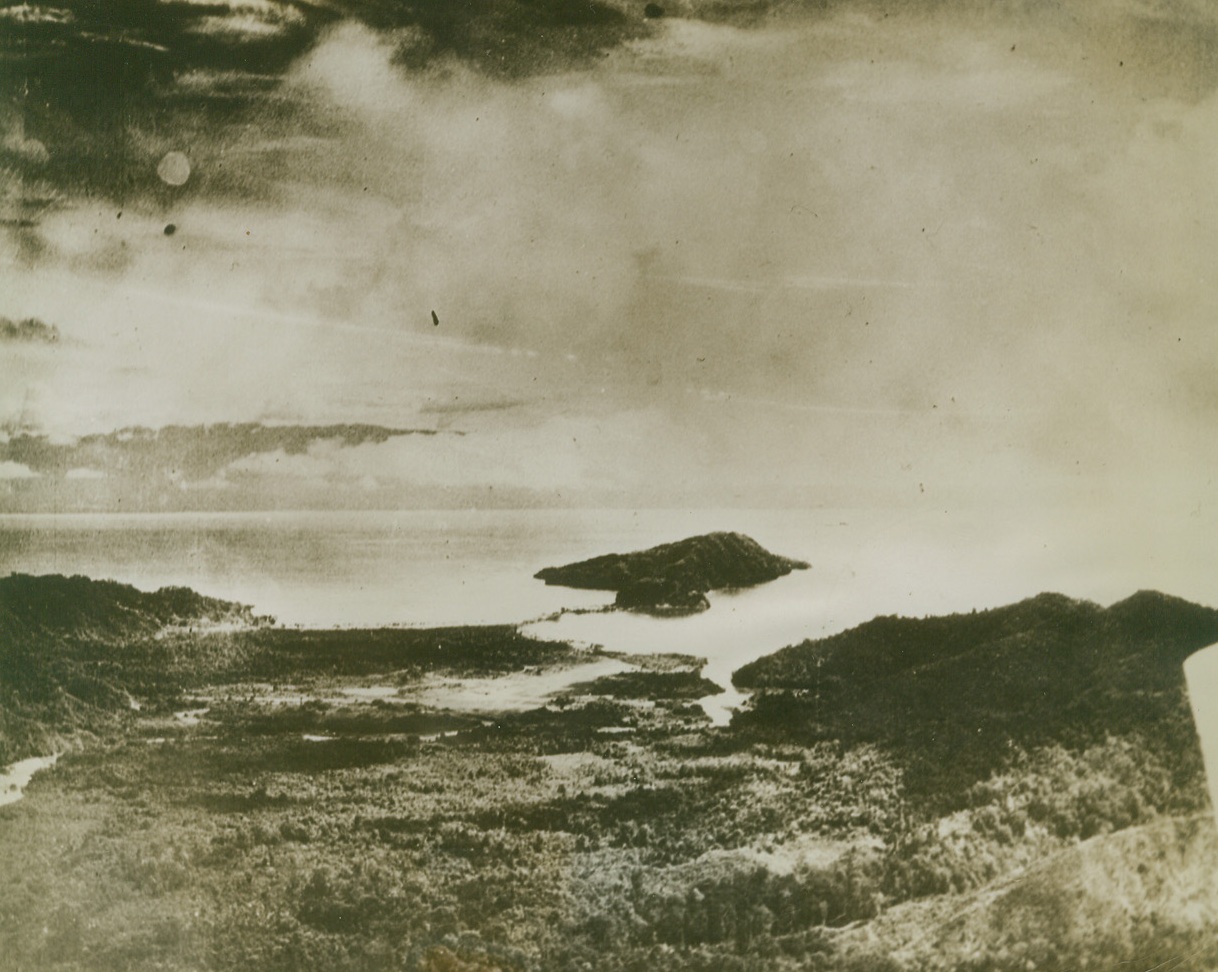
SALAMAUA AIRFIELD, 9/5/1943, NEW GUINEA—Here is an aerial view of the Jap-held airbase at Salamaua, 25 miles south of Lae, on the northeast coast of New Guinea. Allied forces launched a land, sea, and air attack on Lae this morning (Sept. 5th), cutting off the Salamaua base, which is rapidly being encircled. Photo made from an American Army Air Forces plane. Credit: U.S. Army Air Forces photo from Acme;
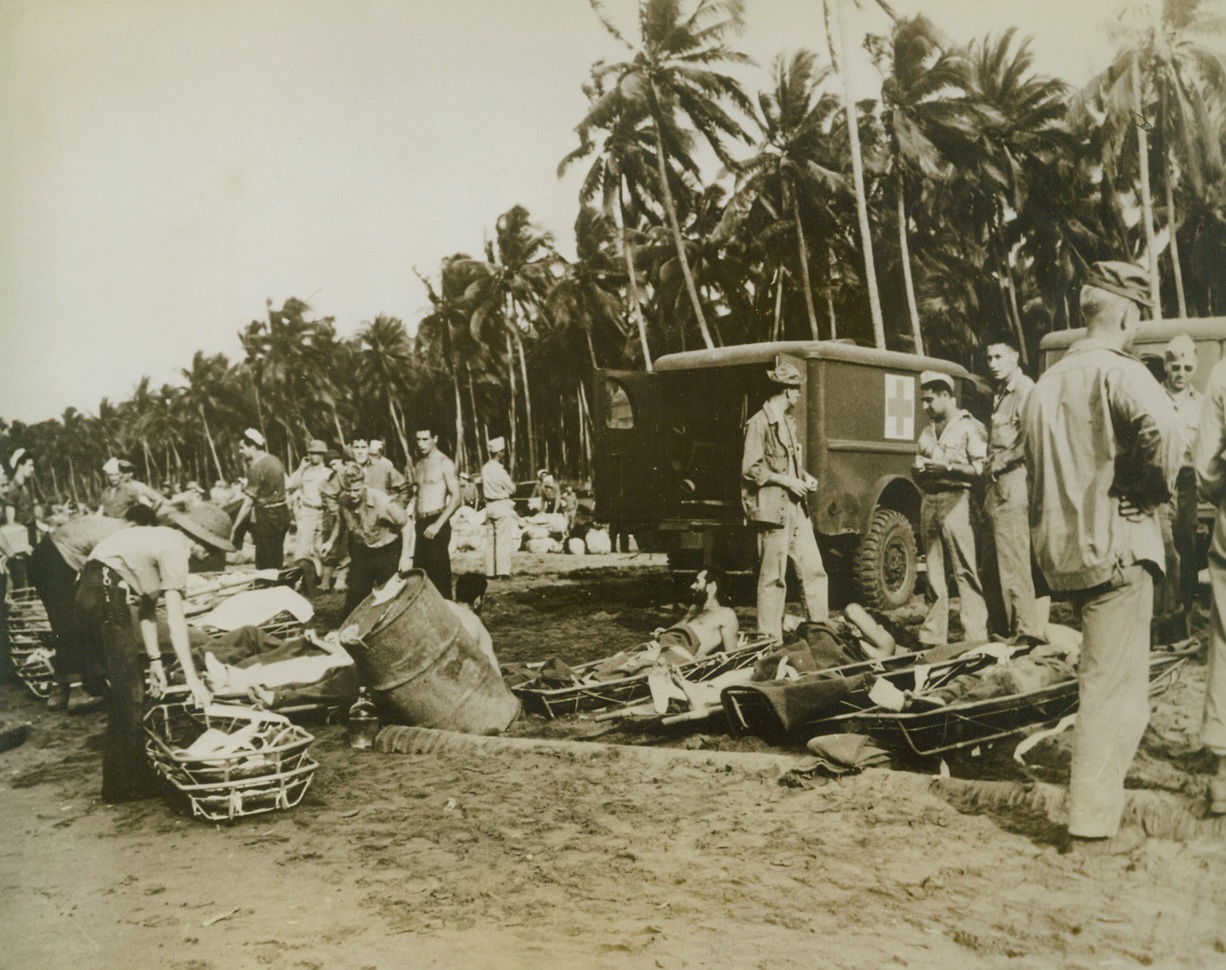
YANK CASUALTIES, 9/29/1943. GUADALCANAL—Casualties, American fighters wounded on the New Georgia front, are made ready to be transferred to hospital ships at Guadalcanal, near base for the renewed South Pacific offensive. Most of the men were brought out by fast transports and battleships, while others were evacuated from the fighting front by plane. Credit: U.S. Marine Corps photo from Acme;
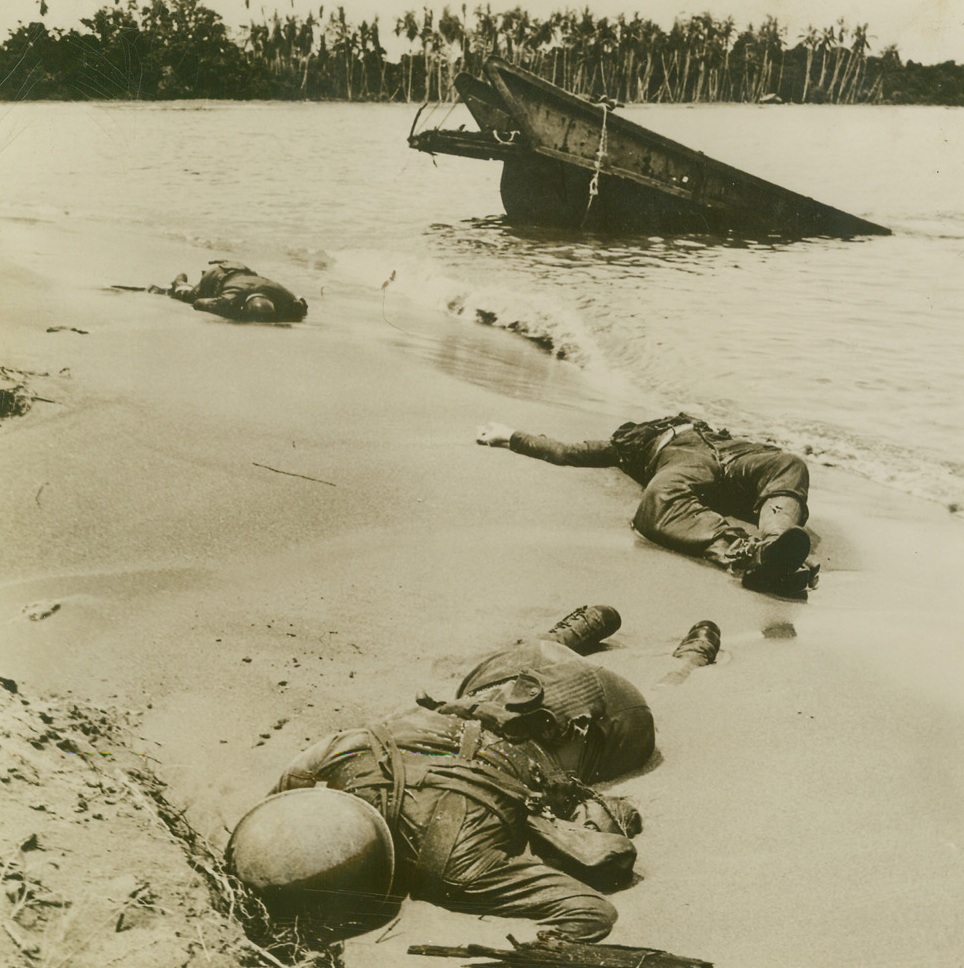
OURS, 9/13/1943. NEW GUINEA—Japs, hiding in a barge with rifles and grenades, took the lives of these three American fighters who were mapping up on the last day of the Buna Gona battle in New Guinea, last January. Beach and barge action was the bloodiest and most fierce of any Buna action, and these boys are among those who lost their lives but helped win the battle. Credit: Acme;
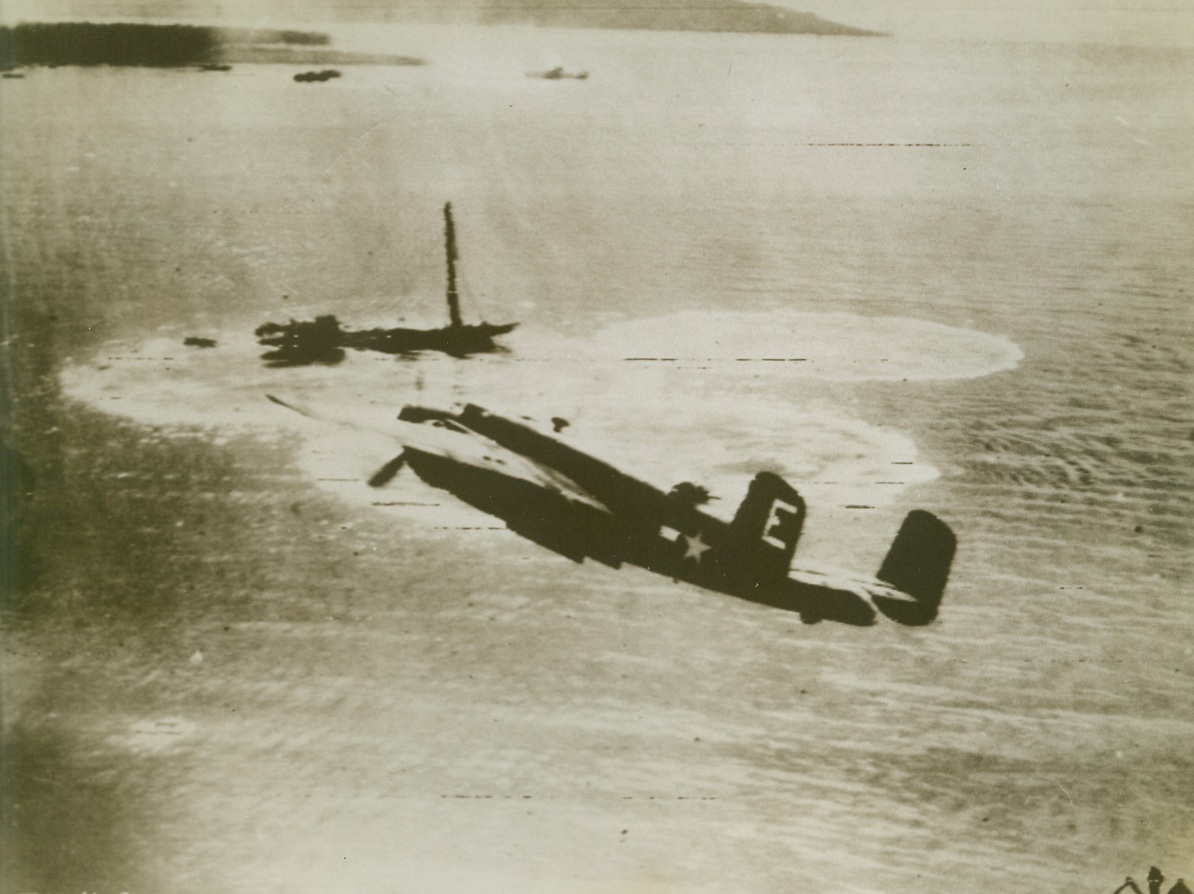
IN FOR THE KILL, 9/2/1943. SOUTH PACIFIC—A United States medium bomber sweeps down for a last blow at a Jap vessel at Hansa Bay, New Guinea. The three large circles in the water mark near misses or arose from previous hits from the B-25. Credit (US Army Radiotelephoto from Acme);
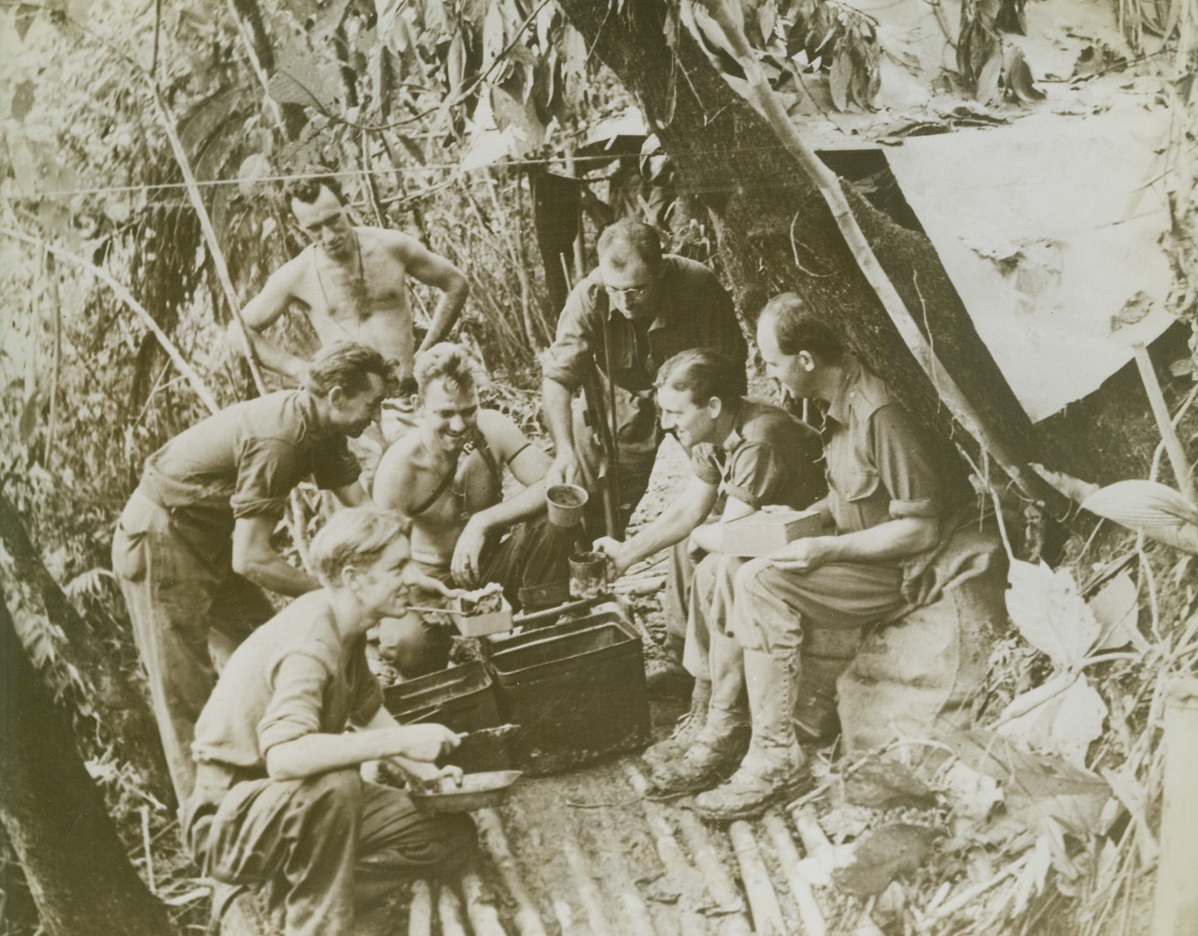
YANKS, AUSSIES CLOSE IN ON SALAMAUA, 9/2/1943. NEW GUINEA—Yanks and Aussies enjoy a hot meal at this out door kitchen on a mountainside near Mubo. The Allied units to which these men belong are closing in on the Jap air field at Salamaua, which is expected to fall at any hour. Left to right, are: Pvt. Les Woolley, of Footscray, Victoria; Pvt. Les Oates, Wangaratta, Victoria, (the cook); Pvt. Bern Buck, Hendigo, Victoria; Sgt. Roy Young, Portland, Oregon; Warrant Officer Sim Woodcock, Fongala, Victoria, Pvt. Frank Bellett, Donald, Victoria; and Staff Sgt. Leo Bidge, of Deniliquin, N.S. Credit Line (ACME);
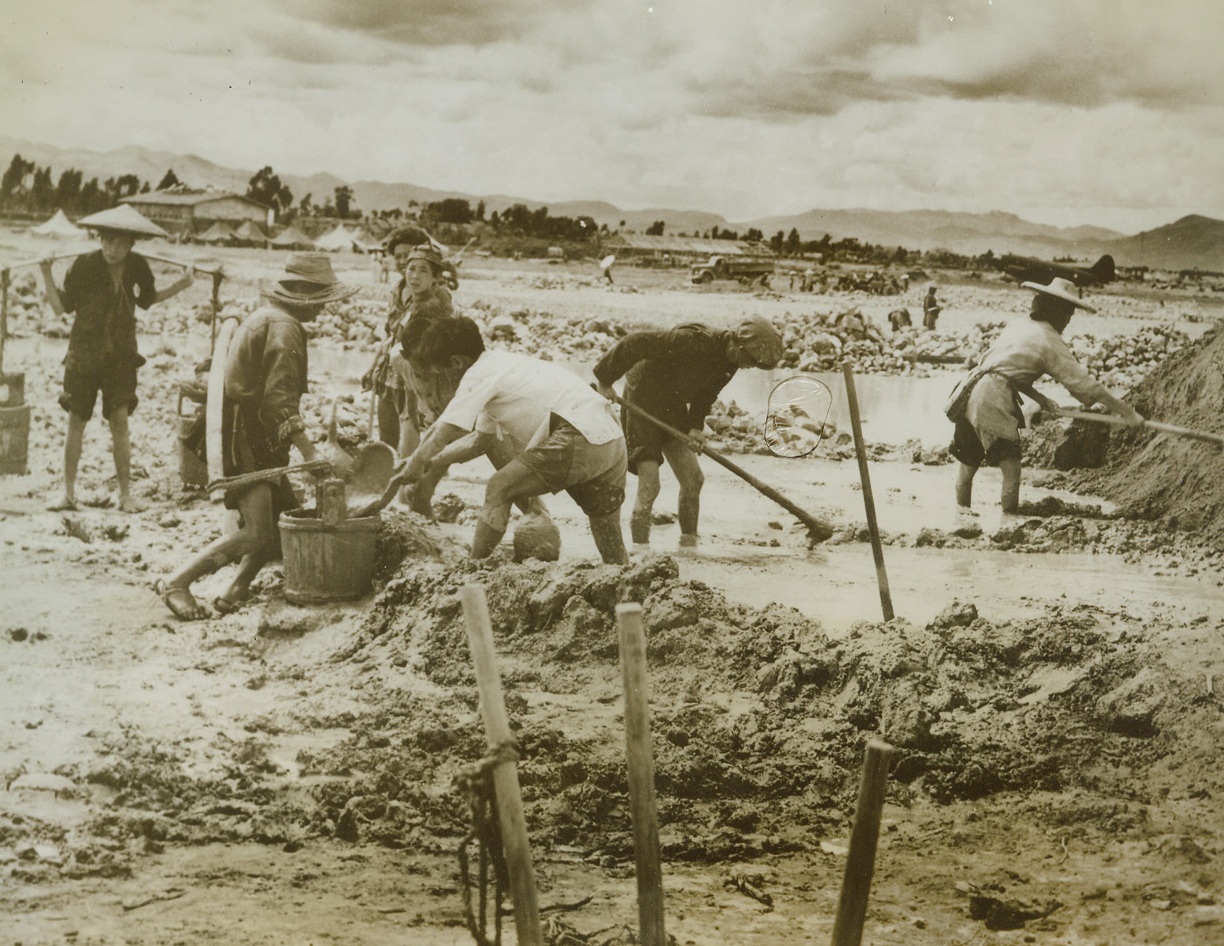
Building A Field For “Iron Birds”, 9/29/1943. Somewhere In China – Working with ancient tools and with the indomitable will and spirit that has gained the respect of the world for the people of China. These natives mix mud and water which will bind bricks together for an Air field “Somewhere in China.” 9/29/43 Credit Line (U.S. Army Air Forces Photo From ACME);
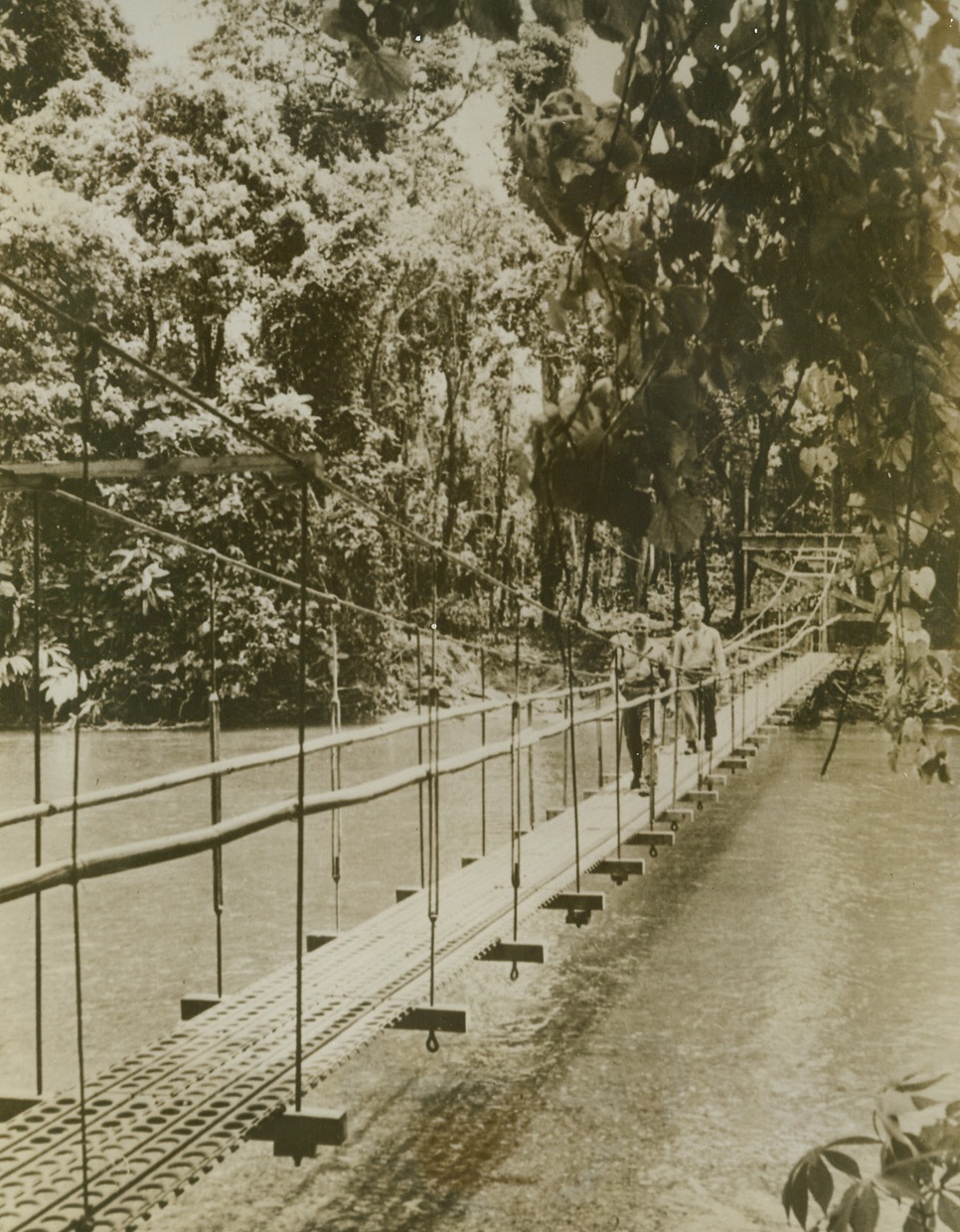
Bridge The Seabees Built, 9/29/1943. The Navy’s Seabees built this bridge across Matanikau, following the battle of Manitanikao River. The bridge enabled Marine Corps assault troops, plus small supply units, to make hurried crossings and reinforce units already in enemy territory. The bridge is constructed of steel matting, the same kind used on the runway of Guadalcanal’s Henderson Field. 9/29/43 Credit Line (U.S. Marine Corps Photo From ACME);

Littered Airfield, 9/30/1943. Lae, New Guinea – Wrecked Japanese Warbirds and debris from a bomb-ruined hangar litter the captured airfield at Lae. In the background, a half-sunk enemy ship tilts at an angle. Latest reports from New Guinea indicate that Australian forces have advanced deeper into Jap defenses around Finschhafen, while Allied fliers continue to pound the air base at Wewak 9/30/43 Credit Line (Photo By Frank Prist, Jr., ACME Photographer For War Pool);

Bomb-Ravaged Salamaua, 9/20/1943. Salamaua – This General view of bomb-ravaged Salamaua shows damage done to the peninsula by our bombs. The truck depot, boat landings, and main Japanese headquarters are completely destroyed 9/20/43 Credit (Signal Corps Radiotelephoto From ACME);
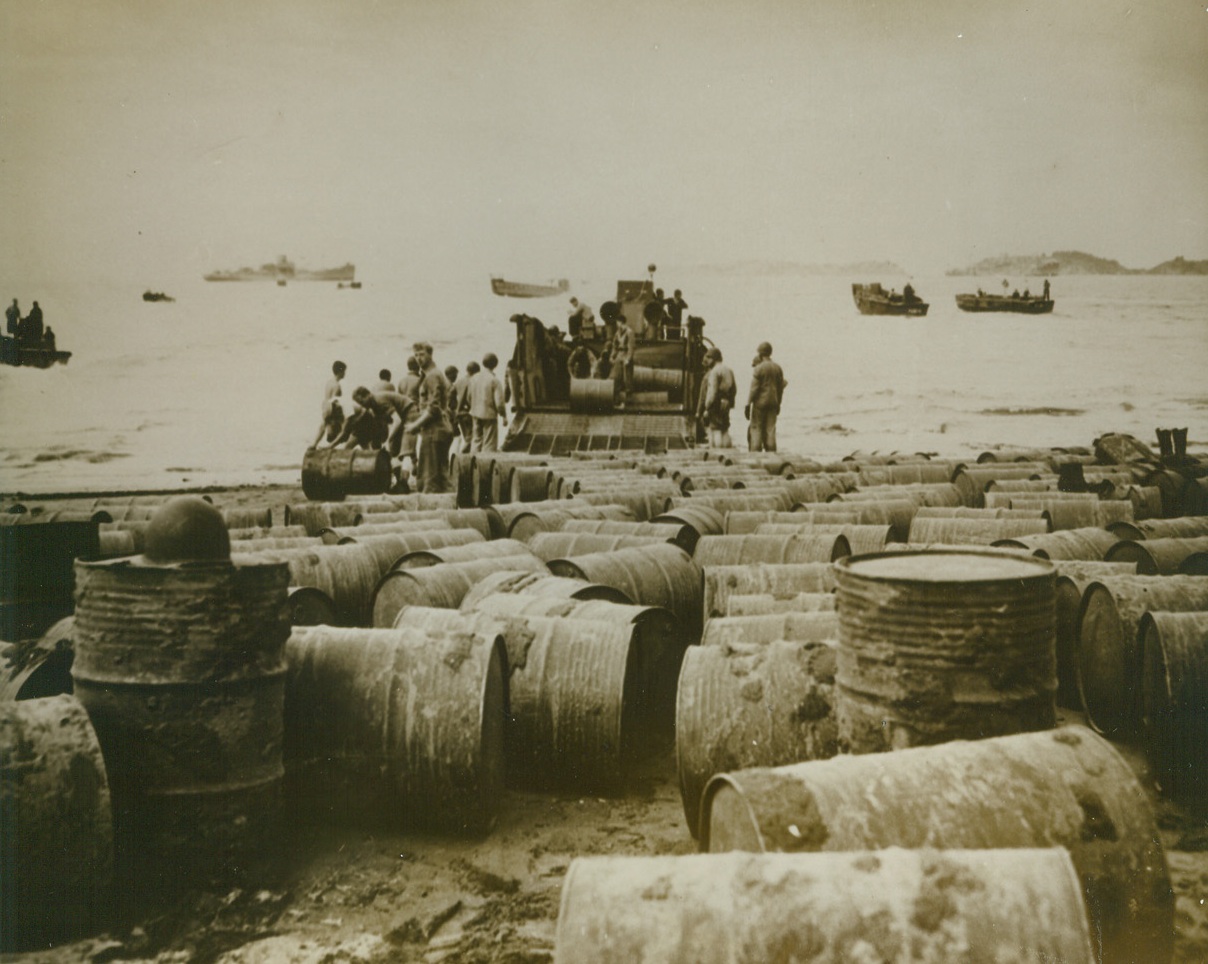
Fuel To Keep Leatherneck Tanks Rolling, 9/24/1943. Somewhere In The South Pacific – Hundreds of drums of oil, rolled from a landing lighter, crowd the beach of a South Pacific Island. Awaiting removal by work gangs of the U.S. Marines, the drums of oil will turn the wheels of tanks, boat engines, and jeeps that bring our Leathernecks nearer and nearer to Tokyo. 9/24/43 Credit Line (U.S. Marine Corps Photo From ACME);
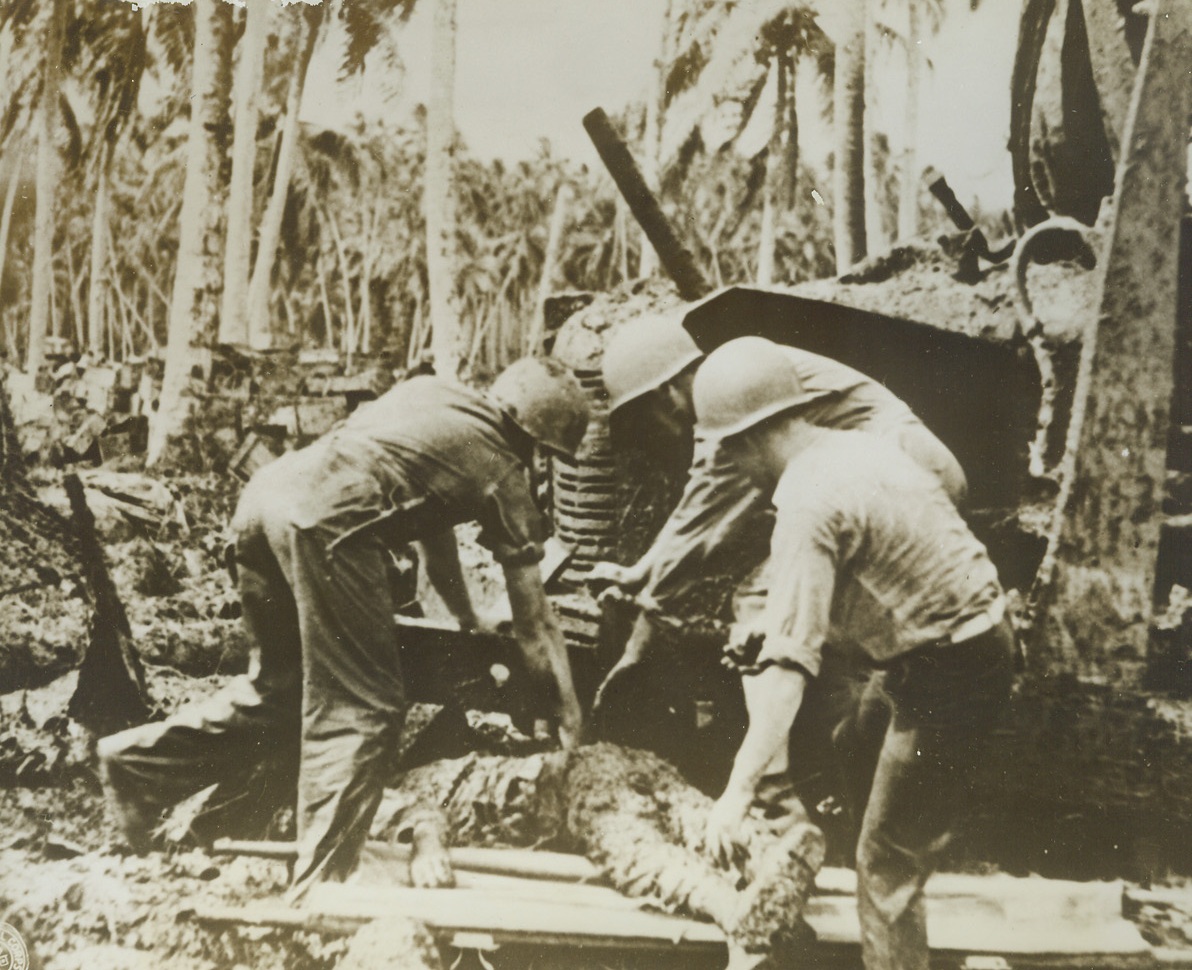
He Gave His Life, 9/25/1943. Rendova Island – Yank fighters lift the body of an American soldier from under a truck where the ill-fated doughboy sought refuge during a Jap bomber raid after the American occupation of Rendova 9/25/43 Credit Line (Signal Corps Photo From ACME);
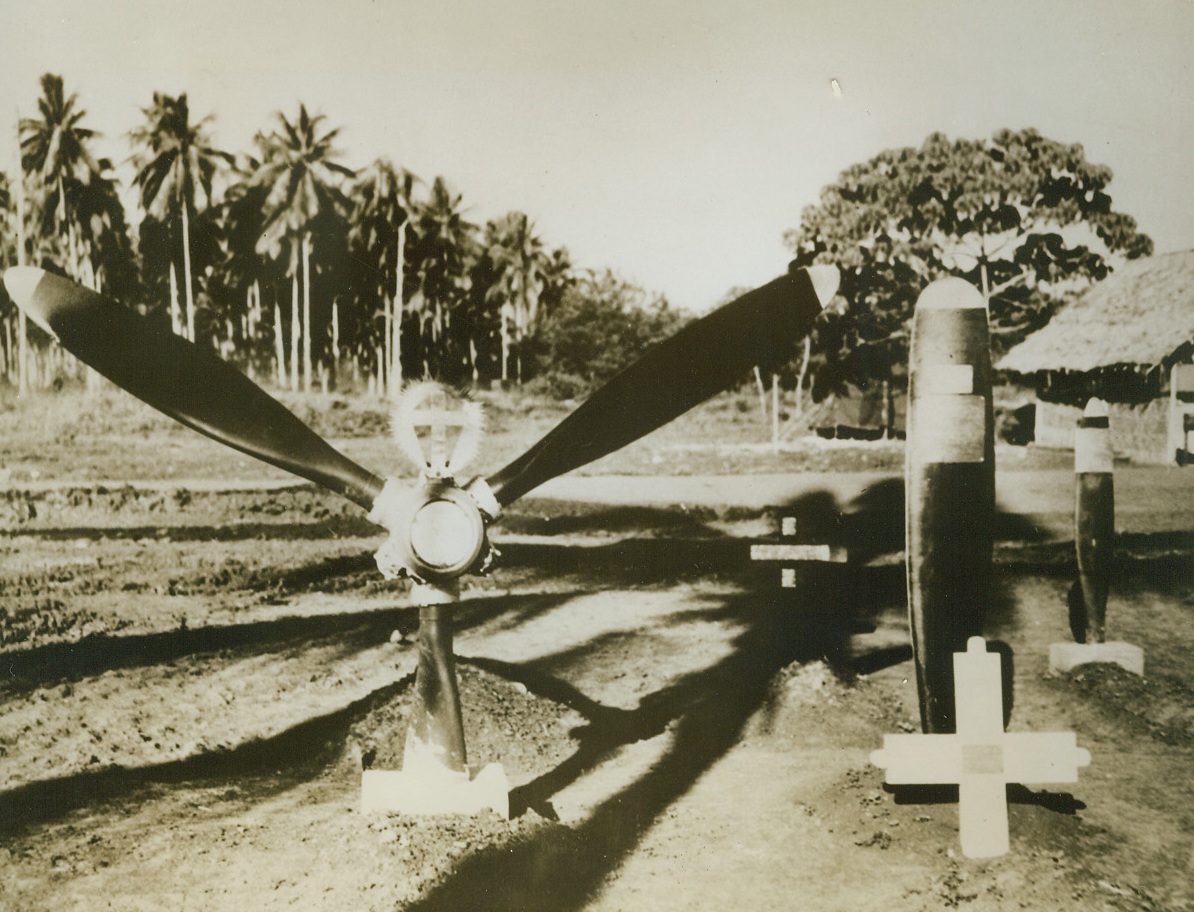
Graves Of Heroic U.S. Fliers, 9/29/1943. Solomon Islands – These propeller blades mark the last resting places of American aviators who died in defense of their country in fighting over Guadalcanal and the Solomon Islands. Today, in the southwest Pacific, their buddies are extracting a terrible toll in Jap planes and have captured virtual superiority in the air. 9/29/43 Credit Line (U.S. Navy Photo From ACME);
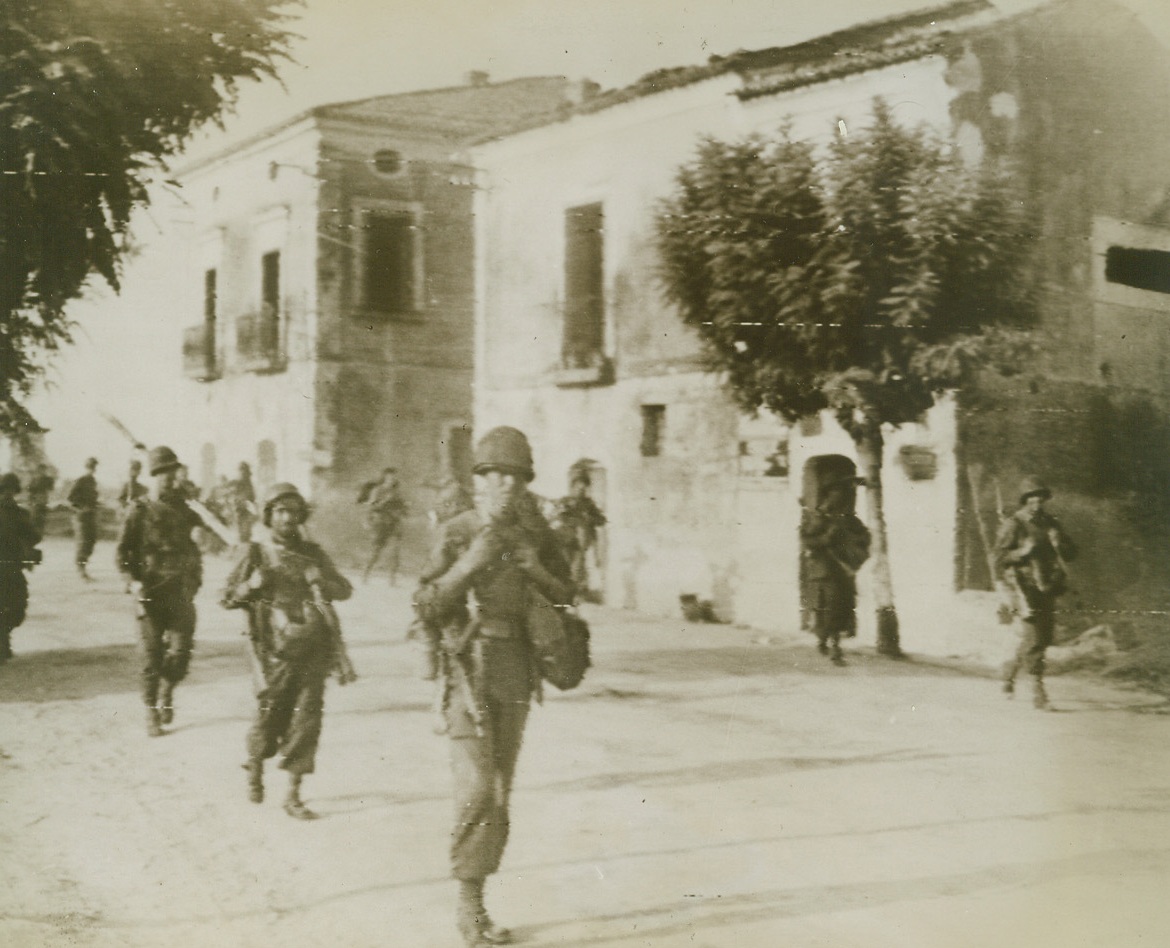
On The March In Italy, 9/14/1943. Italy – Shortly after they landed at an adjacent beach, U.S. Infantrymen march through a seacost town in Italy. The Nazi propaganda machine has it that we are abandoning our beachheads in Salerno, but the report is only enemy wishful thinking 9/14/43 Credit (U.S. Army Signal Corps Radiotelephoto From ACME);

Bombs Hit Strategic Point Near Naples, 9/15/1943. U.S. Army Air Forces bombs fall on Concello, Italy, during the raid of September 9th. Twenty-five miles northwest of Naples, Concello lies on the winding Volturno River. Flying fortresses went after two highway and one railroad bridge spanning the river as they sought to cut vital communications, thereby American 5th Army below Naples. The railroad bridge suffered direct hits, while the other two were badly damaged 9/15/43 Credit Line (U.S. Army Air Forces Photo Via Signal Corps Radiotelephoto From ACME);

Nazi Airdrome Near Salerno Captured, 9/16/1943. This photo, flashed to New York by radio today, shows Nazi planes and barrels of oil on a German airfield in the Salerno area, after the base was captured by the forces of Lt. Gen. Mark W. Clark. Americans and British under Clark’s command, have held their bridgeheads in spite of the bloodiest fighting of the Mediterranean Campaign, and are today counter-attacking against the Germans. 9/16/43 Credit Line (OWI Radiophoto From ACME);
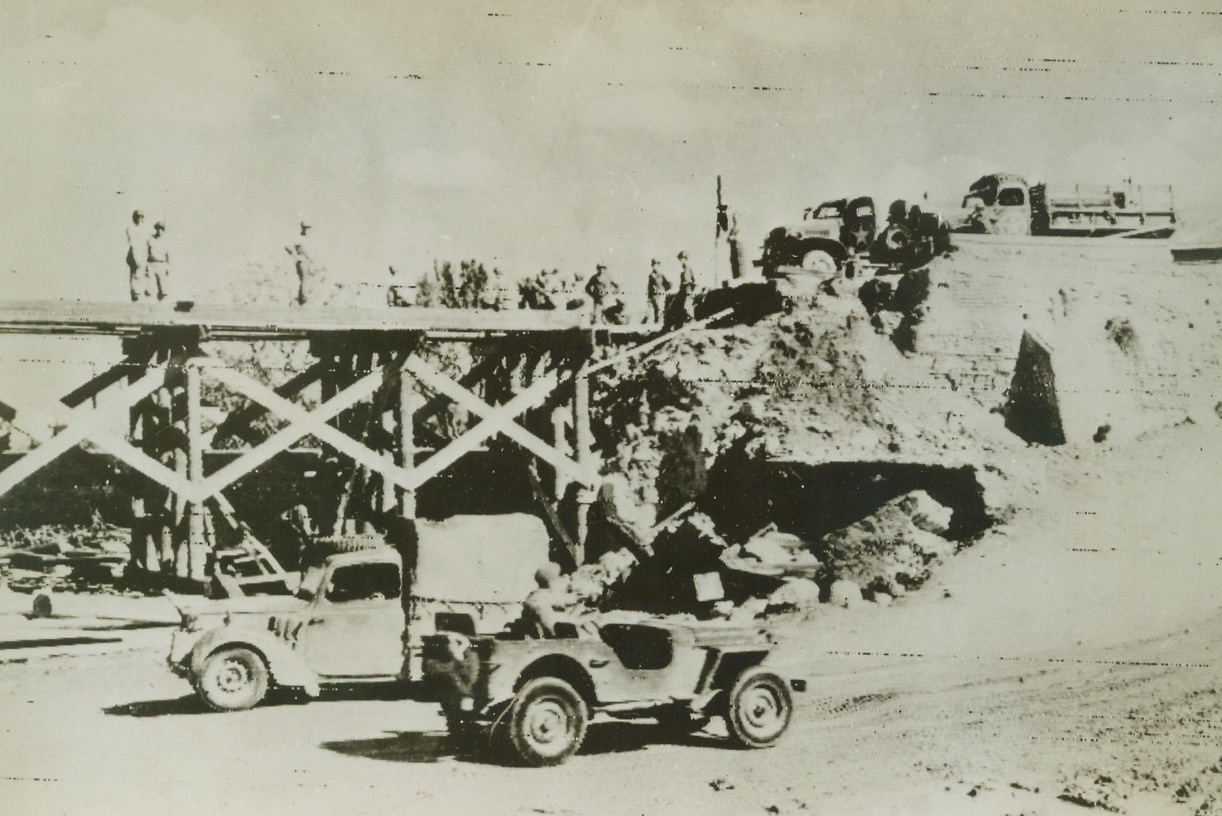
Repairing Wrecked Bridge Near Salerno, 9/16/1943. American engineers of the U.S. 5th Army, Repair a bridge in the Salerno area wrecked by retreating German forces. Today, after the heaviest fighting in the Mediterranean Campaign, Americans and British under Lt. Gen. Mark W. Clark, are forcing the Germans back. 9/16/43 Credit line (OWI Radiophoto From ACME);
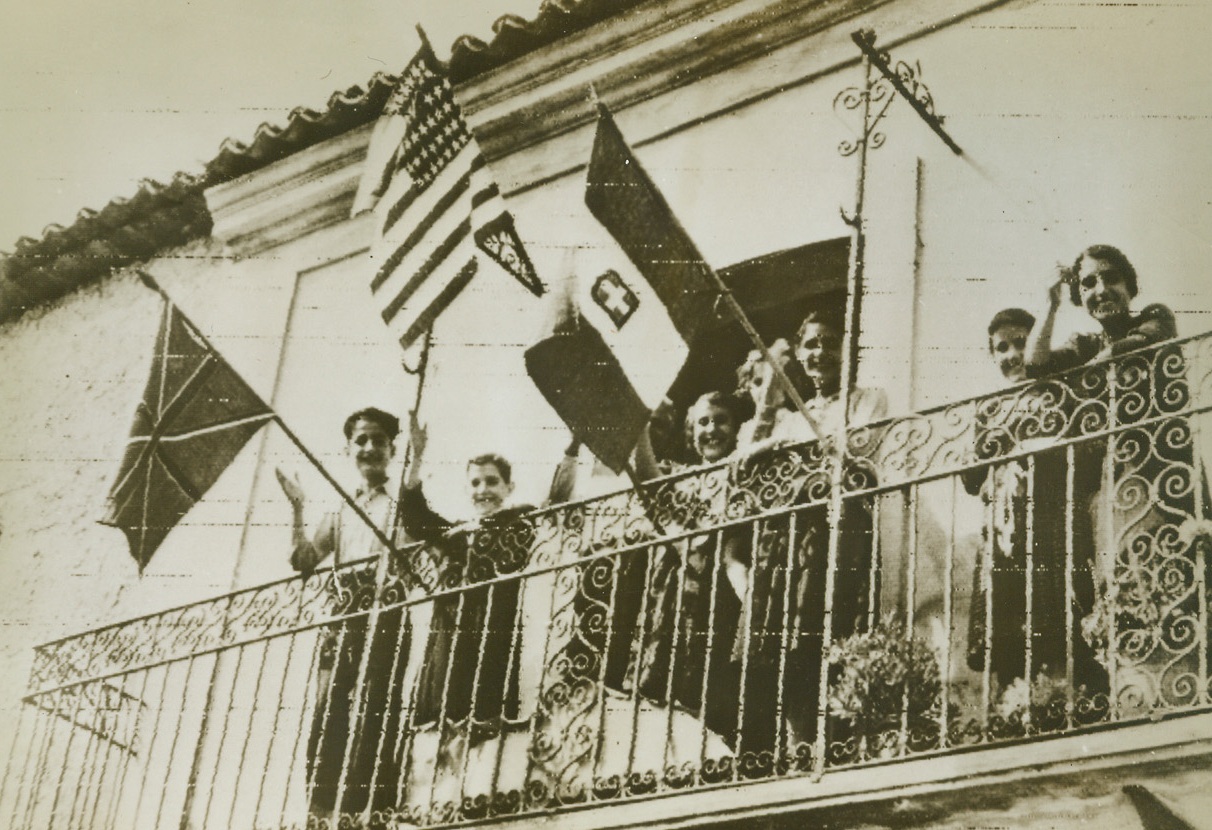
Flags out For The Allies, 9/16/1943. The Stars and stripes, a homemade Union Jack, and an Italian flag (hung upside down), are hung from this balcony in Staletti, Italy, in the Salerno area, as Canadian troops under Lt. Gen. Mark W. Clark enter the town. Today, Clark’s forces are advancing against stubborn German resistance, after eight days of the bloodiest fighting in the Mediterranean Campaign this photo by the Canadian Army, was flashed to New York by Radio today. 9/16/43 Credit Line (OWI Radiophoto ACME);
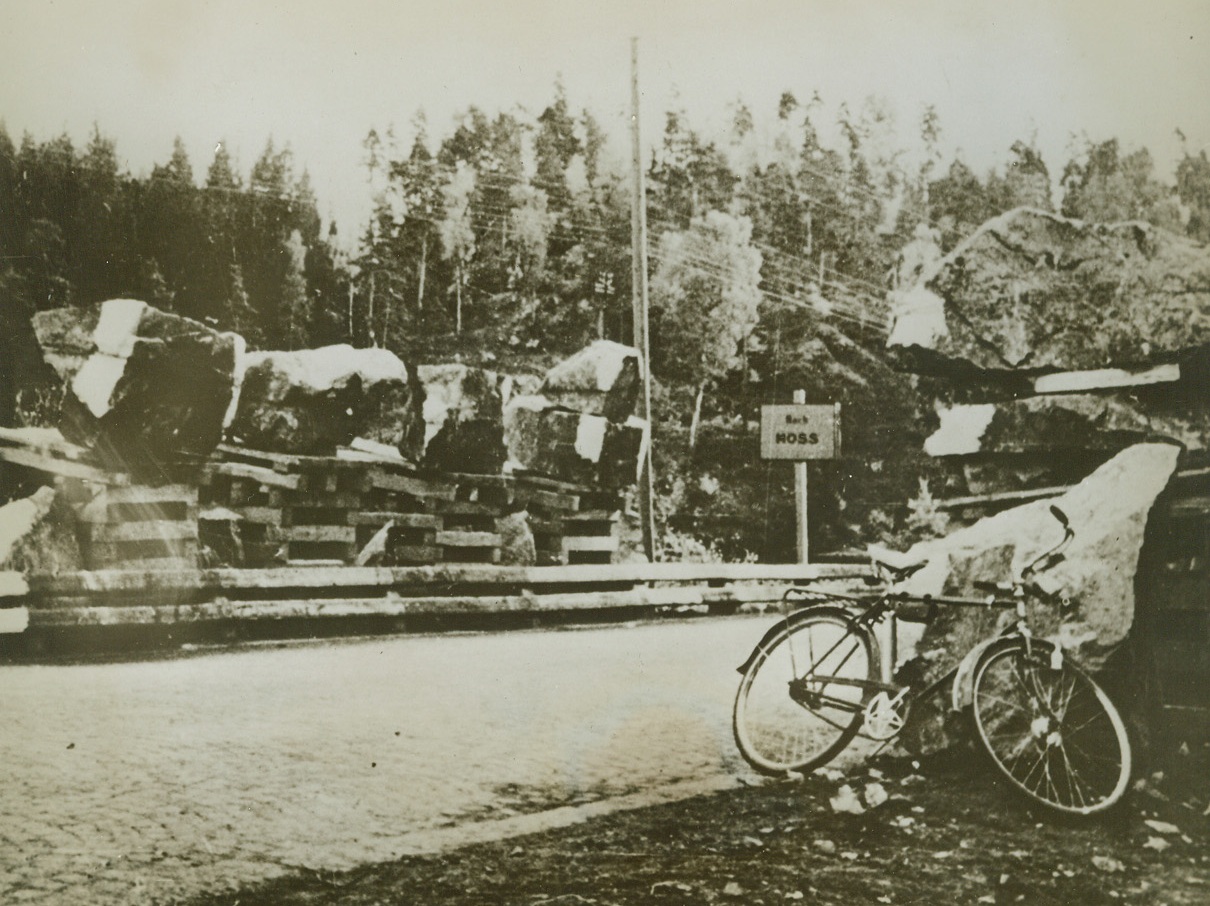
“Invasion Nerves” Hit Nazis In Norway, 9/16/1943. Huge boulders rest on tilted ramps ready to be rolled into a section of road between Moss and Oslo, in this photo smuggled out of Norway and just received in the United States. The Nazis hope this will form an effective road block against any Allied forces that land in Norway. Maybe so – but they had road blocks in North Africa and in Sicily, too -----! 9/16/43 Credit Line (ACME);
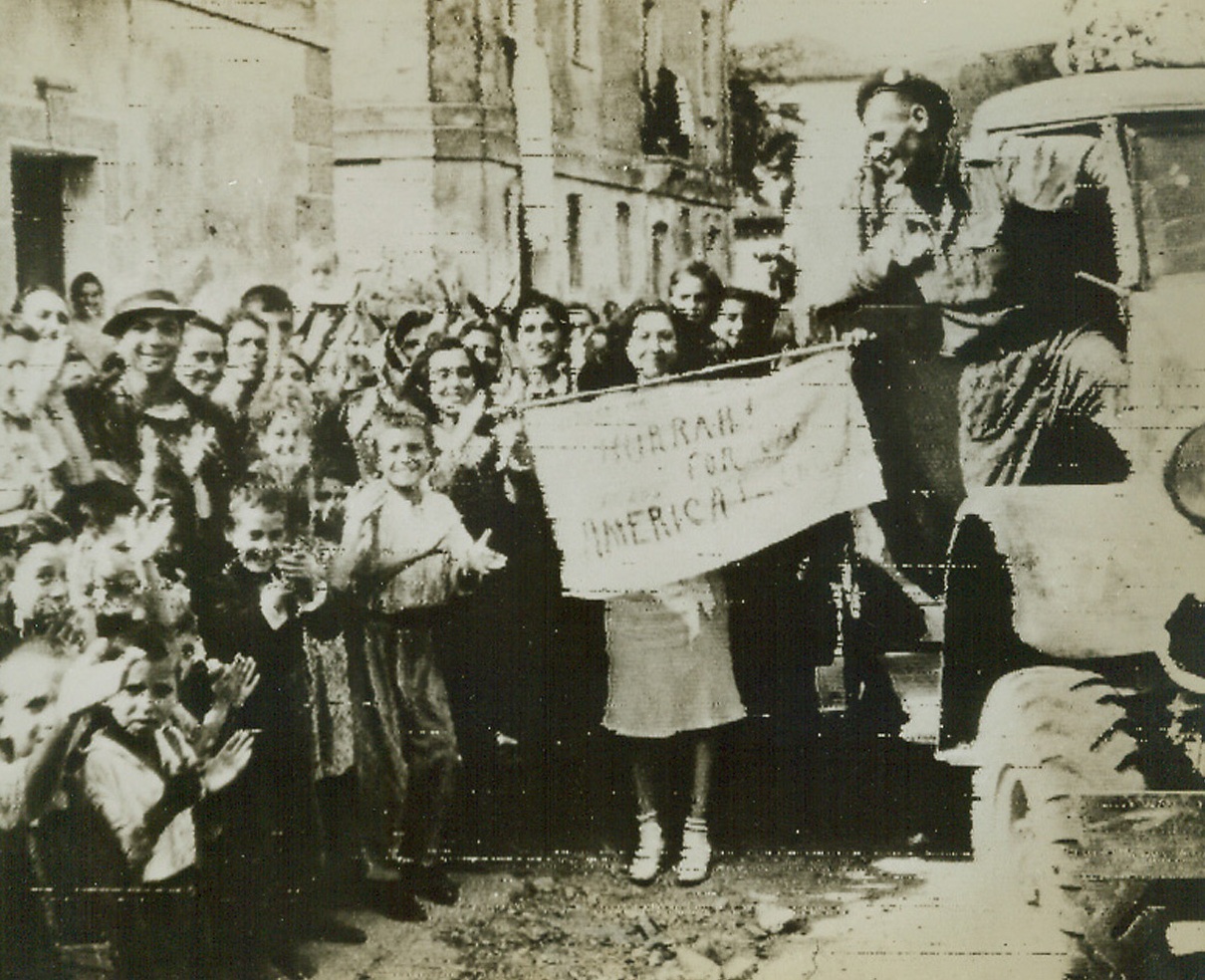
“WELCOME” SIGN OUT FOR THE ALLIES, 9/16/1943. An Italian girl holds a crudely-lettered sign bearing the legend, “Hurrah! For Canada, America, and England!” As Allied troops pass through Staletto in pursuit of the Germans. This photo was received in New York by radio today. Credit Line (OWI Radiophoto from ACME);
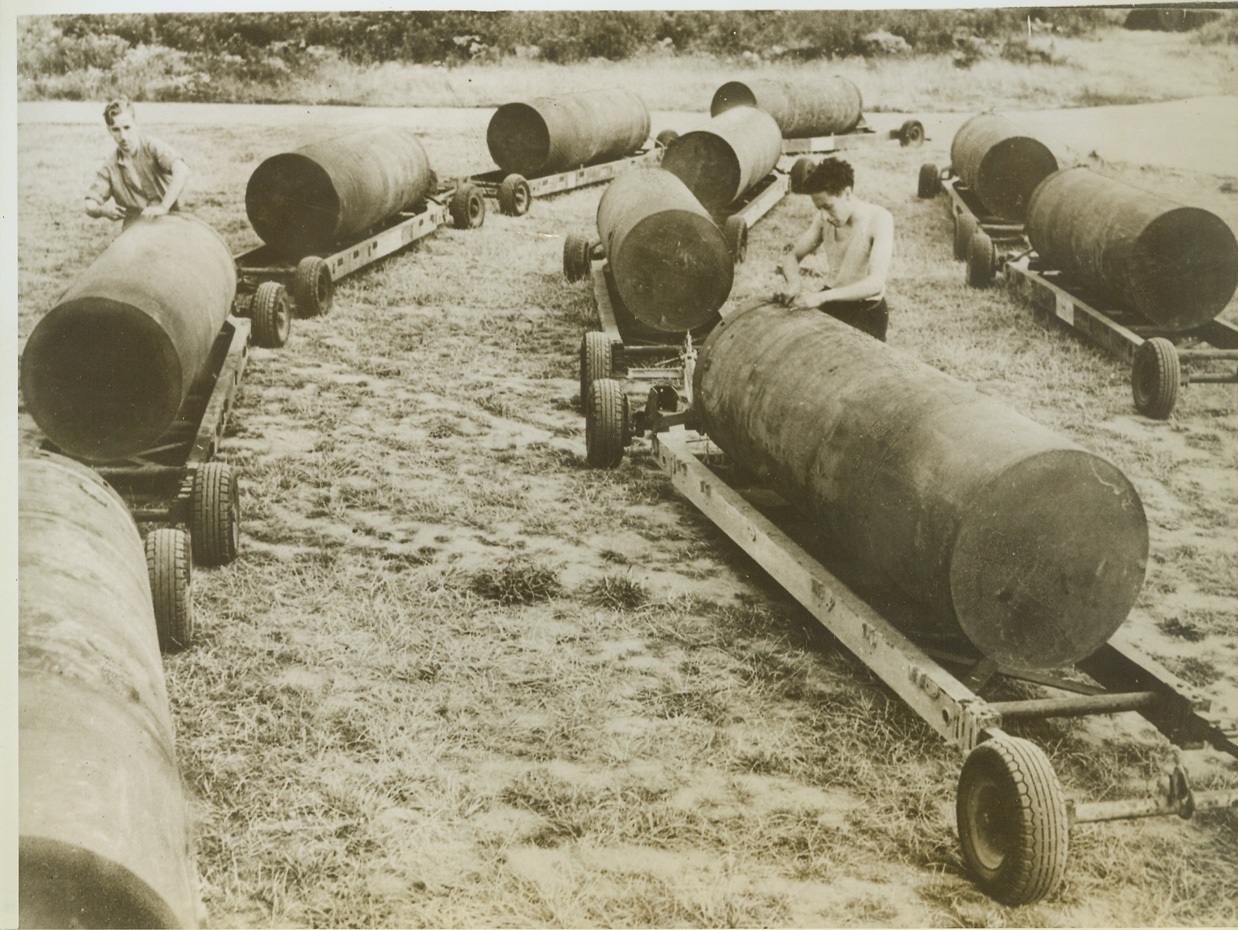
Oversize Eggs, 9/20/1943. SOMEWHERE IN ENGLAND -- When these "eggs" fall in enemy territory, they really do a job. Each of them tipping the scales at 4000 pounds, they are carried over Axis Europe by Lancaster bombers of the RAF. Here, workers check the oversize bombs before loading them onto Lancasters. Credit: (ACME);
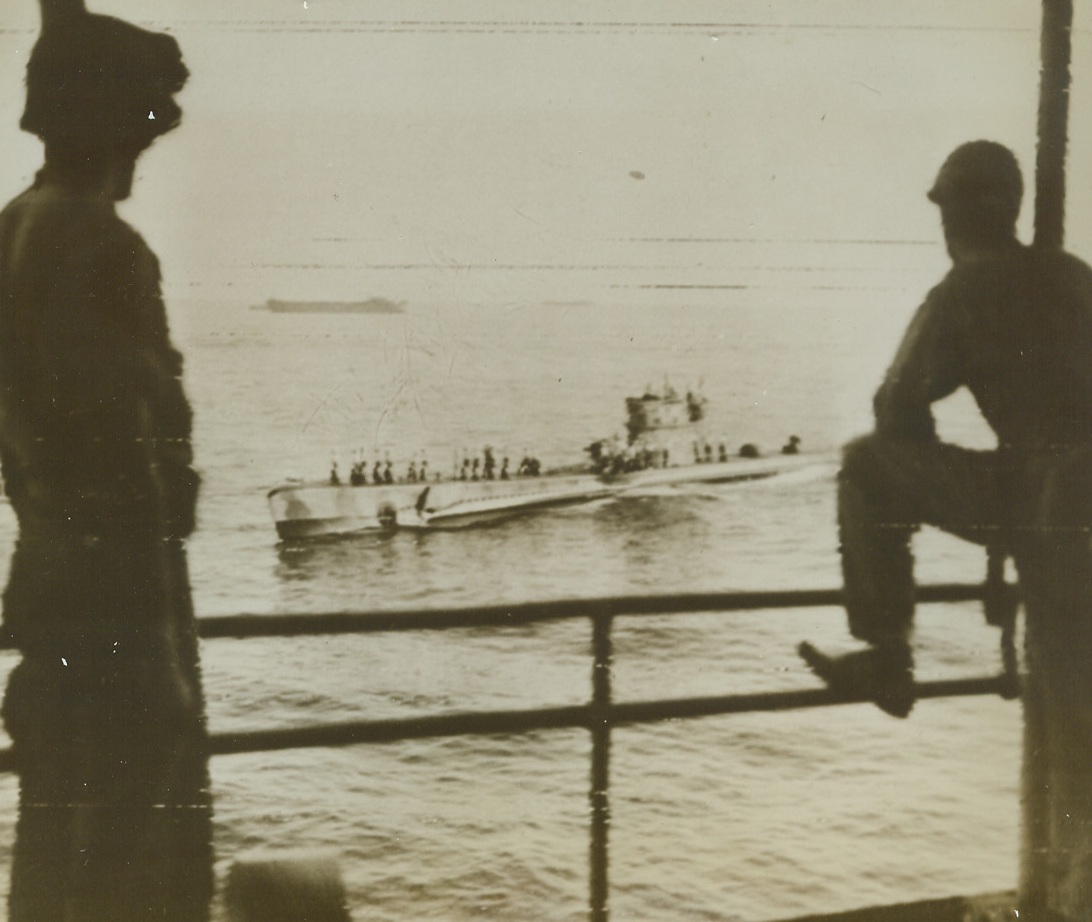
ON THE SAME SIDE, NOW, 9/16/1943. An Italian submarine on its way to an Allied Mediterranean port to surrender and join the United Nations Naval Forces, passes a ship of a huge Allied convoy bound for the invasion of Italy. This photo was flashed to the United States by Radiotelephoto today, as it was announced that forces under Lt. Gen. Mark W. Clark were forcing the Germans back in the Salerno area after eight days of the bloodiest fighting the Mediterranean area has seen. Credit Line (U.S. Signal Corps Radiotelephoto from ACME);
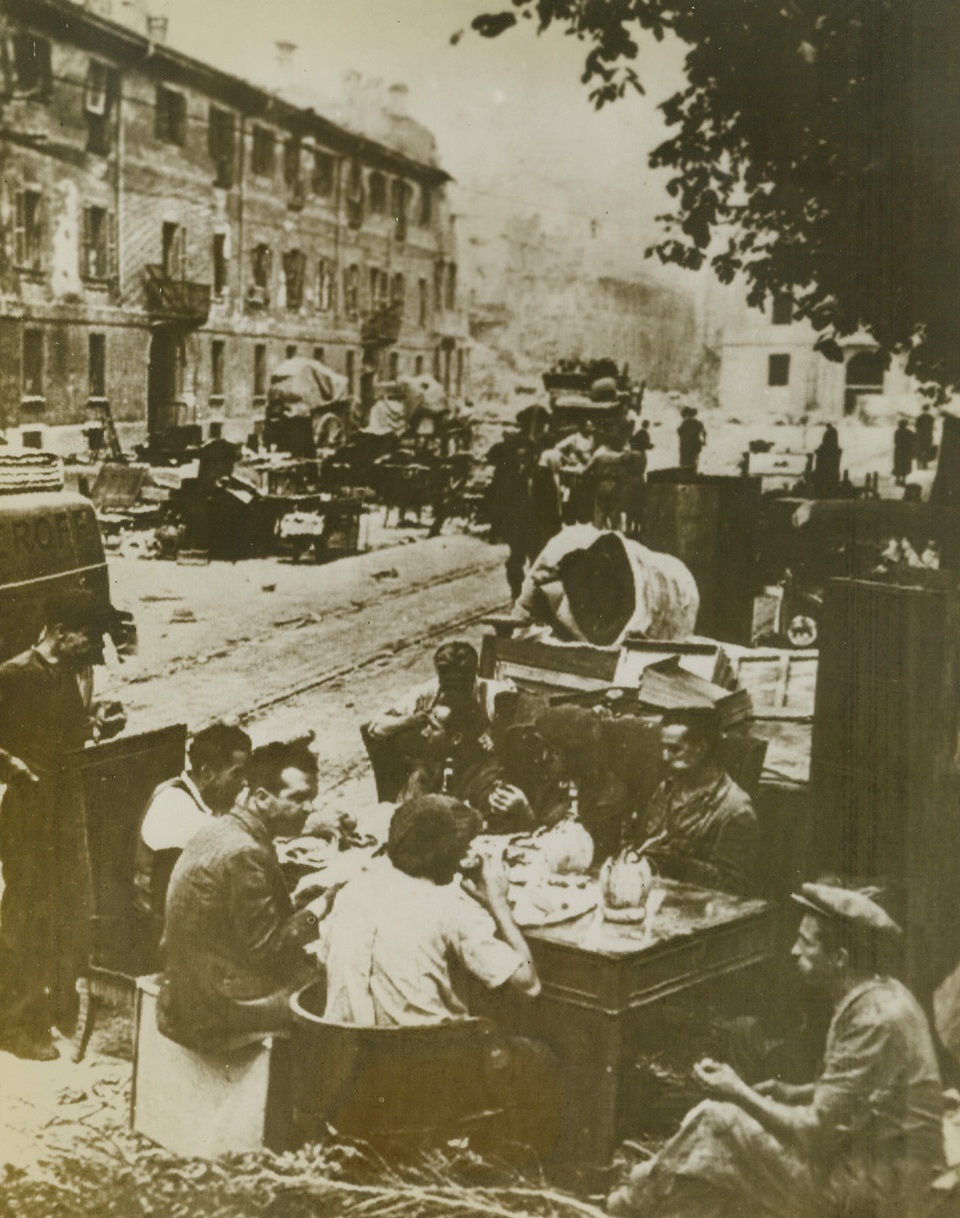
"Open House", 9/10/1943. Milan—After a heavy attack by allied bombers, inhabitants of Milan set up “open house in the streets of the industrial city. Furniture salvaged from bombed buildings, clutters the crowded street. Photo received through a neutral source. Credit: OWI Radiophoto via ACME;

The Distinction of Being First, 9/10/1943. Italy – The first group of Italian prisoners to be taken in Italy proper are rounded up at Gallico, Marina, Italy, where they were captured by British Commandos in a raid from Mili-Marina, Sicily. Although the “unconditional surrender” armistice with Italy had already been signed, it was not yet announced when this photo was made at the Italian port. Credit: U.S. Army Signal Corps Radiotelephoto from ACME;
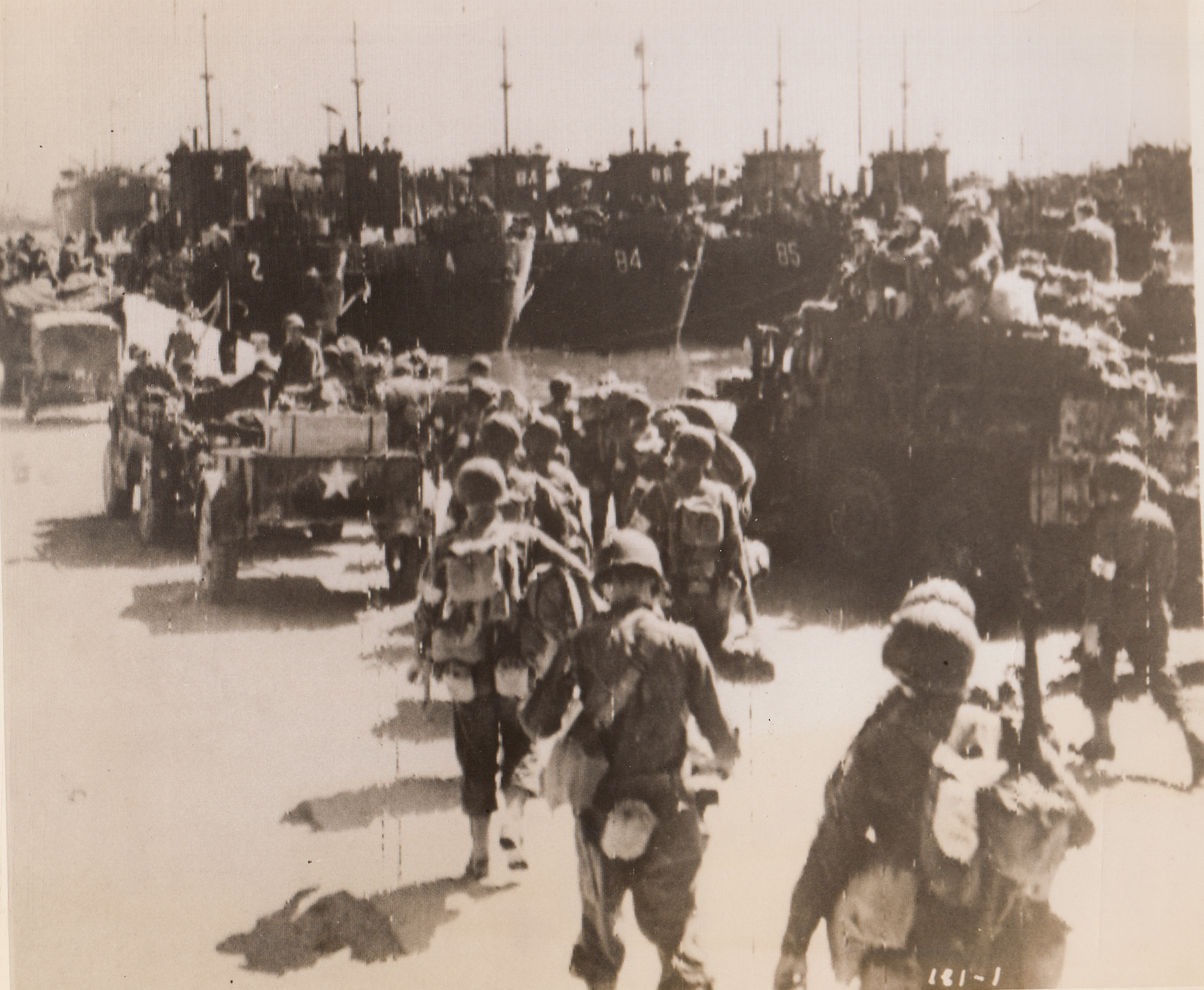
U.S. Soldiers Get Set for Italy, 9/10/1943. Bunches of L.C.I.’s await boarding by these American fighters at an unnamed Mediterranean port. Their destination? Italy, where more than a few Nazis need some rough treatment.;
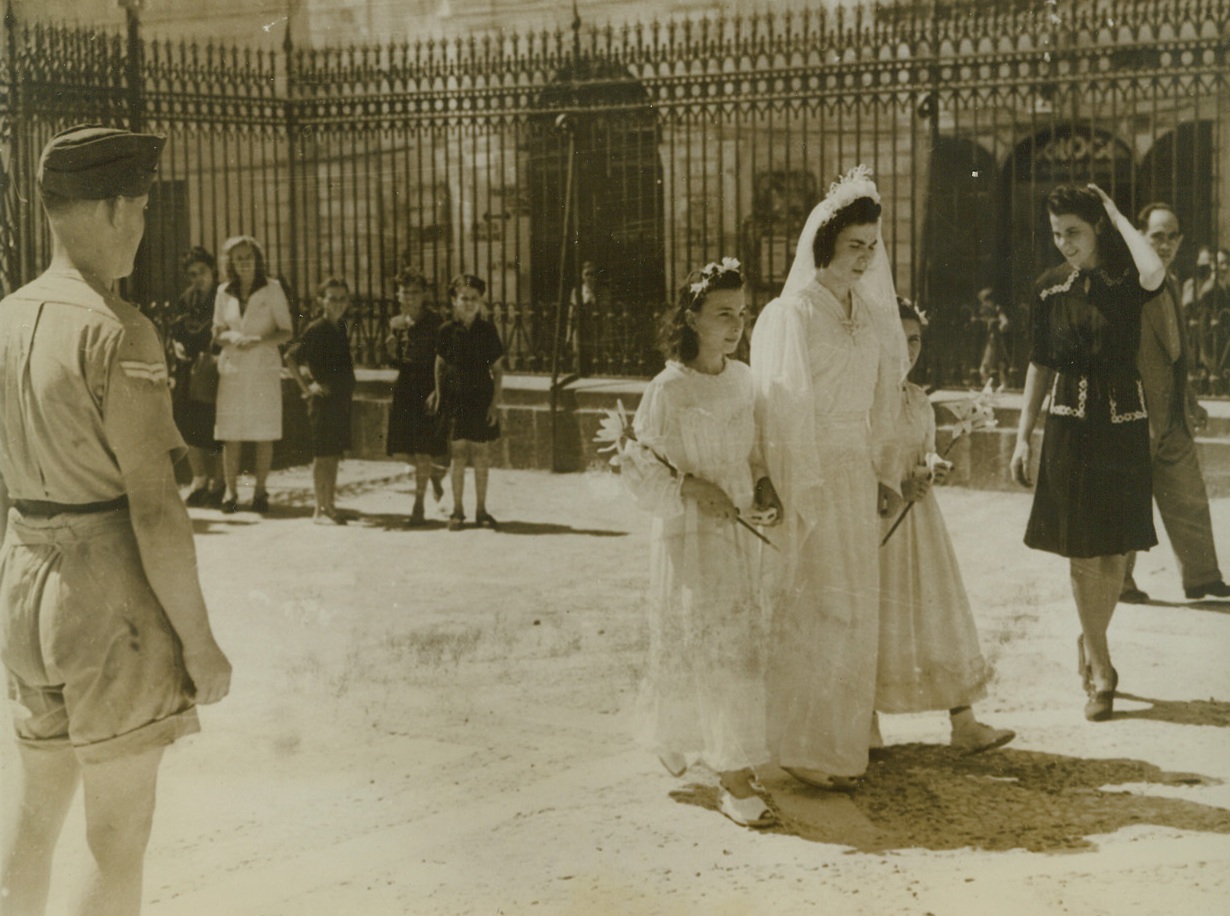
Here Comes a Peacetime Bride, 9/12/1943. Sicily – The war is over in Sicily, and a native bride arrives at the church with her attendants. The wedding in Lentini is watched by an R.A.F. driver, Corp. G. Hennah, of London. Life has resumed its normal flow in Sicilian towns occupied by the Allies, and civilians who fled the battle zones are back in their homes with their neighboring farms once again harvesting crops. Credit: ACME;
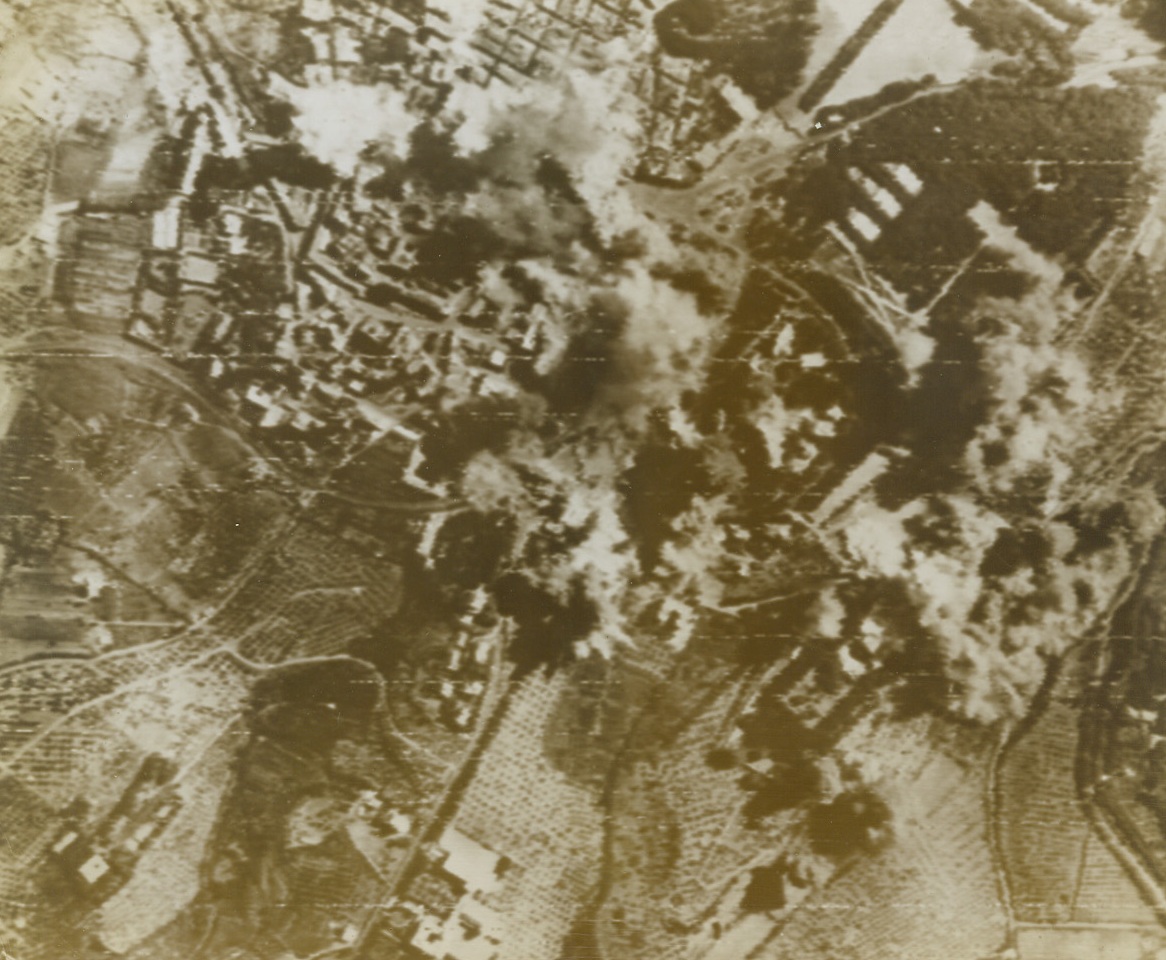
Smoking Out the Nazis, 9/12/1943. Italy – Bomb bursts blanket the town of Frascati, Italy, as Flying Fortresses of the Northwest African Air Forces destroy the German military headquarters located there. The furious September 8 raid followed the capitulation of Italy. Credit: AAF photo by Signal Corps Radiotelephoto from ACME;
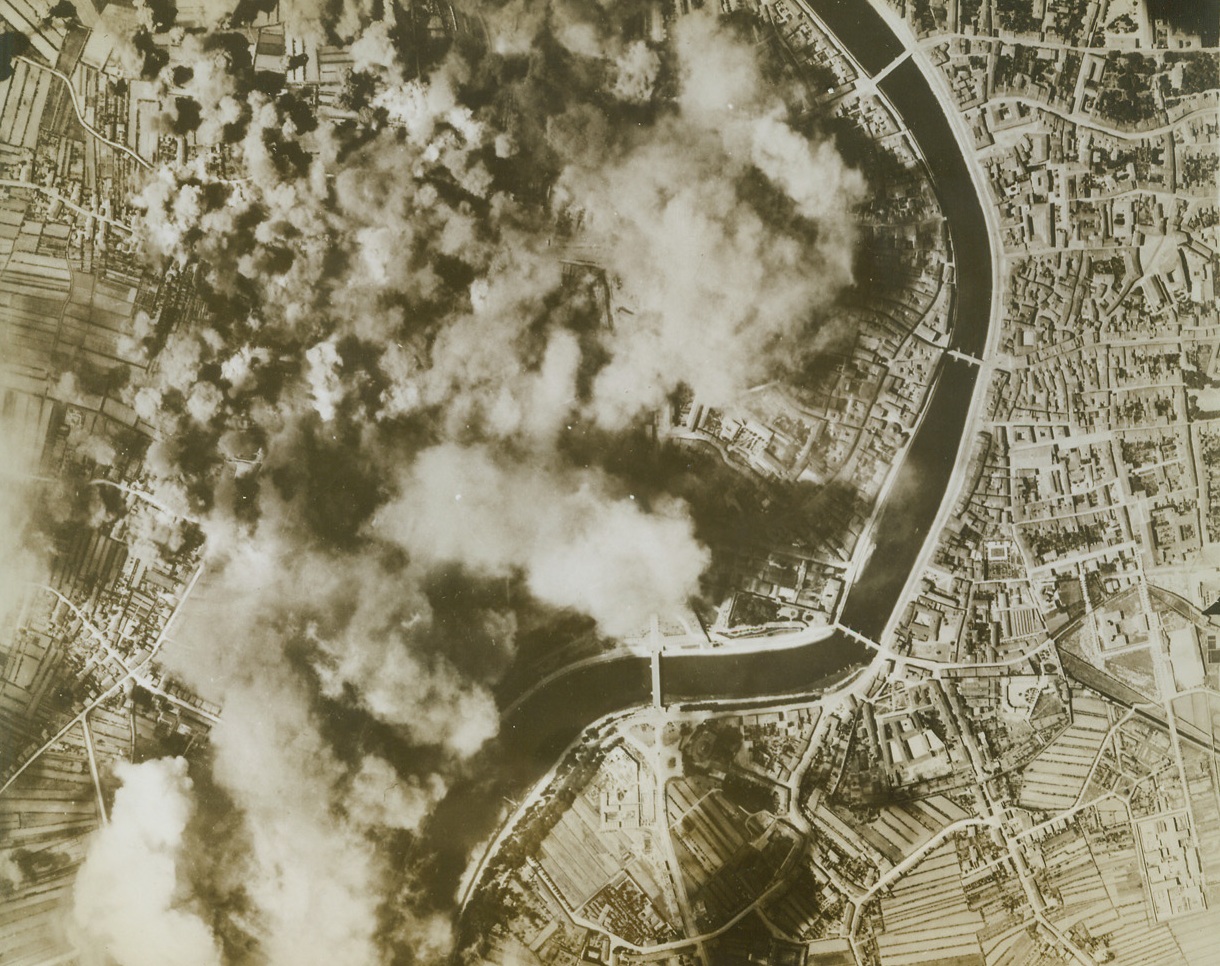
Two More Military Targets Picked Off, 9/12/1943. Italy – A double-track electrified railroad and the Piaggio Aircraft Factory in Pisa, Italy, get a load of bombs from U.S. Flying Fortresses. The River shown is the Arno, and the road and bridge at lower left of photo lead to the famous Leaning Tower of Pisa which was not disturbed. Credit: Army Air Forces photo from ACME;

We Destroy Link to Brenner Pass, 9/12/1943. American Flying Fortresses knock out the Bolzano Railroad Bridge in Northern Italy, the farthest-from-home point the North African based planes raided before the capitulation of the Axis nation. Bologna and Trente also were attacked by the B-17s on the same mission when the important link to the Brenner Pass was demolished. Credit: Army Air Forces photo from ACME;
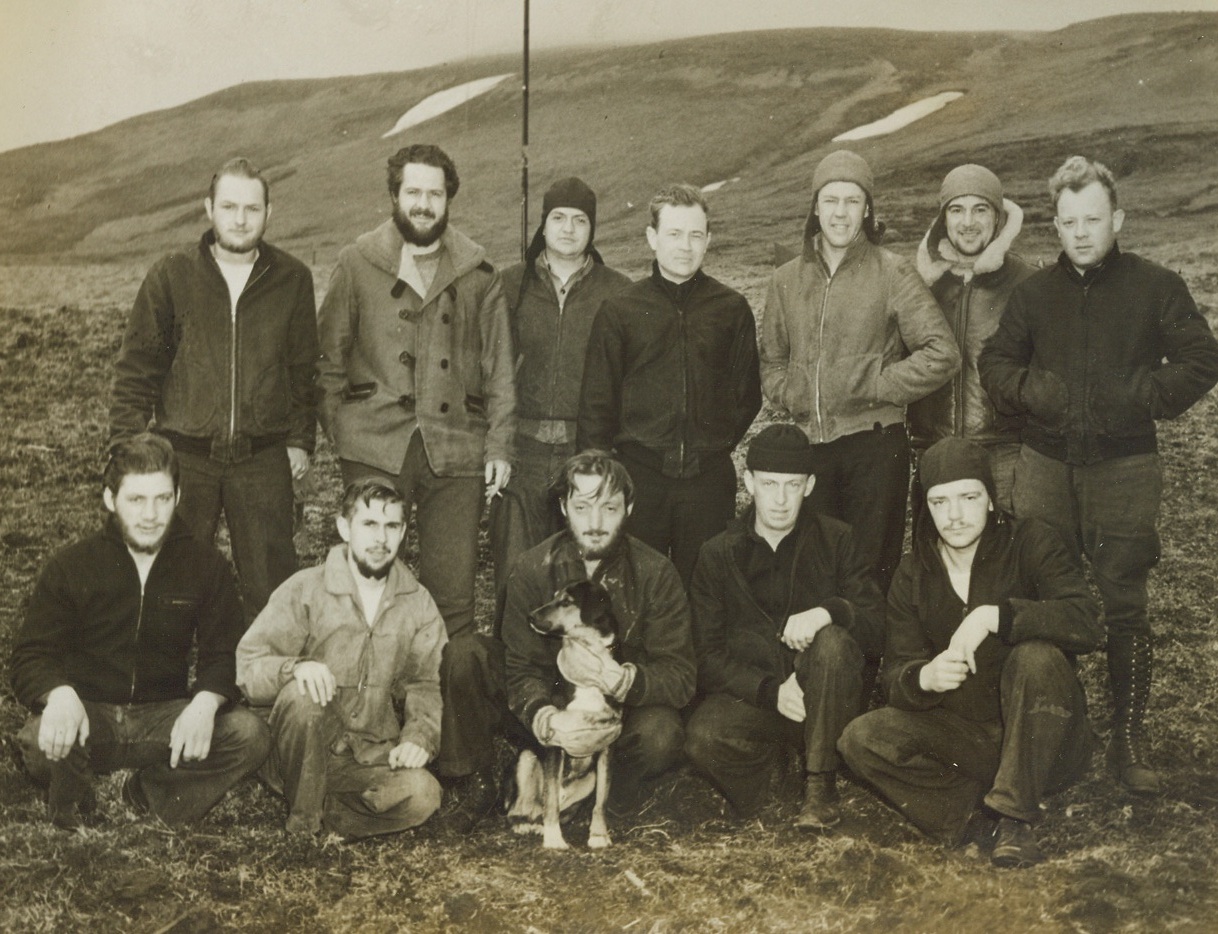
Ten of These U.S. Navy Men Are Jap Prisoners, 9/22/1943. In this photo, released today in Washington, twelve men of a U.S. Navy weather and radio station unit are shown in Kiska, where they were stationed before the Japs took the island. When U.S. forces recently recaptured Kiska, only the dog mascot was found. Two of the men in the picture were not on the island when it was captured by the Japs—the other ten are believed to be Jap prisoners. Left to right, front row: ship’s cook John C. McCandless, of Oakmont, PA.; radioman Robert Christensen, Bremerton, Wash.; aerographer’s mate Walter Monroe Winfrey, Cliffside Park, N.J.; seaman Gilbert F. Palmer, Evansville, Ind.; and Wilfred Ivan Gaffey, Coquille, Oregon. In the back row, left to right: aerographer’s mate James Leroy Turner, Seattle, Wash.; chief pharmacist’s mate Rolland L. Coffield, of Seattle, Wash.; aerographer’s mate William Charles House, Esconbito, Calif.; Lt. Mulla, (not captured); gunner’s mate LeThayer L. Eckles, Osborne, Kansas; photographer’s mate Lou Yaconelli, (not captured), North Hollywood, Calif.; radioman Madison L. Courtenay, Jr., of Riverhead, L.I., N.Y. (Passed by censors.) Credit: ACME;
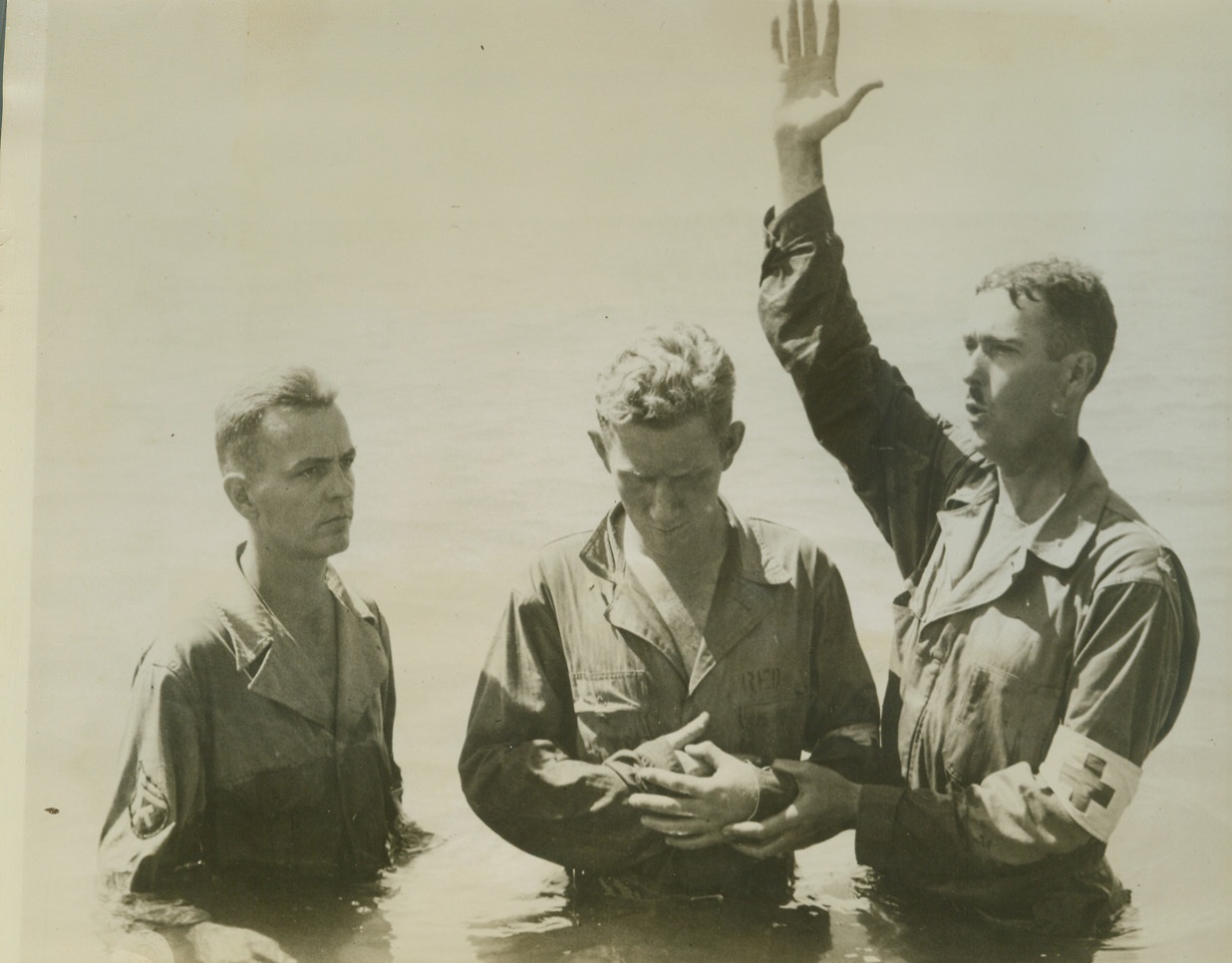
Americans Baptized in Mediterranean, 9/27/1943. SAN AGATA, SICILY -- This photo, taken on the occasion of the first baptism in the Mediterranean Sea conducted by Chaplain Harvey Floyd Bell, (right), from Greshamville, Ga., was taken off the north shore of Sicily 15 miles east of San Agata. Chaplain Bell, who is attached to an American infantry unit and who is of the Baptist-South Church, is shown baptizing Pvt. John Davis, (center), of Harrisonburg, Va. Credit: (U.S. Signal Corps Photo from ACME);

Time Out for Baseball, 9/24/1943. SOMEWHERE IN THE SOUTH PACIFIC -- In spite of tropical discomforts and the dangers of war, our Leathernecks always manage to find some time for a fast baseball game. Here, as the boys get ready for a game in a coconut grove, Marine Corps Chaplain, the Rev. Balthasar V. Schomer, of Council Bluffs, Ia., hands out equipment to (left to right) Sgt. Charles W. Speakman of Meadville, Pa.; Cpl. Albert G. Fissel, Newport, Ky.; Cpl. Edward S. Kowalski of Poughkeepsie, NY; and Tech. Sgt. Lawrence G. Fischer of New Orleans, La. Credit: (U.S. Marine Corps Photo From ACME);
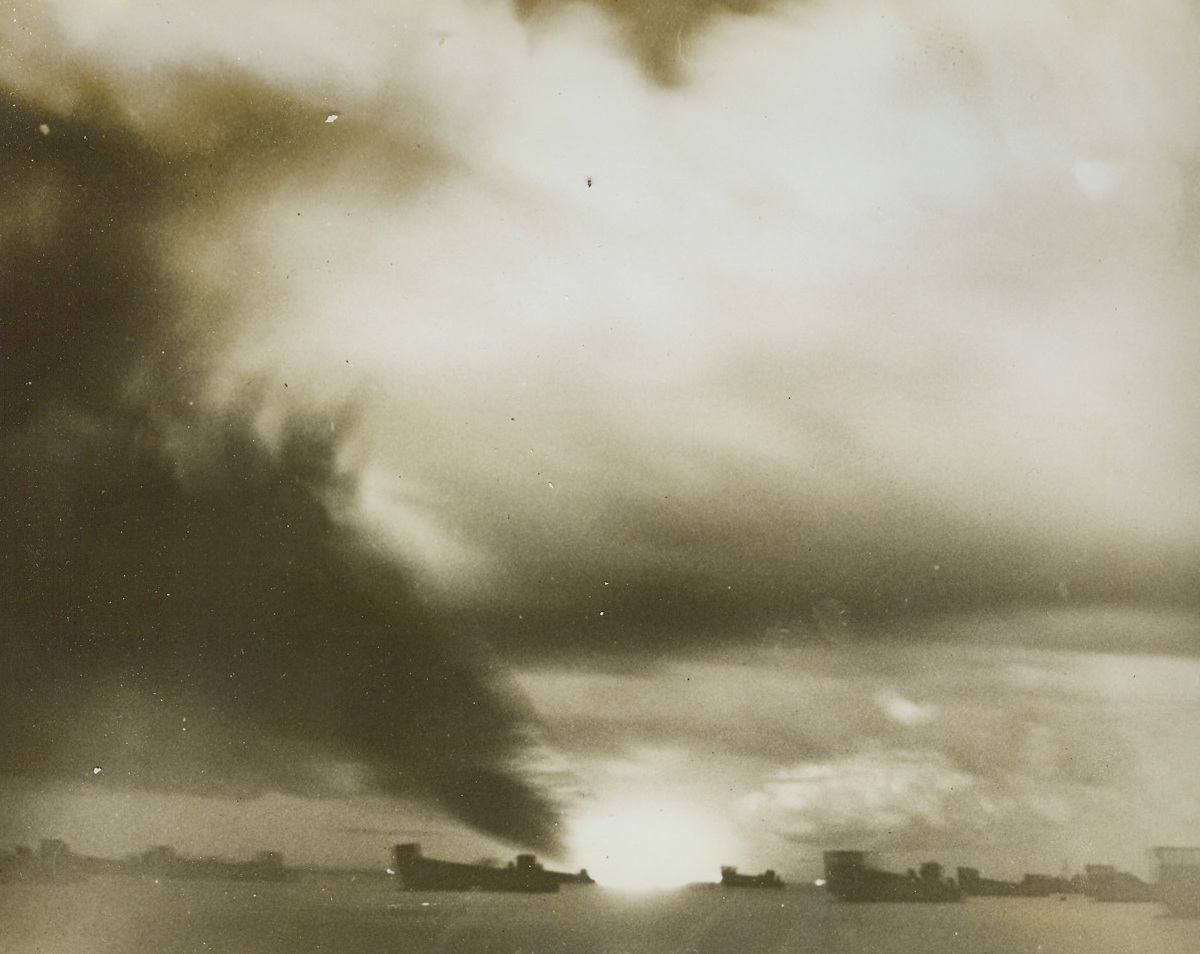
U.S. Transport Burns, 9/30/1943. GuadalcanalBurning fiercely after oil stores had been set aflame by an exploding torpedo, the U.S. Navy Transport John Penn casts a sunset-set like glow in the evening sky off Lunga Beach, Guadalcanal. The ship was hit by a Jap sneak attack by torpedo plane Aug 13th last, which came in low while a “Decoy” flight of Jap Bombers carried out a high-altitude attack. One of the decoys was shot down by a U.S. night fighter and the nip torpedo bomber was believed to have been shot down in flames by anti-aircraft fire. All troops and cargo had been removed before the attack on the John Penn, which sank within an hour.Credit: U.S. Marine Corps Photo from Acme.;
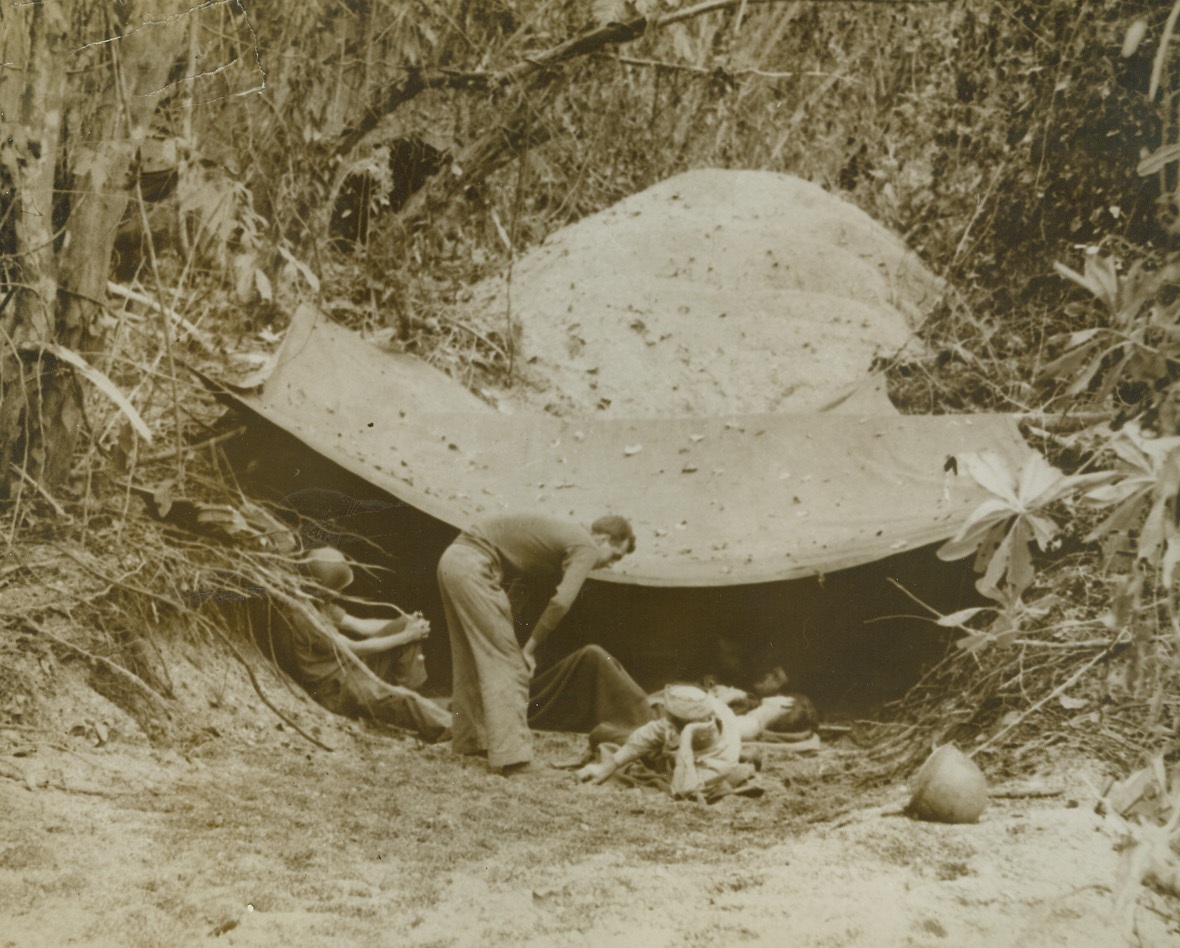
Protection From Further Wounds, 9/12/1943. New Guinea—While awaiting transportation to a hospital, American fighters wounded in the battle for Salamaua are placed in dugouts near the front. Corporal Paul Schofield, of New Bedford, Mass., bends over some of the victims who await the arrival of barges on a beach near the scene of fierce fighting.Credit Line (ACME);
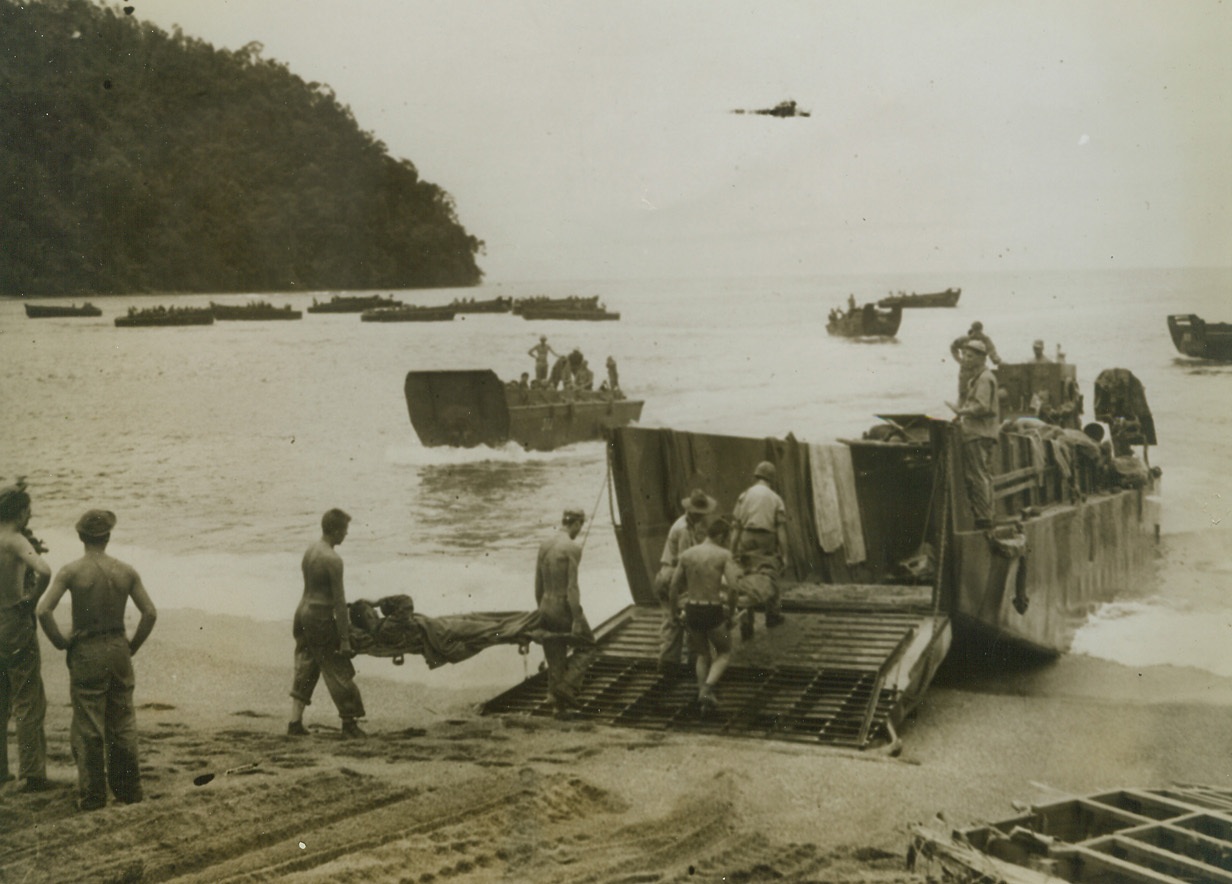
Victims of Jap Bullets, 9/12/1943. New Guinea – American soldiers who were wounded on the Salamaua front in New Guinea are loaded in barges on a nearby beach, and are on their way to a hospital. The announcement of the fall of the Jap stronghold at Salamaua is expected almost momentarily, and this photo shows part of the price of victory.Credit Line (ACME);
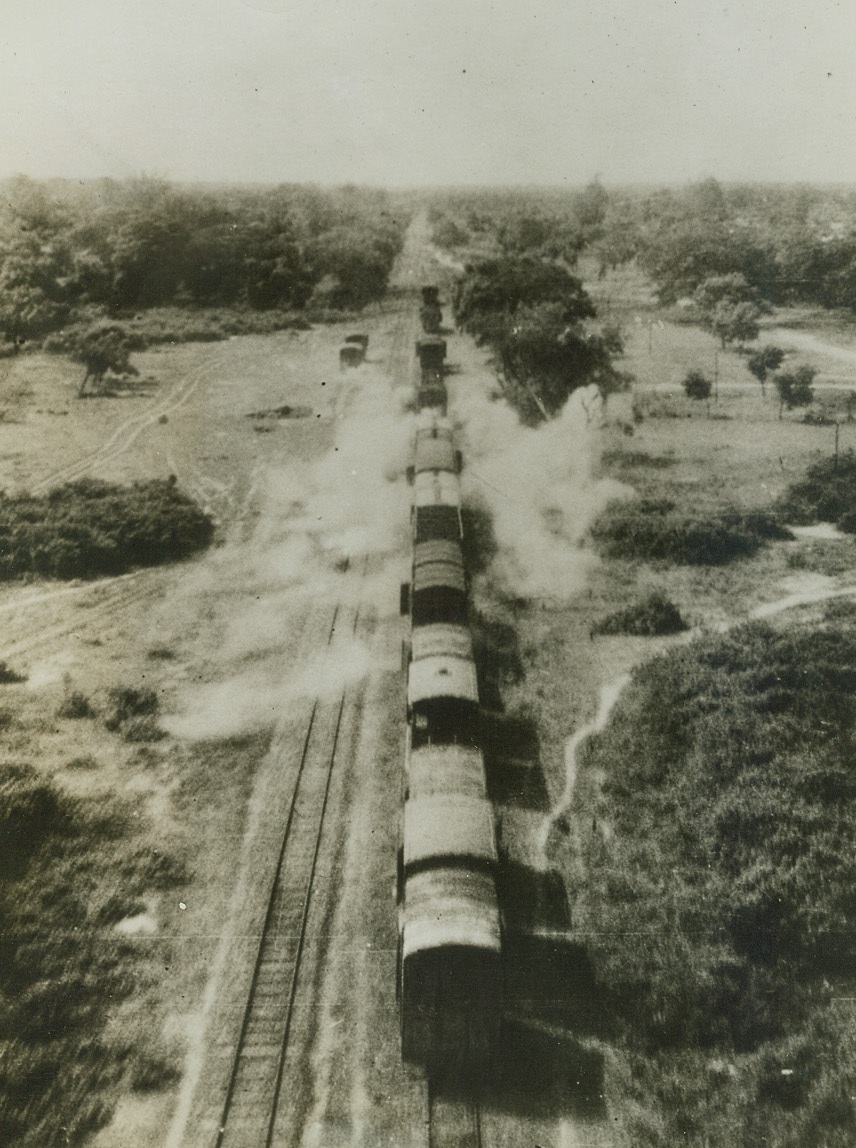
RAF Blasts Jap Freight in Burma, 9/10/1943. Burma – Freight cars, carrying cotton and ground nuts which are vital Japanese war materials, between Monywa and Sagaing, are blasted by raiding RAF Beaufighters. Striking with cannon and machine guns, the Beaufighters were detailed to attack this important Burmese railway line.Credit Line (ACME);
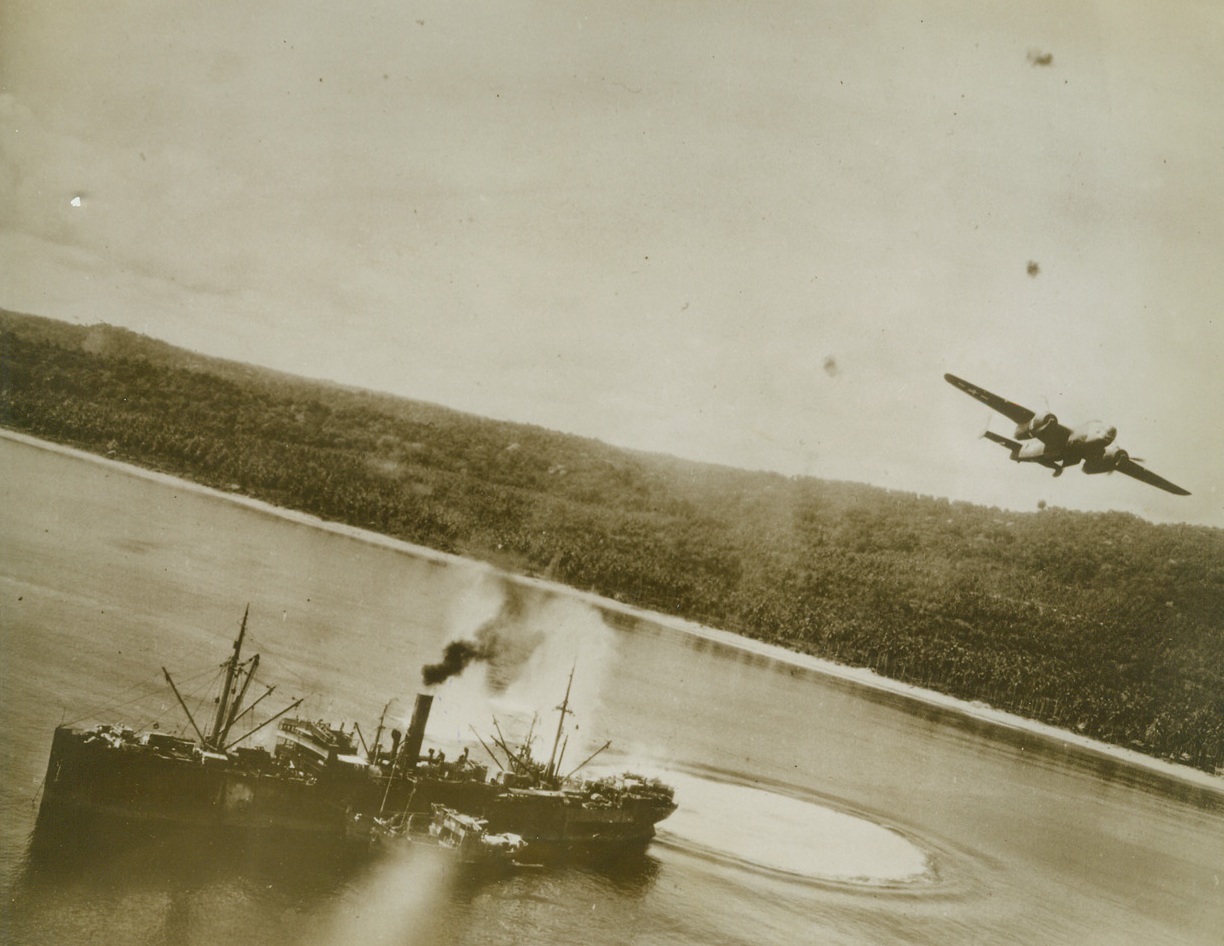
NEAR-MISS ON A NIP, 9/15/1943. This photo, just released by the War Department was taken from one of a group of U.S. Fifth Air Force bombers, during a recent low-level attack on Wewak Harbor, important supply base in New Guinea for Salamaua and Lae. Jap ship, (in foreground), has just been shaken by bombs exploding, (white circles astern), in the water. At the right, one of the Yank bombers, flying through the black puffs of heavy anti-aircraft fire, has just dropped its load of bombs. The small boats tied alongside the freighter are lighters. Today, Salamaua is in the hands of the Allies, who are only two miles from the center of the Jap base at Lae. Credit: U.S. ARMY AIR FORCES PHOTO FROM ACME.;
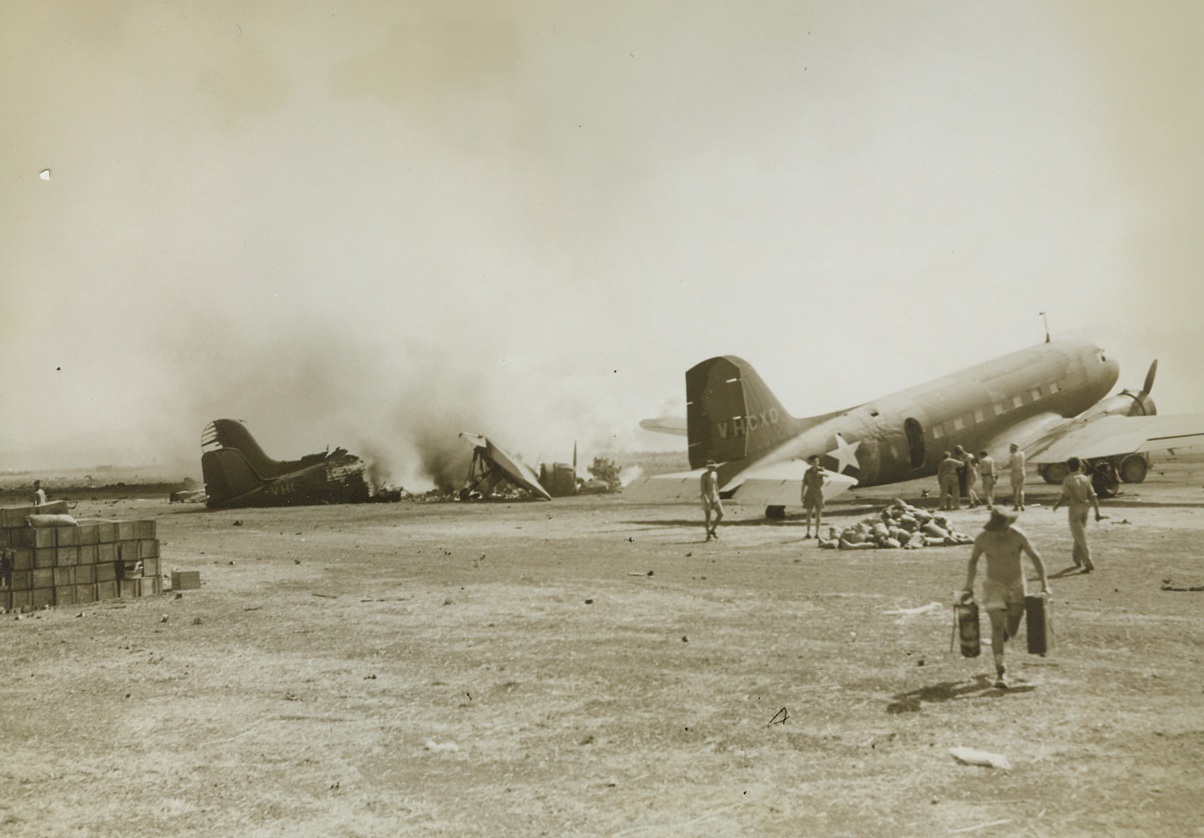
JAPS STRIKE FROM AIR, 9/14/1943. PORT MORESBY—A Jap bombing mission on the airport at Port Moresby, New Guinea, back in 1942 proved somewhat successful, jutting from the broken plane in background. While it burns unattended, ground men are fighting a fire inside the plane at right. The Australian soldier running toward the camera is carrying cans in which to get water. This picture has just been released by the War Department. Credit: ACME PHOTO BY FRANK PRIST, JR., CAMERAMAN FOR THE WAR POOL.;

FUTURE MEDICINE FOR THE JAPS, 9/14/1943. NEW GUINEA—Parts of these guns, weighing from 100 to 250 pounds, made a perilous journey over the precipitous Lababia Ridge from Nassau Bay. They are in an ammunition dump of a U.S. battery in New Guinea. Credit: ACME.;
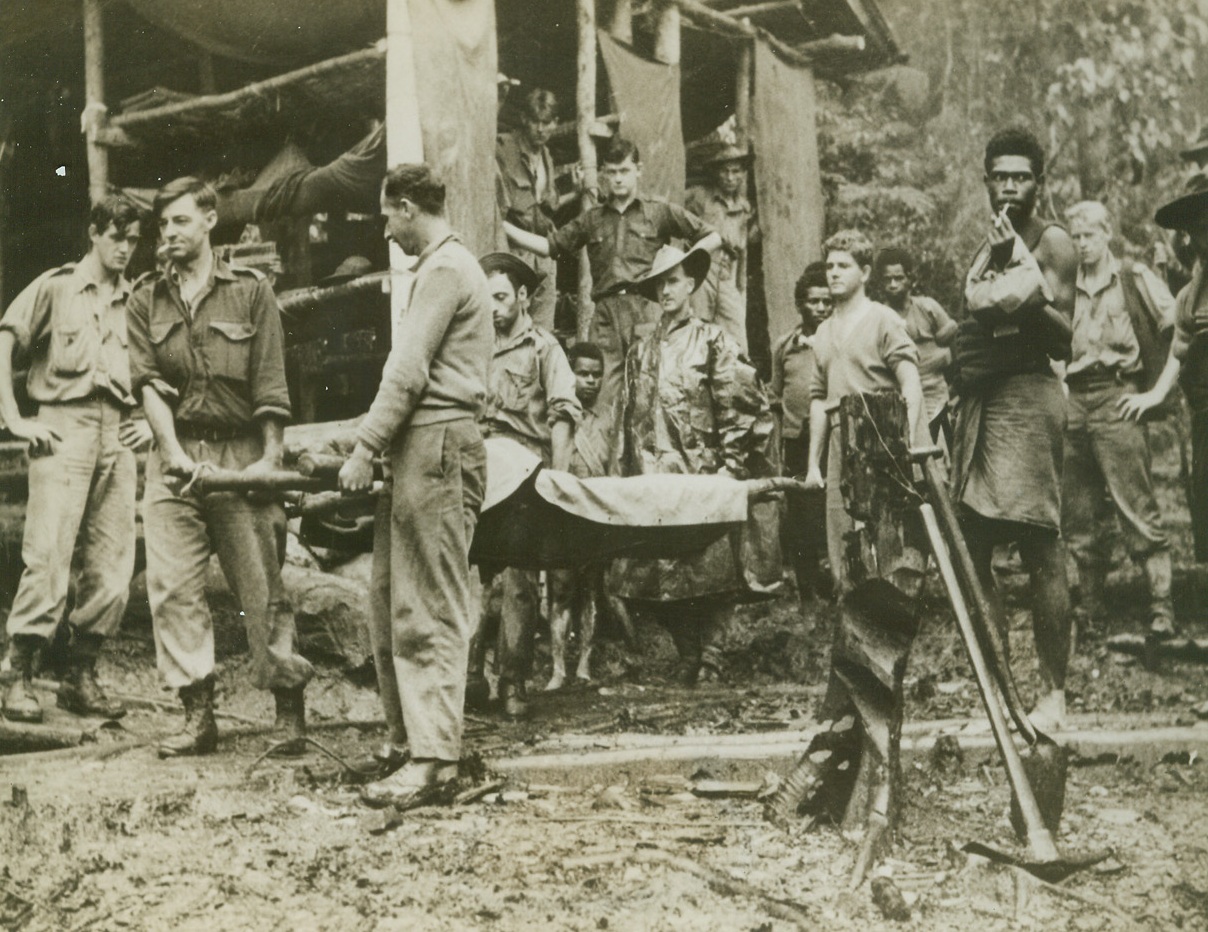
AMBULANCE AFOOT, 9/14/1943. New Guinea—A wounded American soldier is carried from the advance dressing station at House Banana, somewhere the New Guinea, before being turned over to natives who will shoulder the stretcher to the next day’s staging camp, a day’s walking distance away. This camp is on the track several thousands of feet up in the mountains of the Tambu area of New Guinea where there is a mist at some time each day. Here, the mean rest in tiered bunks and the walls are covered with blankets. Credit: ACME.;
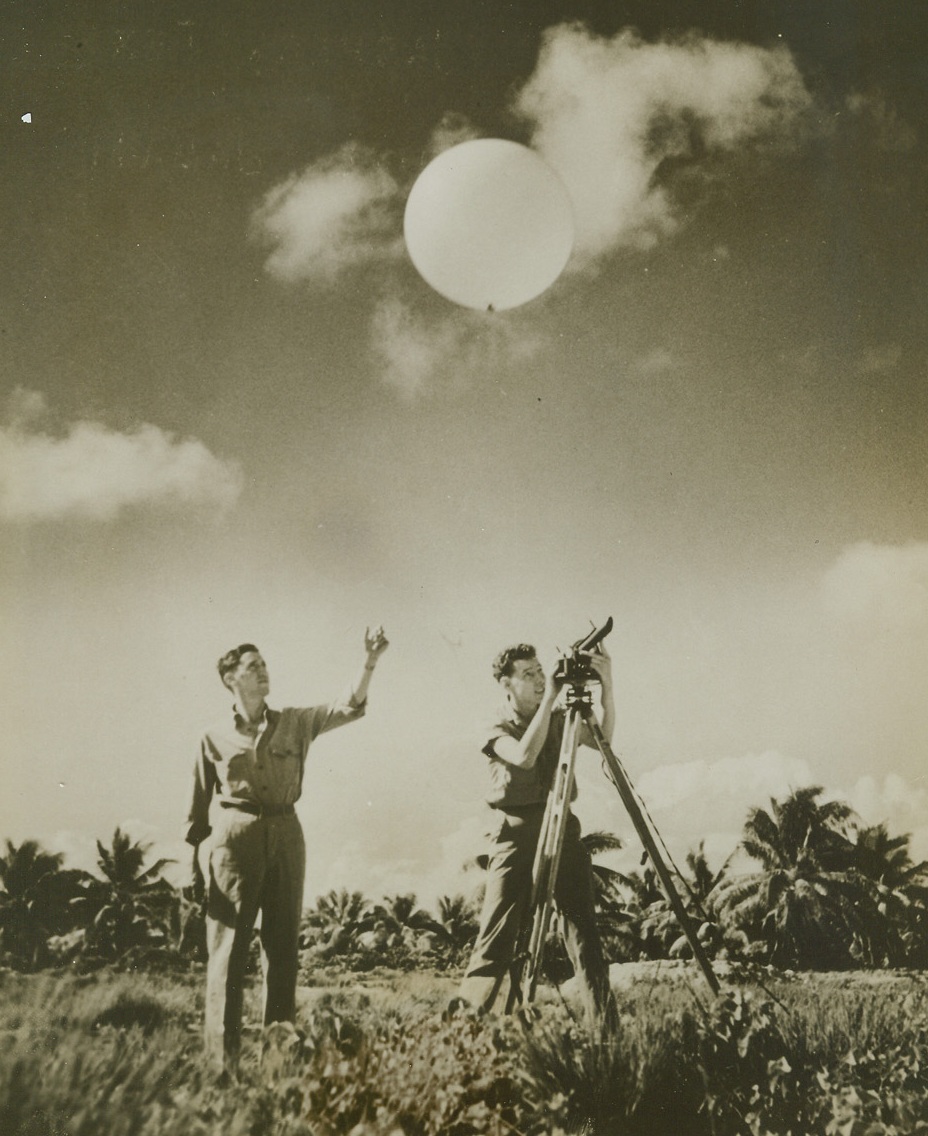
TESTING WINDS, 9/16/1943. CENTRAL PACIFIC—Two Seventh Air Force weathermen, stationed at an island air field in the Central Pacific, release a hydrogen-filled balloon to test winds. Sending the balloon aloft are: Cpl. William H. Allen (left) of Jasper, Texas, and Pfc. Howard C. Luke of Long Island, NY.Credit: ACME;

AFTER ALLIED TOOK REGGIO, 9/16/1943. This spot in Reggio Calabria, once a railway marshalling yard, has been converted to a rubble heap by heavy allied bombs and shells. In the background, the bombs have wrecked a concrete building. This photo, taken during the early stages of the Allied Invasion of the Italian mainland, has just reached the United States. Credit: ACME;
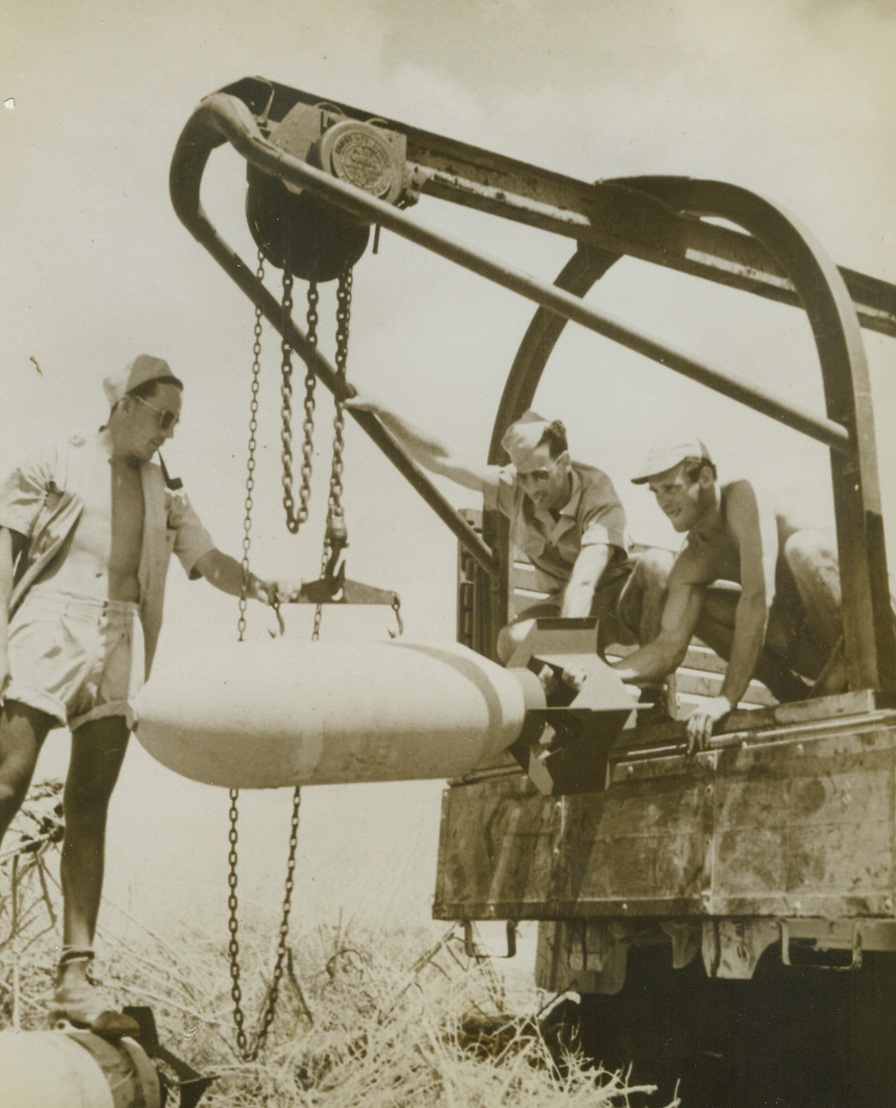
UP SHE GOES, 9/16/1943. IN THE CENTRAL PACIFIC—Three Air Force ordnance men load a 500-pound bomb into a truck at a Central Pacific base where personnel of the Seventh Army Air Foce are trained. Left to right: S/Sgt. Nicholas Karpinsky, Passaic, NJ; Pfc. Donald Arehart, Earlham, Ia.; and Sgt. Robert Cuinn, New York City. Credit: ACME.;
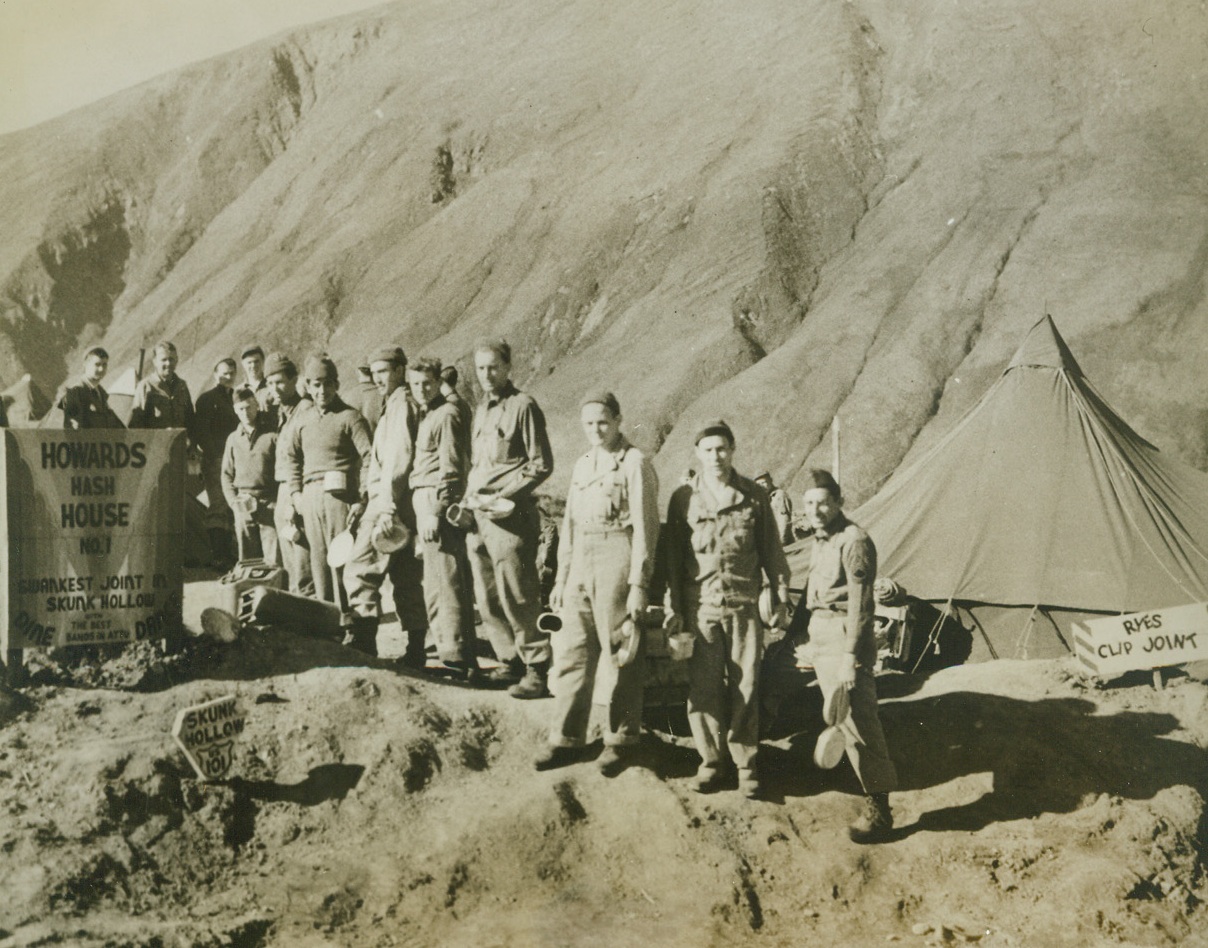
Swank Attu Eatery, 9/26/1943. Attu – Wherever American soldiers are stationed humorous signs are sure to pop up – and that’s a sure sign of good moral. Here a sign in front of the mess tent proclaims that it is “Howards Hash House No. 1, Swankest Joint in Skunk Hollow – Dine, Dance with the best bands in Attu.” The barbershop is named “Rye’s Clip Joint” and an official-looking sign lets you know that Skunk Hollow is on U.S. 101. This is one of the first pictures to show in detail operations of U.S. troops on Attu since last May when we drove the Japs out of the island that is more than halfway across the Pacific toward Tokyo. Credit: Official US Army Engineers photo from ACME;
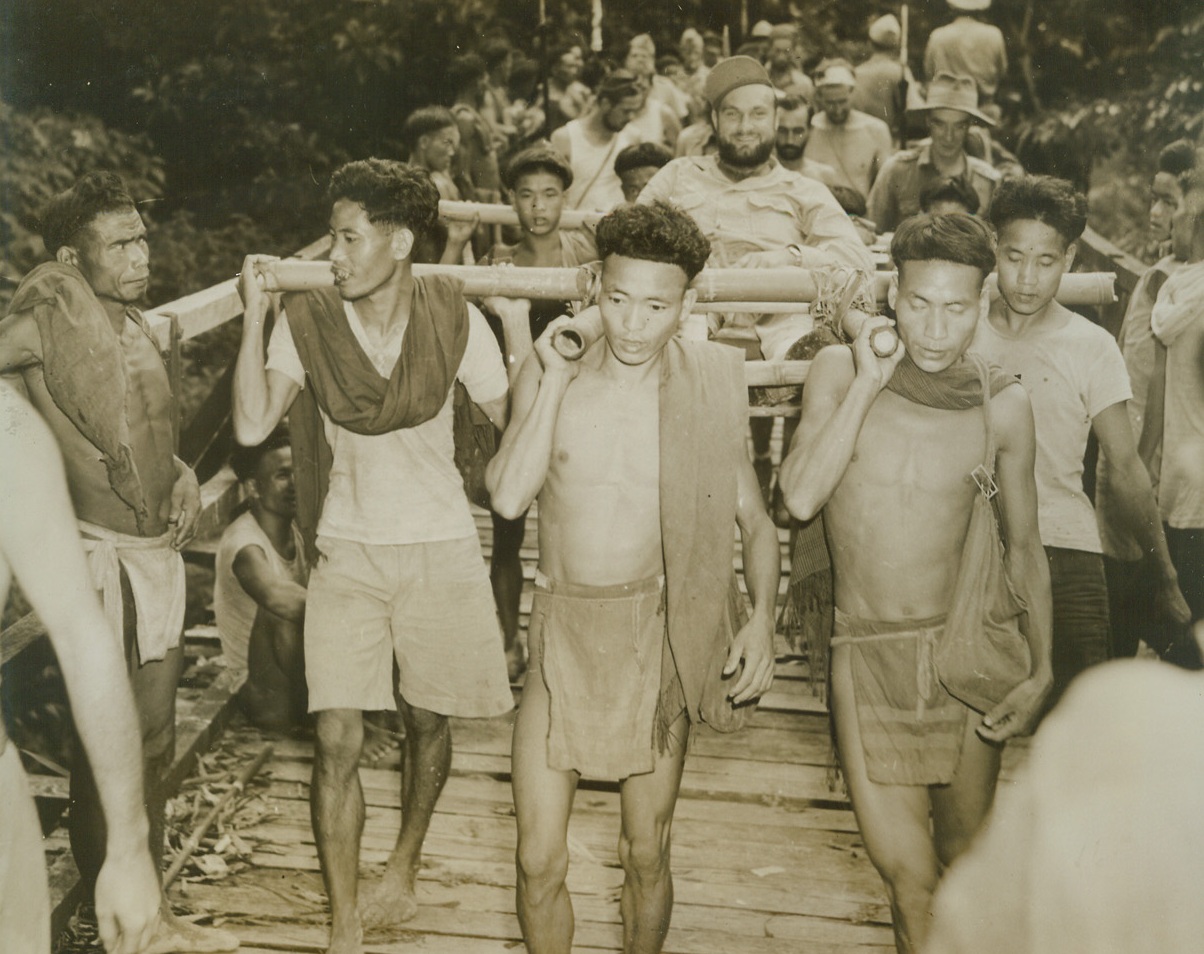
Plane Crash Party Cracks Jungle, 9/28/1943. India: - Almost a month had passed before survivor of an ATC plane crash in Northern Burma broke out of the jungle to a post in India. Sgt. Walter R. Oswalt, Ansonia, Ohio, who was radio operator on ill-fated plane, is carried by natives on a primitive stretcher since he broke his leg while parachuting to Earth. Other members of the planes complement bring up the rear with rescuers, who came both by air and over land. Only the plane’s co-pilot died in the accident, all others parachuting safely to Earth when the ship developed engine trouble on a flight from China to India. Credit (photo by Frank Cancellare, photographer for the War Pool from ACME);
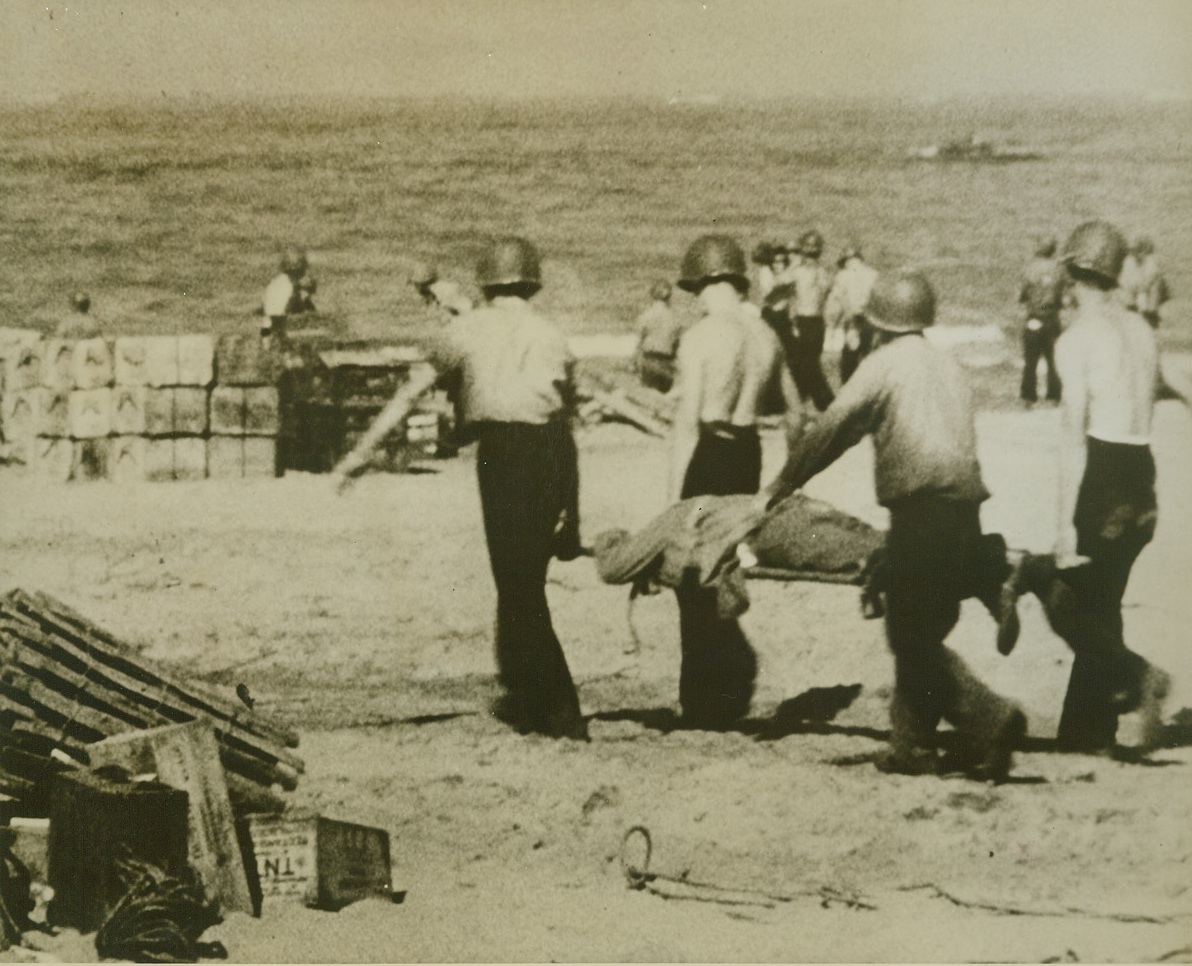
Return From Battle, 9/30/1943. Salerno – Returning from the battle of Salerno, this American fighting man travels across the beach to a waiting transport by stretcher. The casualty was brought to a hospital by the same coast guard manned boat that brought supplies in background. He was one of approximately 12,000 Yanks wounded, killed or missing in action during July 10th and Sept. 15th. Credit line (U.S. Coast Guard photo from ACME);

Army Nurses on the New Burma Road, 9/28/1943. Assam, India – Two U.S. Army nurses, Bernice Taylor, (left), of White cloud, Kansas, and Nancy Cooke, of Merion, Pa., have the new Burma road (nicknamed the “Tokyo road”), explained to them by a Chinese officer who supervises Chinese troops working on the new stretch of the road in central Burma after allied offensives have cleared the Japs from that sector. Work on the project, which began last December, is being done under the direction of U.S. Army Engineers. Credit line (ACME);
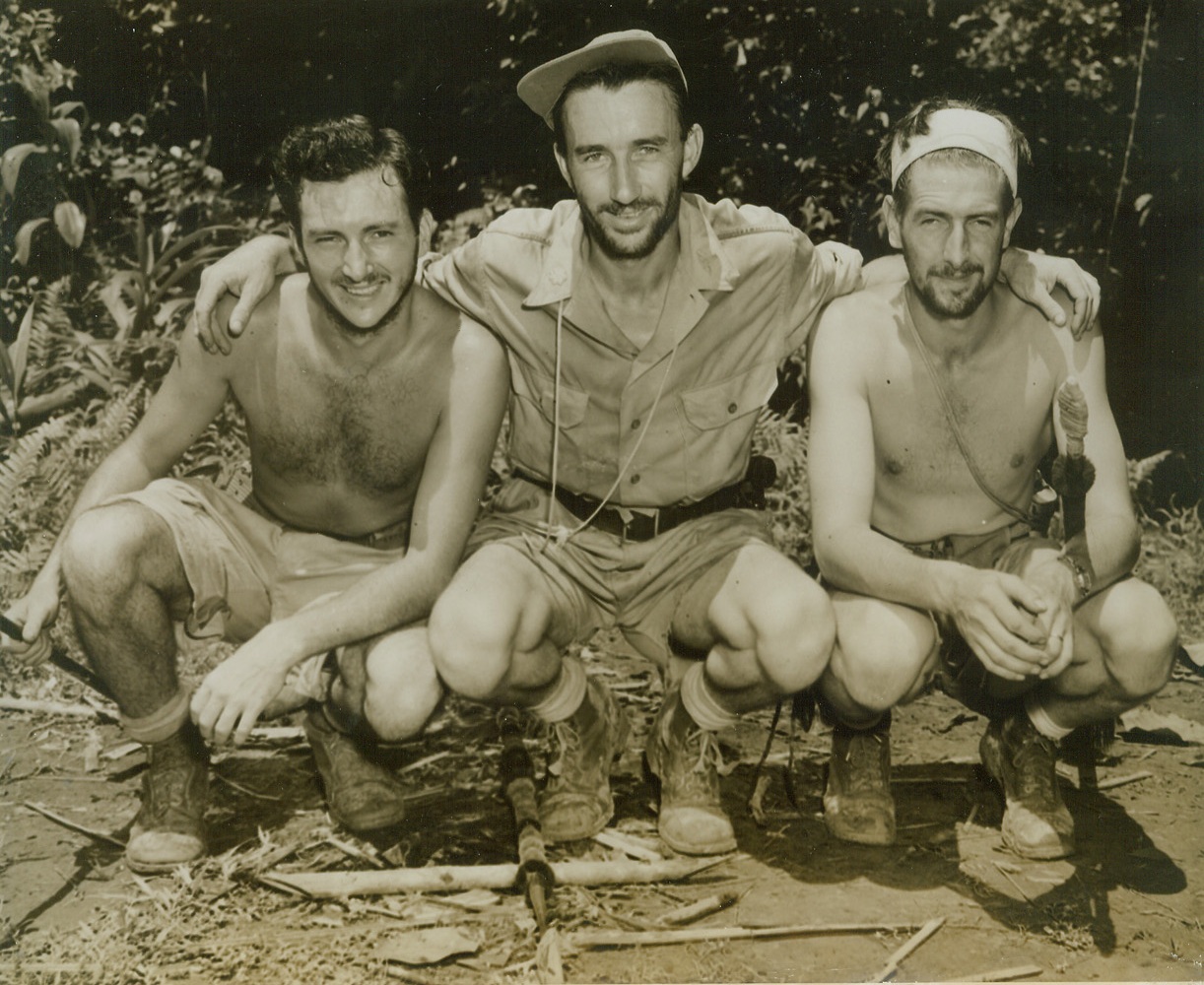
Title Illegible, 9/28/1943. India: - …aides Sgt. Richard Passey (left), Provo, Utah and Cpl. William G. McKenzie, Detroit, Mich., parachuted from a rescue plane to aid the survivors of the ATC plane crash in Northern Burma. The party faced no land before reaching safety again. Credit (photo by Frank Cancellare, War Pool photographer, from ACME);
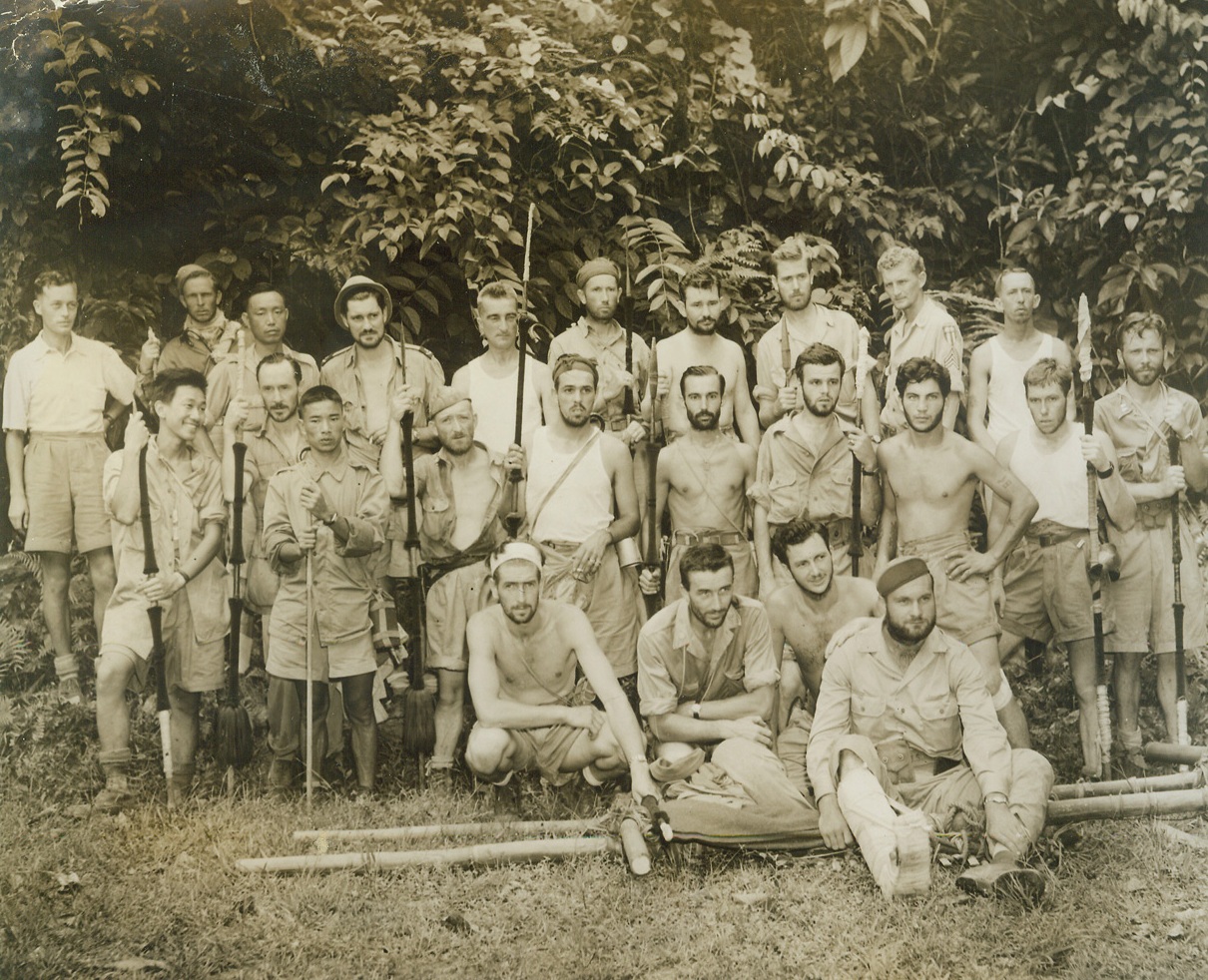
Out of the Jungle, 9/28/1943. India: - The twenty survivors of an ATC plane which crashed in Northern Burma, who participated in a dramatic mass parachute jump to safety when the ship developed engine trouble, August 2, while en route to China from India, are shown with members of a parachuting rescue party upon reaching the safety of India once again. The complement marched 26 days through dense jungle growth in an area laden with head-hunters. Left to right, back row: Philip Adams, British sub divisional officer, of ground rescue party; Sgt. E. Wilder, Levelland, Tex.; Col. Wang Pao Chao, Chinese officer; Eric Sevareid, CBS news commentator; William T. Stanton, of Board of Economic Warfare; Sgt. Joseph E. Clay, Monticello, Ia.; Cpl. Basil M. Lemon, Tulsa, Okla.; Sgt. Glen A. Kittleson, Ballantine, Mont.; Sgt. Francis W. Signor, Yonkers, N.Y., and Cpl. Lloyd J. Sherrill, Burlington, Ia. Middle row:- Lt. Roland K. Lee, Hicksville, Long Island, N.Y.; Lt. Col. Kweh Li, Chinese Army; John Davies, of State Department; Sgt. Ned C. Miller (crew chief), Ottumwa, Ia.; Flight officer Harry K. Neveu, pilot of the ship, Cudahy, Wisc.; Sgt. Joseph J. Gigore, Auburn, Mich., (first name etc is illegible) Schrandt, Philadelphia, Pa.; Cpl. Edward Holland, Cleveland, Ohio; Cpt. S. Waterbury, Blue Hill, Nebr.; Capt. D.C. Lee, Haddon, Ia., of adjutant General’s office. Kneeling, Sgt. Richard Passey, Provo, Utah, Lt. Col. Don D. Flickinger, ATC flight surgeon, and Cpl. William G. McKenzie, Detroit, Mich., the trio who jumped from rescue plane to aid crash victims. In front on stretcher is Sgt. Walter R. Oswalt (radio operator), of Ansonia, Ohio, who broke a leg when he parachuted from stricken plane. He was carried for 26 days by natives before reaching civilization. Credit (photo by Frank Cancellare, War Pool photographer, from ACME;

Practice Mercy Under Fire, 9/2/1943. New Georgia – Two fighting Marine Chaplains, both Catholic priests, Lieutenant Paul J. Redmond, of New Haven, Conn. (left), and Lieut. Comdr. John P. Murphy, of Chicago (right) went into action on the front lines with the Marines as they drove the Japs out of their garrisons at Enogai point New Georgia. The two chaplains who frequently were targets for enemy snipers are shown with Col. Harry B. Liversedge, of Pine Grove, Cal., commanding officer. After risking their lives to assist the raiders in reaching wounded, both later again faced death to go inside Jap lines to bury Marine dead. Father Redmond is a former professor at Catholic University, Washington, D.C., and at Providence College, R.I. Credit (U.S. Marine Corps photo from ACME);
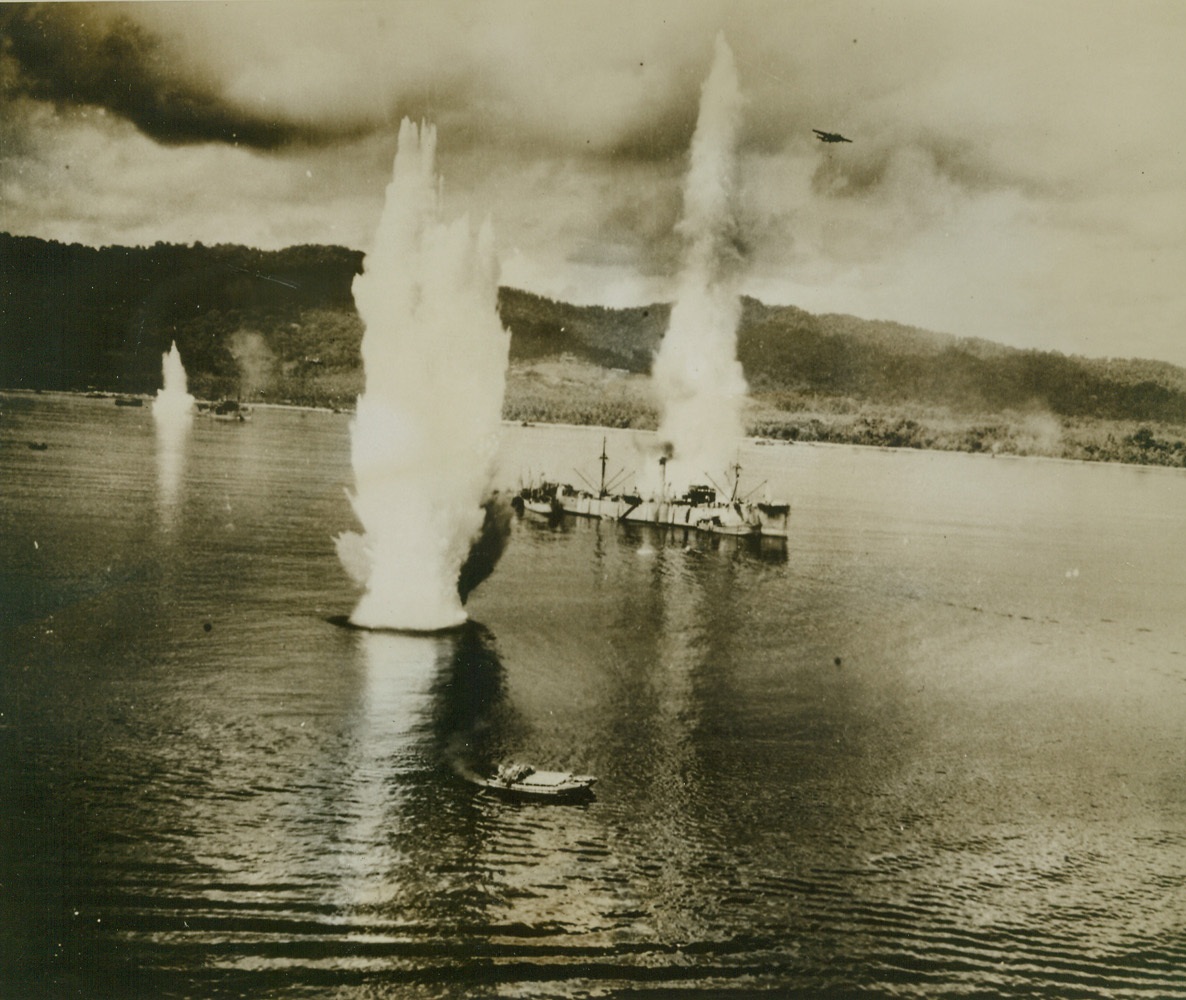
Yank “Eggs” for Nip Ships, 9/15/1943. This photo, just release by the War department, shows giant geysers from exploding American bombs near Japanese ships anchored in Wewak Harbor during a recent low altitude attack by U.S. bombers, (one can be seen, top right), on the important New Guinea supply base for Lae and Salamaua. The small lighter, (foreground), tries to zigzag out of harm’s way. Today, the allies are in possession of Salamaua and are within two miles of the center of Lae. Credit line U.S. Army Air Forces photo from ACME;
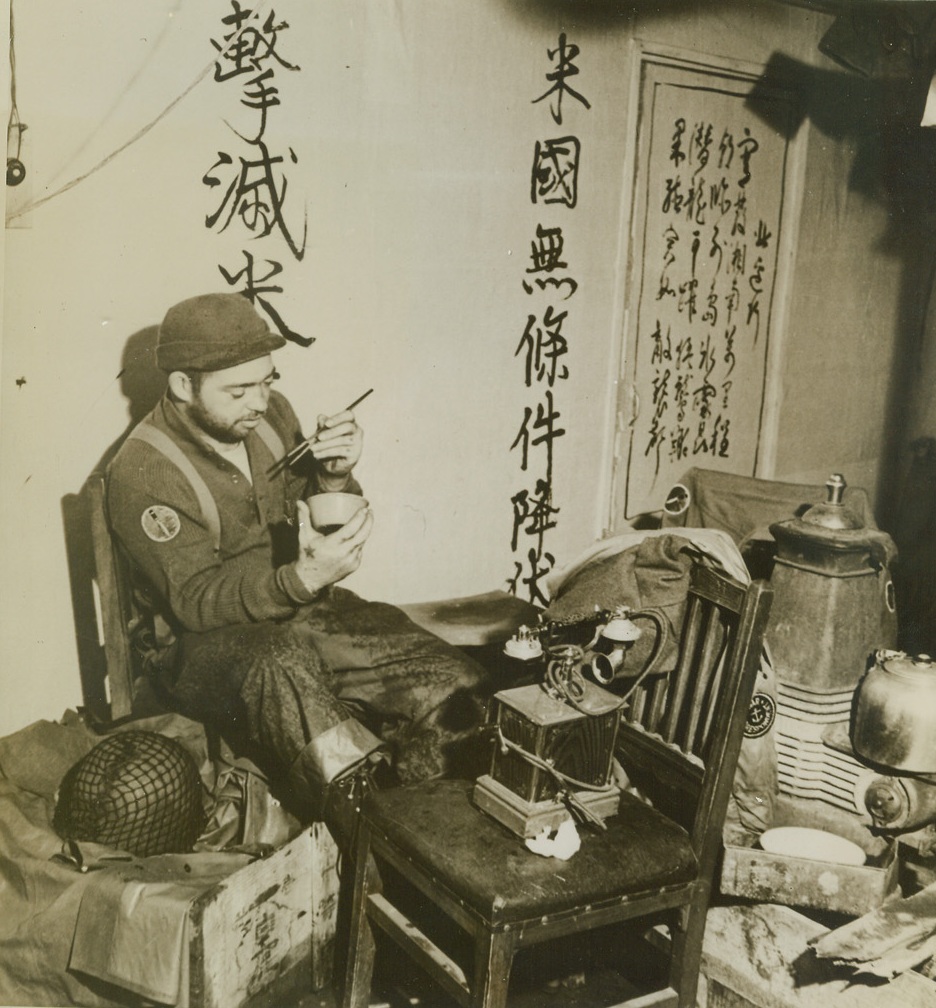
The Rice They Left Behind, 9/4/1943. Kiska -- The rice left behind when the Japs fled the island of Kiska makes a tasty titbit for S/Sgt. Edmond A. Birdsell of San Francisco, Calif. Sitting in a shed cluttered with all kinds of equipment, the Yank samples the oriental food, using the enemy’s chopsticks. Credit line –WP—(ACME);
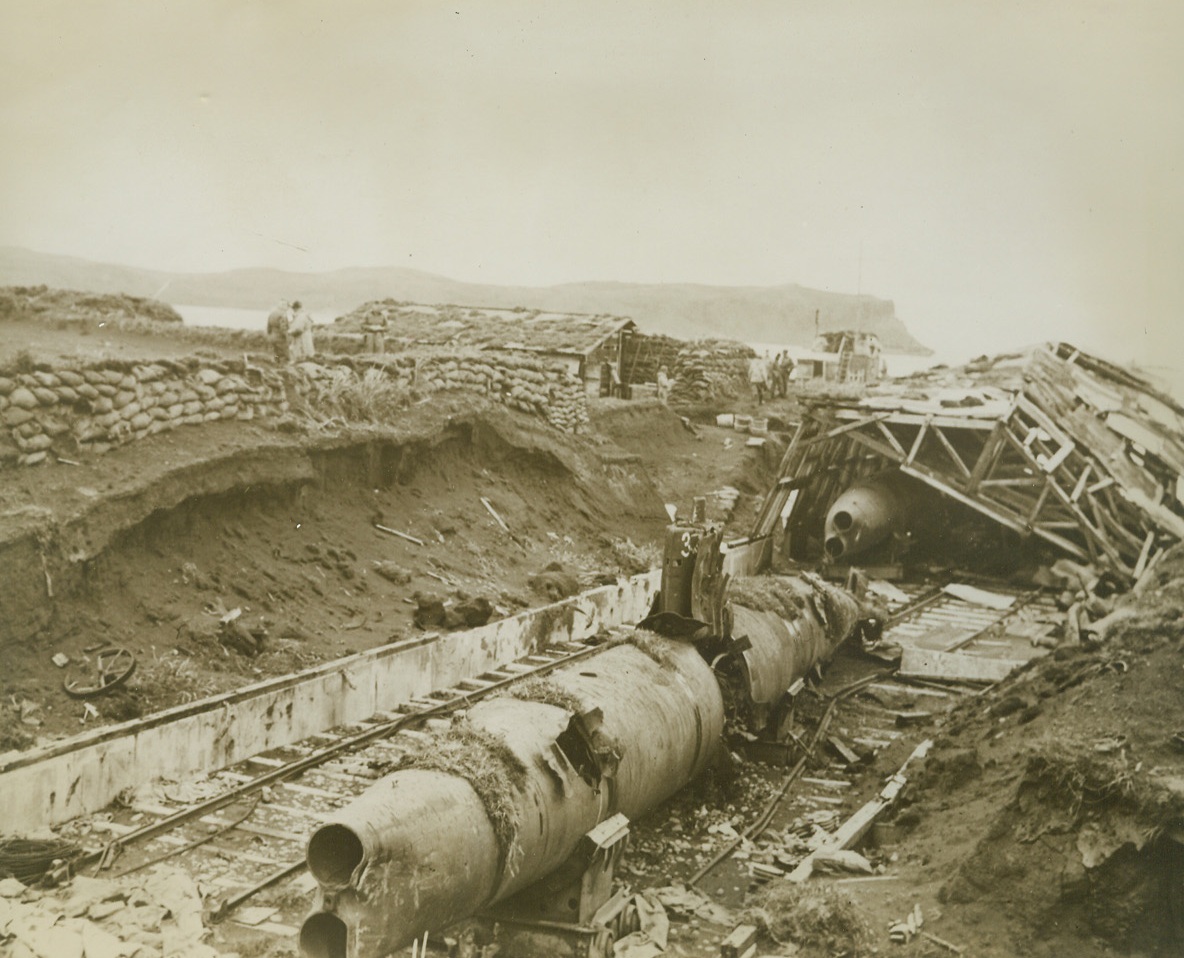
Scuttled Subs, 9/4/1943. Kiska – Evidently scuttled by their Jap owners as they fled Kiska, these wrecked. Miniature subs were found by the allies when our troops took possession of the island. This demolished submarine shed was about a mile from the former Japanese camp. Credit line—WP—(ACME);
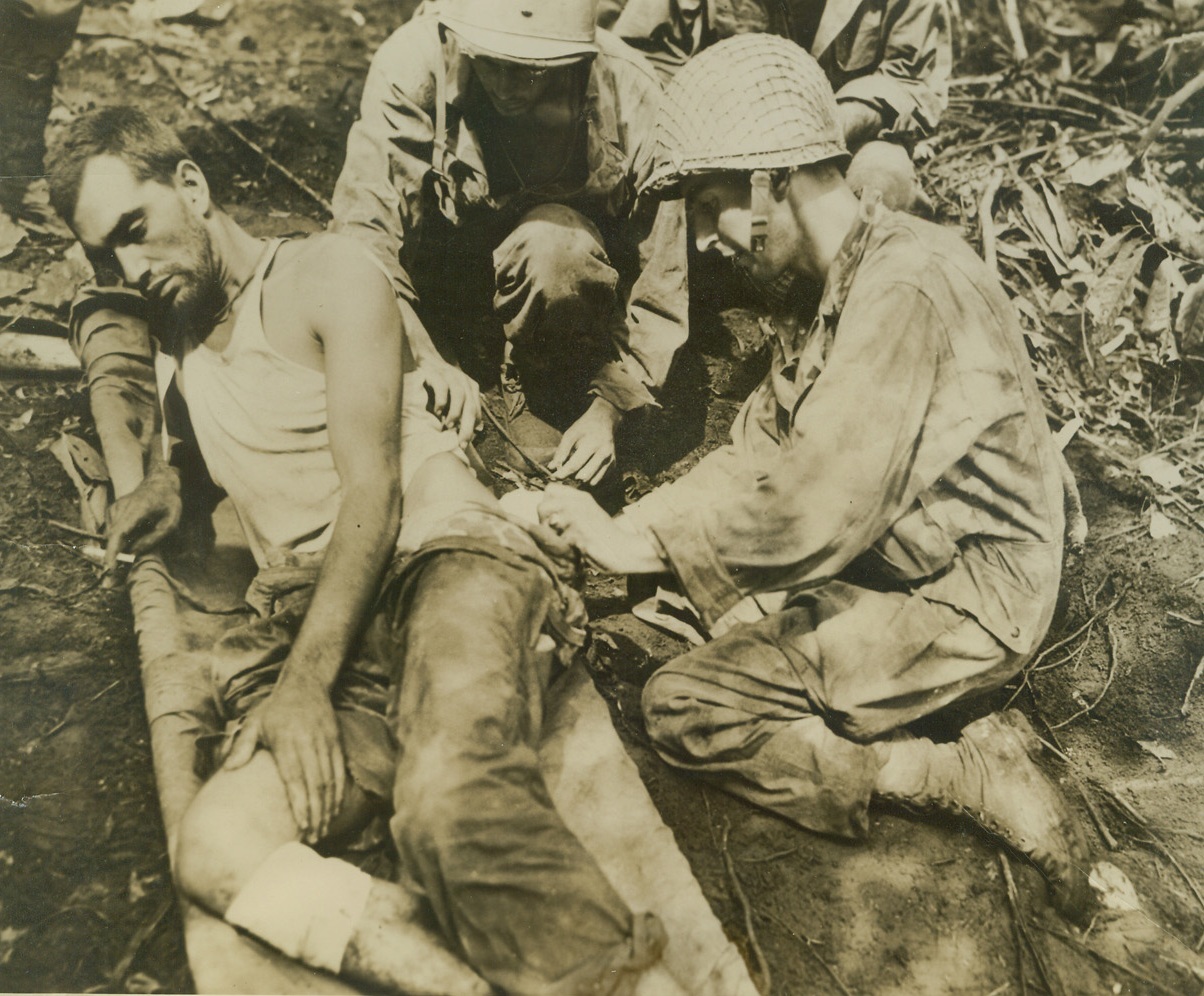
Jungle First Aid, 9/21/1943. New Georgia Island – Wounded by a grenade, Pvt. Anthony Sorice (left), is taped up by his brother-in-law, Joseph Alderuccio, (right). Both men are from New Britain, Conn., and are members of the same infantry unit on New Georgia Island. Alderuccio and five others carried Sorice a mile through the jungle before reaching a jeep trail, where they put in on a jeep for evacuation to the rear, after the Japs were driven out in bloody fighting at Munda Point, only isolated pockets of resistance remain. Credit line (U.S. Signal Corps photo from ACME);
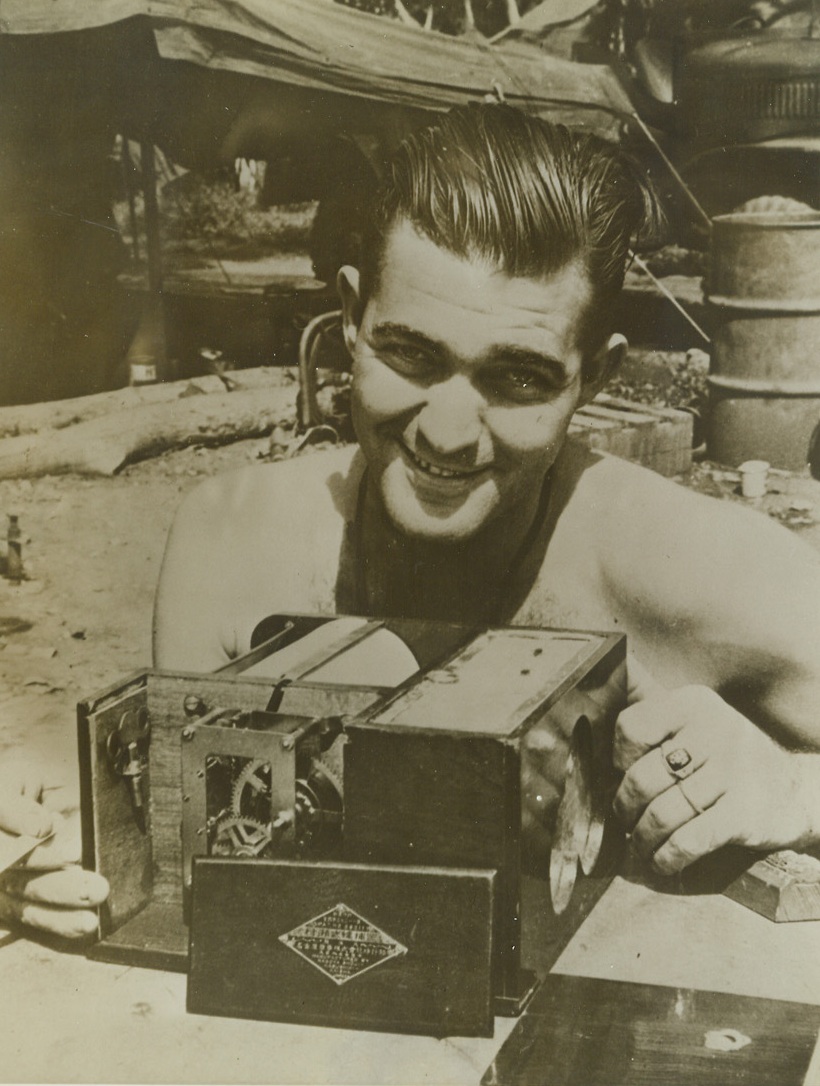
Just What the Dodgers Ordered, 9/19/1943. New Georgia Island—Here’s the gadget that the Brooklyn Dodgers have been looking for an automatic fly catcher. Marine raider Tommy Dougan, of Memphis, Tenn; , picked up the Jap-manufactured Thingamajig when the Yanks moved into Bairoko, New Georgia. A cylinder, motivated by clockwork, slowly rotates and imprisons flies, attracted by honey or syrup, in an escape-proof screened chamber. Credit line (ACME);
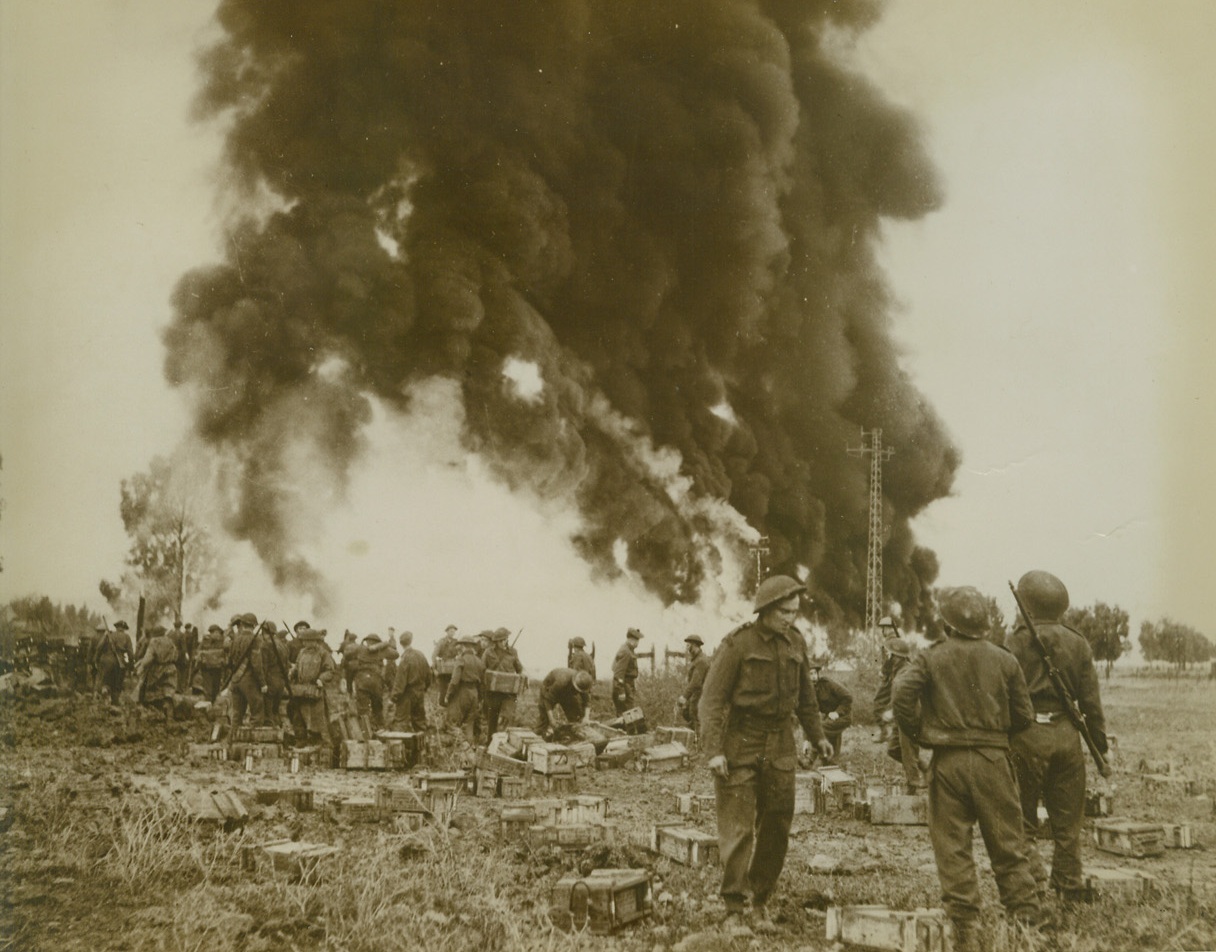
Flaming Backdrop, 9/15/1943. Tunis – With the smoke and flame of fires started by the Luftwaffe forming a backdrop, British soldiers speedily remove equipment from a bombed zone in Tunis. Although this photo was made nearly a year ago, it has just been released by censors.Credit line – WP – (ACME);
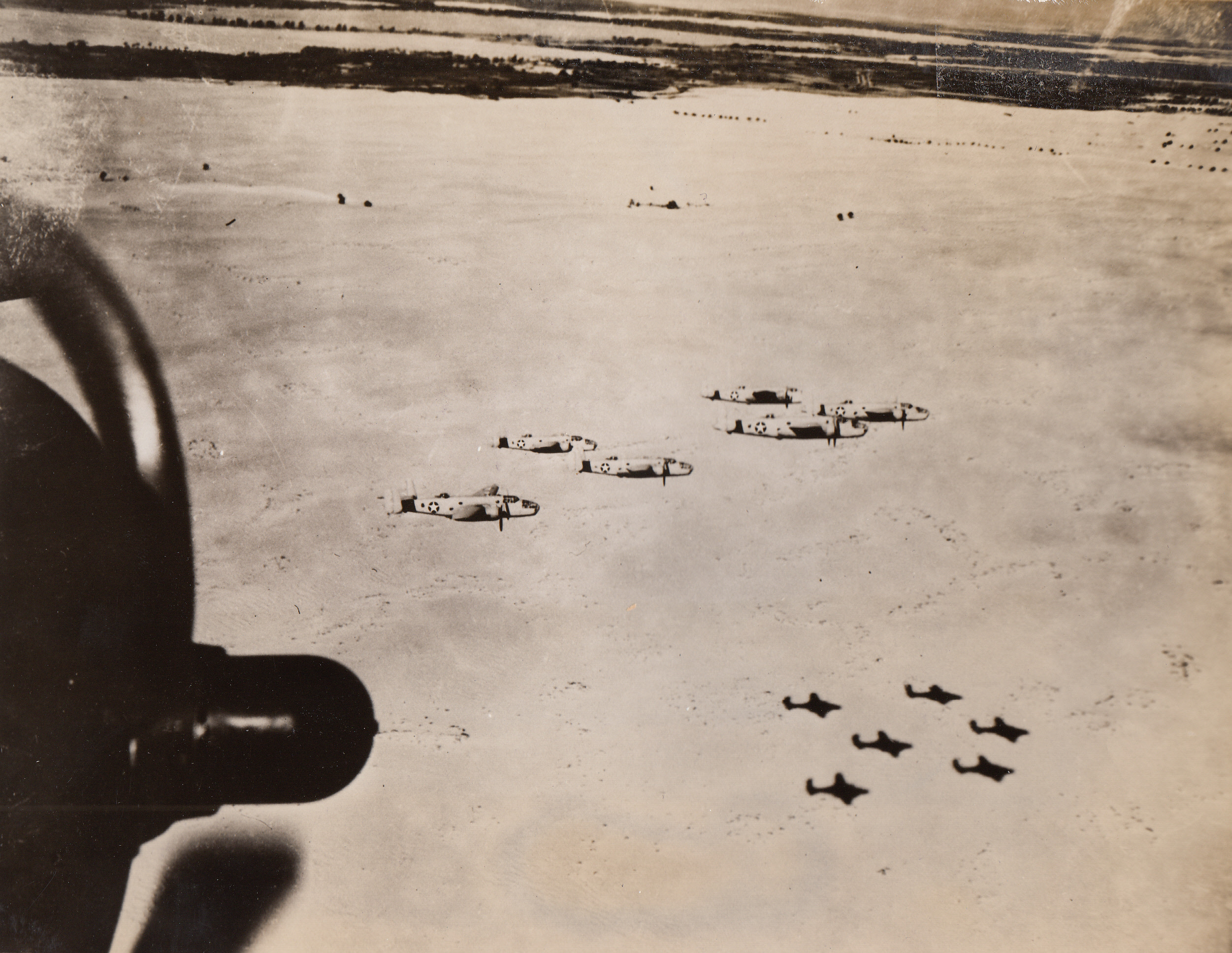
American Planes Over African Desert, 9/12/1943. Middle East – Medium bombers of the U.S. Army Air Force fly in formation over the bleak desert in the Middle East, where they are harrying the supply lines and bases of the axis. The planes are camouflaged so as to blend with the color of the desert, but there is no way of erasing the sharp shadows.;
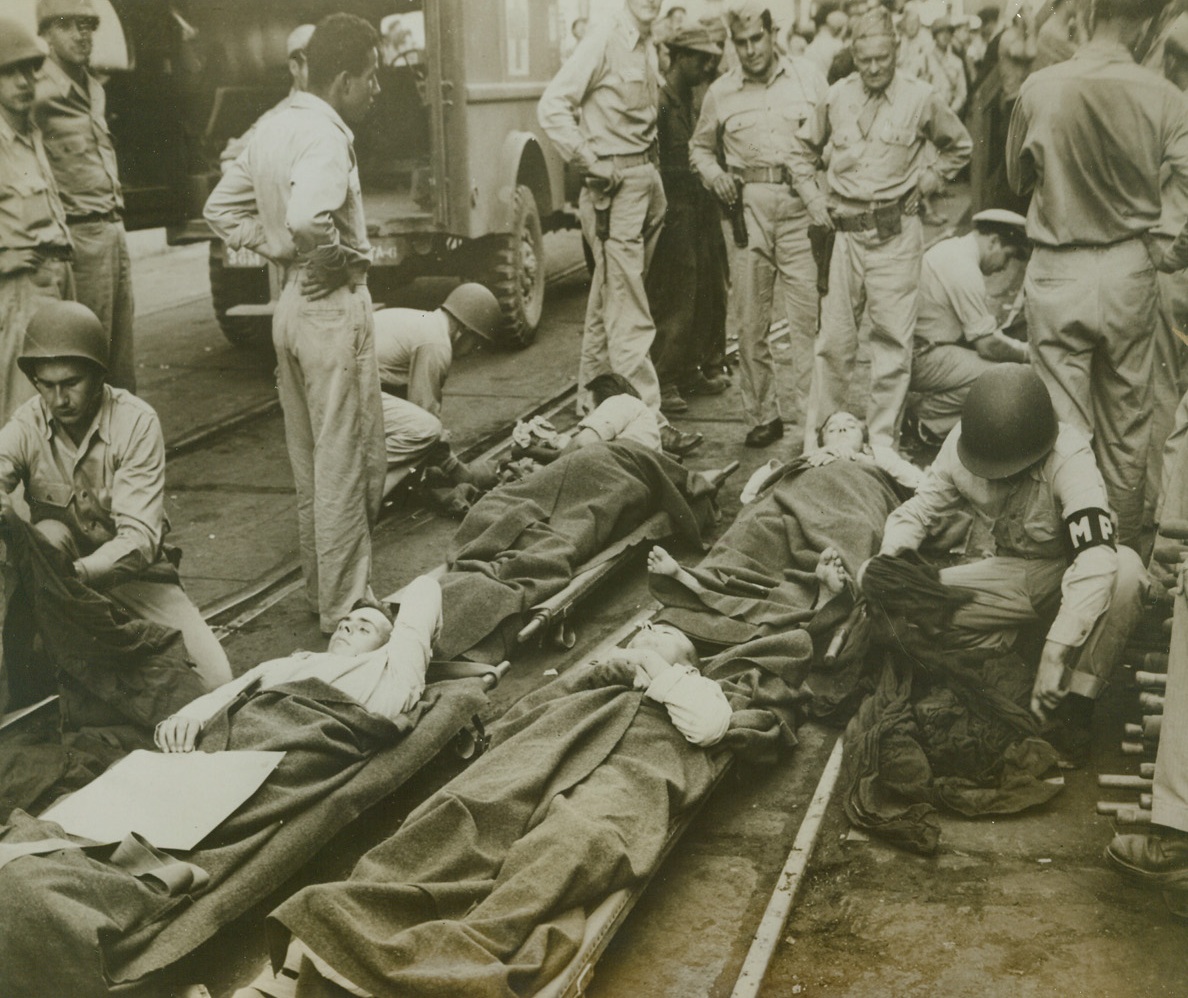
Nazis Head for U.S. – As Prisoners, 9/22/1943. Casablanca, French Morocco – Four wounded Germans captured by U.S. Army troops in the Northwest African Theatre, lie quietly on their litters as M.P.S check through their luggage, on this dock in Casablanca Harbor. Shortly after photo was taken, the Germans were put aboard ship for America. Credit line (U.S. Army Signal Corps photo from ACME);
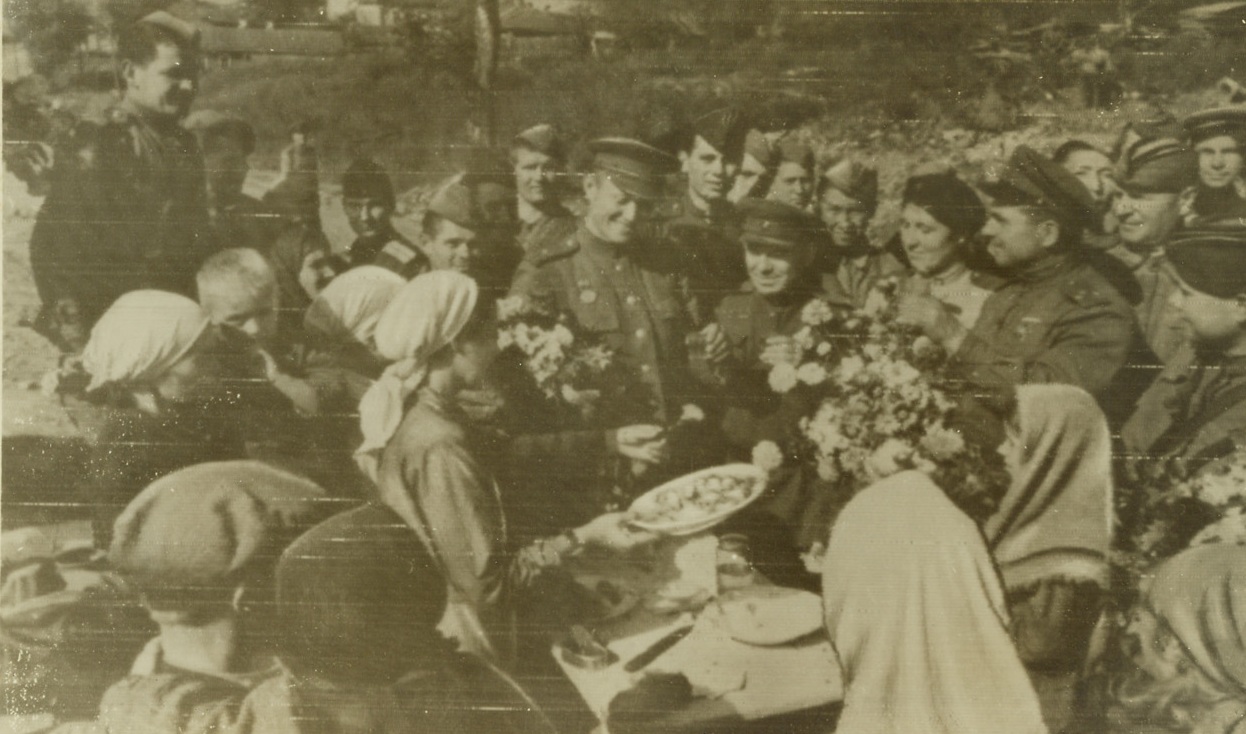
Freed From the Nazi Yoke, 9/19/1943. Bryansk, Russia—Soviet fighters who helped drive the Germans from Bryansk are treated to food and flowers by overjoyed Russian women who have been under the rule of the Nazis since October, 1941. The fall of the strong hedgehog defense of the German line was one of the most spectacular triumphs of the German defensive. Credit: ACME radiophoto.;
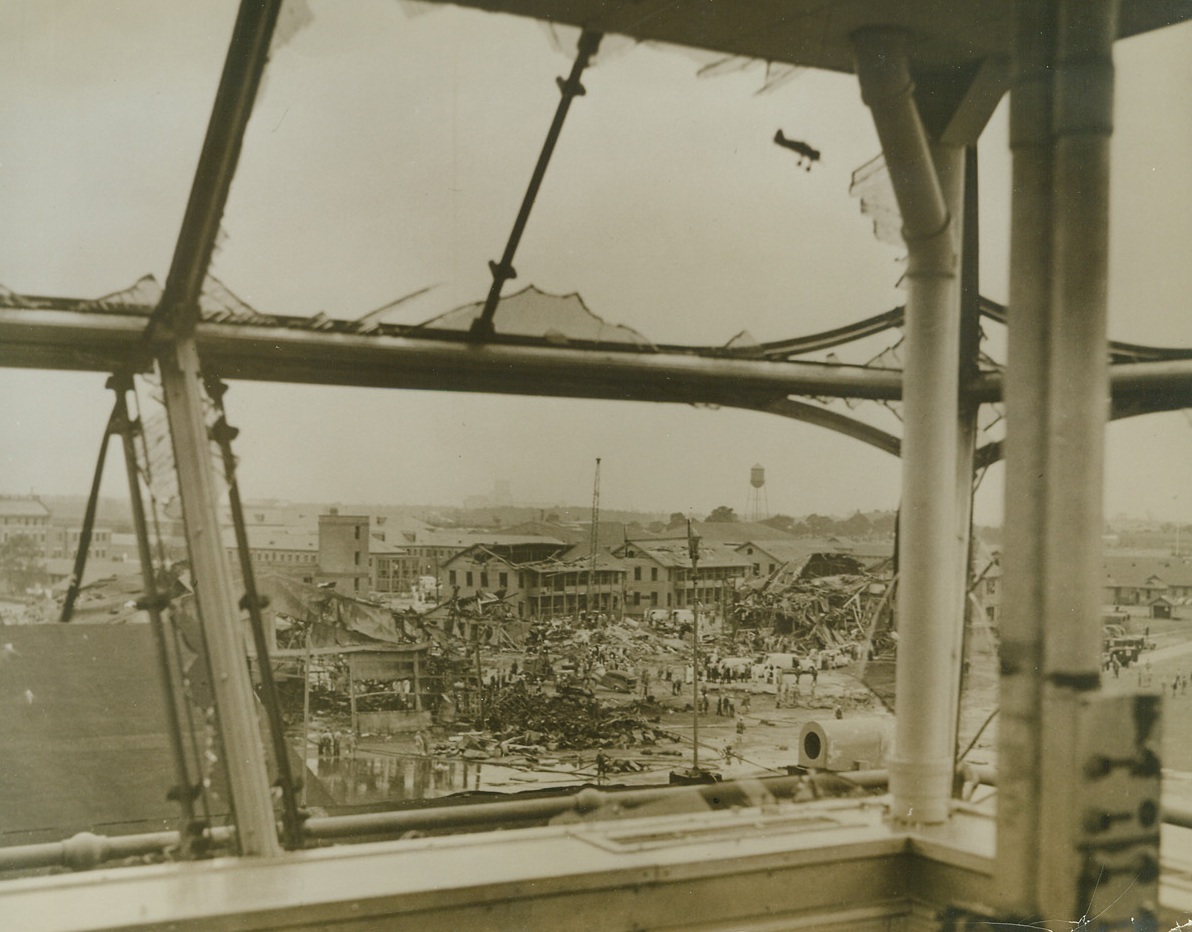
Blast Damage at Norfolk, 9/19/1943. Norfolk, Va—Here is the wreckage at Norfolk Naval Air Station, caused by the blast that shook the base on September 17th. Twenty five died, 250 were injured and a number of hangars and buildings were ruined in the explosion and the fire that followed it. Credit: Official U.S. Navy photo from ACME.;
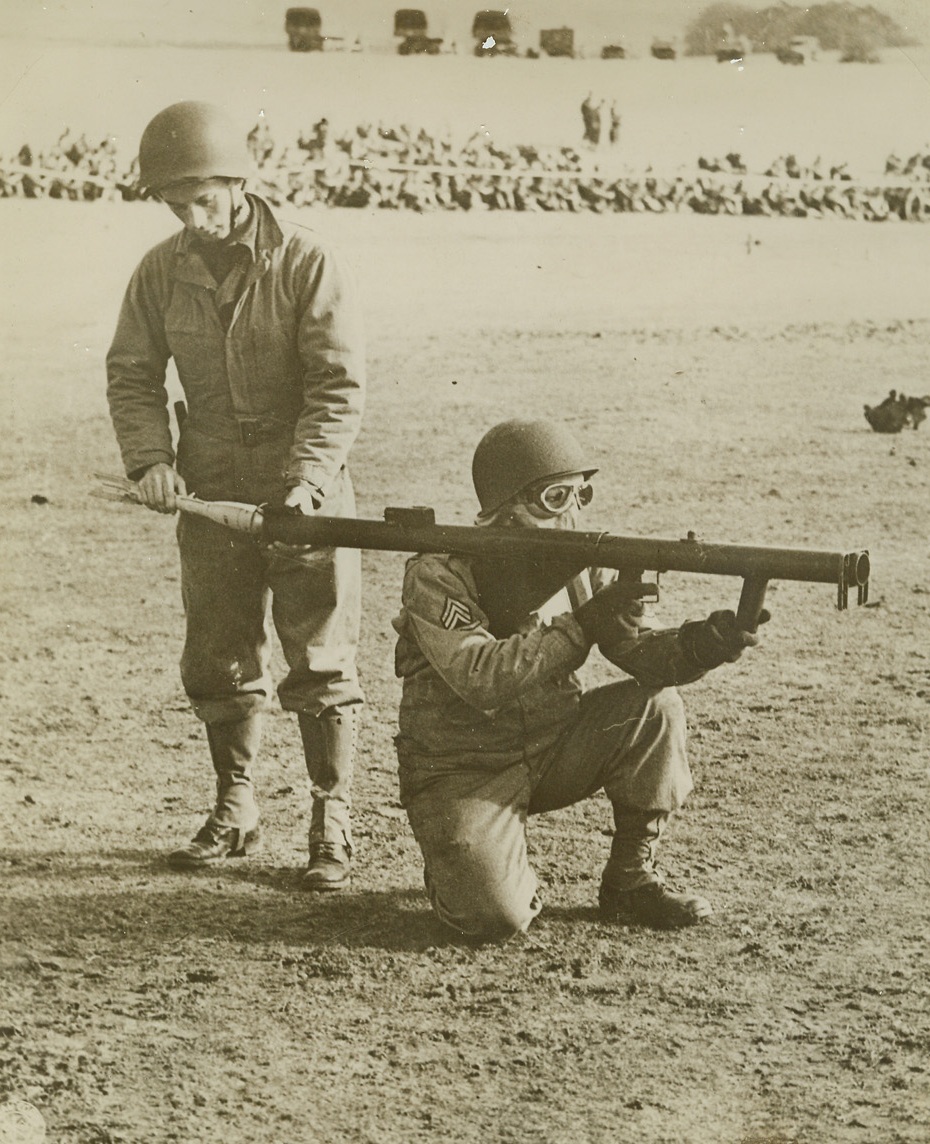
First Photos of Firing of “Bazooka”, 9/13/1943. Washington, D.C.—This is one of the first photos to be released by the War Department of the firing of the U.S. Army’s new rocket gun, popularly known as the “bazooka” and officially listed as “Launcher, Rocket, AT, W-1. The gun has proven very effective against tanks, can be carried by foot soldiers and be used in places inaccessible to large anti-tank guns. Here, one soldier holds the “bazooka” on his shoulder, while another man loads it with a rocket. Credit: US Signal Corps Photo from ACME.;
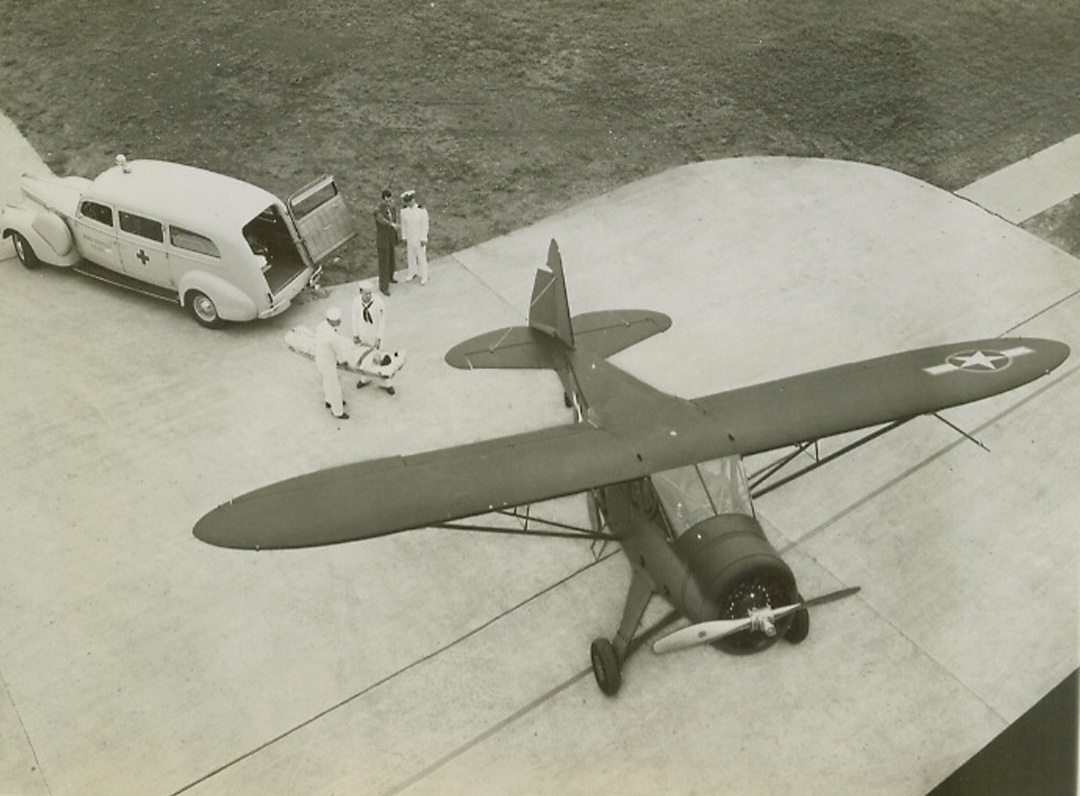
Rehearsal for Mercy, 9/12/1943. Chicago—Navy men from Chicago try out the new naval hospital ship, the Howard Nightingale, first of a new type of swift, maneuverable plane being turned out to transport badly wounded men from battle fronts to hospitals behind the lines. The plane holds two wire basket-type stretchers, one above the other, in a rigid position so that manipulation of the plane while dodging possible enemy pursuit will not further injure the patients. Naval officials and the Howard Aircraft Company, manufacturers of the ship, are dedicating it to Florence Nightingale. Photo No. 1 shows a stretcher being carried from an ambulance to the plane. (passed for publication)Credit: ACME.; v
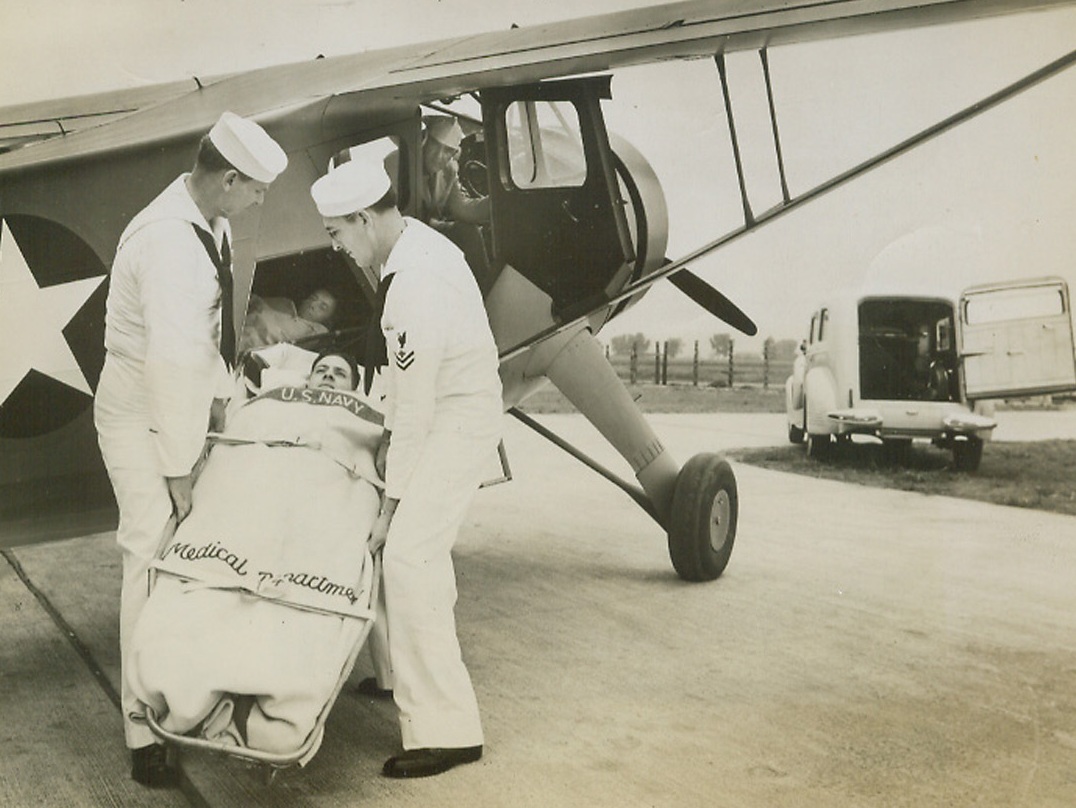
Rehearsal for Mercy, 9/12/1943. Chicago—Navy men from Chicago try out the new naval hospital ship, the Howard Nightingale, first of a new type of swift, maneuverable plane being turned out to transport badly wounded men from battle fronts to hospitals behind the lines. The plane holds two wire basket-type stretchers, one above the other, in a rigid position so that manipulation of the plane while dodging possible enemy pursuit will not further injure the patients. Naval officials and the Howard Aircraft Company, manufacturers of the ship, are dedicating it to Florence Nightingale. Photo No. 2 is a close-up of the plane as a stretcher is placed in it.(passed for publication).Credit: ACME.;
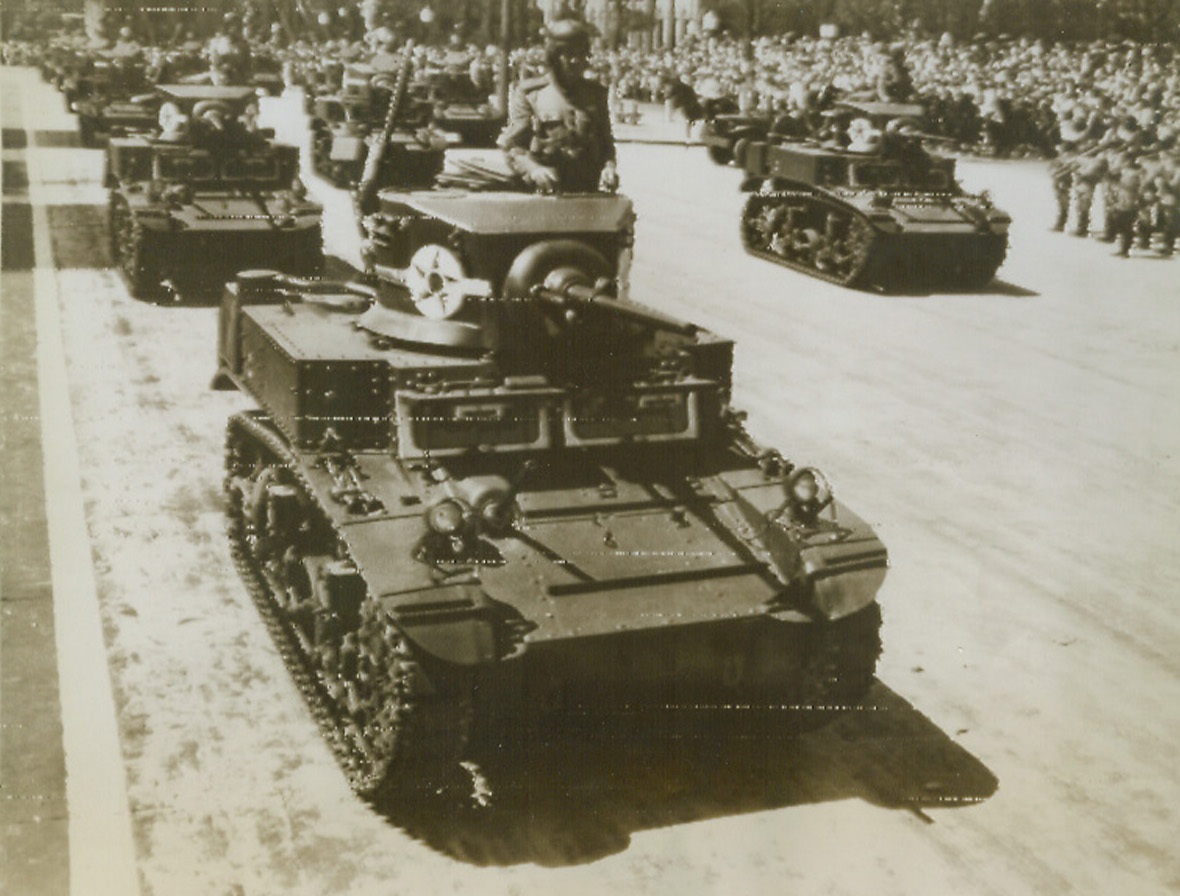
Brazil Celebrates 122 Years of Independence, 9/7/1943. Rio de Janeiro—Twenty-eight ton tanks of a Brazilian mechanized division pass the Ministry of War building in Rio de Janeiro during the giant parade of 50,000 troops to celebrate the nation’s Independence Day. This photo is one of the first to be transmitted over the direct radio-photo service between Rio and New York just opened by the Mackay Radio and Telegraph Corporation.Credit: ACME radiophoto.;
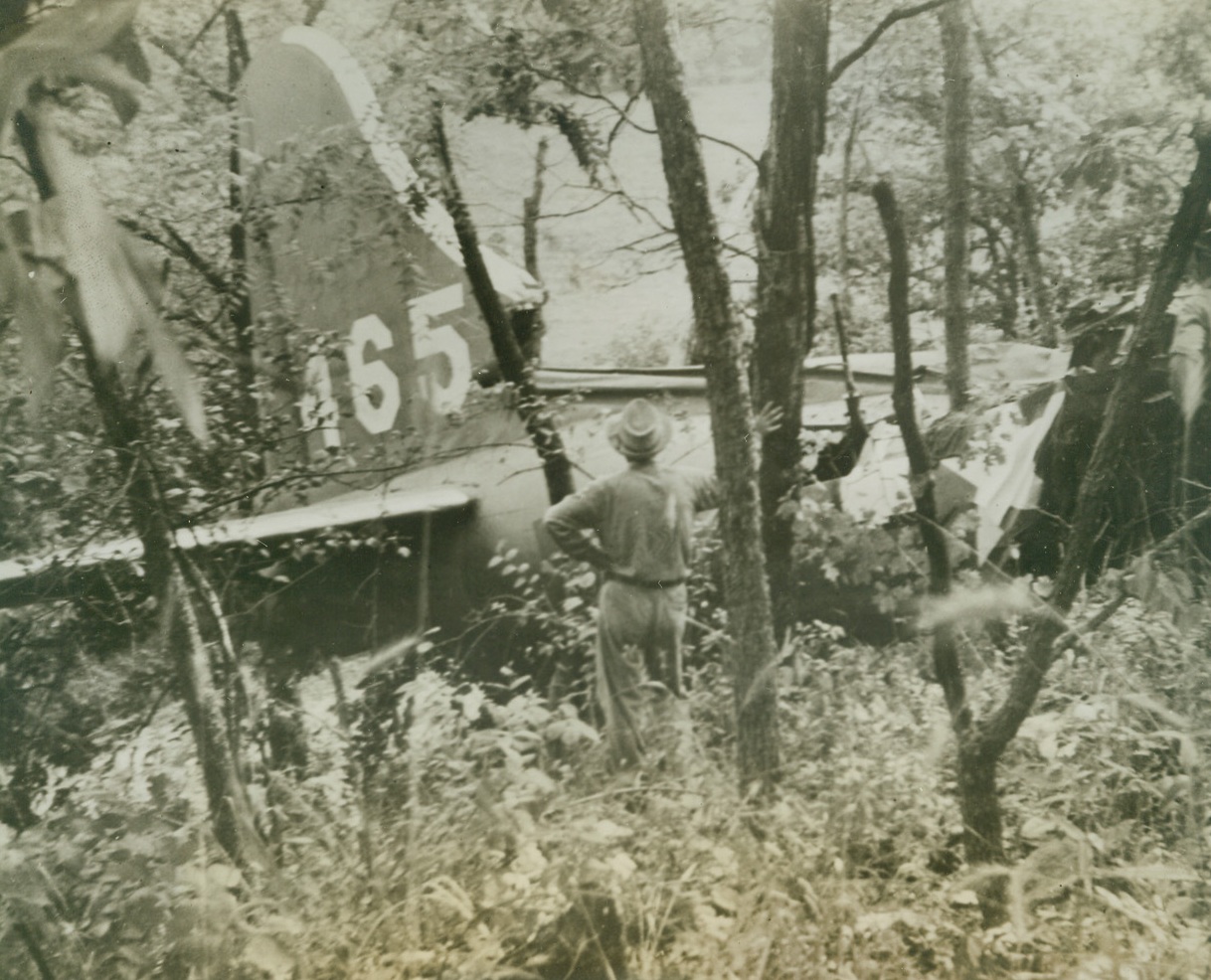
Flying Forts in Mid-Air Crash, 9/6/1943. St. Louis, Mo.—Following by only a few days the collision of two Liberator bombers near Fort Worth, Tex., two Flying Fortresses collided 3,000 feet above Salem, Mo., 150 miles southwest of St. Louis, and plummeted to earth with the toll of known dead at five, according to the Army Air Base at Dyersburg, Tenn. Seven men are said to have parachuted to safety. Others are not yet accounted for.Credit: ACME.;
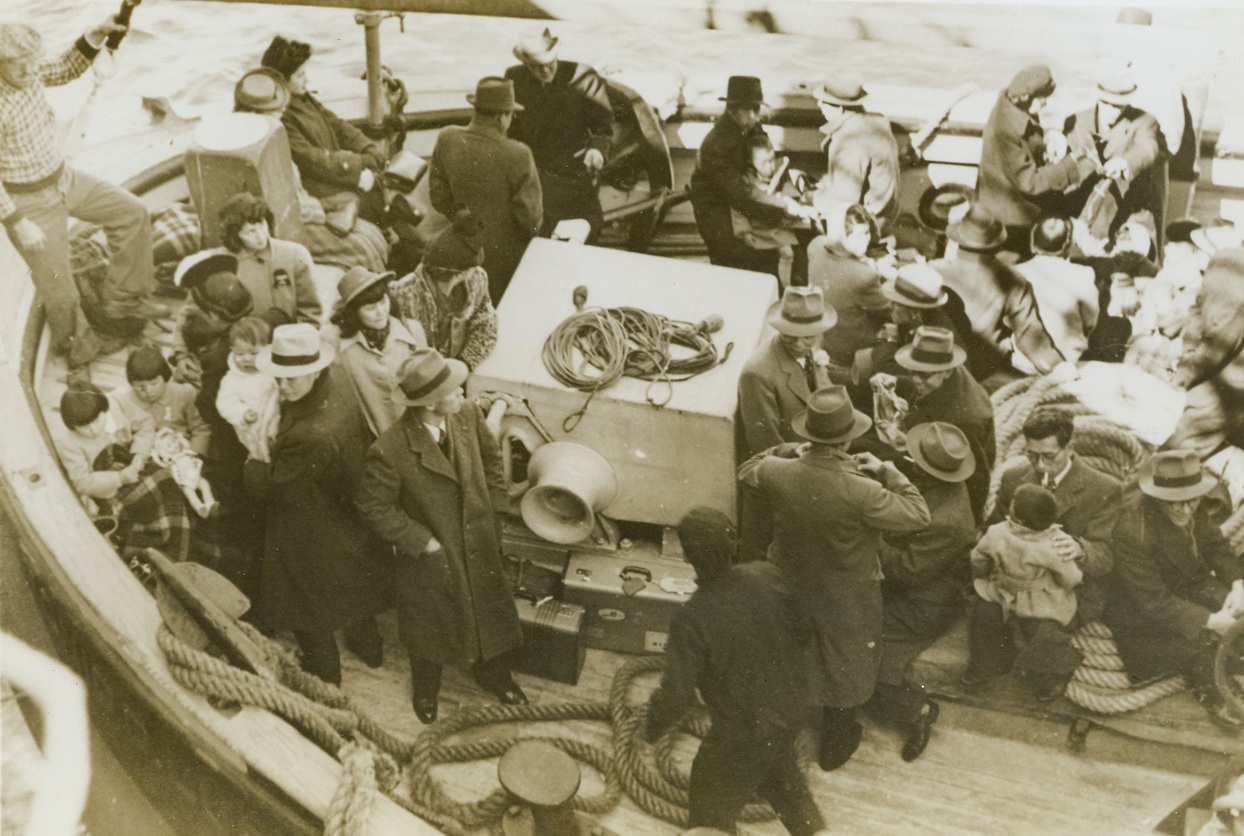
Exchange-Ites, 9/29/1943. Montevideo, Uruguay—Japanese diplomats and business men, and their families, shown on the tug “Antonio Lussich” in Montevideo Harbor, to be transferred to the Swedish Liner Gripsholm for shipment to Porto de Goa; Portuguese possession. There they will be exchange for a group of Chileans who were interned by Nazi authorities in Germany.Credit: ACME.;
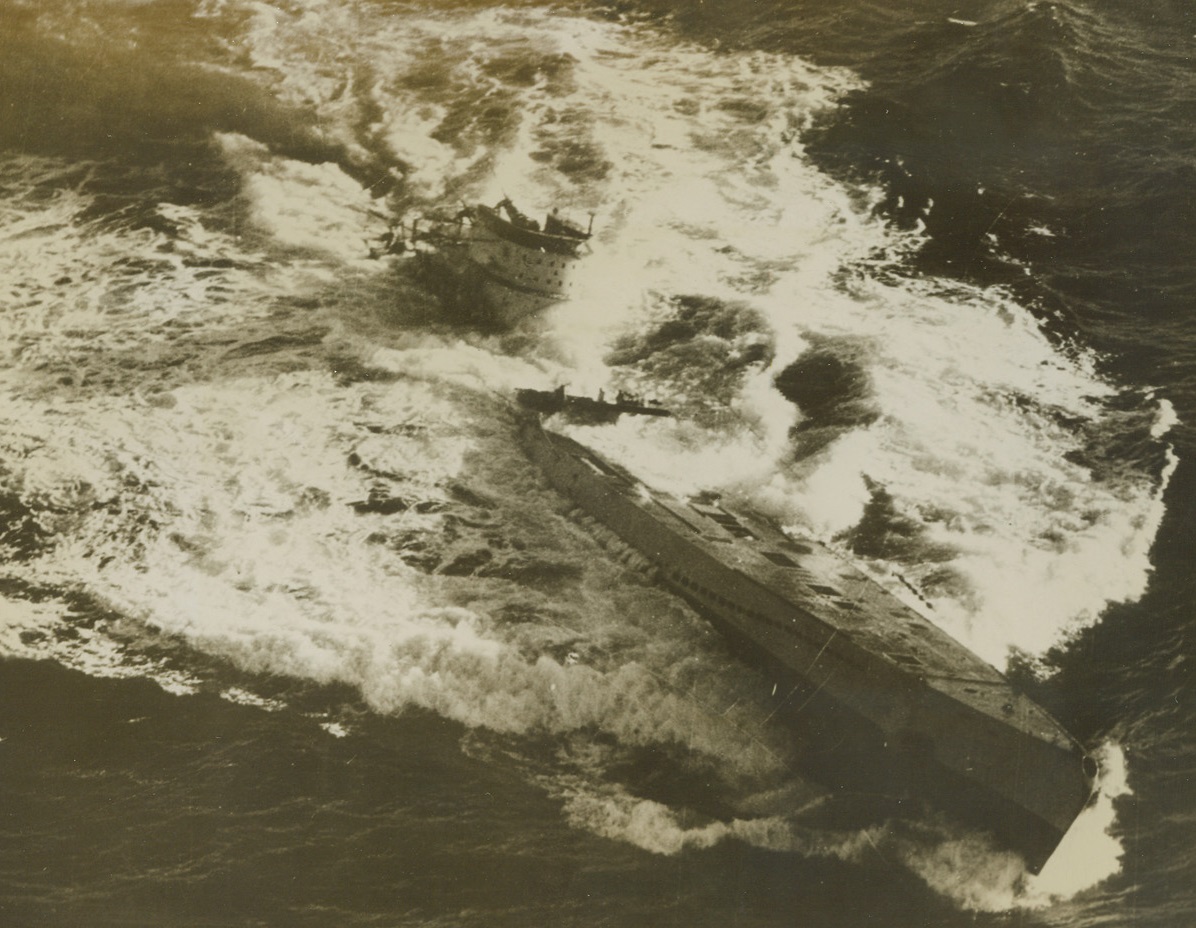
U.S. Navy Plane Sinks 3 Nazi Subs, 9/28/1943. WASHINGTON, D.C. - One, lone U.S. Navy Grumman Avenger (TBF) torpedo bomber flying from an escort carrier in the Atlantic, has made history by definitely sinking 3 Nazi U-Boats in 4 days and damaged another, according to announcement in Washington today. Lt. Robert P. Williams, USNR, and his two-man crew not only escaped unscathed in the attacks, but produced excellent pictoral evidence of the "kills". ...during the Navy plane's fourth attack, a Nazi sub begins to settle by her shattered stern, while surviving members of her crew cower in the shadow of the conning tower. This photo was made by an escorting Grumman Wildcat fighter.;

U.S. Navy Plane Sinks 3 Nazi Subs, 9/28/1943. Washington D.C. – One, lone U.S. Navy Grumman Avenger (TBF) torpedo bomber flying from an escort carrier in the Atlantic, has made history by definitely sinking 3 Nazi U-boats in 4 days and damaging another, according to an announcement in Washington today. Lt. Robert P. Williams, USNR, 26, of Snoqualmie, Wash., (above) and his two-man crew not only returned unscathed from the attacks but produced excellent pictorial evidence of the attacks. The two members of his crew were: Morris C. Grinstead, Radioman, 21, of Letts, Iowa; and Melvin H. Paden, Machinist’s Mate, 19, of Salinas, Calif. 9/28/43 Credit Line (U.S. Navy Photo From ACME);
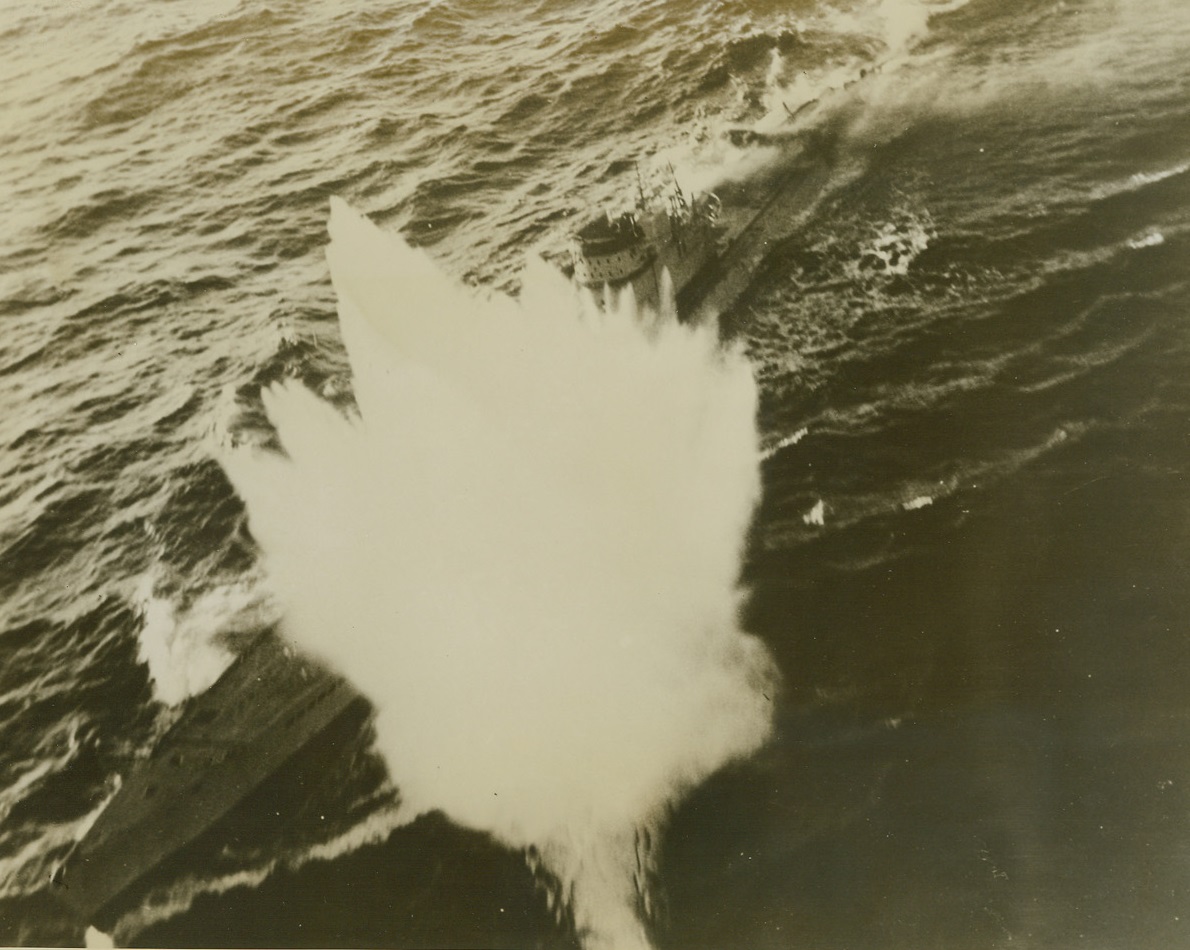
U.S. Navy Plane Downs 3 Nazi Subs, 9/28/1943. WASHINGTON, D.C. - One, lone U.S. Navy Grumman Avenger (TBF) Torpedo Bomber flying from an escort carrier in the Atlantic, has made history by definitely sinking 3 Nazi U-Boats in 4 days and damaging another, according to announcement in Washington today. Lt. Robert P. Williams, USNR, and his two-man crew not only escaped unscathed in the attacks, but produced excellent pictoral evidence of the "kills". Here, during their fourth "sub-blitzing" attack, Lt. Williams' plane drops a depth charge near a fully surfaced sub. Smoke pours from the afte end, (top, right in photo), of the sub, which sank a short time later - it was the third definite "kill" for the gallant Navy crew of the torpedo bomber.;
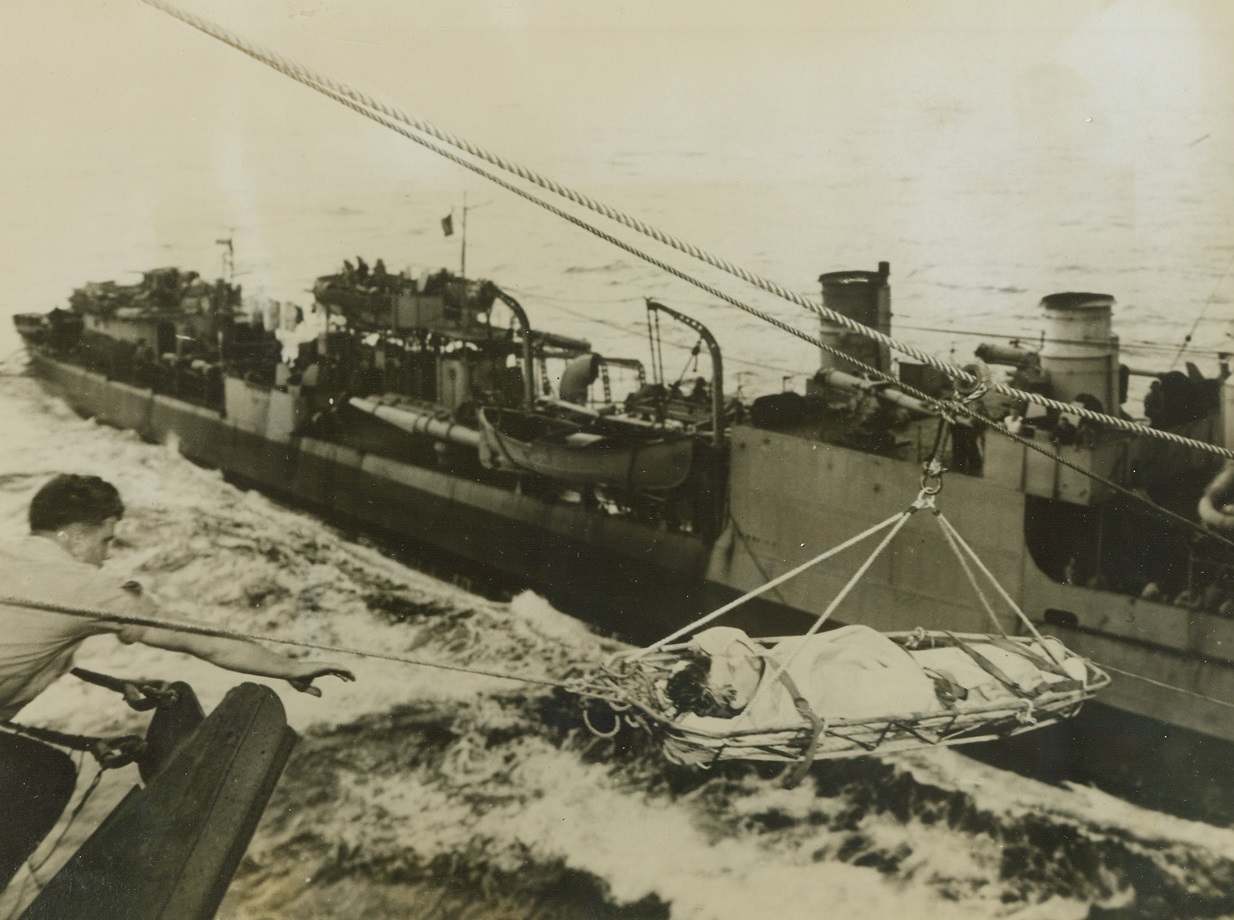
U.S. Navy Plane Downs 3 Nazi Subs, 9/28/1943. WASHINGTON, D.C. - One, lone U.S. Navy Grumman Avenger (TBF) Torpedo Bomber flying from an escort carrier in the Atlantic, has made history by definitely sinking 3 Nazi U-Boats in 4 days and damaging another, according to announcement in Washington today. Lt. Robert P. Williams, USNR, and his two-man crew not only escaped unscathed in the attacks, but produced excellent pictoral evidence of the "kills". Here, the captain of one of the Nazi subs blaskted by Lt. Williams' plane, and who was wounded in the attack, is transferred aboard the escort carrier from the destroyer that rescued him. Approximately 30 survivors were picked up.;
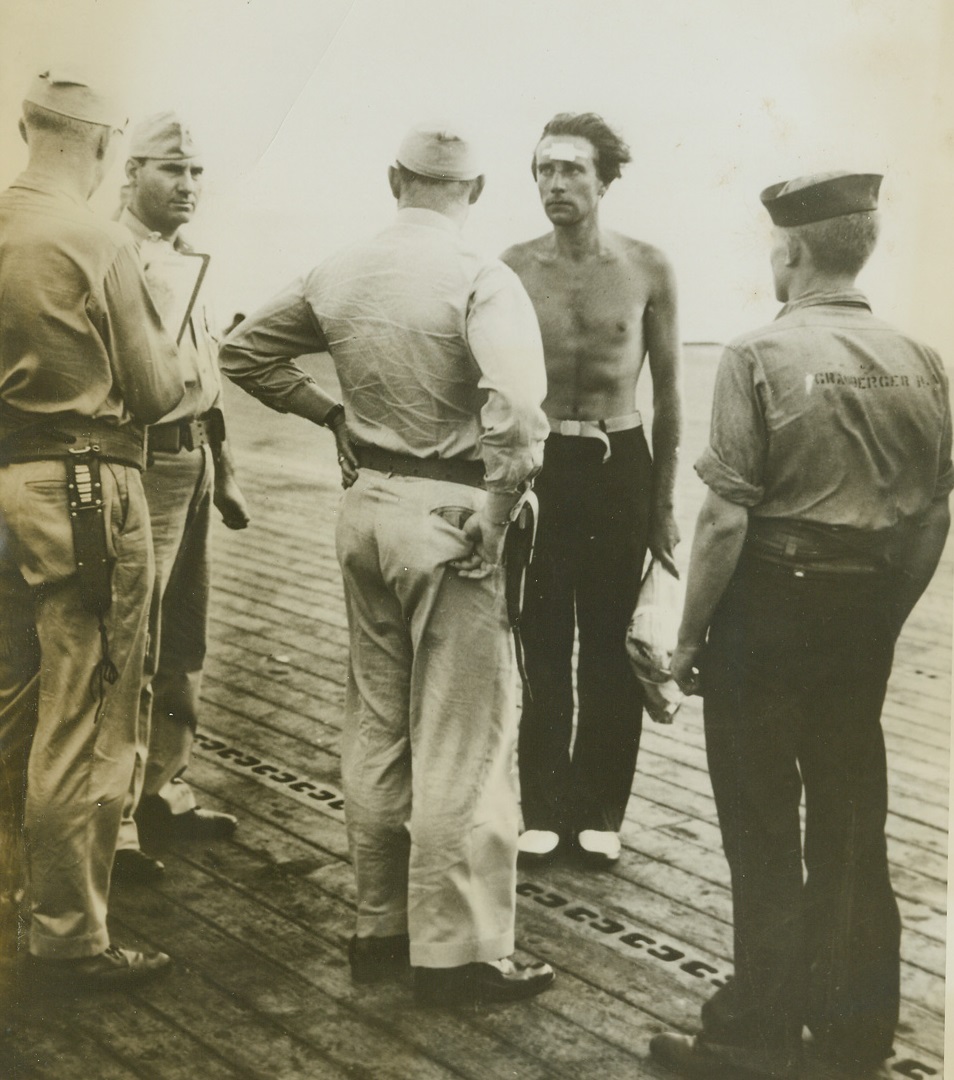
U.S. Navy Plane Downs 3 Nazi Subs, 9/28/1943. WASHINGTON, D.C. - One, lone U.S. Navy Grumman Avenger (TBF) Torpedo Bomber flying from an escort carrier in the Atlantic, has made history by definitely sinking 3 Nazi U-Boats in 4 days and damaging another, according to announcement in Washington today. Lt. Robert P. Williams, USNR, and his two-man crew not only escaped unscathed in the attacks, but produced excellent pictorial evidence of the "kills". Here, after being rescued along with some 30 members of his crew, the commanding officer, (without shirt, facing camera), of one of the U-Boats blasted by Lt. Williams and his gallant crew, chats with officers of the escort carrier to which he had been transferred after his rescue by a destroyer.;
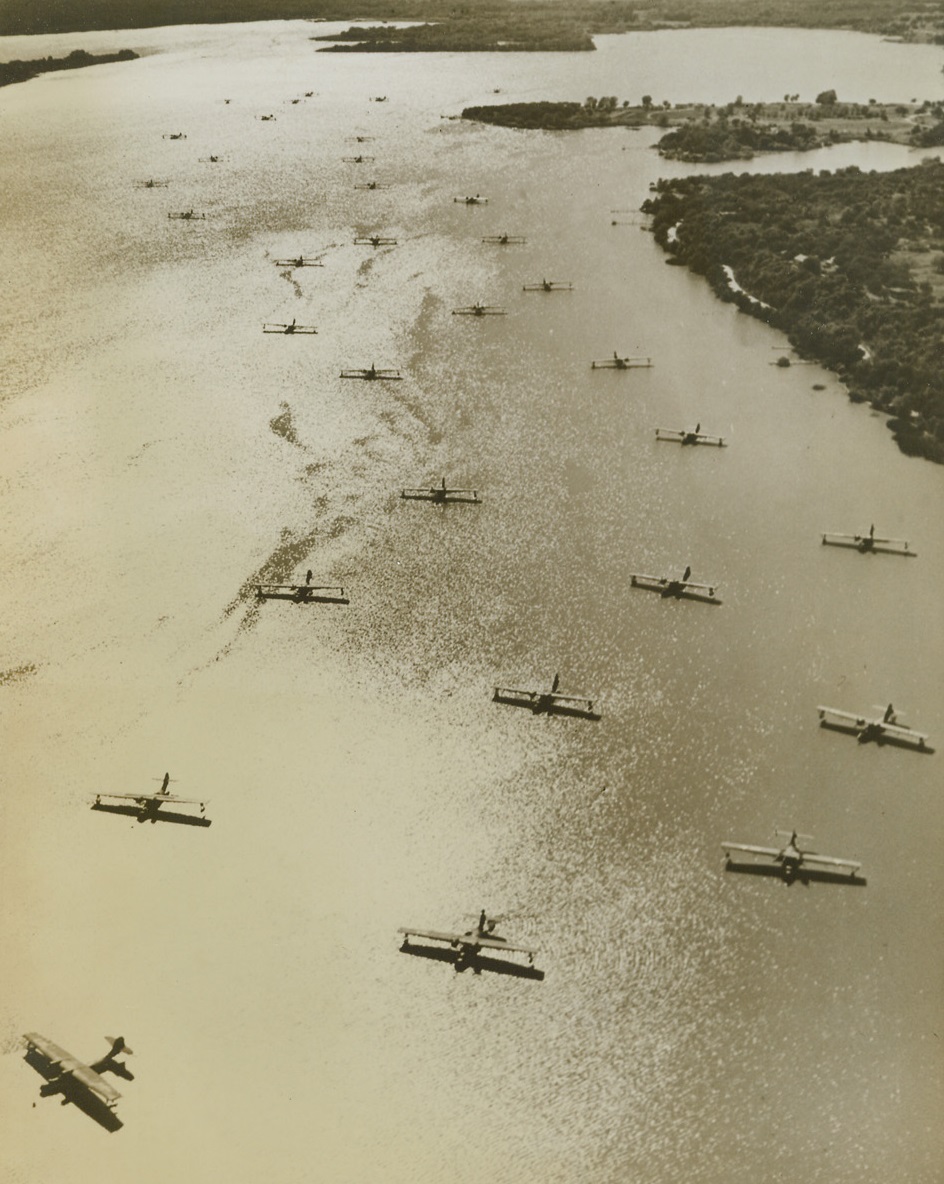
Storm Brewing, 9/28/1943. Fort Worth, Texas – More than thirty Navy PBY Catalina Flying Boats seek refuge from a threatening Gulf Coast storm, landing near Consolidated Vultee’s Fort Worth Plant which turns out Liberator Bombers and Liberator Express Transports. These planes, which appear to be resting on a sheet of silver, are known as the “workhorses” of the Navy. 9/28/43 Credit Line (ACME);
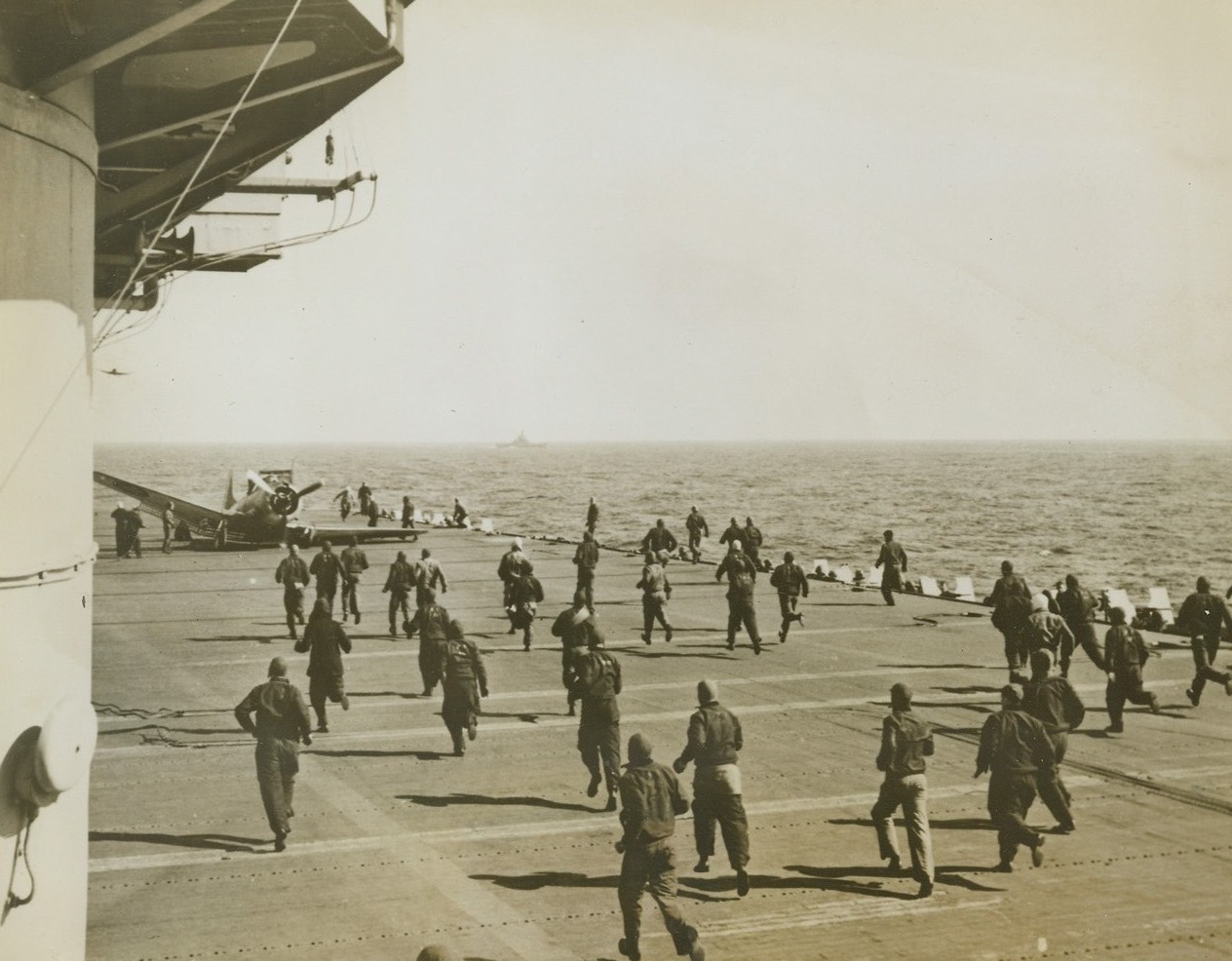
“Hot Squat”, 9/29/1943. Somewhere at sea – Crewmen of a U.S. Aircraft Carrier race to the assistance of the pilot of a Douglas Dauntless Dive Bomber which “pancaked” on the deck of the flattop. The pilot was not injured and the deck crew quickly ran the plane below, where it was repaired and put back into service. Credit: U.S. Navy photo from ACME;
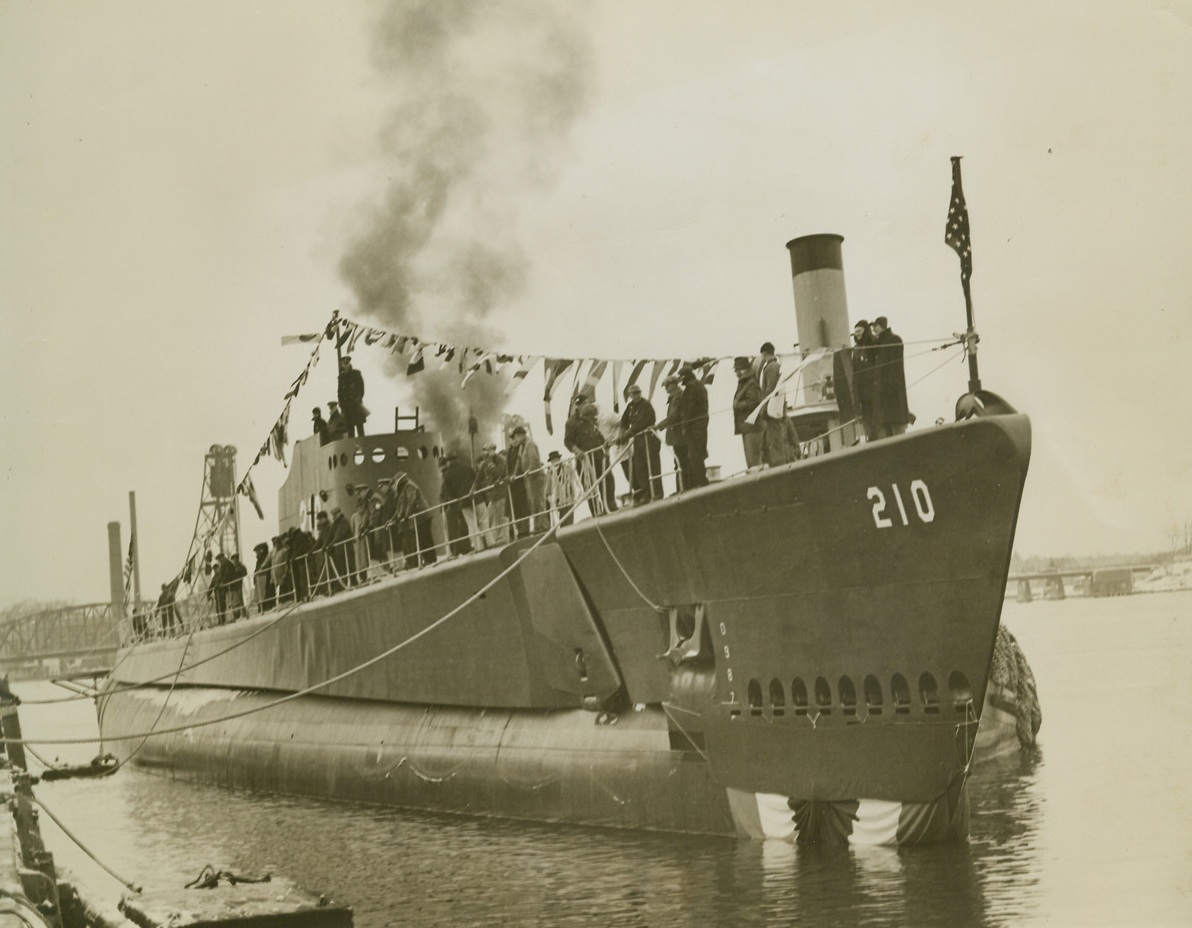
U.S. Sub Lost, 9/14/1943. Washington, D.C. - A communiqué by the Navy Department, Sept. 14, announced the loss of the U.S. submarine Grenadier (above), one of the Navy’s newer underwater ships. The twelfth American submarine to be lost in this war, the Grenadier is presumed to have gone down in the Pacific. It carried a crew of approximately 65. Credit: ACME;

Army-Navy Chiefs Urge Father Draft, 9/20/1943. Washington, D.C. -- Warning against postponement of the drafting of fathers, General George C. Marshall and Admiral Ernest J. King appeared at a joint session of the House and Senate Military Affairs Committee today. They are shown, at right, as General Marshall warned that such action would force reduction of combat divisions, cause casualties to mount unnecessarily, and prolong the whole struggle. Credit: ACME;
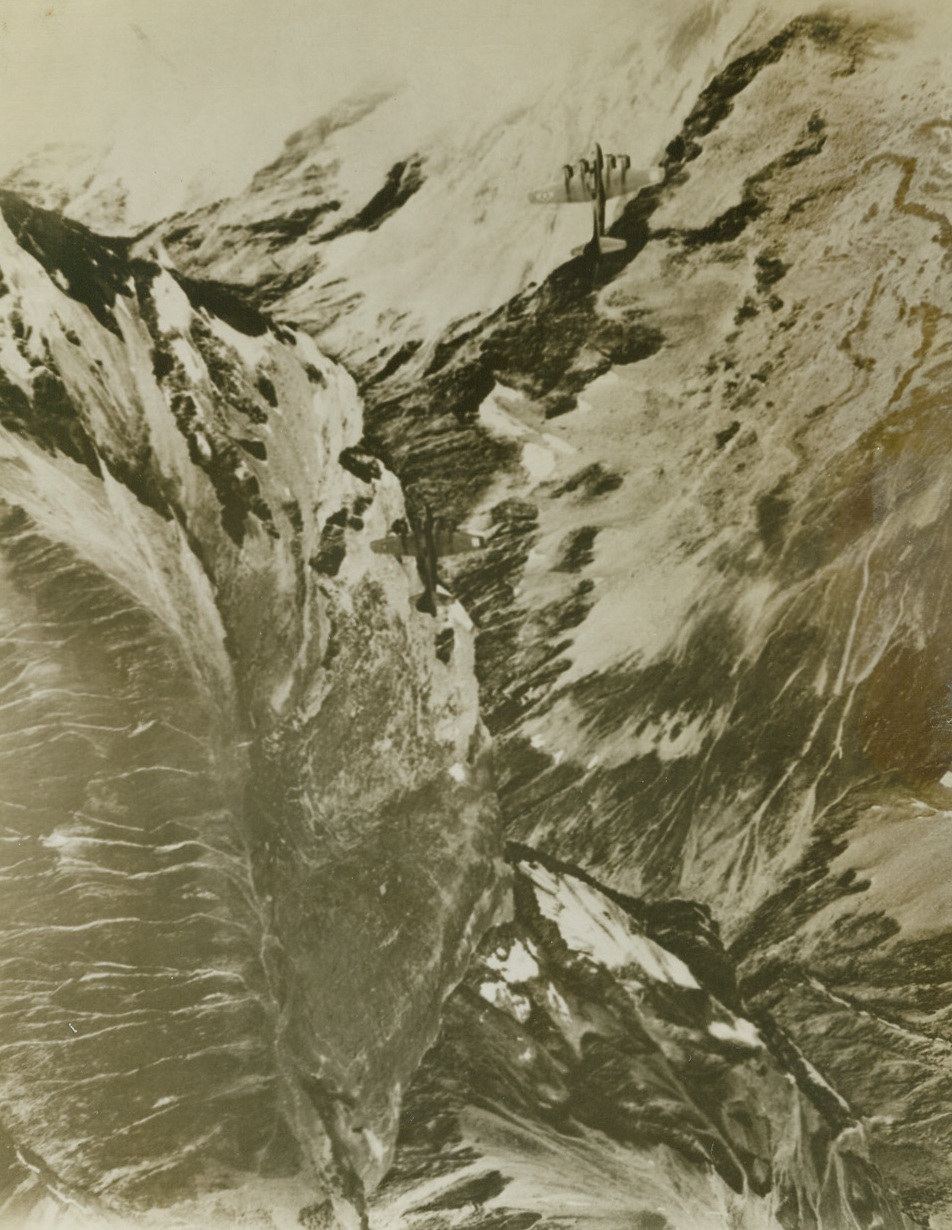
U.S. Bombers Over Alps On Shuttle Trip, 9/22/1943. Flying Fortresses of the U.S. 8th Air Force based in England, pass over 12,000-foot peaks of the Alps, on their first shuttle bombing trip from England to North Africa and return. Shortly before this photo was taken, the Bombers blasted the Messerschmitt Plane Factory at Regensburg, Germany. Credit: U.S. Army Air Forces photo from ACME;
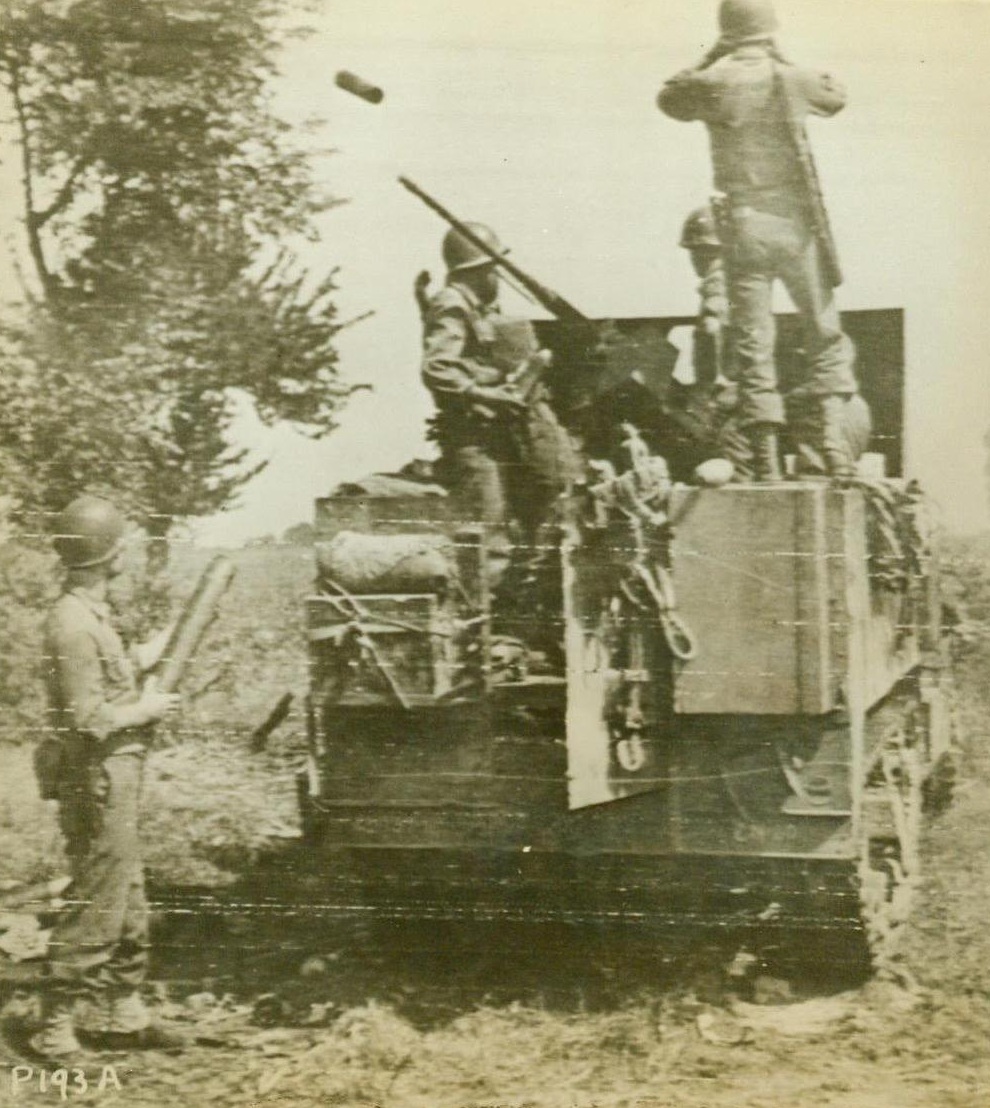
Direct Hit, 9/18/1943. ITALY – As the shell casing flies into the air, the crew of howitzer mounted on a half-track watched the shell they’ve just fired score a direct hit on an Italian tobacco factory, being used by the Germans as an artillery observation post. The crew, operating in the battle for the Italian mainland, is commanded by Sgt. Eugene Frey of Denver, Colo. CREDIT (U.S. Signal Corps Radiotelephoto from ACME) 9/18/43;
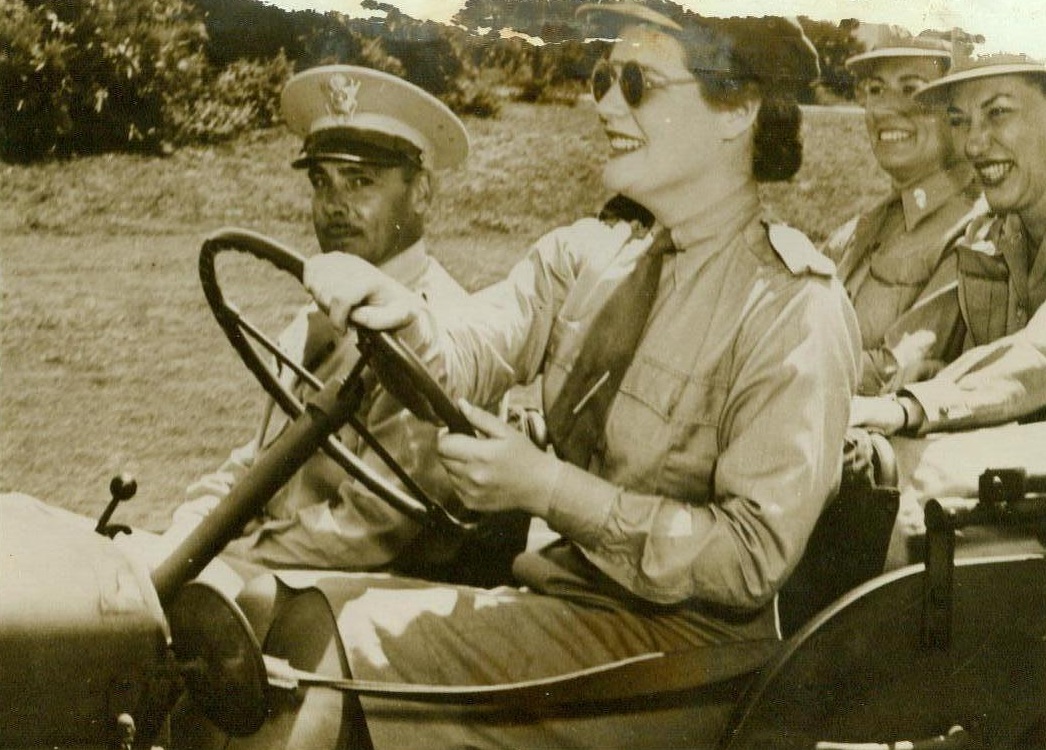
Subaltern Churchill drives a Jeep, 9/3/1943. DAYTONA BEACH, FLA. Visiting the Second WAC training center at Daytona Beach, Subaltern Mary Churchill, daughter of the Prime Minister, takes a lesson in the art of driving a Jeep. Her rank in the British Auxiliary Territorial Service is the equivalent of an American lieutenant’s. Her unit is on duty with an anti-aircraft battery. 9/3/43;
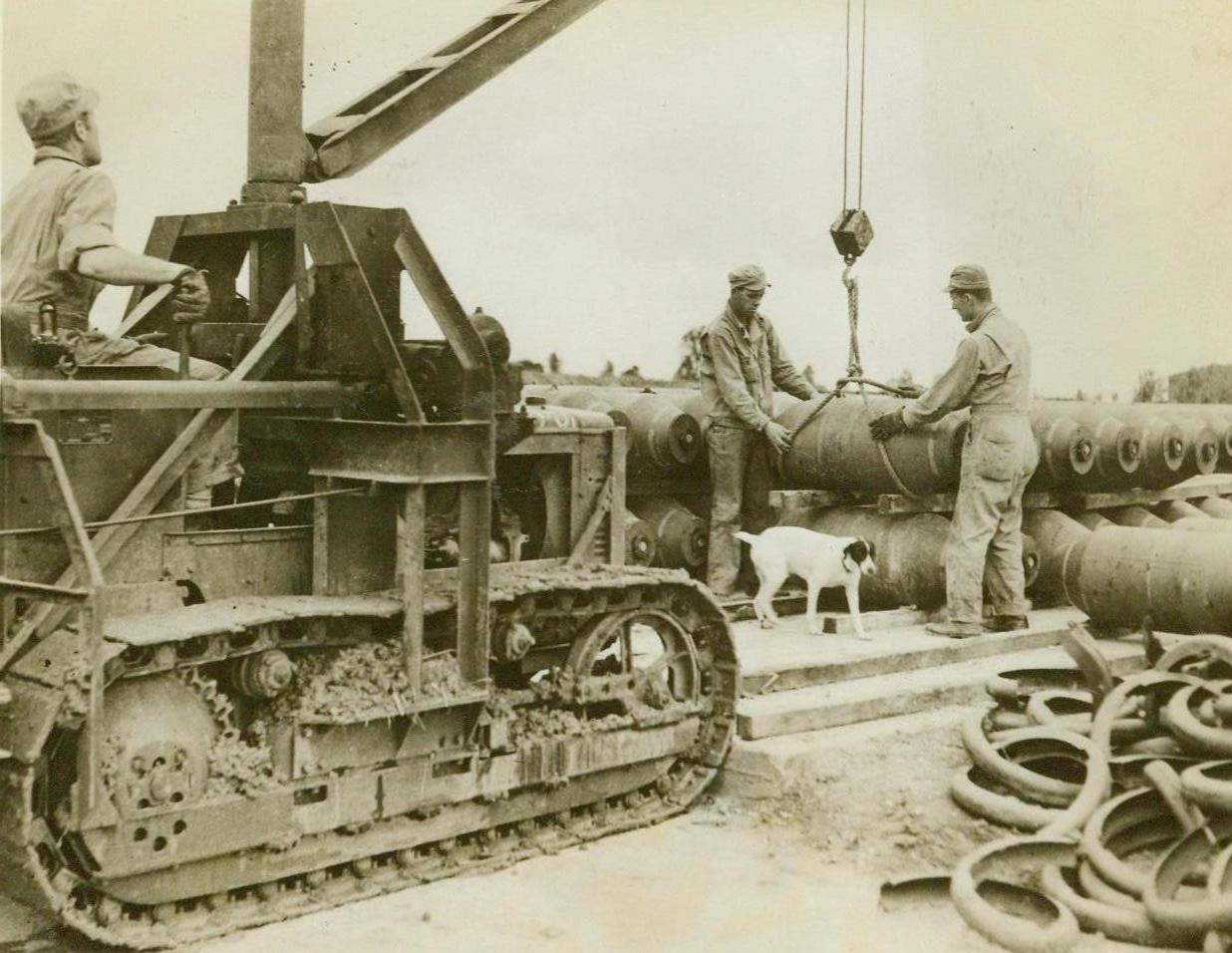
Preparations For A Raid, 9/19/1943. Somewhere In England - Destined to mess up enemy territory, these bombs are picked up by a tractor that will place them in a loading wagon. The deadly missiles will soon travel over Europe in the bomb racks of B-26 Marauders. The white pup “assisting” in operations is one of the mascots at this U.S. Marauder Base in England. Credit: ACME;
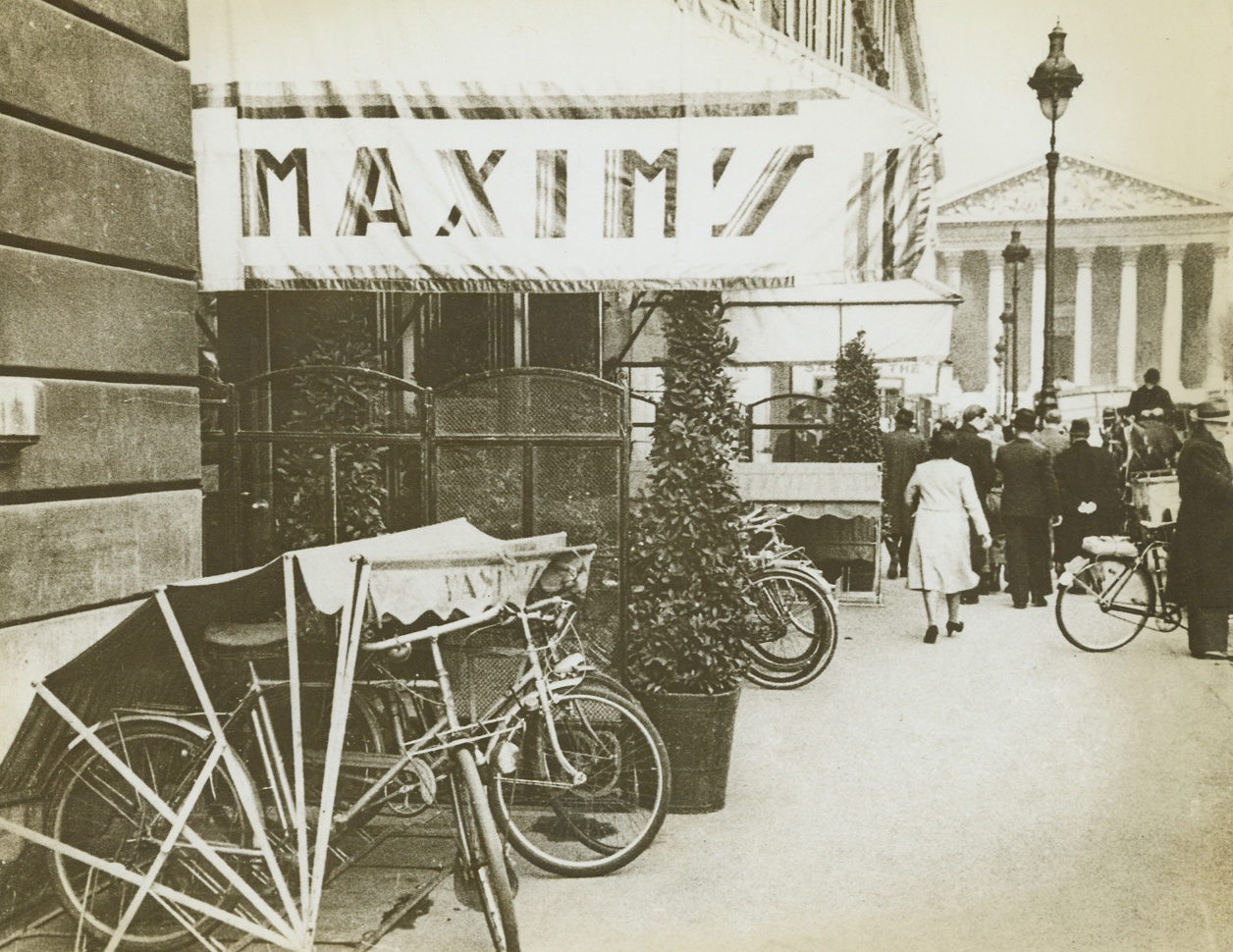
”I’m Going to Maxim’s” – On a Bicycle, 9/2/1943. Paris – Parisians have almost forgotten what it was like to drive around in motor cars. They get along as best they can with bicycles and horse-drawn vehicles. Typical is this bicycle garage in front of Maxim’s, the night club made famous in story and song. Credit: ACME;
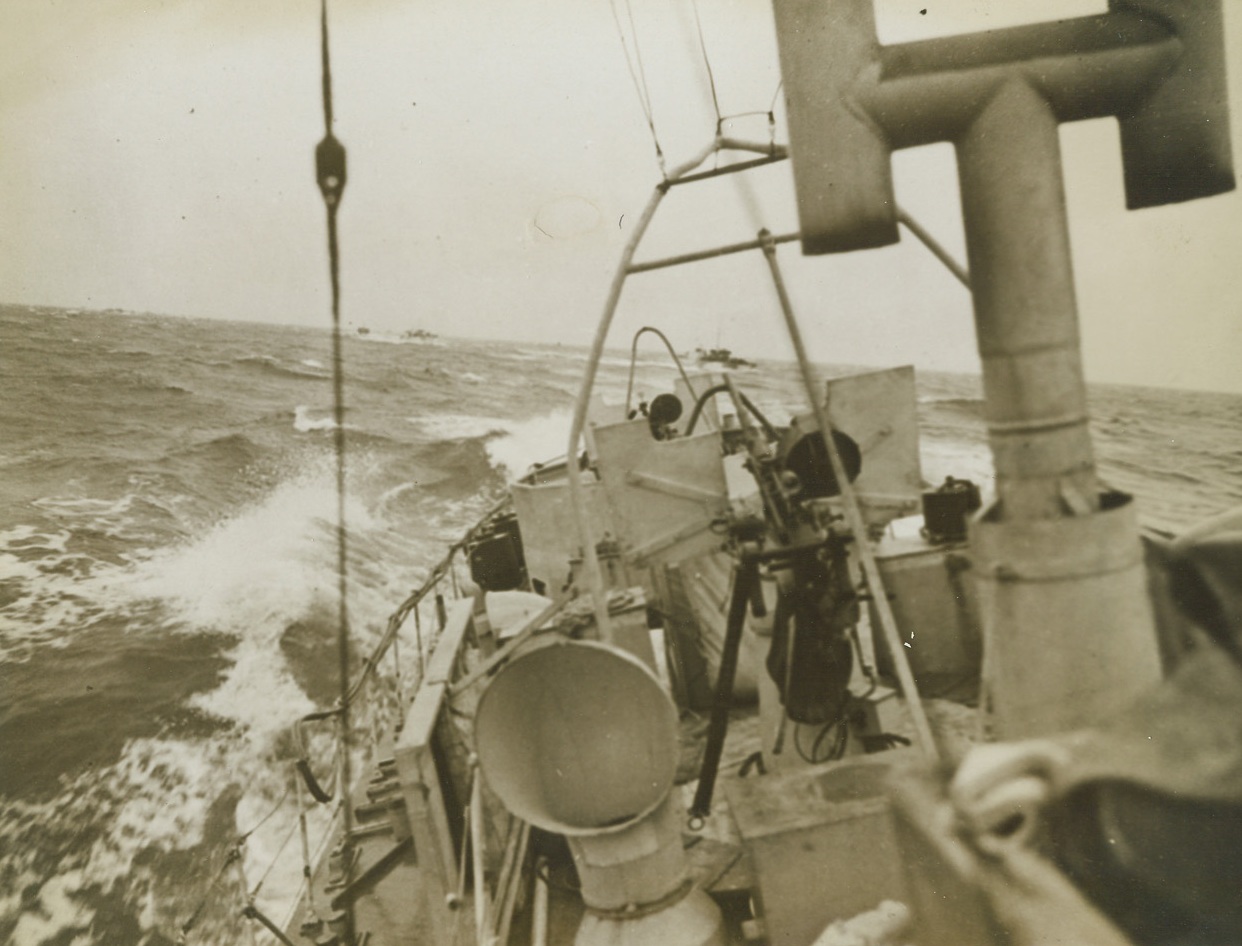
Huge Invasion Rehearsal Unopposed By Nazis, 9/16/1943. England – On Sept. 9th, last, it was revealed that Allied land, sea and air forces had completed a major-scale 24-hour rehearsal for invasion of the Nazi-occupied Channel Coast without interference from the enemy. The Great Armada sailed to within 10 miles of the French Coast. Allied bombers and fighters supporting the operation made more than 3,000 sorties in the 24 hours, with only small enemy opposition. Here, after the rehearsal, the Senior Officer’s Motor Launch leads landing craft back to the base. (Passed by Censors). Credit: ACME;
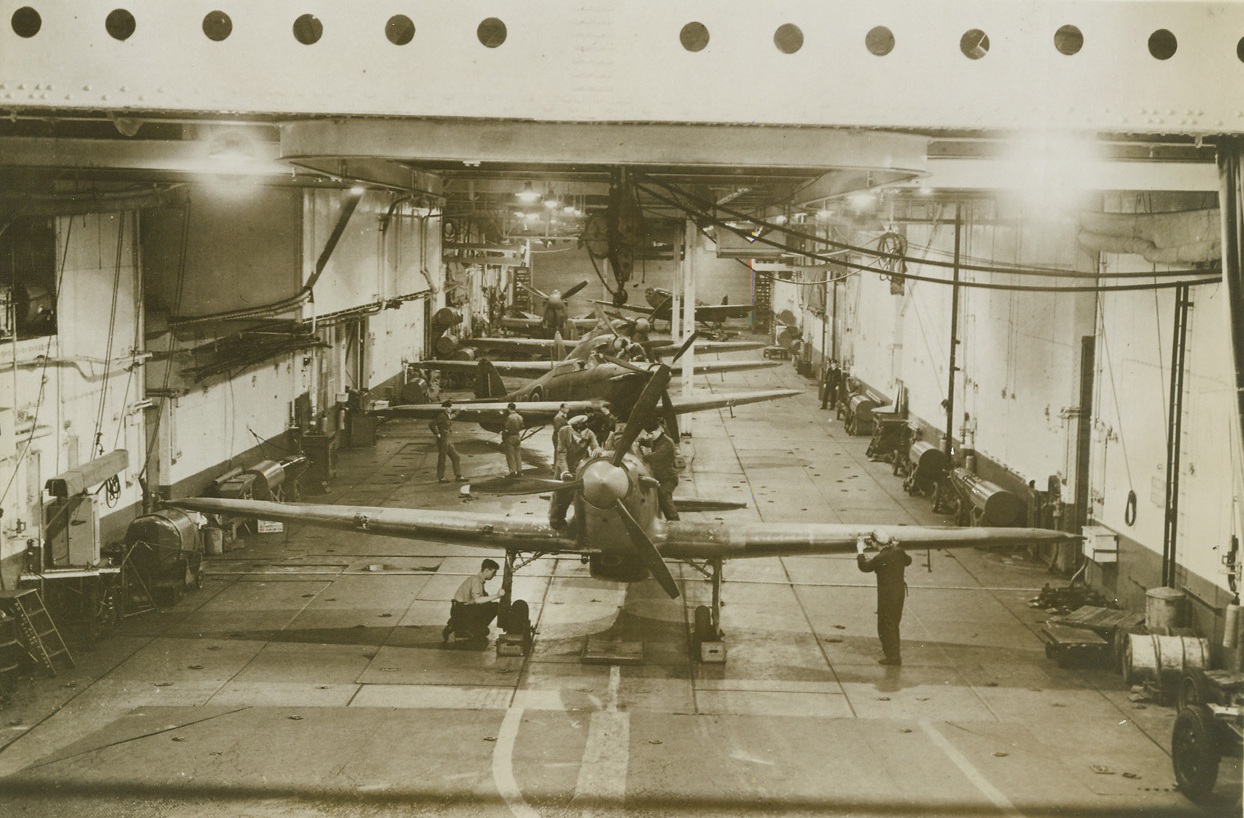
Flat-Top Celebrates Silver Jubilee, 9/20/1943. England – Mechanics work on one of the planes in the hanger of the H.M.S. Argus, British Aircraft Carrier. The flat-top recently completed 25 years of continuous service with the Royal Navy. Credit: ACME;

O.K., RAF, Take ‘Er Away, 9/20/1943. Somewhere in England – This big baby, which tips the scales at 8,000 pounds and makes a mess of enemy targets when it falls, is very much of “O.K.” The giant missile is backed up in front of the RAF Lancaster bomber that will soon carry it away on a night raid over Axis territory. Credit: ACME;
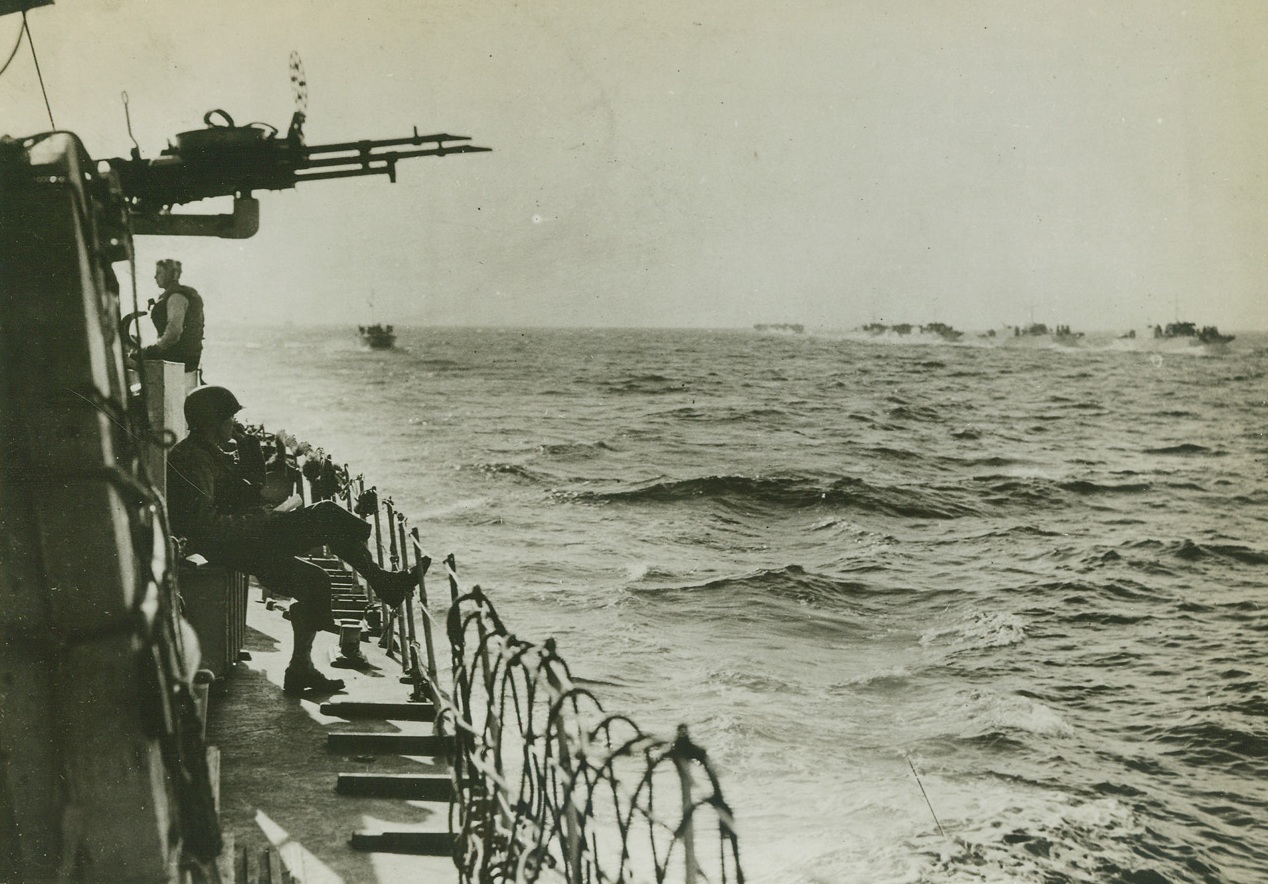
Huge Invasion Rehearsal Unopposed By Nazis, 9/16/1943. England – On Sept. 9th, last, it was revealed that Allied land, sea, and air forces had completed a major-scale 24-hour rehearsal for invasion of the Nazi-occupied Channel Coast without interference from the enemy. The Great Armada sailed to within 10 miles of the French Coast. Allied bombers and fighters supporting the operation made more than 3,000 sorties in the 24 hours, with only small enemy opposition. Here, seated on the deck of one of the invasion craft, takes notes on the proceedings. (Passed by censors). Credit: ACME;
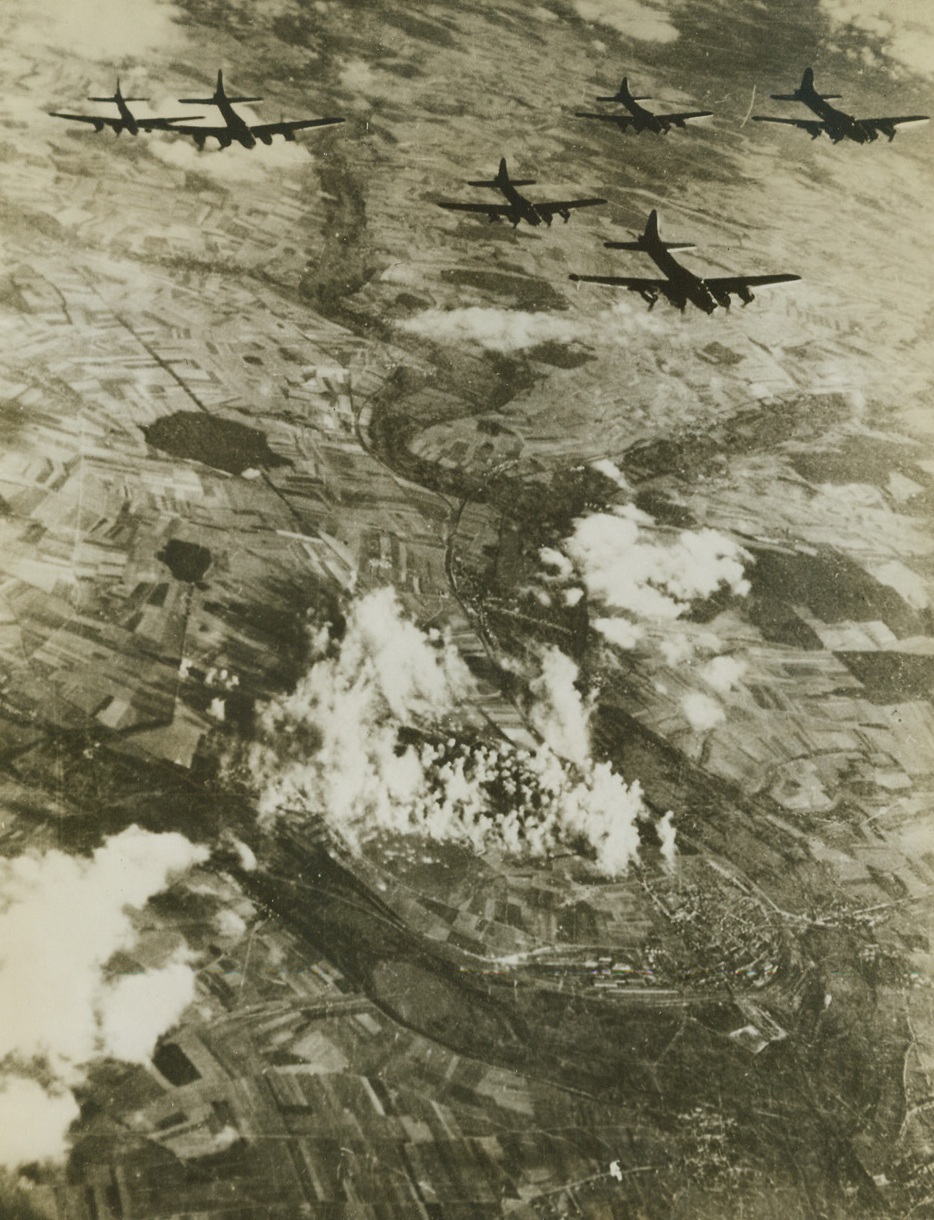
“Forts” Blast Nazi Airfield in France, 9/16/1943. In this photo, probably the most perfect view of bombing from the air yet produced, a formation of Flying Fortresses of the U.S. Army 8th Air Force, is shown over the Nazi-held airfield at Amiens-Glisy, France, during a raid on the important German fighter base last Aug. 31st. The boundaries of the base are clearly marked by columns of smoke from exploding bombs dropped by the American “Forts”. Allied air forces based in Britain, are concentrating heavily on the invasion coast and on aircraft factories and airfields in France, in recent raids. This may by the “softening-up” prelude to invasion. (Passed by Censors) Credit: ACME;

Welcome To New Guinea, 9/2/1943. New Guinea—General Douglas MacArthur (Right) greets Under-Secretary of War Robert L. Patterson (Center) and Lieut. Gen. William S. Knudsen, at his headquarters somewhere in New Guinea. That South Pacific Island is now the scene of some furious war action as our forces close in on Japs entrenched at Salamaua. 9/2/43 (ACME);
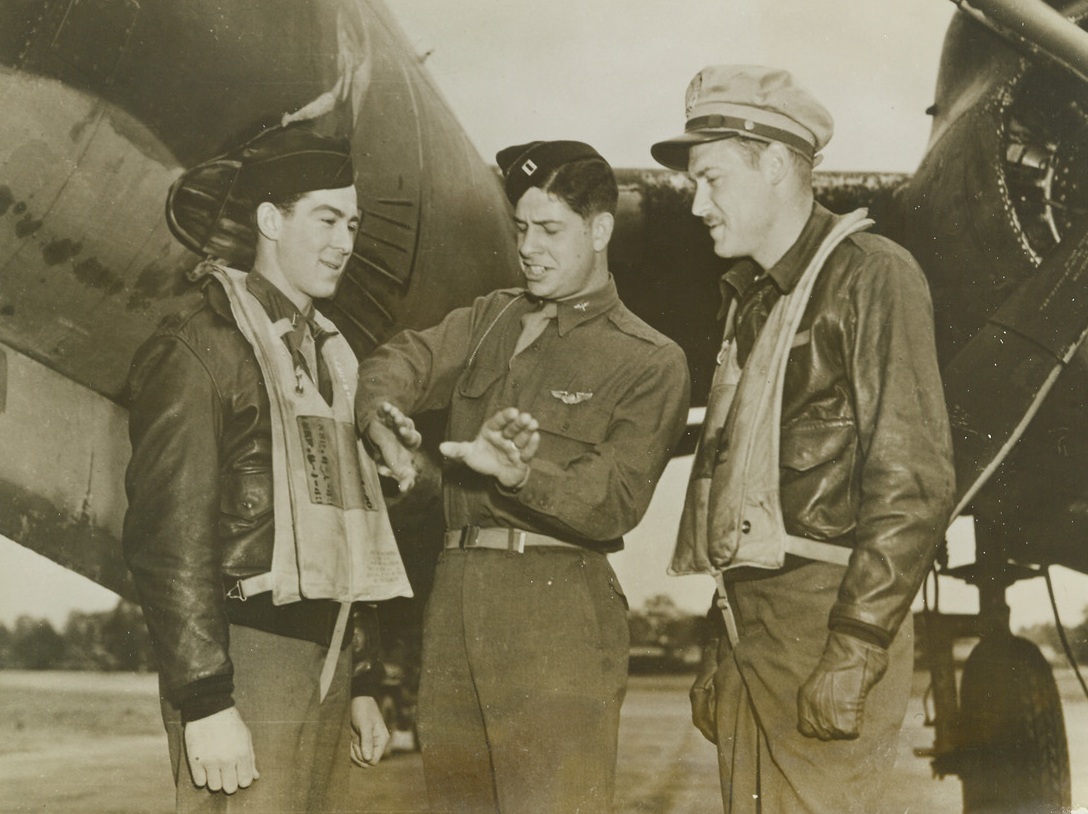
Planning Their Route, 9/19/1943. Somewhere in England – Chatting before their plane at a U.S. Marauder base somewhere in England, these pilots discuss their plans for a raid over Axis Europe. Left to right: 1st Lt. Robert W. Wilcox of Rice Lake, Wisconsin; Capt. Robert C. Fry of Abilene, Texas; and 1st Lt. Harry W. Uffelman. Credit: ACME;
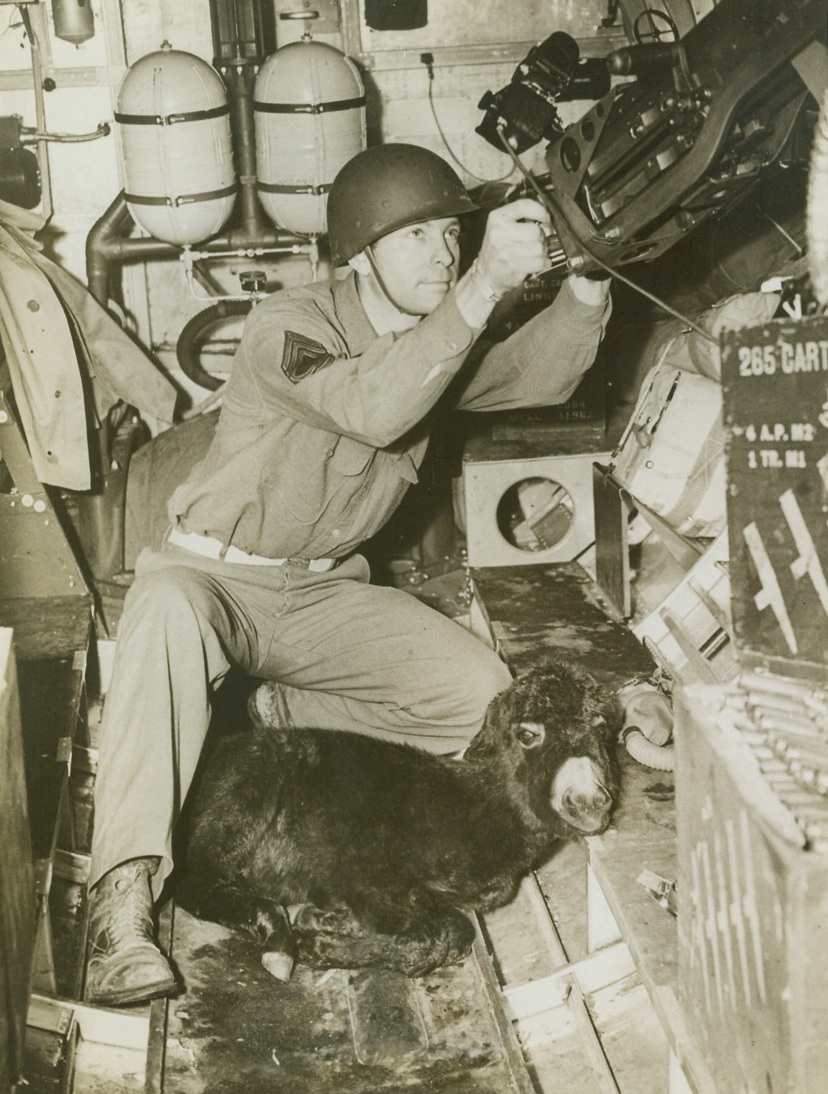
High-Flying Mascot 9/10/1943. England – Looking just the least bit frightened, “Lady Moe” curls up on the floor of the Flying Fortress “The Miracle Tribe” as T/Sgt. H.J. Amacker mans the bomber’s waist gun. Lady Moe, a donkey, is the mascot of the plane’s crew, who purchased her from an Arab for 400 francs. Credit: ACME;
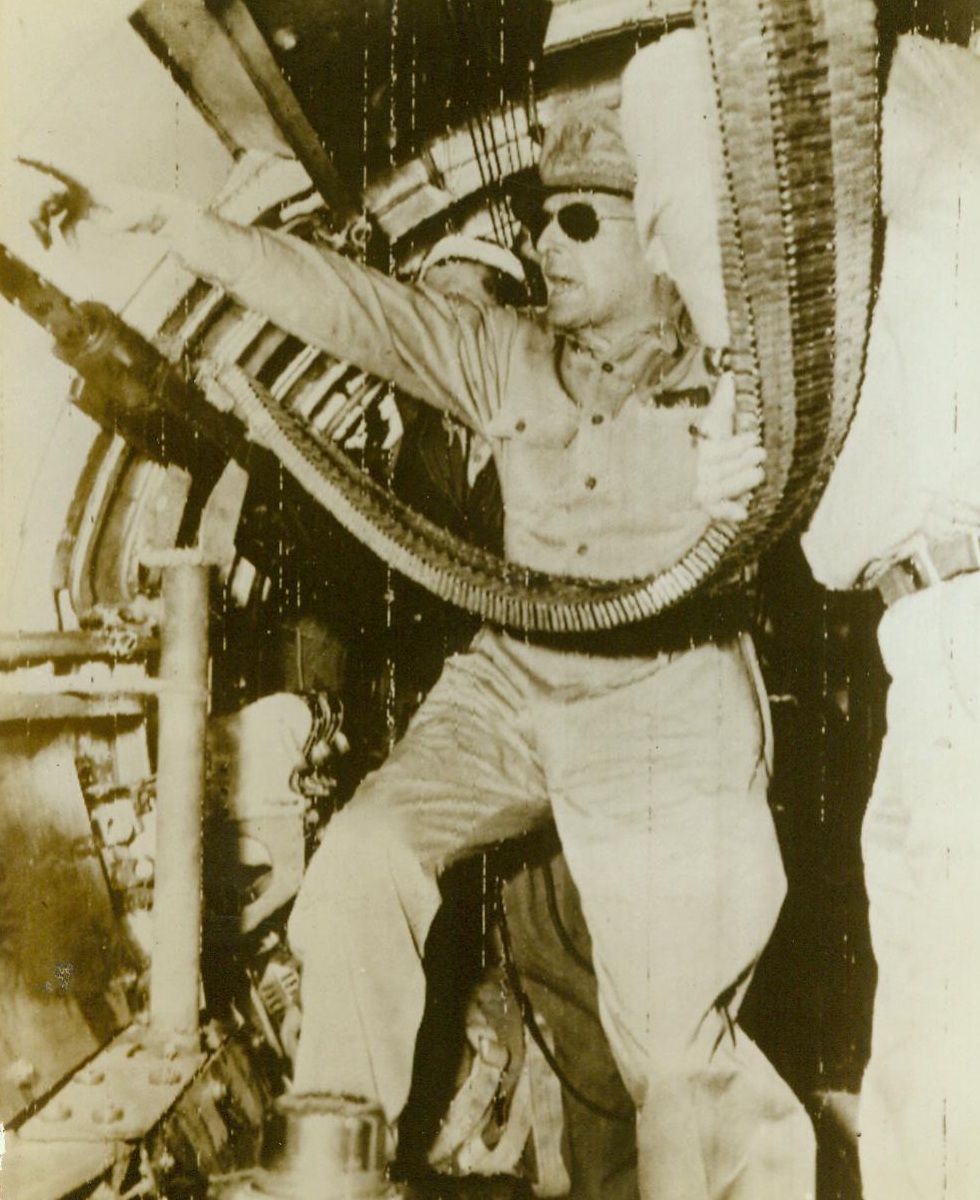
"Beautiful", 9/7/1943. New Guinea—General Douglas MacArthur watches wave upon wave of transports unload American paratroops which cut off all land supply lincs of some 20,000 Jap troops in the Lae and Salamaua area of New Guinea. “Beautiful! Wonderful!” exclaimed the General, as the American sky soldiers landed near an enemy airfield without opposition. 9/7/43 (Acme Telephoto);
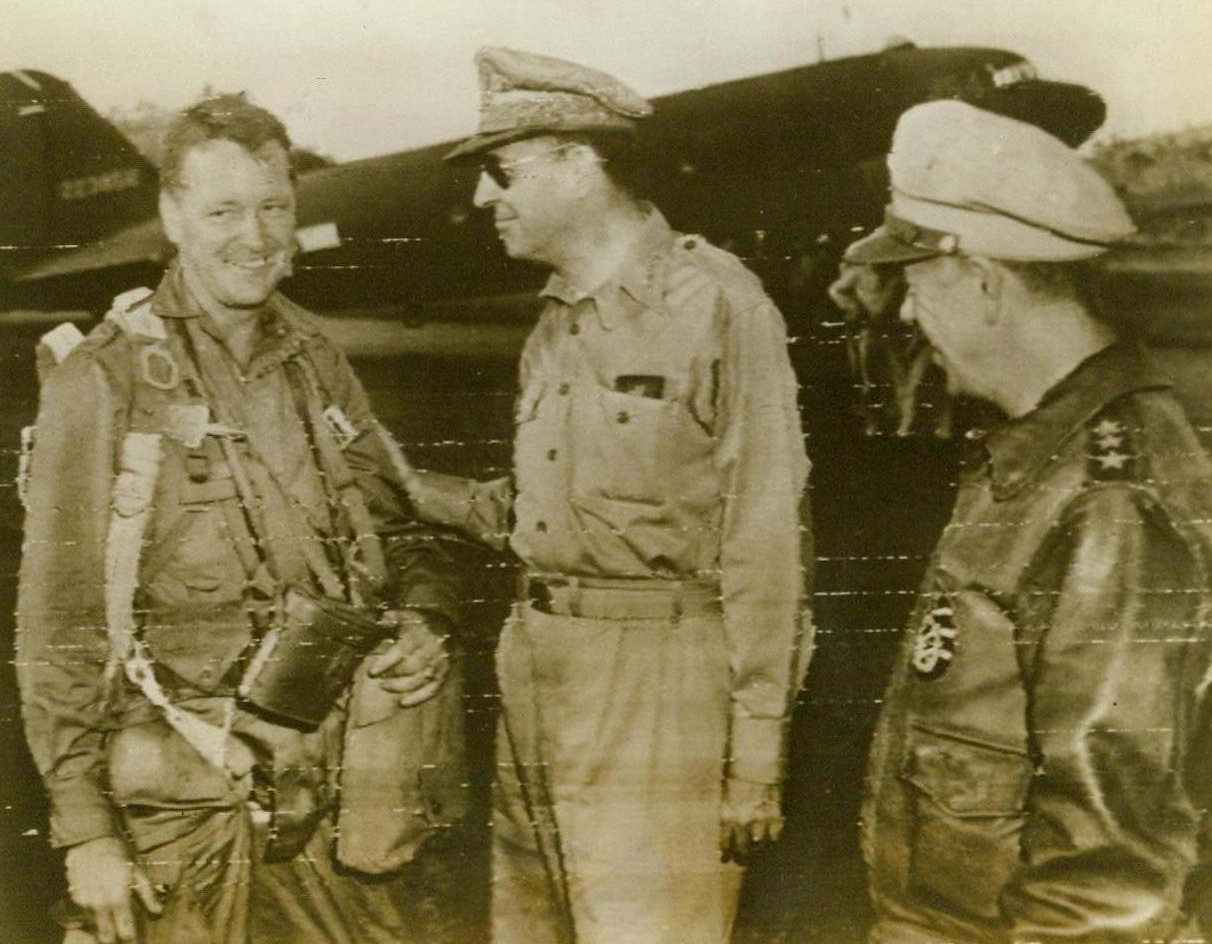
Bids "Good Luck" To Paratrooper, 9/7/1943. Gen. Douglas MacArthur, (center), wishes Paratrooper Lt. Col. J.J. Tolson, (left), of New Bern, N.C., good luck just before the Paratroopers took off to land in the Lae area of New Guinea, in this Radiotelephoto flashed to the United States today. Looking on at this Allied base “somewhere in The Southwest Pacific”, is Lt. Gen. George J. Kenny. 9/7/43 (ACME);
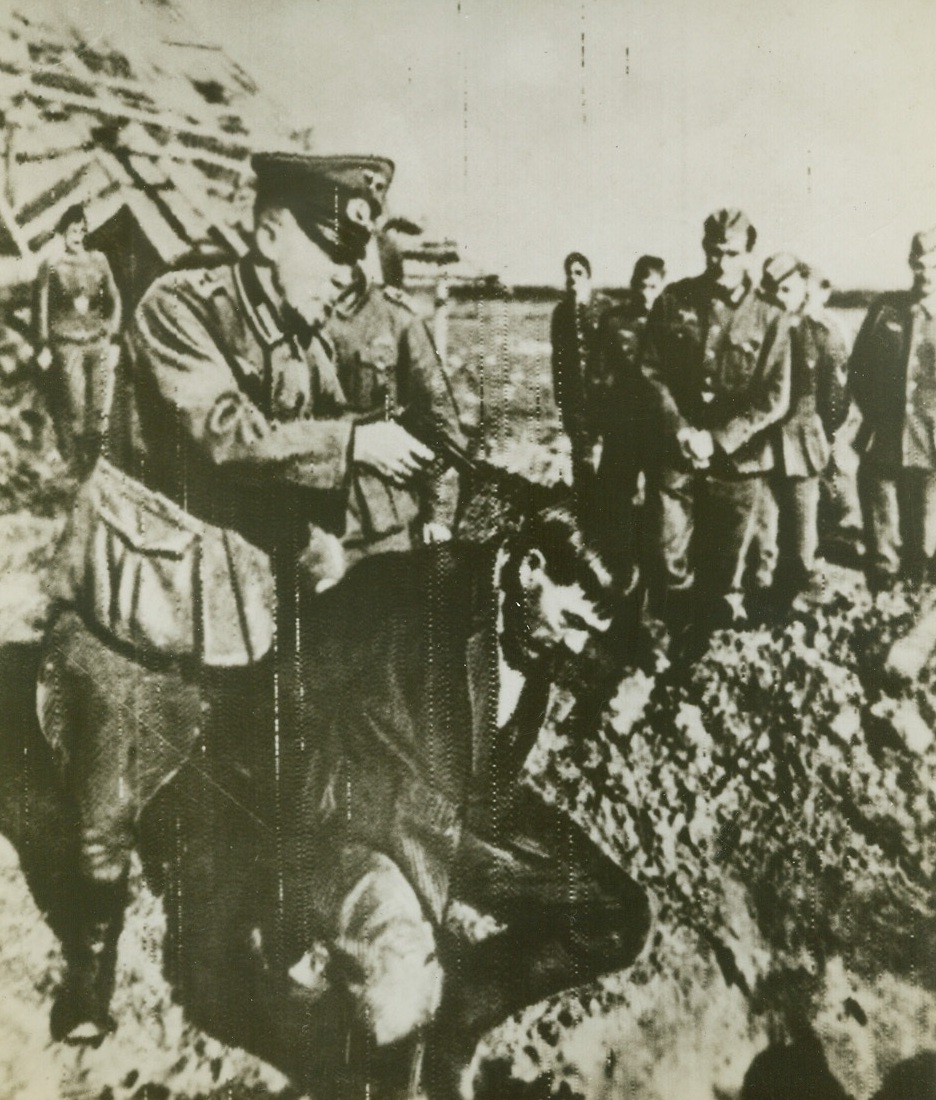
A Nazi Souvenir, 9/13/1943. RUSSIA – A Russian peasant crouches over his grave before being shot by a Nazi Gestapo agent, in this snapshot found on a German prisoner of war, one Pvt. Ludwig who served with a detachment of the 16th German Army. Although the determined Russian civilians need no further incentive to hate the Nazis, the photo was published in “Red Star.” Credit (ACME Radiophoto);
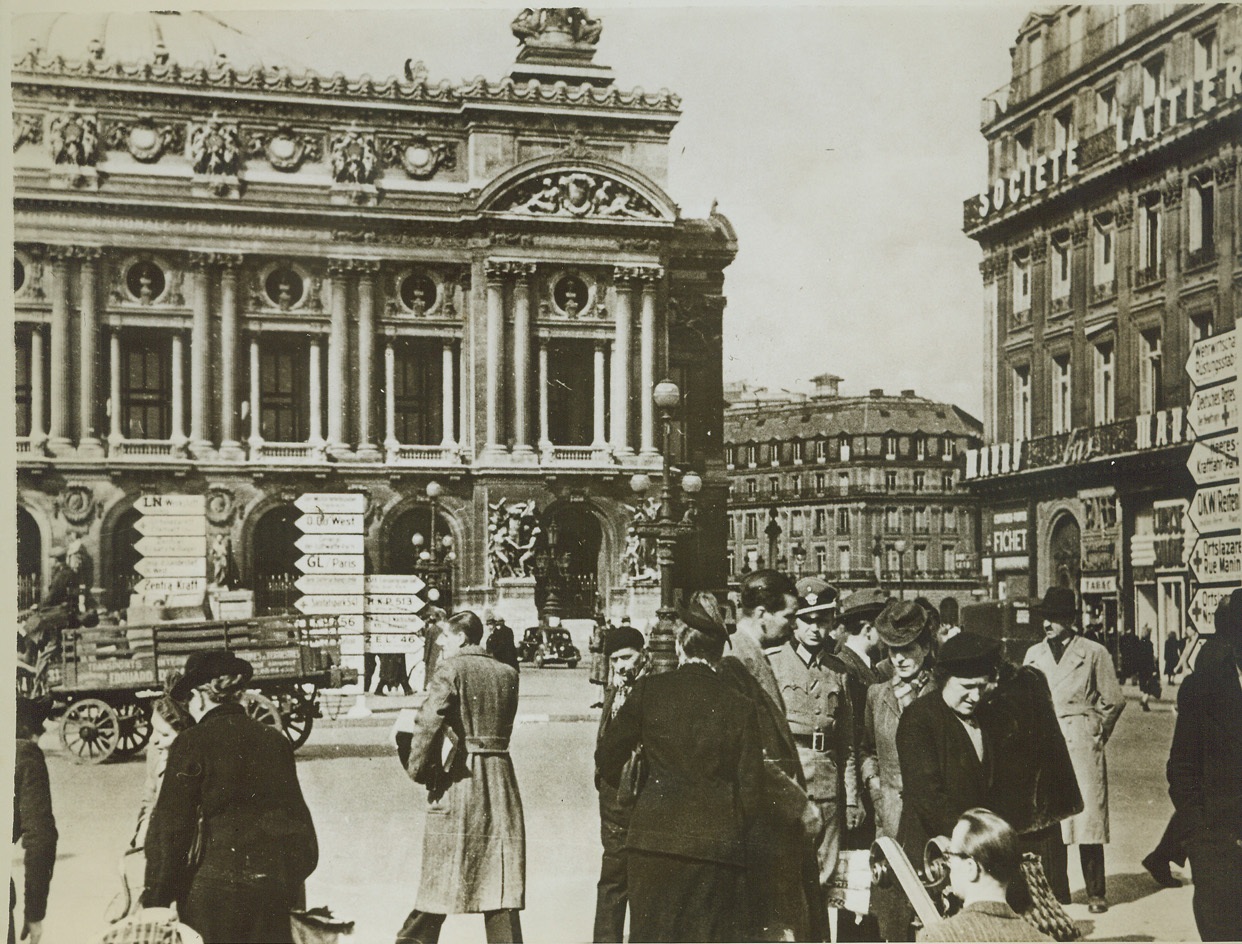
Paris Nowadays, 9/2/1943. Paris—This photo received through a neutral source shows the Place de L’Opera with the famed opera house in the background (left). Huge white sign have been placed around the square so that the “German guests” will be able to find their way around. Note Nazi officers in right foreground in midst of a group of Parisians who seem to turn away sullenly from his gaze. Credit: ACME;
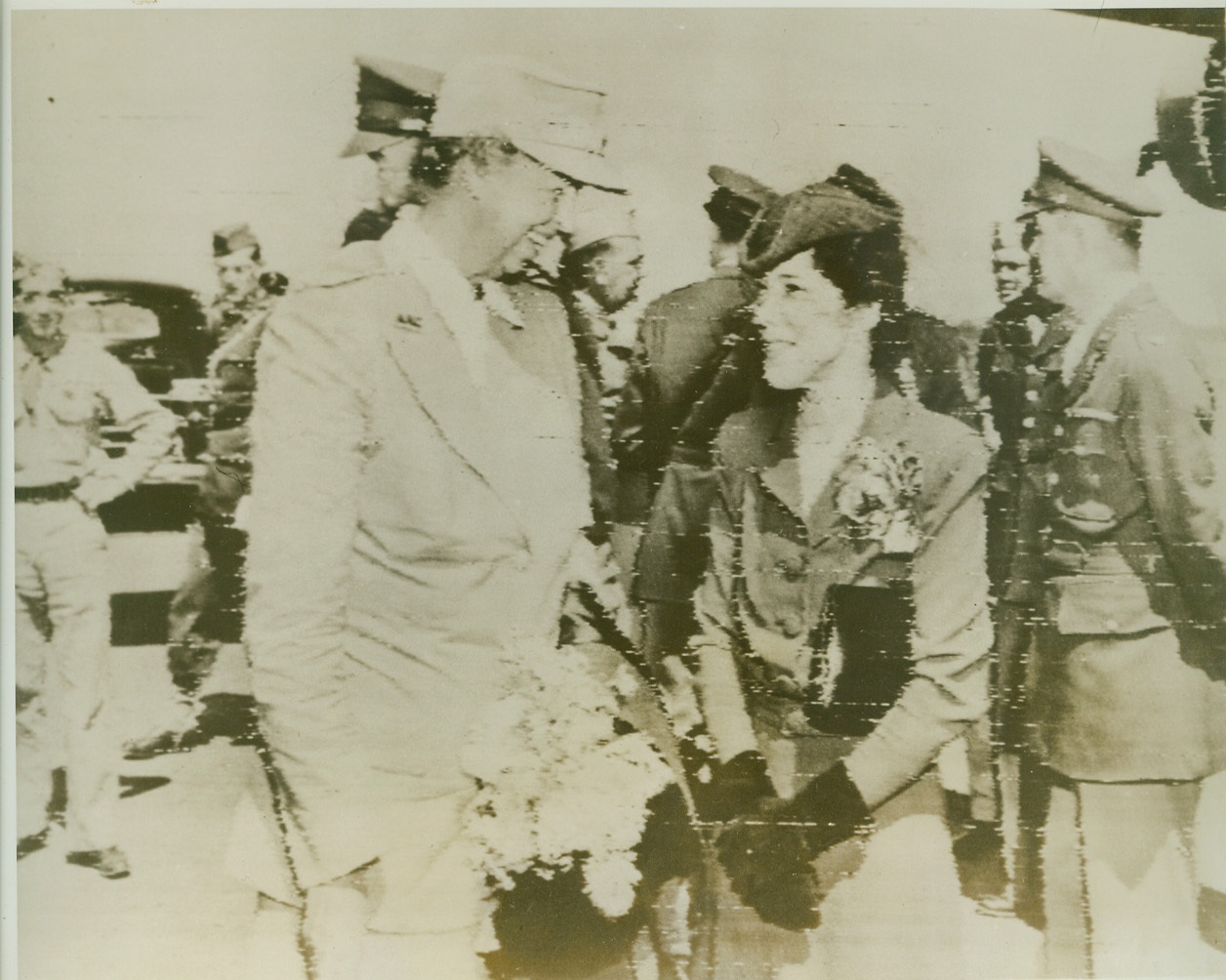
Mrs. Macarthur Greets Mrs. Roosevelt, 9/20/1943. Somewhere in South Australia—The wives of two of America’s great leaders met when Mrs. Douglas Macarthur (right) greeted Mrs. Franklin D. Roosevelt when the latter arrived at an airport somewhere in South Australia. Credit: Signal Corps radiotelephoto from ACME.;
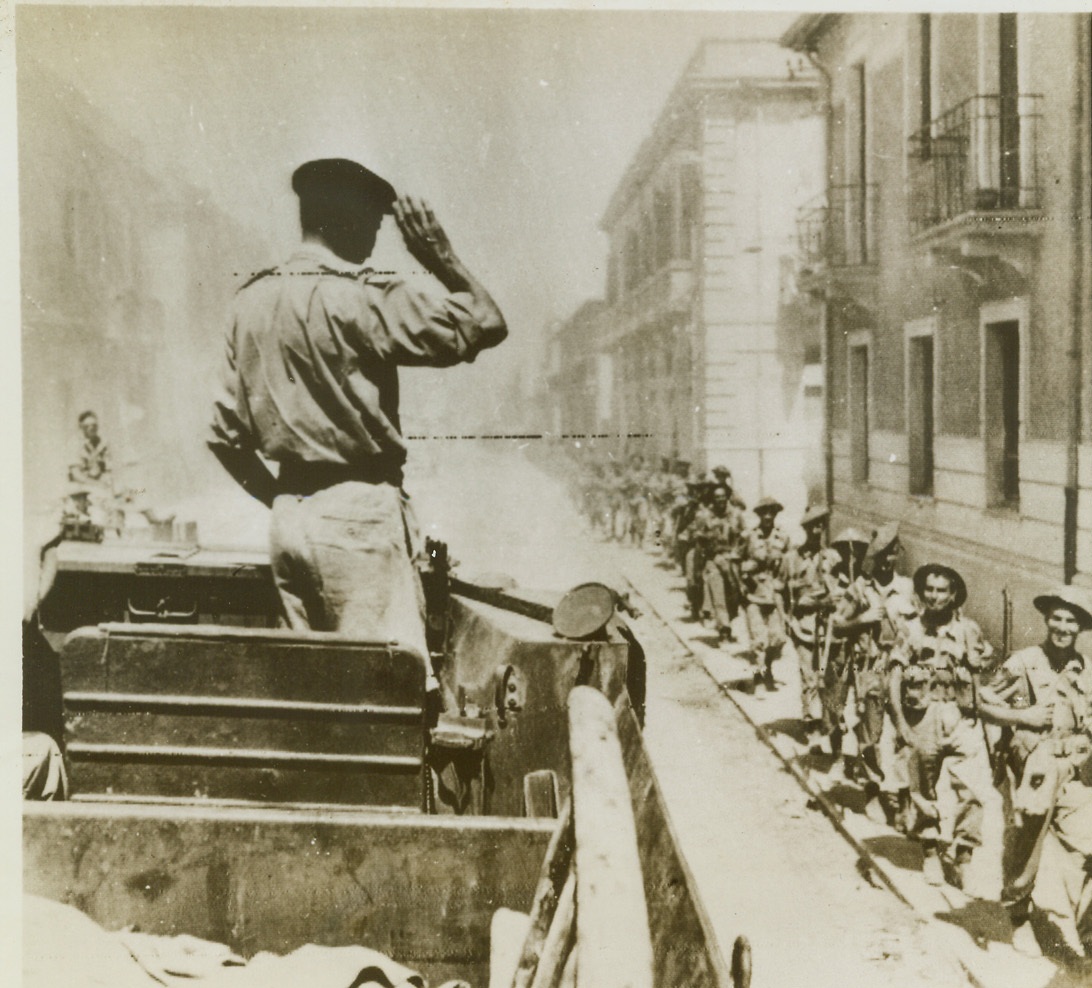
Victor’s Salute, 9/7/1943. Italy—General Bernard L. Montgomery, chief of the British 8th Army, salutes his fighting men as they pass through a street in Reggio Calabria. This is the first photo of the Allied foothold on the continent of Europe and since it was taken the 8th Army has driven steadily ahead on the Calabrian coastal road extending the invasion around Italy’s southernmost tip to about 60 miles. Credit: OWI Radiophoto from ACME.;





 Trash & Recycling
Trash & Recycling
 Online Payments
Online Payments
 City Documents
City Documents
 Parks
Parks
 Traffic Court
Traffic Court
 CITY PARKS
CITY PARKS
 Outdoor Recreation
Outdoor Recreation
 Volunteer
Volunteer
 Home
Home TRANSLATE
TRANSLATE
